The Use of Social Media in Small Medium Enterprise in Developing Countries: Case Study of Nicosia, Northern Cyprus
VerifiedAdded on 2023/04/22
|82
|22839
|357
AI Summary
This Master Thesis explores the extent and purposes of social media usage in Small Medium Enterprises (SMEs) in Nicosia, Northern Cyprus. It aims to understand the attitudes of SMEs owners, managers and administrative staff towards using social media as a marketing tool. The study identifies the challenges faced by SMEs and their marketing practices. It also covers the history, characteristics, and importance of social media, social media platforms, merits, and demerits of social media, social media marketing and marketing channels, social media marketing strategies. The research method used in data collection is also discussed.
Contribute Materials
Your contribution can guide someone’s learning journey. Share your
documents today.

GREENWICH UNIVERSITY
Communication and Media
The Use of Social Media in Small Medium Enterprise in developing countries:
Case Study of Nicosia, Northern Cyprus
(Master Thesis)
Communication and Media
The Use of Social Media in Small Medium Enterprise in developing countries:
Case Study of Nicosia, Northern Cyprus
(Master Thesis)
Secure Best Marks with AI Grader
Need help grading? Try our AI Grader for instant feedback on your assignments.
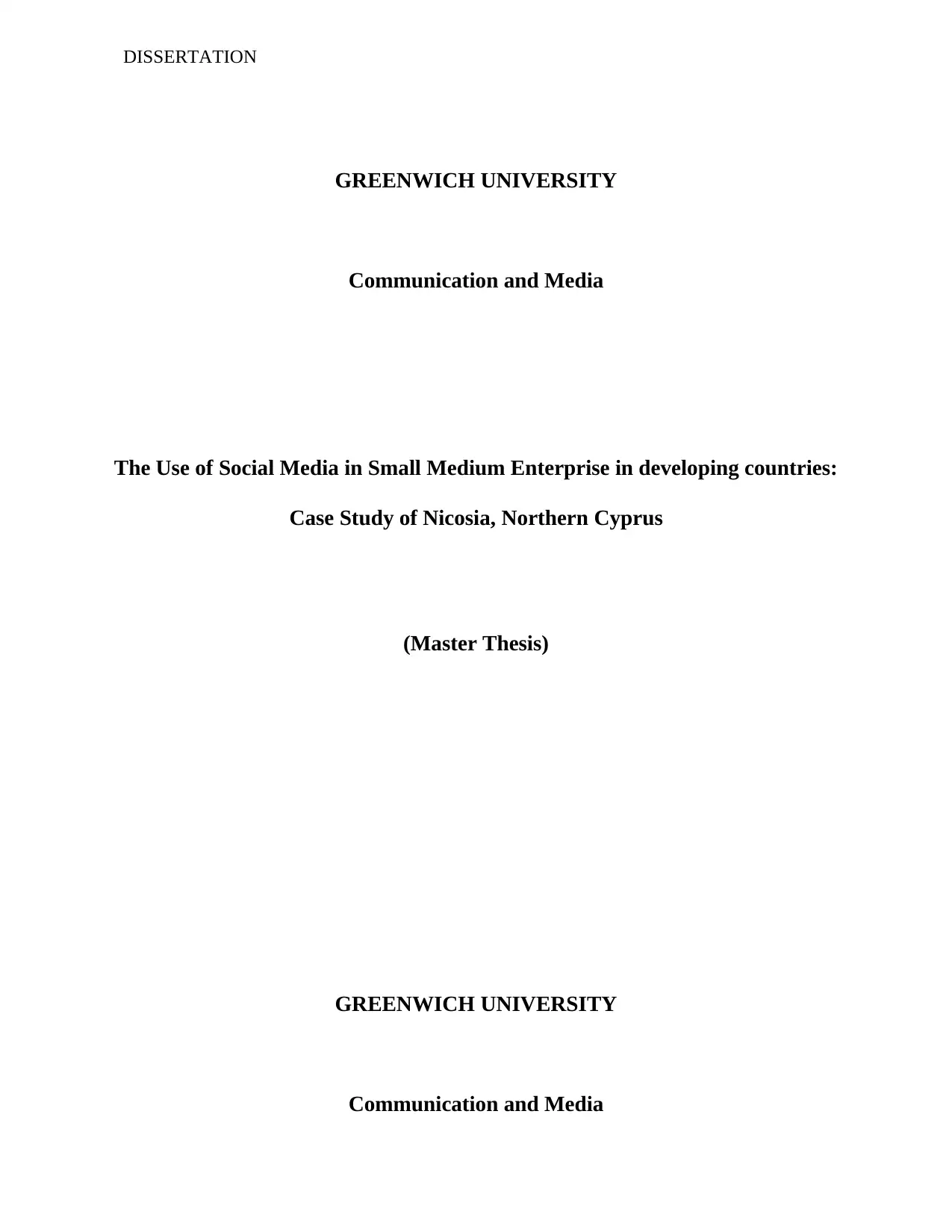
DISSERTATION
GREENWICH UNIVERSITY
Communication and Media
The Use of Social Media in Small Medium Enterprise in developing countries:
Case Study of Nicosia, Northern Cyprus
(Master Thesis)
GREENWICH UNIVERSITY
Communication and Media
GREENWICH UNIVERSITY
Communication and Media
The Use of Social Media in Small Medium Enterprise in developing countries:
Case Study of Nicosia, Northern Cyprus
(Master Thesis)
GREENWICH UNIVERSITY
Communication and Media

DISSERTATION
THESIS APPROVAL CERTIFICATE
THESIS APPROVAL CERTIFICATE
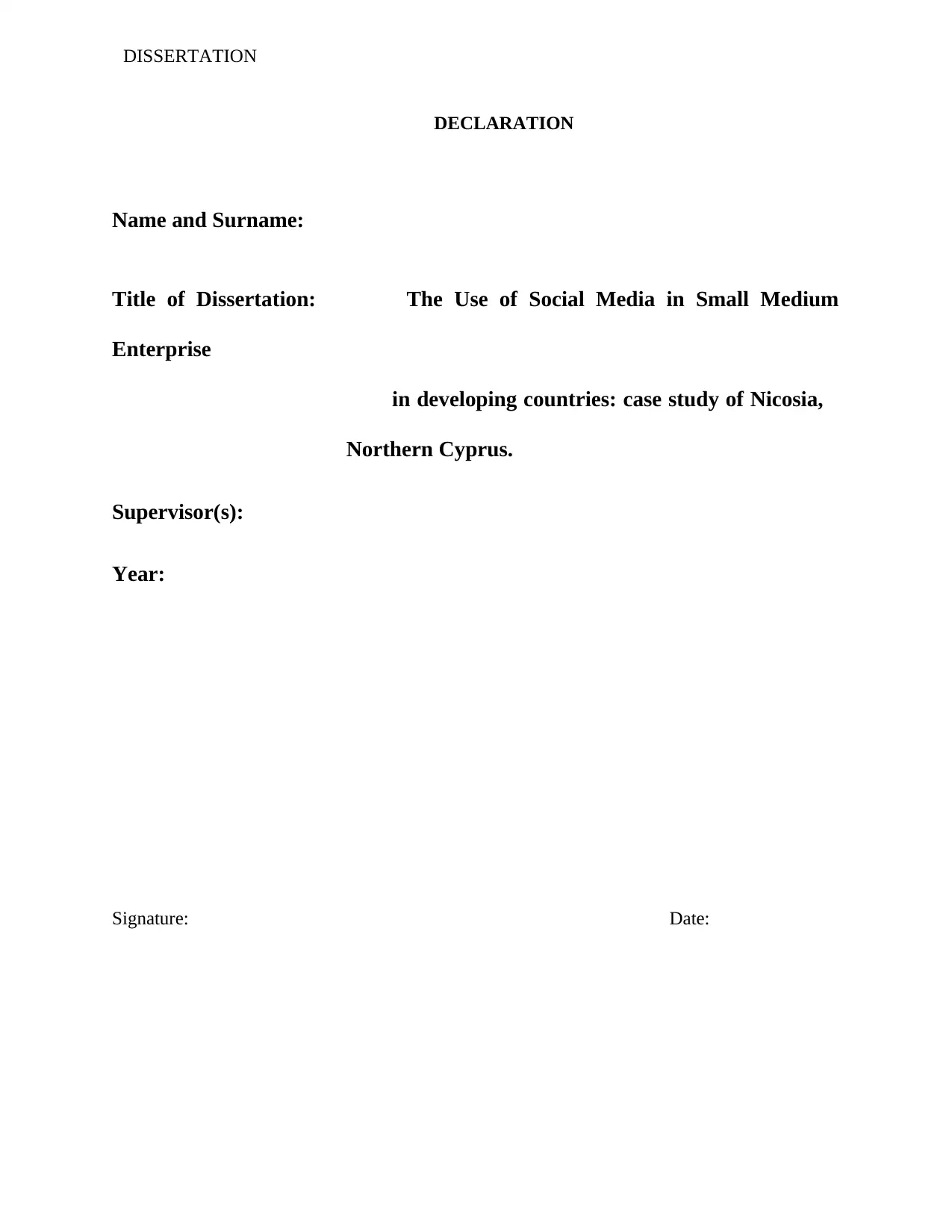
DISSERTATION
DECLARATION
Name and Surname:
Title of Dissertation: The Use of Social Media in Small Medium
Enterprise
in developing countries: case study of Nicosia,
Northern Cyprus.
Supervisor(s):
Year:
Signature: Date:
DECLARATION
Name and Surname:
Title of Dissertation: The Use of Social Media in Small Medium
Enterprise
in developing countries: case study of Nicosia,
Northern Cyprus.
Supervisor(s):
Year:
Signature: Date:
Secure Best Marks with AI Grader
Need help grading? Try our AI Grader for instant feedback on your assignments.
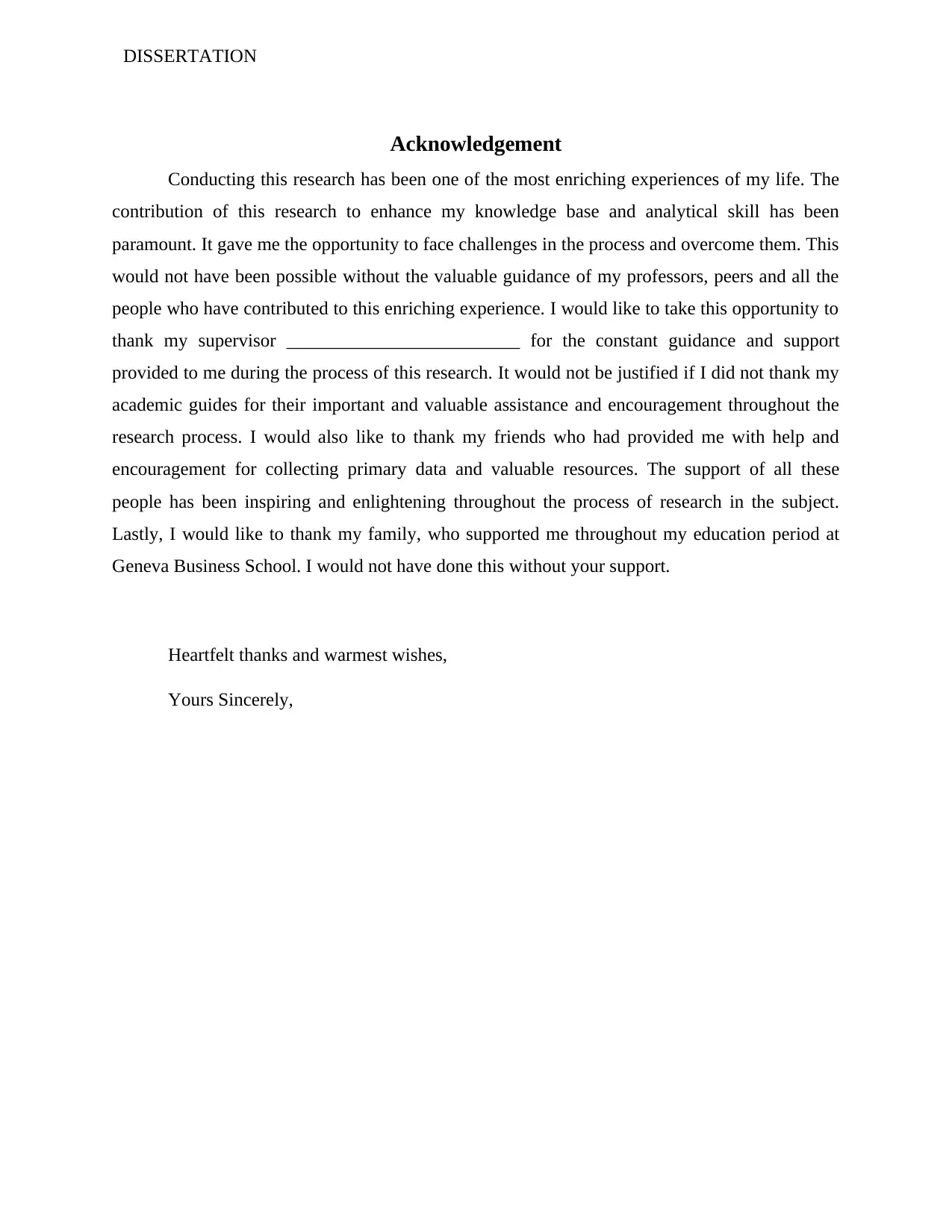
DISSERTATION
Acknowledgement
Conducting this research has been one of the most enriching experiences of my life. The
contribution of this research to enhance my knowledge base and analytical skill has been
paramount. It gave me the opportunity to face challenges in the process and overcome them. This
would not have been possible without the valuable guidance of my professors, peers and all the
people who have contributed to this enriching experience. I would like to take this opportunity to
thank my supervisor _________________________ for the constant guidance and support
provided to me during the process of this research. It would not be justified if I did not thank my
academic guides for their important and valuable assistance and encouragement throughout the
research process. I would also like to thank my friends who had provided me with help and
encouragement for collecting primary data and valuable resources. The support of all these
people has been inspiring and enlightening throughout the process of research in the subject.
Lastly, I would like to thank my family, who supported me throughout my education period at
Geneva Business School. I would not have done this without your support.
Heartfelt thanks and warmest wishes,
Yours Sincerely,
Acknowledgement
Conducting this research has been one of the most enriching experiences of my life. The
contribution of this research to enhance my knowledge base and analytical skill has been
paramount. It gave me the opportunity to face challenges in the process and overcome them. This
would not have been possible without the valuable guidance of my professors, peers and all the
people who have contributed to this enriching experience. I would like to take this opportunity to
thank my supervisor _________________________ for the constant guidance and support
provided to me during the process of this research. It would not be justified if I did not thank my
academic guides for their important and valuable assistance and encouragement throughout the
research process. I would also like to thank my friends who had provided me with help and
encouragement for collecting primary data and valuable resources. The support of all these
people has been inspiring and enlightening throughout the process of research in the subject.
Lastly, I would like to thank my family, who supported me throughout my education period at
Geneva Business School. I would not have done this without your support.
Heartfelt thanks and warmest wishes,
Yours Sincerely,
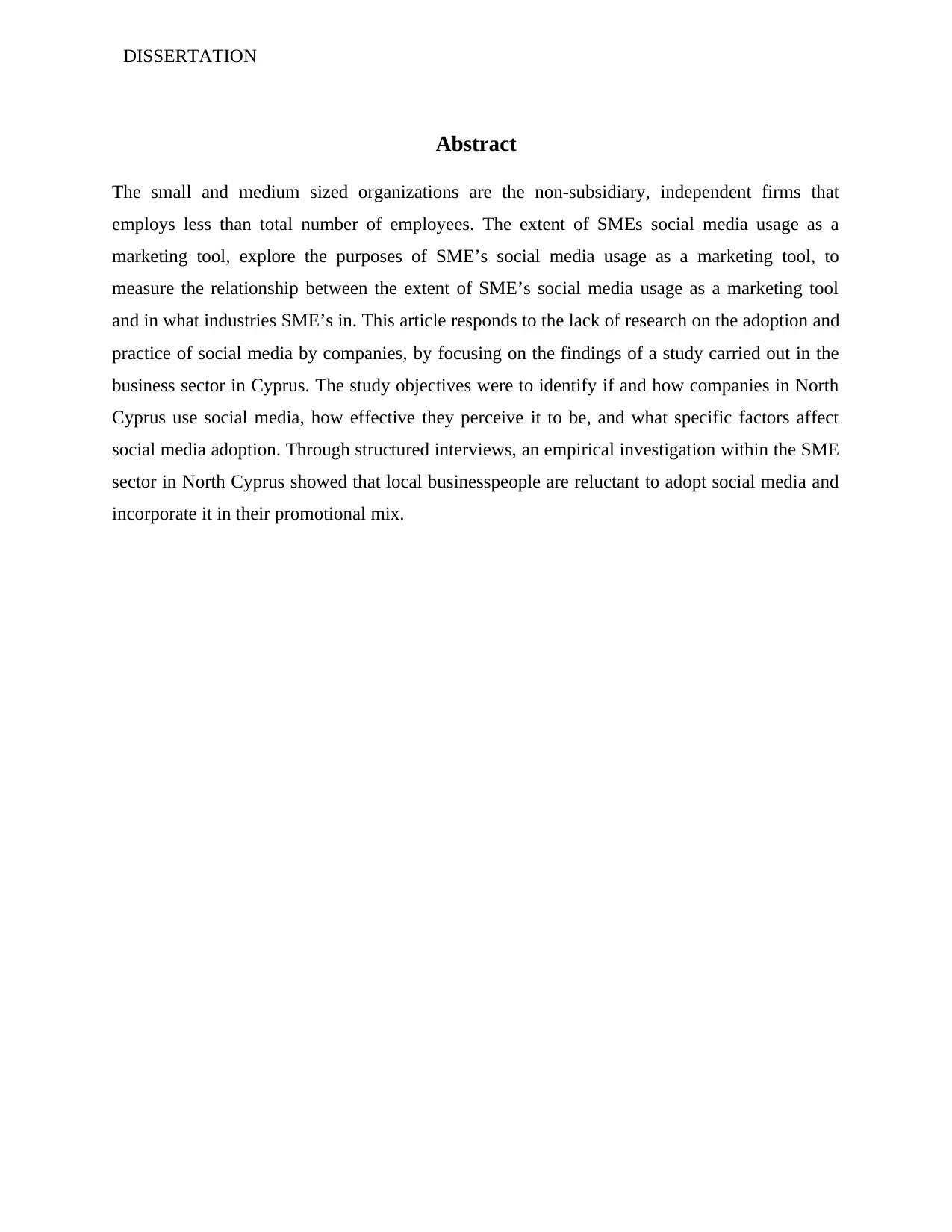
DISSERTATION
Abstract
The small and medium sized organizations are the non-subsidiary, independent firms that
employs less than total number of employees. The extent of SMEs social media usage as a
marketing tool, explore the purposes of SME’s social media usage as a marketing tool, to
measure the relationship between the extent of SME’s social media usage as a marketing tool
and in what industries SME’s in. This article responds to the lack of research on the adoption and
practice of social media by companies, by focusing on the findings of a study carried out in the
business sector in Cyprus. The study objectives were to identify if and how companies in North
Cyprus use social media, how effective they perceive it to be, and what specific factors affect
social media adoption. Through structured interviews, an empirical investigation within the SME
sector in North Cyprus showed that local businesspeople are reluctant to adopt social media and
incorporate it in their promotional mix.
Abstract
The small and medium sized organizations are the non-subsidiary, independent firms that
employs less than total number of employees. The extent of SMEs social media usage as a
marketing tool, explore the purposes of SME’s social media usage as a marketing tool, to
measure the relationship between the extent of SME’s social media usage as a marketing tool
and in what industries SME’s in. This article responds to the lack of research on the adoption and
practice of social media by companies, by focusing on the findings of a study carried out in the
business sector in Cyprus. The study objectives were to identify if and how companies in North
Cyprus use social media, how effective they perceive it to be, and what specific factors affect
social media adoption. Through structured interviews, an empirical investigation within the SME
sector in North Cyprus showed that local businesspeople are reluctant to adopt social media and
incorporate it in their promotional mix.

DISSERTATION
Contents
Acknowledgement................................................................................................................i
Abstract................................................................................................................................ii
Table of Tables...................................................................................................................iv
List of Abbreviations...........................................................................................................v
INTRODUCTION...............................................................................................................1
CHAPTER ONE..................................................................................................................3
1.1 Definition of SMEs....................................................................................................3
1.1.1 Defining SMEs...................................................................................................3
1.1.2 Basic Factors used for Defining and Classifying SMEs.....................................3
1.1.3 Definition of SMEs in Different Countries........................................................5
1.2 Characteristics and Importance of SMEs..................................................................9
1.3 Challenges Faced by SMEs.....................................................................................10
1.3.1 Increased Competition......................................................................................10
1.3.2 Regulations.......................................................................................................10
1.3.3 Leadership.........................................................................................................11
1.3.4 Recruitment.......................................................................................................11
1.4 Marketing Practices in SMEs..................................................................................11
1.4.1 The Use of Traditional Marketing Tools..........................................................12
1.4.2 The Use of Digital Marketing Tools.................................................................13
Contents
Acknowledgement................................................................................................................i
Abstract................................................................................................................................ii
Table of Tables...................................................................................................................iv
List of Abbreviations...........................................................................................................v
INTRODUCTION...............................................................................................................1
CHAPTER ONE..................................................................................................................3
1.1 Definition of SMEs....................................................................................................3
1.1.1 Defining SMEs...................................................................................................3
1.1.2 Basic Factors used for Defining and Classifying SMEs.....................................3
1.1.3 Definition of SMEs in Different Countries........................................................5
1.2 Characteristics and Importance of SMEs..................................................................9
1.3 Challenges Faced by SMEs.....................................................................................10
1.3.1 Increased Competition......................................................................................10
1.3.2 Regulations.......................................................................................................10
1.3.3 Leadership.........................................................................................................11
1.3.4 Recruitment.......................................................................................................11
1.4 Marketing Practices in SMEs..................................................................................11
1.4.1 The Use of Traditional Marketing Tools..........................................................12
1.4.2 The Use of Digital Marketing Tools.................................................................13
Paraphrase This Document
Need a fresh take? Get an instant paraphrase of this document with our AI Paraphraser
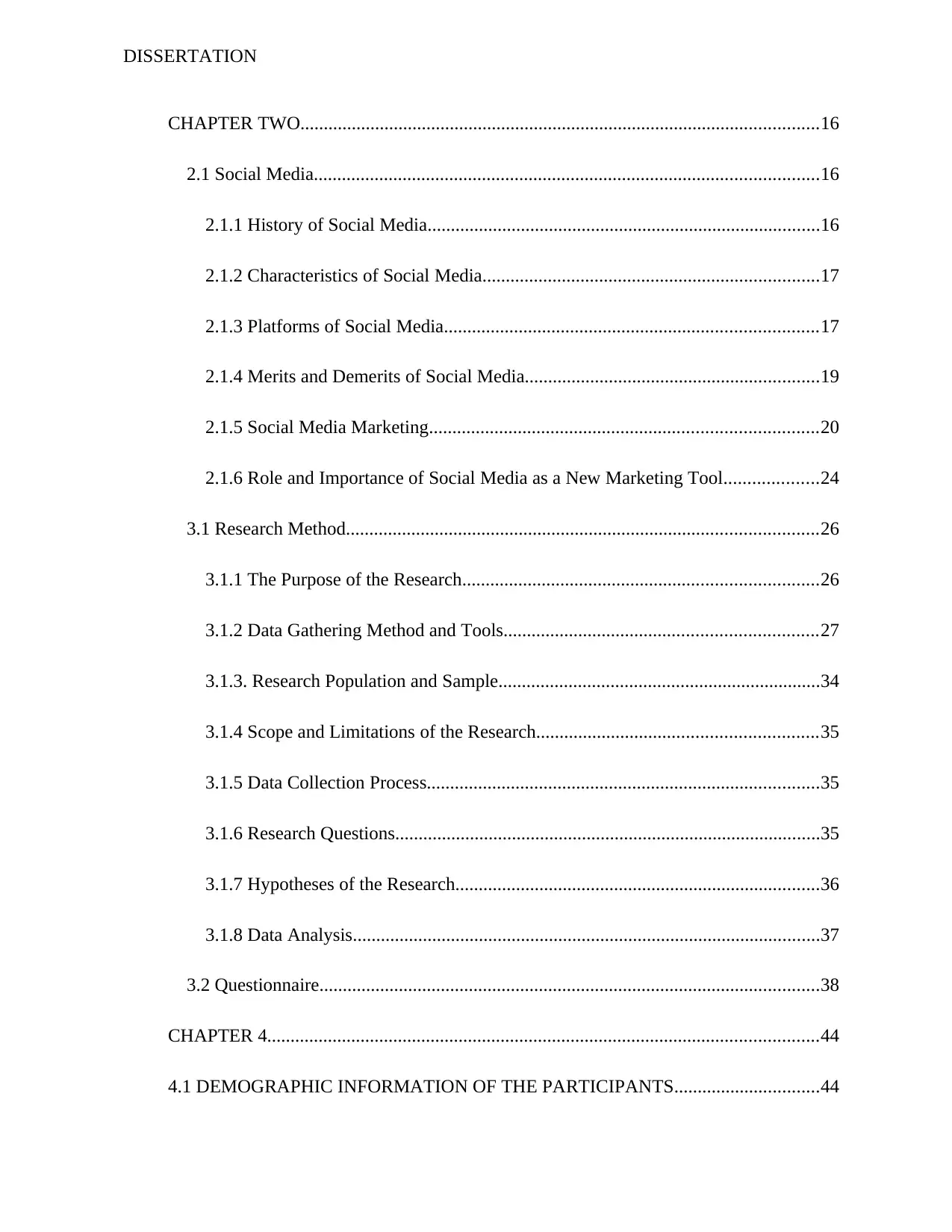
DISSERTATION
CHAPTER TWO...............................................................................................................16
2.1 Social Media............................................................................................................16
2.1.1 History of Social Media....................................................................................16
2.1.2 Characteristics of Social Media........................................................................17
2.1.3 Platforms of Social Media................................................................................17
2.1.4 Merits and Demerits of Social Media...............................................................19
2.1.5 Social Media Marketing...................................................................................20
2.1.6 Role and Importance of Social Media as a New Marketing Tool....................24
3.1 Research Method.....................................................................................................26
3.1.1 The Purpose of the Research............................................................................26
3.1.2 Data Gathering Method and Tools...................................................................27
3.1.3. Research Population and Sample.....................................................................34
3.1.4 Scope and Limitations of the Research............................................................35
3.1.5 Data Collection Process....................................................................................35
3.1.6 Research Questions...........................................................................................35
3.1.7 Hypotheses of the Research..............................................................................36
3.1.8 Data Analysis....................................................................................................37
3.2 Questionnaire...........................................................................................................38
CHAPTER 4......................................................................................................................44
4.1 DEMOGRAPHIC INFORMATION OF THE PARTICIPANTS...............................44
CHAPTER TWO...............................................................................................................16
2.1 Social Media............................................................................................................16
2.1.1 History of Social Media....................................................................................16
2.1.2 Characteristics of Social Media........................................................................17
2.1.3 Platforms of Social Media................................................................................17
2.1.4 Merits and Demerits of Social Media...............................................................19
2.1.5 Social Media Marketing...................................................................................20
2.1.6 Role and Importance of Social Media as a New Marketing Tool....................24
3.1 Research Method.....................................................................................................26
3.1.1 The Purpose of the Research............................................................................26
3.1.2 Data Gathering Method and Tools...................................................................27
3.1.3. Research Population and Sample.....................................................................34
3.1.4 Scope and Limitations of the Research............................................................35
3.1.5 Data Collection Process....................................................................................35
3.1.6 Research Questions...........................................................................................35
3.1.7 Hypotheses of the Research..............................................................................36
3.1.8 Data Analysis....................................................................................................37
3.2 Questionnaire...........................................................................................................38
CHAPTER 4......................................................................................................................44
4.1 DEMOGRAPHIC INFORMATION OF THE PARTICIPANTS...............................44
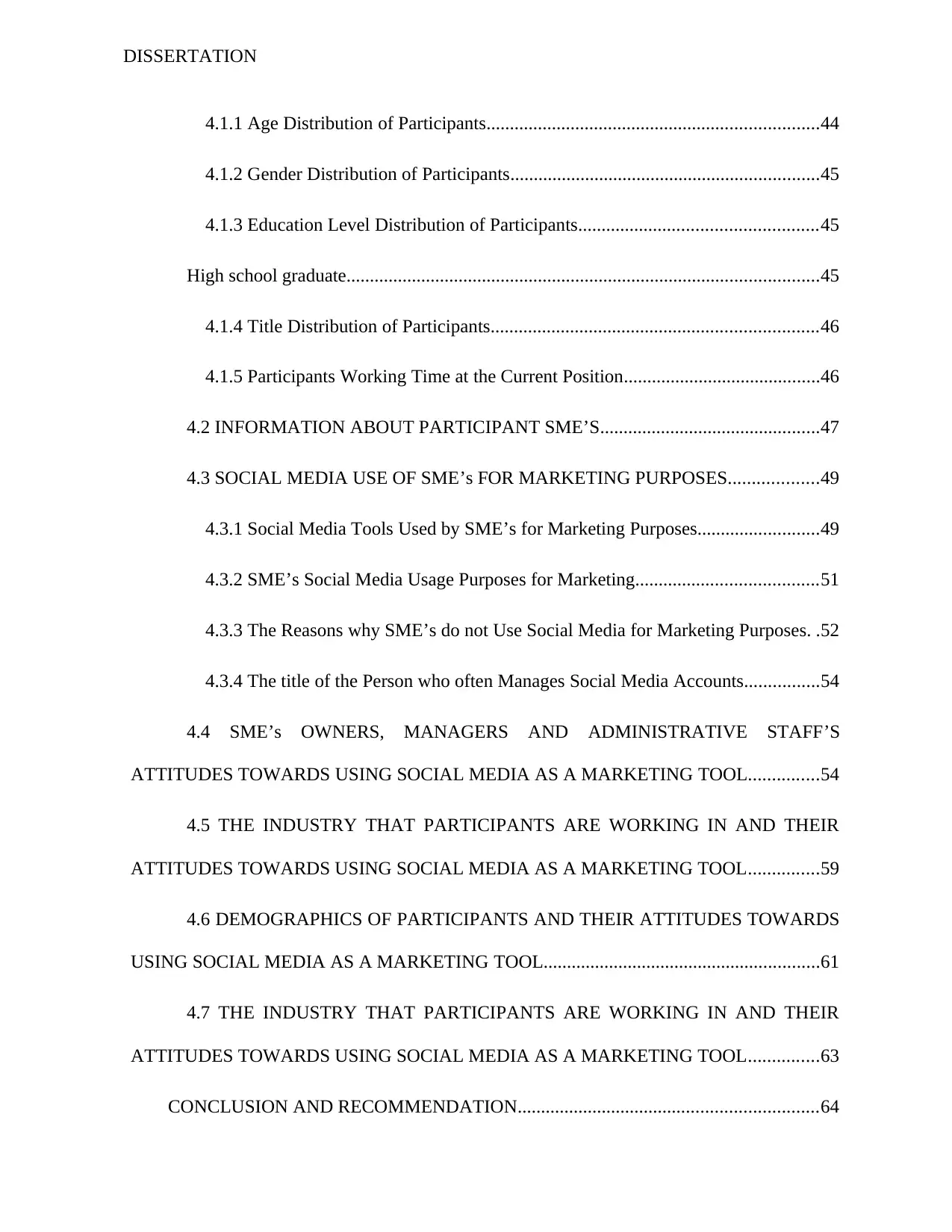
DISSERTATION
4.1.1 Age Distribution of Participants.......................................................................44
4.1.2 Gender Distribution of Participants..................................................................45
4.1.3 Education Level Distribution of Participants...................................................45
High school graduate.....................................................................................................45
4.1.4 Title Distribution of Participants......................................................................46
4.1.5 Participants Working Time at the Current Position..........................................46
4.2 INFORMATION ABOUT PARTICIPANT SME’S...............................................47
4.3 SOCIAL MEDIA USE OF SME’s FOR MARKETING PURPOSES...................49
4.3.1 Social Media Tools Used by SME’s for Marketing Purposes..........................49
4.3.2 SME’s Social Media Usage Purposes for Marketing.......................................51
4.3.3 The Reasons why SME’s do not Use Social Media for Marketing Purposes. .52
4.3.4 The title of the Person who often Manages Social Media Accounts................54
4.4 SME’s OWNERS, MANAGERS AND ADMINISTRATIVE STAFF’S
ATTITUDES TOWARDS USING SOCIAL MEDIA AS A MARKETING TOOL...............54
4.5 THE INDUSTRY THAT PARTICIPANTS ARE WORKING IN AND THEIR
ATTITUDES TOWARDS USING SOCIAL MEDIA AS A MARKETING TOOL...............59
4.6 DEMOGRAPHICS OF PARTICIPANTS AND THEIR ATTITUDES TOWARDS
USING SOCIAL MEDIA AS A MARKETING TOOL...........................................................61
4.7 THE INDUSTRY THAT PARTICIPANTS ARE WORKING IN AND THEIR
ATTITUDES TOWARDS USING SOCIAL MEDIA AS A MARKETING TOOL...............63
CONCLUSION AND RECOMMENDATION................................................................64
4.1.1 Age Distribution of Participants.......................................................................44
4.1.2 Gender Distribution of Participants..................................................................45
4.1.3 Education Level Distribution of Participants...................................................45
High school graduate.....................................................................................................45
4.1.4 Title Distribution of Participants......................................................................46
4.1.5 Participants Working Time at the Current Position..........................................46
4.2 INFORMATION ABOUT PARTICIPANT SME’S...............................................47
4.3 SOCIAL MEDIA USE OF SME’s FOR MARKETING PURPOSES...................49
4.3.1 Social Media Tools Used by SME’s for Marketing Purposes..........................49
4.3.2 SME’s Social Media Usage Purposes for Marketing.......................................51
4.3.3 The Reasons why SME’s do not Use Social Media for Marketing Purposes. .52
4.3.4 The title of the Person who often Manages Social Media Accounts................54
4.4 SME’s OWNERS, MANAGERS AND ADMINISTRATIVE STAFF’S
ATTITUDES TOWARDS USING SOCIAL MEDIA AS A MARKETING TOOL...............54
4.5 THE INDUSTRY THAT PARTICIPANTS ARE WORKING IN AND THEIR
ATTITUDES TOWARDS USING SOCIAL MEDIA AS A MARKETING TOOL...............59
4.6 DEMOGRAPHICS OF PARTICIPANTS AND THEIR ATTITUDES TOWARDS
USING SOCIAL MEDIA AS A MARKETING TOOL...........................................................61
4.7 THE INDUSTRY THAT PARTICIPANTS ARE WORKING IN AND THEIR
ATTITUDES TOWARDS USING SOCIAL MEDIA AS A MARKETING TOOL...............63
CONCLUSION AND RECOMMENDATION................................................................64

DISSERTATION
Conclusion.....................................................................................................................64
Recommendation...........................................................................................................64
References..........................................................................................................................65
Conclusion.....................................................................................................................64
Recommendation...........................................................................................................64
References..........................................................................................................................65
Secure Best Marks with AI Grader
Need help grading? Try our AI Grader for instant feedback on your assignments.
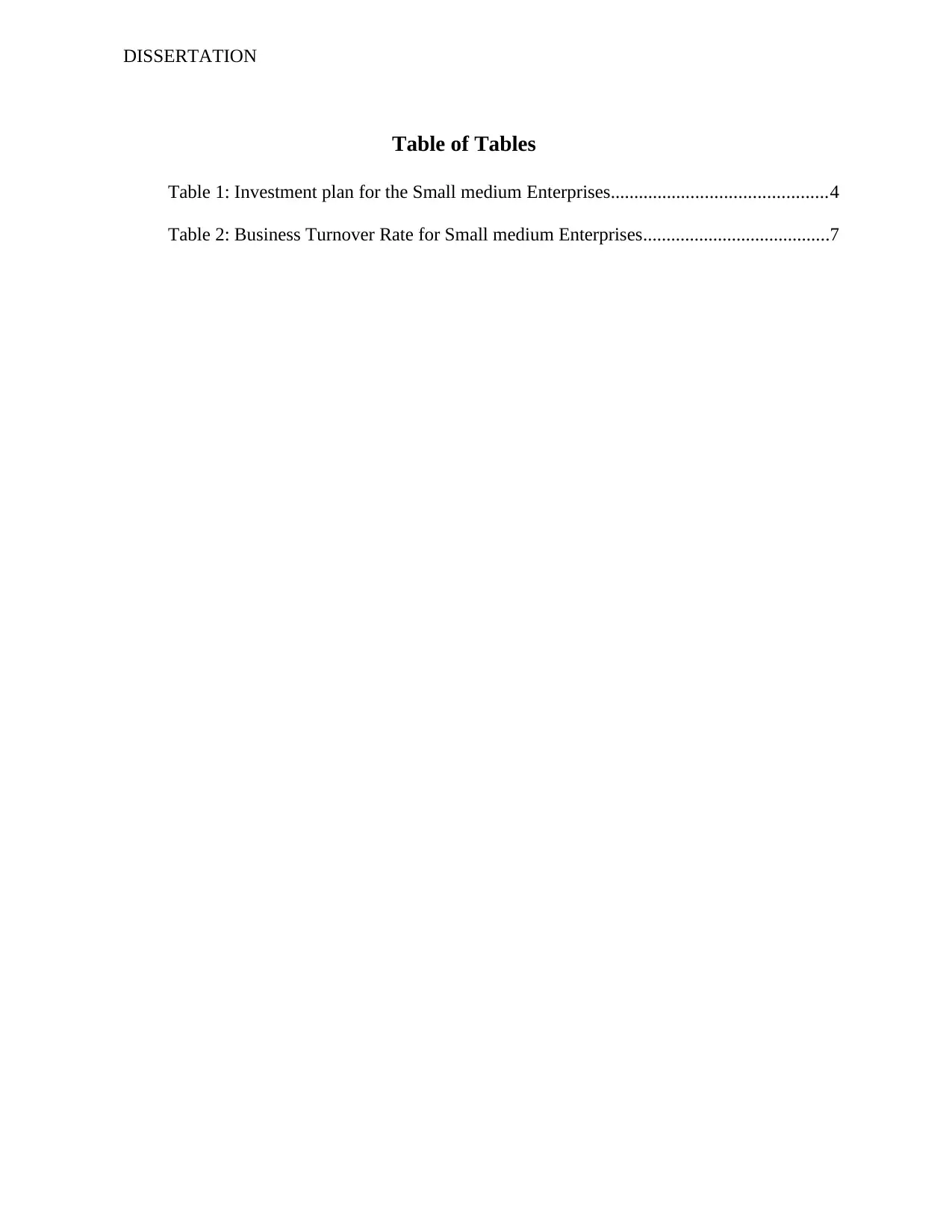
DISSERTATION
Table of Tables
Table 1: Investment plan for the Small medium Enterprises..............................................4
Table 2: Business Turnover Rate for Small medium Enterprises........................................7
Table of Tables
Table 1: Investment plan for the Small medium Enterprises..............................................4
Table 2: Business Turnover Rate for Small medium Enterprises........................................7
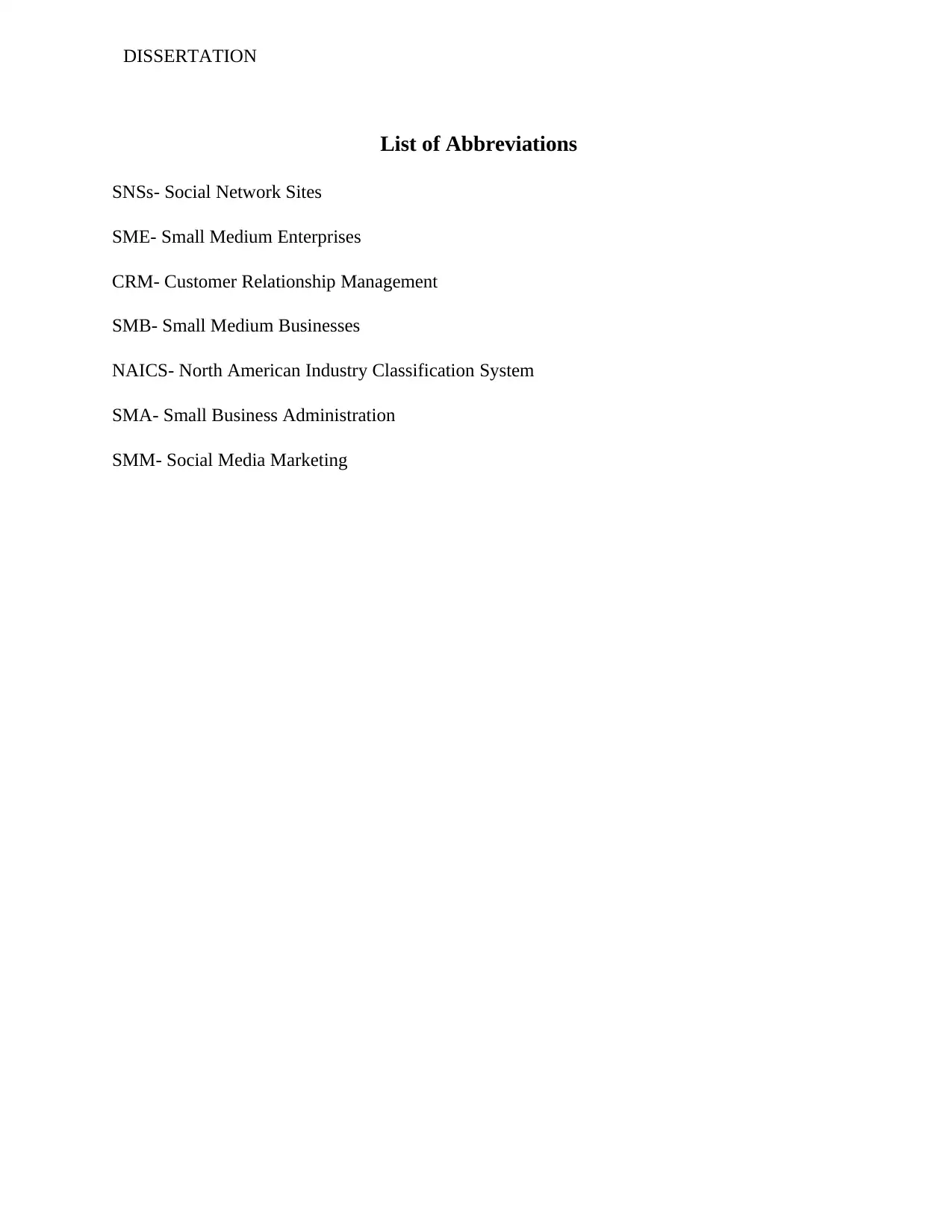
DISSERTATION
List of Abbreviations
SNSs- Social Network Sites
SME- Small Medium Enterprises
CRM- Customer Relationship Management
SMB- Small Medium Businesses
NAICS- North American Industry Classification System
SMA- Small Business Administration
SMM- Social Media Marketing
List of Abbreviations
SNSs- Social Network Sites
SME- Small Medium Enterprises
CRM- Customer Relationship Management
SMB- Small Medium Businesses
NAICS- North American Industry Classification System
SMA- Small Business Administration
SMM- Social Media Marketing

DISSERTATION
INTRODUCTION
In the recent years, the social media has been widened and has been adopted by many
enterprises from small companies to big companies. The enterprise mainly uses the social media
as the additional way of contacting the customers associated with them and also supports the
internal communication as well as collaborations. In last few years, the technology of web 2.0
and the application of associated social media, which includes Social Network Sites (SNSs),
weblogs, wikis, microblogging, and content communities that has made their way in the
organizational environment. Therefore, social media has led to major changes in marketing and
became one of the effective tool that are used for achieving the objective with a lot of
opportunities it provides not only to the big businesses, but also to the SMEs which are in a
position of being the dynamics of a national economy.
Following the assumption that, social media is a new communication environment not
only to the big businesses, but also to the SMEs use for marketing purposes. This study aims to
reveal the extent of SMEs social media usage as a marketing tool, explore the purposes of SME’s
social media usage as a marketing tool, to measure the relationship between the extent of SME’s
social media usage as a marketing tool and in what industries SME’s in. Furthermore, this study
aims to determine why SME’s that do not use social media for marketing purposes do not prefer
this platform for marketing activities. In addition to above mentioned aims; this study aims to
reveal the attitudes of using social media as a marketing tool from the perspective of the SMEs
owners, managers and other administrative staff. Furthermore, to explore if demographic
variables are the factors that cause an effect on the participant’s attitudes of using social media as
a marketing tool are among the main aims of this study.
The case that is taken for this Thesis is the small and medium sized companies in
Nicosia, Northern Cyprus. The firms in North Cyprus have become the most active in the
activities of social media because of the potential engagement as well as collaborations with the
publics. The scope of this research is to study the details of the social media, about how it serves
the small, medium sized organizations in Nicosia. The tools that will be used by the SMEs as one
of their marketing tools are discussed in this research paper. The scope of this paper also leads to
INTRODUCTION
In the recent years, the social media has been widened and has been adopted by many
enterprises from small companies to big companies. The enterprise mainly uses the social media
as the additional way of contacting the customers associated with them and also supports the
internal communication as well as collaborations. In last few years, the technology of web 2.0
and the application of associated social media, which includes Social Network Sites (SNSs),
weblogs, wikis, microblogging, and content communities that has made their way in the
organizational environment. Therefore, social media has led to major changes in marketing and
became one of the effective tool that are used for achieving the objective with a lot of
opportunities it provides not only to the big businesses, but also to the SMEs which are in a
position of being the dynamics of a national economy.
Following the assumption that, social media is a new communication environment not
only to the big businesses, but also to the SMEs use for marketing purposes. This study aims to
reveal the extent of SMEs social media usage as a marketing tool, explore the purposes of SME’s
social media usage as a marketing tool, to measure the relationship between the extent of SME’s
social media usage as a marketing tool and in what industries SME’s in. Furthermore, this study
aims to determine why SME’s that do not use social media for marketing purposes do not prefer
this platform for marketing activities. In addition to above mentioned aims; this study aims to
reveal the attitudes of using social media as a marketing tool from the perspective of the SMEs
owners, managers and other administrative staff. Furthermore, to explore if demographic
variables are the factors that cause an effect on the participant’s attitudes of using social media as
a marketing tool are among the main aims of this study.
The case that is taken for this Thesis is the small and medium sized companies in
Nicosia, Northern Cyprus. The firms in North Cyprus have become the most active in the
activities of social media because of the potential engagement as well as collaborations with the
publics. The scope of this research is to study the details of the social media, about how it serves
the small, medium sized organizations in Nicosia. The tools that will be used by the SMEs as one
of their marketing tools are discussed in this research paper. The scope of this paper also leads to
Paraphrase This Document
Need a fresh take? Get an instant paraphrase of this document with our AI Paraphraser
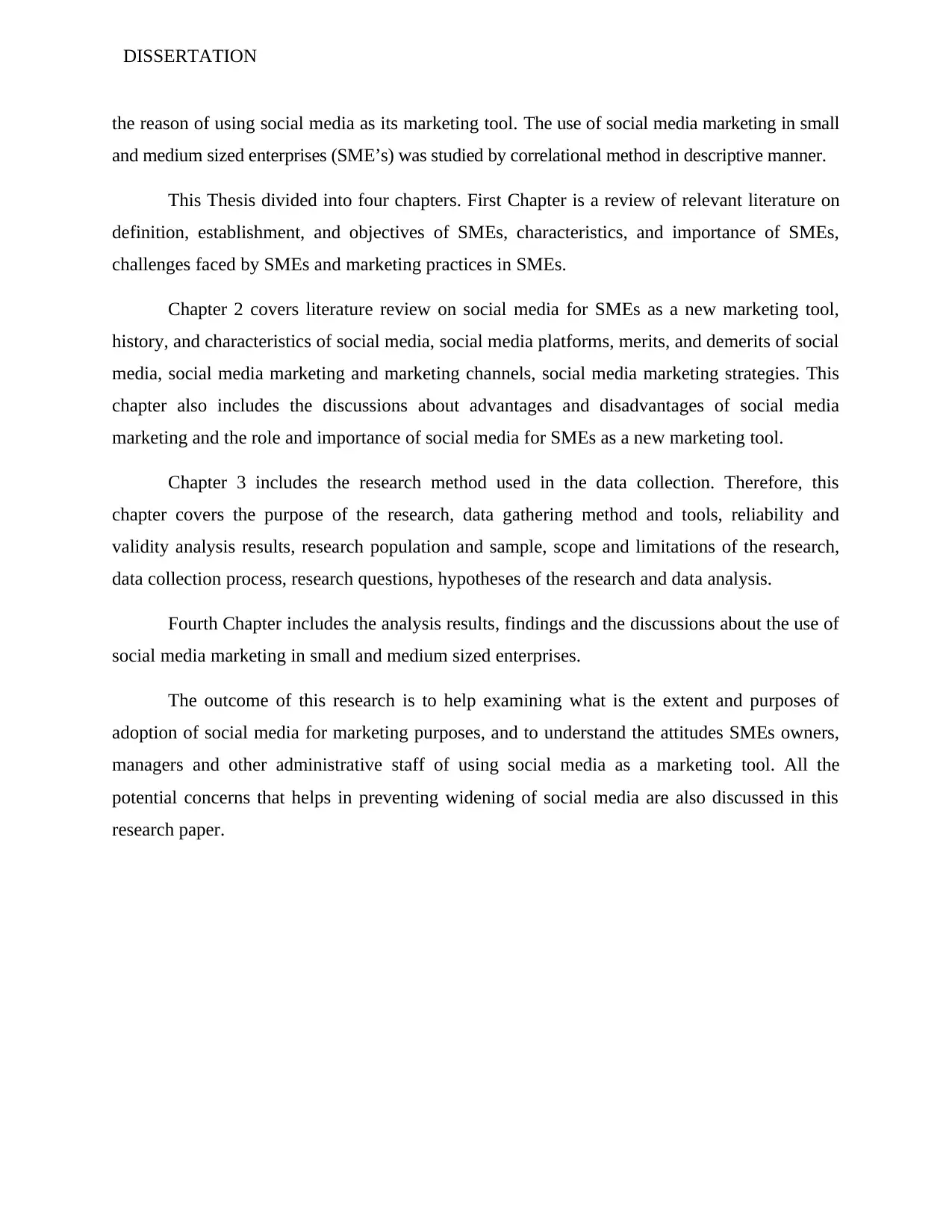
DISSERTATION
the reason of using social media as its marketing tool. The use of social media marketing in small
and medium sized enterprises (SME’s) was studied by correlational method in descriptive manner.
This Thesis divided into four chapters. First Chapter is a review of relevant literature on
definition, establishment, and objectives of SMEs, characteristics, and importance of SMEs,
challenges faced by SMEs and marketing practices in SMEs.
Chapter 2 covers literature review on social media for SMEs as a new marketing tool,
history, and characteristics of social media, social media platforms, merits, and demerits of social
media, social media marketing and marketing channels, social media marketing strategies. This
chapter also includes the discussions about advantages and disadvantages of social media
marketing and the role and importance of social media for SMEs as a new marketing tool.
Chapter 3 includes the research method used in the data collection. Therefore, this
chapter covers the purpose of the research, data gathering method and tools, reliability and
validity analysis results, research population and sample, scope and limitations of the research,
data collection process, research questions, hypotheses of the research and data analysis.
Fourth Chapter includes the analysis results, findings and the discussions about the use of
social media marketing in small and medium sized enterprises.
The outcome of this research is to help examining what is the extent and purposes of
adoption of social media for marketing purposes, and to understand the attitudes SMEs owners,
managers and other administrative staff of using social media as a marketing tool. All the
potential concerns that helps in preventing widening of social media are also discussed in this
research paper.
the reason of using social media as its marketing tool. The use of social media marketing in small
and medium sized enterprises (SME’s) was studied by correlational method in descriptive manner.
This Thesis divided into four chapters. First Chapter is a review of relevant literature on
definition, establishment, and objectives of SMEs, characteristics, and importance of SMEs,
challenges faced by SMEs and marketing practices in SMEs.
Chapter 2 covers literature review on social media for SMEs as a new marketing tool,
history, and characteristics of social media, social media platforms, merits, and demerits of social
media, social media marketing and marketing channels, social media marketing strategies. This
chapter also includes the discussions about advantages and disadvantages of social media
marketing and the role and importance of social media for SMEs as a new marketing tool.
Chapter 3 includes the research method used in the data collection. Therefore, this
chapter covers the purpose of the research, data gathering method and tools, reliability and
validity analysis results, research population and sample, scope and limitations of the research,
data collection process, research questions, hypotheses of the research and data analysis.
Fourth Chapter includes the analysis results, findings and the discussions about the use of
social media marketing in small and medium sized enterprises.
The outcome of this research is to help examining what is the extent and purposes of
adoption of social media for marketing purposes, and to understand the attitudes SMEs owners,
managers and other administrative staff of using social media as a marketing tool. All the
potential concerns that helps in preventing widening of social media are also discussed in this
research paper.
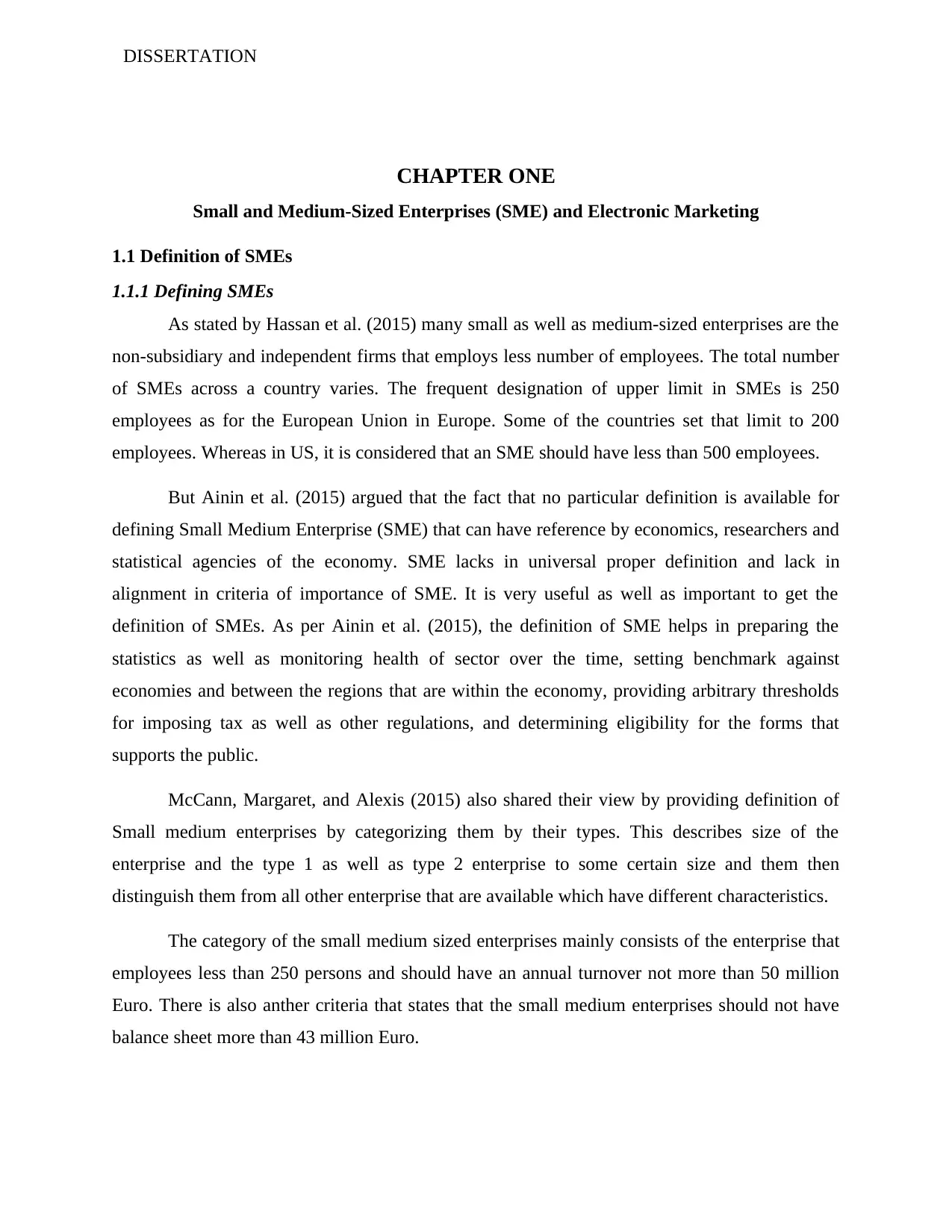
DISSERTATION
CHAPTER ONE
Small and Medium-Sized Enterprises (SME) and Electronic Marketing
1.1 Definition of SMEs
1.1.1 Defining SMEs
As stated by Hassan et al. (2015) many small as well as medium-sized enterprises are the
non-subsidiary and independent firms that employs less number of employees. The total number
of SMEs across a country varies. The frequent designation of upper limit in SMEs is 250
employees as for the European Union in Europe. Some of the countries set that limit to 200
employees. Whereas in US, it is considered that an SME should have less than 500 employees.
But Ainin et al. (2015) argued that the fact that no particular definition is available for
defining Small Medium Enterprise (SME) that can have reference by economics, researchers and
statistical agencies of the economy. SME lacks in universal proper definition and lack in
alignment in criteria of importance of SME. It is very useful as well as important to get the
definition of SMEs. As per Ainin et al. (2015), the definition of SME helps in preparing the
statistics as well as monitoring health of sector over the time, setting benchmark against
economies and between the regions that are within the economy, providing arbitrary thresholds
for imposing tax as well as other regulations, and determining eligibility for the forms that
supports the public.
McCann, Margaret, and Alexis (2015) also shared their view by providing definition of
Small medium enterprises by categorizing them by their types. This describes size of the
enterprise and the type 1 as well as type 2 enterprise to some certain size and them then
distinguish them from all other enterprise that are available which have different characteristics.
The category of the small medium sized enterprises mainly consists of the enterprise that
employees less than 250 persons and should have an annual turnover not more than 50 million
Euro. There is also anther criteria that states that the small medium enterprises should not have
balance sheet more than 43 million Euro.
CHAPTER ONE
Small and Medium-Sized Enterprises (SME) and Electronic Marketing
1.1 Definition of SMEs
1.1.1 Defining SMEs
As stated by Hassan et al. (2015) many small as well as medium-sized enterprises are the
non-subsidiary and independent firms that employs less number of employees. The total number
of SMEs across a country varies. The frequent designation of upper limit in SMEs is 250
employees as for the European Union in Europe. Some of the countries set that limit to 200
employees. Whereas in US, it is considered that an SME should have less than 500 employees.
But Ainin et al. (2015) argued that the fact that no particular definition is available for
defining Small Medium Enterprise (SME) that can have reference by economics, researchers and
statistical agencies of the economy. SME lacks in universal proper definition and lack in
alignment in criteria of importance of SME. It is very useful as well as important to get the
definition of SMEs. As per Ainin et al. (2015), the definition of SME helps in preparing the
statistics as well as monitoring health of sector over the time, setting benchmark against
economies and between the regions that are within the economy, providing arbitrary thresholds
for imposing tax as well as other regulations, and determining eligibility for the forms that
supports the public.
McCann, Margaret, and Alexis (2015) also shared their view by providing definition of
Small medium enterprises by categorizing them by their types. This describes size of the
enterprise and the type 1 as well as type 2 enterprise to some certain size and them then
distinguish them from all other enterprise that are available which have different characteristics.
The category of the small medium sized enterprises mainly consists of the enterprise that
employees less than 250 persons and should have an annual turnover not more than 50 million
Euro. There is also anther criteria that states that the small medium enterprises should not have
balance sheet more than 43 million Euro.
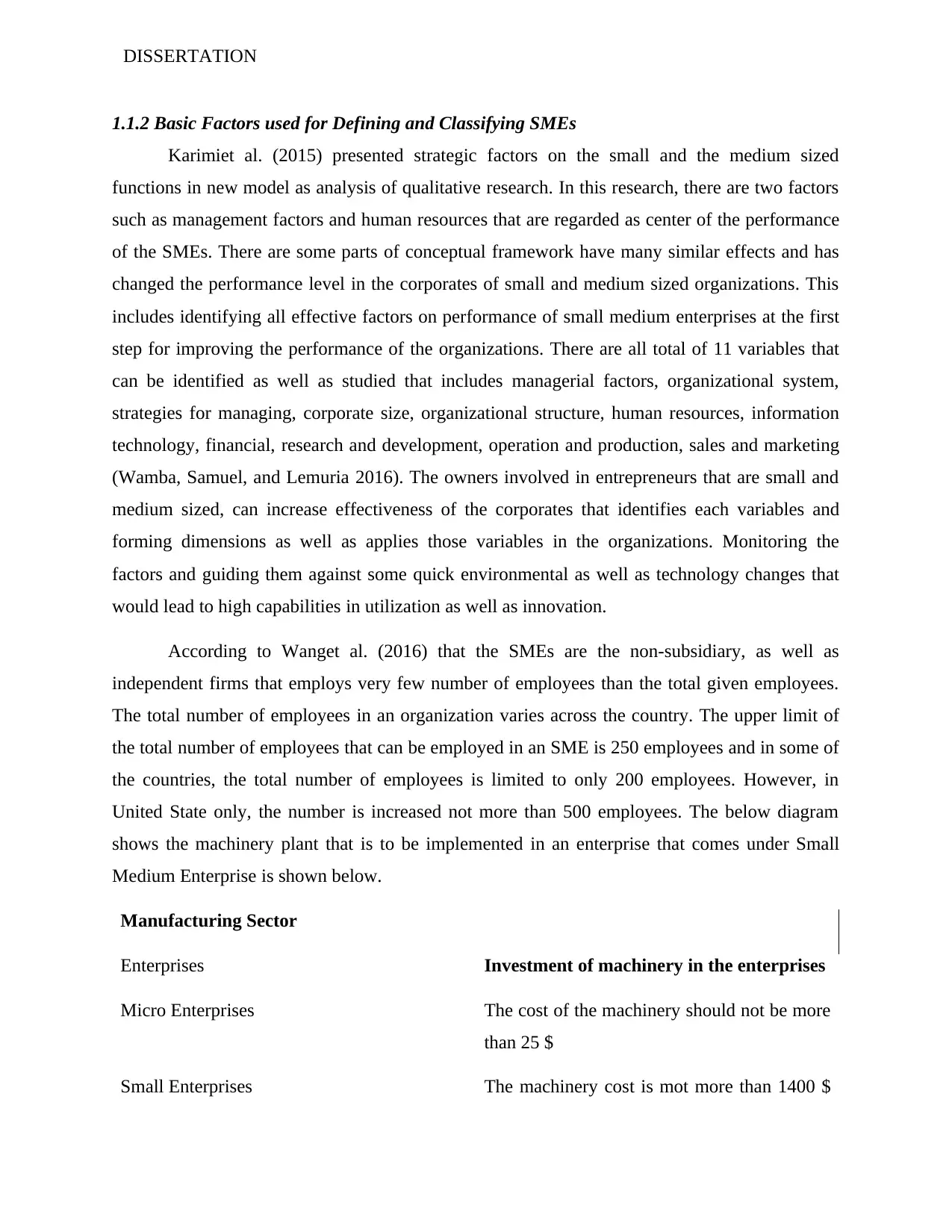
DISSERTATION
1.1.2 Basic Factors used for Defining and Classifying SMEs
Karimiet al. (2015) presented strategic factors on the small and the medium sized
functions in new model as analysis of qualitative research. In this research, there are two factors
such as management factors and human resources that are regarded as center of the performance
of the SMEs. There are some parts of conceptual framework have many similar effects and has
changed the performance level in the corporates of small and medium sized organizations. This
includes identifying all effective factors on performance of small medium enterprises at the first
step for improving the performance of the organizations. There are all total of 11 variables that
can be identified as well as studied that includes managerial factors, organizational system,
strategies for managing, corporate size, organizational structure, human resources, information
technology, financial, research and development, operation and production, sales and marketing
(Wamba, Samuel, and Lemuria 2016). The owners involved in entrepreneurs that are small and
medium sized, can increase effectiveness of the corporates that identifies each variables and
forming dimensions as well as applies those variables in the organizations. Monitoring the
factors and guiding them against some quick environmental as well as technology changes that
would lead to high capabilities in utilization as well as innovation.
According to Wanget al. (2016) that the SMEs are the non-subsidiary, as well as
independent firms that employs very few number of employees than the total given employees.
The total number of employees in an organization varies across the country. The upper limit of
the total number of employees that can be employed in an SME is 250 employees and in some of
the countries, the total number of employees is limited to only 200 employees. However, in
United State only, the number is increased not more than 500 employees. The below diagram
shows the machinery plant that is to be implemented in an enterprise that comes under Small
Medium Enterprise is shown below.
Manufacturing Sector
Enterprises Investment of machinery in the enterprises
Micro Enterprises The cost of the machinery should not be more
than 25 $
Small Enterprises The machinery cost is mot more than 1400 $
1.1.2 Basic Factors used for Defining and Classifying SMEs
Karimiet al. (2015) presented strategic factors on the small and the medium sized
functions in new model as analysis of qualitative research. In this research, there are two factors
such as management factors and human resources that are regarded as center of the performance
of the SMEs. There are some parts of conceptual framework have many similar effects and has
changed the performance level in the corporates of small and medium sized organizations. This
includes identifying all effective factors on performance of small medium enterprises at the first
step for improving the performance of the organizations. There are all total of 11 variables that
can be identified as well as studied that includes managerial factors, organizational system,
strategies for managing, corporate size, organizational structure, human resources, information
technology, financial, research and development, operation and production, sales and marketing
(Wamba, Samuel, and Lemuria 2016). The owners involved in entrepreneurs that are small and
medium sized, can increase effectiveness of the corporates that identifies each variables and
forming dimensions as well as applies those variables in the organizations. Monitoring the
factors and guiding them against some quick environmental as well as technology changes that
would lead to high capabilities in utilization as well as innovation.
According to Wanget al. (2016) that the SMEs are the non-subsidiary, as well as
independent firms that employs very few number of employees than the total given employees.
The total number of employees in an organization varies across the country. The upper limit of
the total number of employees that can be employed in an SME is 250 employees and in some of
the countries, the total number of employees is limited to only 200 employees. However, in
United State only, the number is increased not more than 500 employees. The below diagram
shows the machinery plant that is to be implemented in an enterprise that comes under Small
Medium Enterprise is shown below.
Manufacturing Sector
Enterprises Investment of machinery in the enterprises
Micro Enterprises The cost of the machinery should not be more
than 25 $
Small Enterprises The machinery cost is mot more than 1400 $
Secure Best Marks with AI Grader
Need help grading? Try our AI Grader for instant feedback on your assignments.
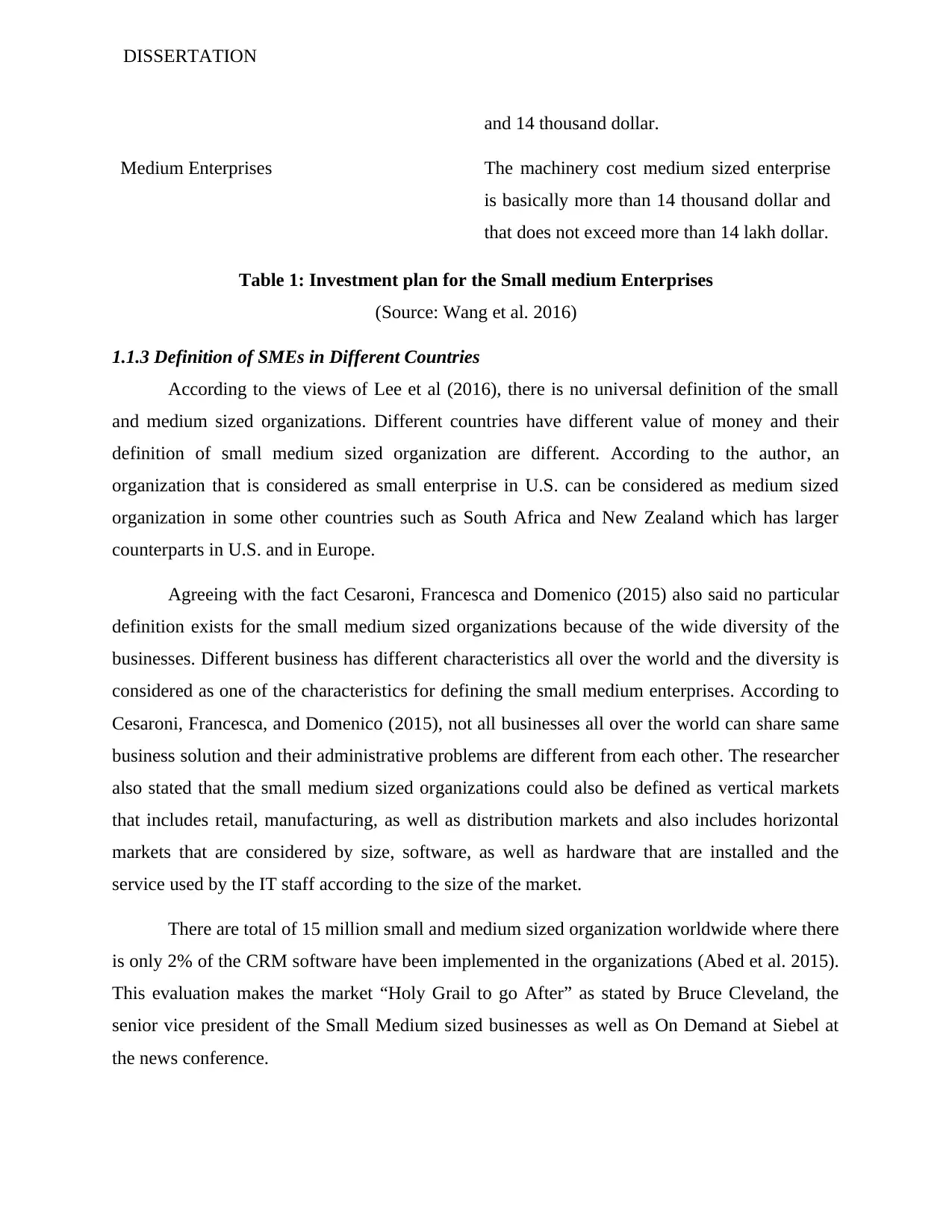
DISSERTATION
and 14 thousand dollar.
Medium Enterprises The machinery cost medium sized enterprise
is basically more than 14 thousand dollar and
that does not exceed more than 14 lakh dollar.
Table 1: Investment plan for the Small medium Enterprises
(Source: Wang et al. 2016)
1.1.3 Definition of SMEs in Different Countries
According to the views of Lee et al (2016), there is no universal definition of the small
and medium sized organizations. Different countries have different value of money and their
definition of small medium sized organization are different. According to the author, an
organization that is considered as small enterprise in U.S. can be considered as medium sized
organization in some other countries such as South Africa and New Zealand which has larger
counterparts in U.S. and in Europe.
Agreeing with the fact Cesaroni, Francesca and Domenico (2015) also said no particular
definition exists for the small medium sized organizations because of the wide diversity of the
businesses. Different business has different characteristics all over the world and the diversity is
considered as one of the characteristics for defining the small medium enterprises. According to
Cesaroni, Francesca, and Domenico (2015), not all businesses all over the world can share same
business solution and their administrative problems are different from each other. The researcher
also stated that the small medium sized organizations could also be defined as vertical markets
that includes retail, manufacturing, as well as distribution markets and also includes horizontal
markets that are considered by size, software, as well as hardware that are installed and the
service used by the IT staff according to the size of the market.
There are total of 15 million small and medium sized organization worldwide where there
is only 2% of the CRM software have been implemented in the organizations (Abed et al. 2015).
This evaluation makes the market “Holy Grail to go After” as stated by Bruce Cleveland, the
senior vice president of the Small Medium sized businesses as well as On Demand at Siebel at
the news conference.
and 14 thousand dollar.
Medium Enterprises The machinery cost medium sized enterprise
is basically more than 14 thousand dollar and
that does not exceed more than 14 lakh dollar.
Table 1: Investment plan for the Small medium Enterprises
(Source: Wang et al. 2016)
1.1.3 Definition of SMEs in Different Countries
According to the views of Lee et al (2016), there is no universal definition of the small
and medium sized organizations. Different countries have different value of money and their
definition of small medium sized organization are different. According to the author, an
organization that is considered as small enterprise in U.S. can be considered as medium sized
organization in some other countries such as South Africa and New Zealand which has larger
counterparts in U.S. and in Europe.
Agreeing with the fact Cesaroni, Francesca and Domenico (2015) also said no particular
definition exists for the small medium sized organizations because of the wide diversity of the
businesses. Different business has different characteristics all over the world and the diversity is
considered as one of the characteristics for defining the small medium enterprises. According to
Cesaroni, Francesca, and Domenico (2015), not all businesses all over the world can share same
business solution and their administrative problems are different from each other. The researcher
also stated that the small medium sized organizations could also be defined as vertical markets
that includes retail, manufacturing, as well as distribution markets and also includes horizontal
markets that are considered by size, software, as well as hardware that are installed and the
service used by the IT staff according to the size of the market.
There are total of 15 million small and medium sized organization worldwide where there
is only 2% of the CRM software have been implemented in the organizations (Abed et al. 2015).
This evaluation makes the market “Holy Grail to go After” as stated by Bruce Cleveland, the
senior vice president of the Small Medium sized businesses as well as On Demand at Siebel at
the news conference.
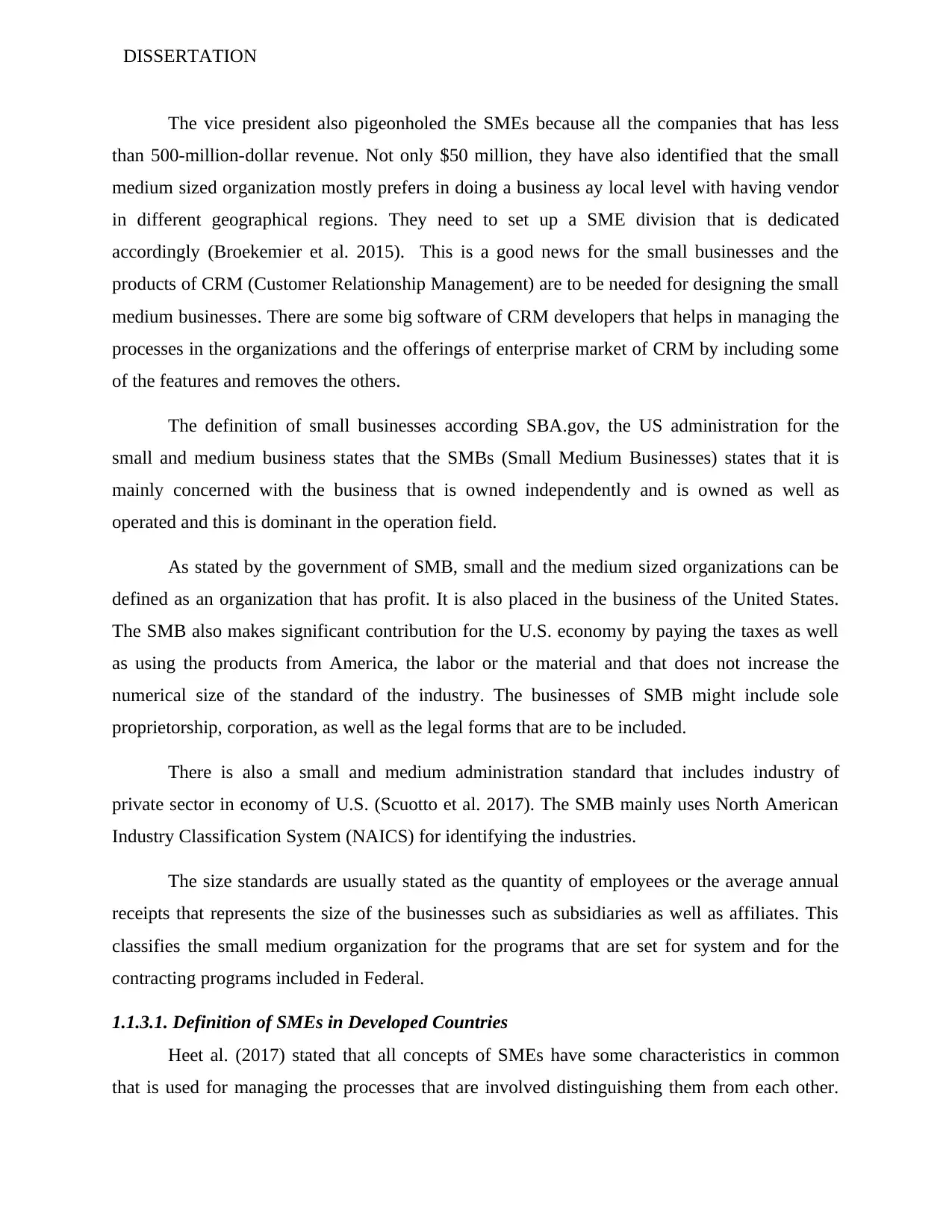
DISSERTATION
The vice president also pigeonholed the SMEs because all the companies that has less
than 500-million-dollar revenue. Not only $50 million, they have also identified that the small
medium sized organization mostly prefers in doing a business ay local level with having vendor
in different geographical regions. They need to set up a SME division that is dedicated
accordingly (Broekemier et al. 2015). This is a good news for the small businesses and the
products of CRM (Customer Relationship Management) are to be needed for designing the small
medium businesses. There are some big software of CRM developers that helps in managing the
processes in the organizations and the offerings of enterprise market of CRM by including some
of the features and removes the others.
The definition of small businesses according SBA.gov, the US administration for the
small and medium business states that the SMBs (Small Medium Businesses) states that it is
mainly concerned with the business that is owned independently and is owned as well as
operated and this is dominant in the operation field.
As stated by the government of SMB, small and the medium sized organizations can be
defined as an organization that has profit. It is also placed in the business of the United States.
The SMB also makes significant contribution for the U.S. economy by paying the taxes as well
as using the products from America, the labor or the material and that does not increase the
numerical size of the standard of the industry. The businesses of SMB might include sole
proprietorship, corporation, as well as the legal forms that are to be included.
There is also a small and medium administration standard that includes industry of
private sector in economy of U.S. (Scuotto et al. 2017). The SMB mainly uses North American
Industry Classification System (NAICS) for identifying the industries.
The size standards are usually stated as the quantity of employees or the average annual
receipts that represents the size of the businesses such as subsidiaries as well as affiliates. This
classifies the small medium organization for the programs that are set for system and for the
contracting programs included in Federal.
1.1.3.1. Definition of SMEs in Developed Countries
Heet al. (2017) stated that all concepts of SMEs have some characteristics in common
that is used for managing the processes that are involved distinguishing them from each other.
The vice president also pigeonholed the SMEs because all the companies that has less
than 500-million-dollar revenue. Not only $50 million, they have also identified that the small
medium sized organization mostly prefers in doing a business ay local level with having vendor
in different geographical regions. They need to set up a SME division that is dedicated
accordingly (Broekemier et al. 2015). This is a good news for the small businesses and the
products of CRM (Customer Relationship Management) are to be needed for designing the small
medium businesses. There are some big software of CRM developers that helps in managing the
processes in the organizations and the offerings of enterprise market of CRM by including some
of the features and removes the others.
The definition of small businesses according SBA.gov, the US administration for the
small and medium business states that the SMBs (Small Medium Businesses) states that it is
mainly concerned with the business that is owned independently and is owned as well as
operated and this is dominant in the operation field.
As stated by the government of SMB, small and the medium sized organizations can be
defined as an organization that has profit. It is also placed in the business of the United States.
The SMB also makes significant contribution for the U.S. economy by paying the taxes as well
as using the products from America, the labor or the material and that does not increase the
numerical size of the standard of the industry. The businesses of SMB might include sole
proprietorship, corporation, as well as the legal forms that are to be included.
There is also a small and medium administration standard that includes industry of
private sector in economy of U.S. (Scuotto et al. 2017). The SMB mainly uses North American
Industry Classification System (NAICS) for identifying the industries.
The size standards are usually stated as the quantity of employees or the average annual
receipts that represents the size of the businesses such as subsidiaries as well as affiliates. This
classifies the small medium organization for the programs that are set for system and for the
contracting programs included in Federal.
1.1.3.1. Definition of SMEs in Developed Countries
Heet al. (2017) stated that all concepts of SMEs have some characteristics in common
that is used for managing the processes that are involved distinguishing them from each other.

DISSERTATION
The SMEs mainly incorporates small as well as medium sized enterprises that includes
industrial, commercial, agriculture, and industrial sectors that are divided in small, and medium
enterprises that are based on some factors including the employed number of the resources. The
total number of employees involved in an organization states the size of the SME. Because of
some of its particular characteristics, the SMEs have many other functions that includes creating
opportunities for job, distributing wealth in society, providing some necessary products as well
as training the human factors that are needed for the industries.
1.1.3.1.1 SMEs in USA
Felzensztein et al. (2015) stated that in United States, the definition of Small and Medium
Sized organizations varies in industry and that is based on NAICS (North American Industry
Classification System). This particular team is a system that is mainly developed by the United
States, Canada, as well as Mexico for standardizing as well as facilitating collection as well as
analyzing the business strategies.
There is a Small Business Administration (SBA) that provides list of small businesses
that size the standards matched by the codes of NAICS (Hibbler-Britt et al. 2015). For
considering small business as well as eligible for applying contracts of government and the
funding targeting, there should be business that is to define that limits the terms of number of
employees and the revenues of the company.
Burgess et al. (2015) stated that for manufacturing companies, that states SME is defined
as including 500 employee or less and in whole sale trades, the number of employees might
lessen down to the 100 employees or even less than that. There are ranges within the sectors that
is quite different from each other. For example, Mining, Oil and Gas Extraction, business of
Copper Ore as well as Nickel Ore might have 1500 employees and can be categorized under
SME, on the other hand business Silver Core Mining might have up to 250 employees.
1.1.3.1.2 SMEs in EU
With the quantitative that is to be carried out, Abedet al. (2015) explained that in Europe,
there is a similar system that is used to define the SMEs. The businesses that have more than 250
employees is mainly classified with medium sized organizations and business with the headcount
has less than 50 employees. The business that has less than 10 headcounts in the organization is
The SMEs mainly incorporates small as well as medium sized enterprises that includes
industrial, commercial, agriculture, and industrial sectors that are divided in small, and medium
enterprises that are based on some factors including the employed number of the resources. The
total number of employees involved in an organization states the size of the SME. Because of
some of its particular characteristics, the SMEs have many other functions that includes creating
opportunities for job, distributing wealth in society, providing some necessary products as well
as training the human factors that are needed for the industries.
1.1.3.1.1 SMEs in USA
Felzensztein et al. (2015) stated that in United States, the definition of Small and Medium
Sized organizations varies in industry and that is based on NAICS (North American Industry
Classification System). This particular team is a system that is mainly developed by the United
States, Canada, as well as Mexico for standardizing as well as facilitating collection as well as
analyzing the business strategies.
There is a Small Business Administration (SBA) that provides list of small businesses
that size the standards matched by the codes of NAICS (Hibbler-Britt et al. 2015). For
considering small business as well as eligible for applying contracts of government and the
funding targeting, there should be business that is to define that limits the terms of number of
employees and the revenues of the company.
Burgess et al. (2015) stated that for manufacturing companies, that states SME is defined
as including 500 employee or less and in whole sale trades, the number of employees might
lessen down to the 100 employees or even less than that. There are ranges within the sectors that
is quite different from each other. For example, Mining, Oil and Gas Extraction, business of
Copper Ore as well as Nickel Ore might have 1500 employees and can be categorized under
SME, on the other hand business Silver Core Mining might have up to 250 employees.
1.1.3.1.2 SMEs in EU
With the quantitative that is to be carried out, Abedet al. (2015) explained that in Europe,
there is a similar system that is used to define the SMEs. The businesses that have more than 250
employees is mainly classified with medium sized organizations and business with the headcount
has less than 50 employees. The business that has less than 10 headcounts in the organization is
Paraphrase This Document
Need a fresh take? Get an instant paraphrase of this document with our AI Paraphraser
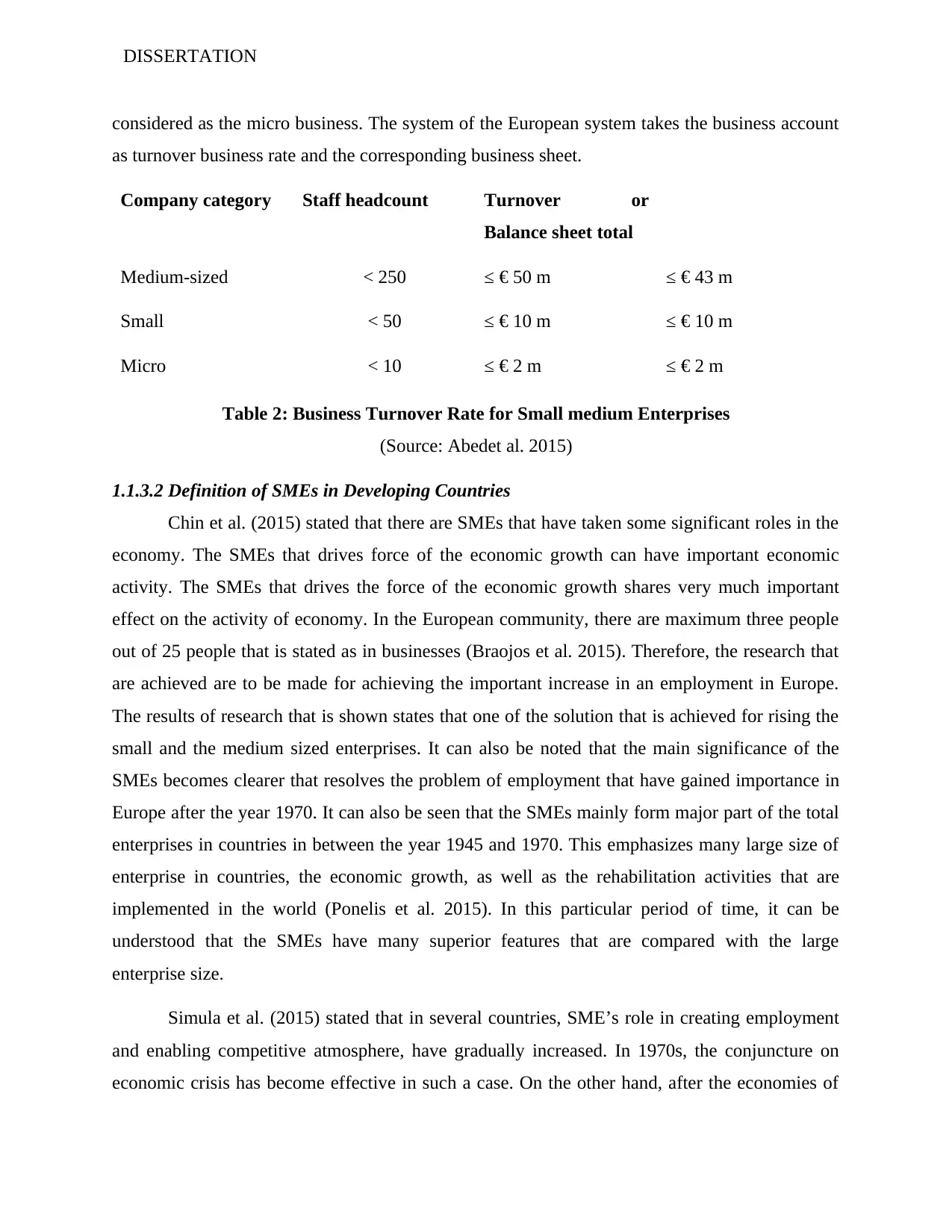
DISSERTATION
considered as the micro business. The system of the European system takes the business account
as turnover business rate and the corresponding business sheet.
Company category Staff headcount Turnover or
Balance sheet total
Medium-sized < 250 ≤ € 50 m ≤ € 43 m
Small < 50 ≤ € 10 m ≤ € 10 m
Micro < 10 ≤ € 2 m ≤ € 2 m
Table 2: Business Turnover Rate for Small medium Enterprises
(Source: Abedet al. 2015)
1.1.3.2 Definition of SMEs in Developing Countries
Chin et al. (2015) stated that there are SMEs that have taken some significant roles in the
economy. The SMEs that drives force of the economic growth can have important economic
activity. The SMEs that drives the force of the economic growth shares very much important
effect on the activity of economy. In the European community, there are maximum three people
out of 25 people that is stated as in businesses (Braojos et al. 2015). Therefore, the research that
are achieved are to be made for achieving the important increase in an employment in Europe.
The results of research that is shown states that one of the solution that is achieved for rising the
small and the medium sized enterprises. It can also be noted that the main significance of the
SMEs becomes clearer that resolves the problem of employment that have gained importance in
Europe after the year 1970. It can also be seen that the SMEs mainly form major part of the total
enterprises in countries in between the year 1945 and 1970. This emphasizes many large size of
enterprise in countries, the economic growth, as well as the rehabilitation activities that are
implemented in the world (Ponelis et al. 2015). In this particular period of time, it can be
understood that the SMEs have many superior features that are compared with the large
enterprise size.
Simula et al. (2015) stated that in several countries, SME’s role in creating employment
and enabling competitive atmosphere, have gradually increased. In 1970s, the conjuncture on
economic crisis has become effective in such a case. On the other hand, after the economies of
considered as the micro business. The system of the European system takes the business account
as turnover business rate and the corresponding business sheet.
Company category Staff headcount Turnover or
Balance sheet total
Medium-sized < 250 ≤ € 50 m ≤ € 43 m
Small < 50 ≤ € 10 m ≤ € 10 m
Micro < 10 ≤ € 2 m ≤ € 2 m
Table 2: Business Turnover Rate for Small medium Enterprises
(Source: Abedet al. 2015)
1.1.3.2 Definition of SMEs in Developing Countries
Chin et al. (2015) stated that there are SMEs that have taken some significant roles in the
economy. The SMEs that drives force of the economic growth can have important economic
activity. The SMEs that drives the force of the economic growth shares very much important
effect on the activity of economy. In the European community, there are maximum three people
out of 25 people that is stated as in businesses (Braojos et al. 2015). Therefore, the research that
are achieved are to be made for achieving the important increase in an employment in Europe.
The results of research that is shown states that one of the solution that is achieved for rising the
small and the medium sized enterprises. It can also be noted that the main significance of the
SMEs becomes clearer that resolves the problem of employment that have gained importance in
Europe after the year 1970. It can also be seen that the SMEs mainly form major part of the total
enterprises in countries in between the year 1945 and 1970. This emphasizes many large size of
enterprise in countries, the economic growth, as well as the rehabilitation activities that are
implemented in the world (Ponelis et al. 2015). In this particular period of time, it can be
understood that the SMEs have many superior features that are compared with the large
enterprise size.
Simula et al. (2015) stated that in several countries, SME’s role in creating employment
and enabling competitive atmosphere, have gradually increased. In 1970s, the conjuncture on
economic crisis has become effective in such a case. On the other hand, after the economies of
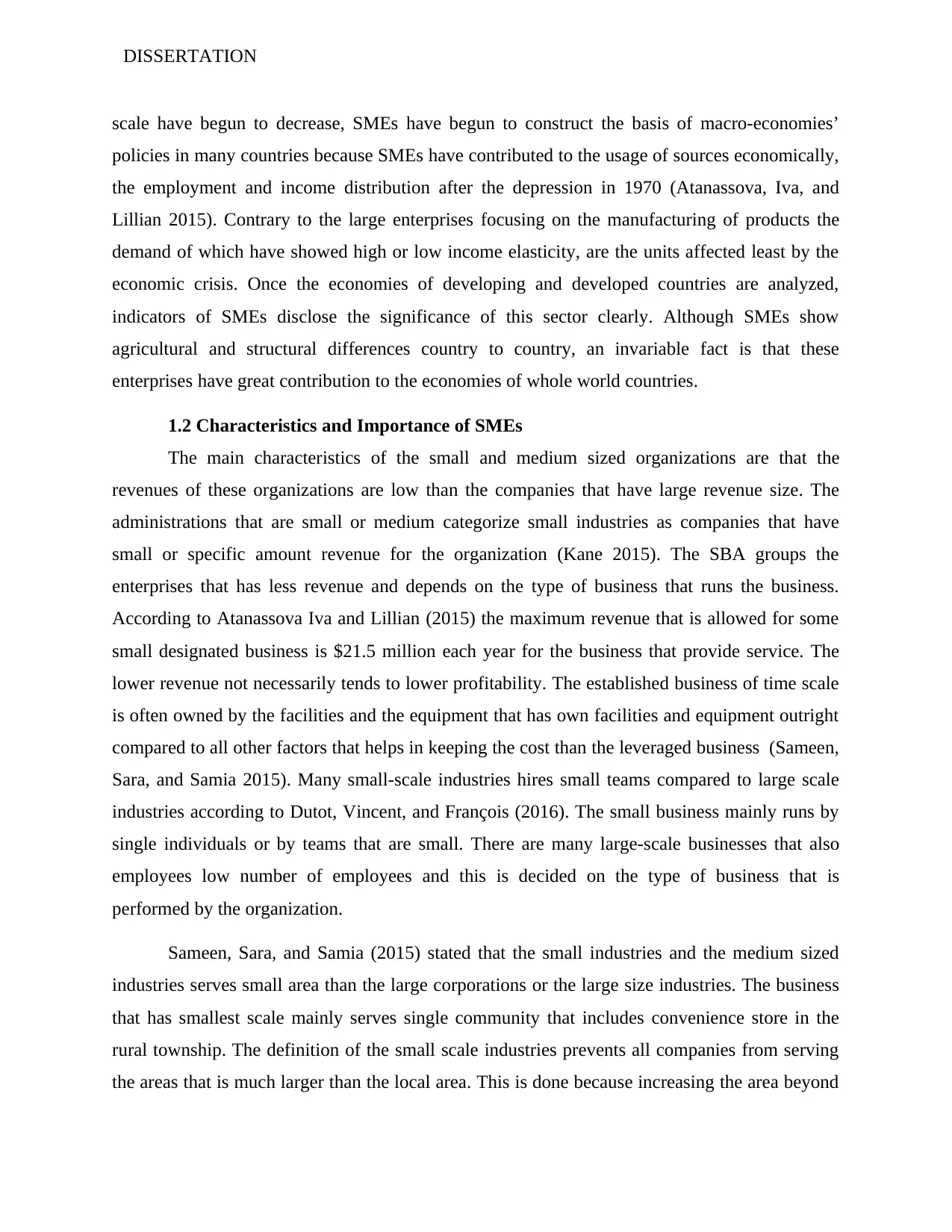
DISSERTATION
scale have begun to decrease, SMEs have begun to construct the basis of macro-economies’
policies in many countries because SMEs have contributed to the usage of sources economically,
the employment and income distribution after the depression in 1970 (Atanassova, Iva, and
Lillian 2015). Contrary to the large enterprises focusing on the manufacturing of products the
demand of which have showed high or low income elasticity, are the units affected least by the
economic crisis. Once the economies of developing and developed countries are analyzed,
indicators of SMEs disclose the significance of this sector clearly. Although SMEs show
agricultural and structural differences country to country, an invariable fact is that these
enterprises have great contribution to the economies of whole world countries.
1.2 Characteristics and Importance of SMEs
The main characteristics of the small and medium sized organizations are that the
revenues of these organizations are low than the companies that have large revenue size. The
administrations that are small or medium categorize small industries as companies that have
small or specific amount revenue for the organization (Kane 2015). The SBA groups the
enterprises that has less revenue and depends on the type of business that runs the business.
According to Atanassova Iva and Lillian (2015) the maximum revenue that is allowed for some
small designated business is $21.5 million each year for the business that provide service. The
lower revenue not necessarily tends to lower profitability. The established business of time scale
is often owned by the facilities and the equipment that has own facilities and equipment outright
compared to all other factors that helps in keeping the cost than the leveraged business (Sameen,
Sara, and Samia 2015). Many small-scale industries hires small teams compared to large scale
industries according to Dutot, Vincent, and François (2016). The small business mainly runs by
single individuals or by teams that are small. There are many large-scale businesses that also
employees low number of employees and this is decided on the type of business that is
performed by the organization.
Sameen, Sara, and Samia (2015) stated that the small industries and the medium sized
industries serves small area than the large corporations or the large size industries. The business
that has smallest scale mainly serves single community that includes convenience store in the
rural township. The definition of the small scale industries prevents all companies from serving
the areas that is much larger than the local area. This is done because increasing the area beyond
scale have begun to decrease, SMEs have begun to construct the basis of macro-economies’
policies in many countries because SMEs have contributed to the usage of sources economically,
the employment and income distribution after the depression in 1970 (Atanassova, Iva, and
Lillian 2015). Contrary to the large enterprises focusing on the manufacturing of products the
demand of which have showed high or low income elasticity, are the units affected least by the
economic crisis. Once the economies of developing and developed countries are analyzed,
indicators of SMEs disclose the significance of this sector clearly. Although SMEs show
agricultural and structural differences country to country, an invariable fact is that these
enterprises have great contribution to the economies of whole world countries.
1.2 Characteristics and Importance of SMEs
The main characteristics of the small and medium sized organizations are that the
revenues of these organizations are low than the companies that have large revenue size. The
administrations that are small or medium categorize small industries as companies that have
small or specific amount revenue for the organization (Kane 2015). The SBA groups the
enterprises that has less revenue and depends on the type of business that runs the business.
According to Atanassova Iva and Lillian (2015) the maximum revenue that is allowed for some
small designated business is $21.5 million each year for the business that provide service. The
lower revenue not necessarily tends to lower profitability. The established business of time scale
is often owned by the facilities and the equipment that has own facilities and equipment outright
compared to all other factors that helps in keeping the cost than the leveraged business (Sameen,
Sara, and Samia 2015). Many small-scale industries hires small teams compared to large scale
industries according to Dutot, Vincent, and François (2016). The small business mainly runs by
single individuals or by teams that are small. There are many large-scale businesses that also
employees low number of employees and this is decided on the type of business that is
performed by the organization.
Sameen, Sara, and Samia (2015) stated that the small industries and the medium sized
industries serves small area than the large corporations or the large size industries. The business
that has smallest scale mainly serves single community that includes convenience store in the
rural township. The definition of the small scale industries prevents all companies from serving
the areas that is much larger than the local area. This is done because increasing the area beyond

DISSERTATION
that would help the organization to become bigger and thus will have a different categorization
or classification of industry. The business organization that has corporate form is not actually
well suited to the operations of small scale (Kane 2015). Most of small scale industries prefers in
organizing a sole proprietorship, liabilities of company that are limited and the partnerships that
the company has with other companies. Particularly these organizations provide large degrees of
managerial control for all the owners of the companies that minimize hassle and the expense of
the business registration. The business does not submit their own taxes. The owners of the
companies or the enterprises report their business income as well as expense to personal tax
returns.
From the above study, it can be stated that small as well as medium scale industries has
very limited definition (Taylor 2015). The companies that comes under SME does not have any
other outlets in different countries. There are large number of small and medium scale industries
that operates from only one office, one retail store or from only one service outlet. This is also
possible for not running a small business directly from home and operating without any type of
company facilities.
1.3 Challenges Faced by SMEs
There are many challenges that are faced by the Small Medium Sized enterprise as they
can only face problems that generally comes from the bigger organizations. The main challenge
that is faced by the small and the medium sized organizations are described below:
1.3.1 Increased Competition
Over some years, marketplace has increased ben overcrowded and the marketplace has
become more competitive. For the small and medium enterprises, it is very important to work on
their individuality and makes their products and services unique from others in order to increase
their gain percentage (Atanassova, Iva, and Lillian 2015). To provide unique service to the
crowd, the businesses mainly needs to be a special one in terms of people, product, and delivery
as well as in terms of idea.
All the small medium associations need in identifying as well as devising the market
competition for gaining advantage from other organizations. The SMEs needs to stand out from
their regular products and services in the marketplace. The managers of the SMEs need to move
that would help the organization to become bigger and thus will have a different categorization
or classification of industry. The business organization that has corporate form is not actually
well suited to the operations of small scale (Kane 2015). Most of small scale industries prefers in
organizing a sole proprietorship, liabilities of company that are limited and the partnerships that
the company has with other companies. Particularly these organizations provide large degrees of
managerial control for all the owners of the companies that minimize hassle and the expense of
the business registration. The business does not submit their own taxes. The owners of the
companies or the enterprises report their business income as well as expense to personal tax
returns.
From the above study, it can be stated that small as well as medium scale industries has
very limited definition (Taylor 2015). The companies that comes under SME does not have any
other outlets in different countries. There are large number of small and medium scale industries
that operates from only one office, one retail store or from only one service outlet. This is also
possible for not running a small business directly from home and operating without any type of
company facilities.
1.3 Challenges Faced by SMEs
There are many challenges that are faced by the Small Medium Sized enterprise as they
can only face problems that generally comes from the bigger organizations. The main challenge
that is faced by the small and the medium sized organizations are described below:
1.3.1 Increased Competition
Over some years, marketplace has increased ben overcrowded and the marketplace has
become more competitive. For the small and medium enterprises, it is very important to work on
their individuality and makes their products and services unique from others in order to increase
their gain percentage (Atanassova, Iva, and Lillian 2015). To provide unique service to the
crowd, the businesses mainly needs to be a special one in terms of people, product, and delivery
as well as in terms of idea.
All the small medium associations need in identifying as well as devising the market
competition for gaining advantage from other organizations. The SMEs needs to stand out from
their regular products and services in the marketplace. The managers of the SMEs need to move
Secure Best Marks with AI Grader
Need help grading? Try our AI Grader for instant feedback on your assignments.
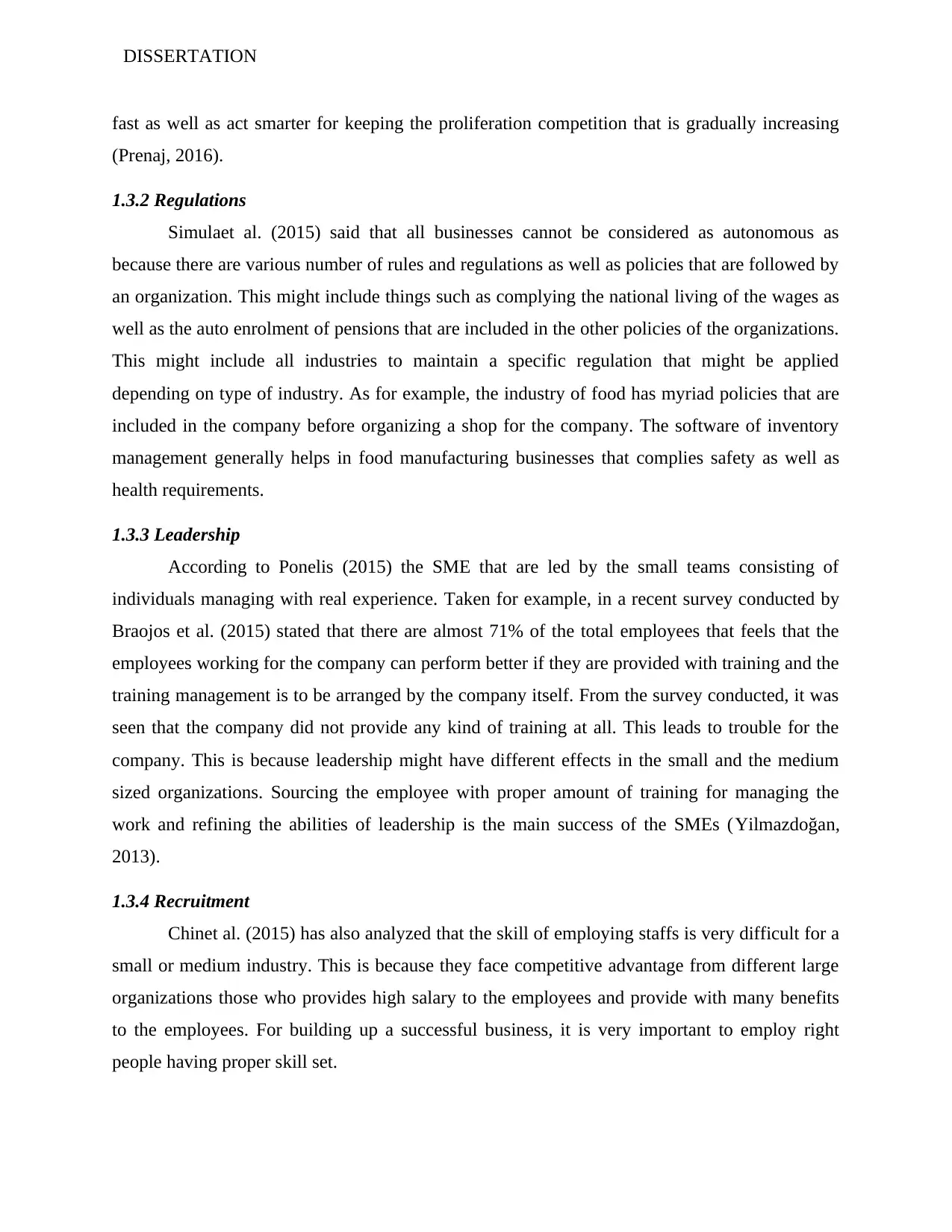
DISSERTATION
fast as well as act smarter for keeping the proliferation competition that is gradually increasing
(Prenaj, 2016).
1.3.2 Regulations
Simulaet al. (2015) said that all businesses cannot be considered as autonomous as
because there are various number of rules and regulations as well as policies that are followed by
an organization. This might include things such as complying the national living of the wages as
well as the auto enrolment of pensions that are included in the other policies of the organizations.
This might include all industries to maintain a specific regulation that might be applied
depending on type of industry. As for example, the industry of food has myriad policies that are
included in the company before organizing a shop for the company. The software of inventory
management generally helps in food manufacturing businesses that complies safety as well as
health requirements.
1.3.3 Leadership
According to Ponelis (2015) the SME that are led by the small teams consisting of
individuals managing with real experience. Taken for example, in a recent survey conducted by
Braojos et al. (2015) stated that there are almost 71% of the total employees that feels that the
employees working for the company can perform better if they are provided with training and the
training management is to be arranged by the company itself. From the survey conducted, it was
seen that the company did not provide any kind of training at all. This leads to trouble for the
company. This is because leadership might have different effects in the small and the medium
sized organizations. Sourcing the employee with proper amount of training for managing the
work and refining the abilities of leadership is the main success of the SMEs (Yilmazdoğan,
2013).
1.3.4 Recruitment
Chinet al. (2015) has also analyzed that the skill of employing staffs is very difficult for a
small or medium industry. This is because they face competitive advantage from different large
organizations those who provides high salary to the employees and provide with many benefits
to the employees. For building up a successful business, it is very important to employ right
people having proper skill set.
fast as well as act smarter for keeping the proliferation competition that is gradually increasing
(Prenaj, 2016).
1.3.2 Regulations
Simulaet al. (2015) said that all businesses cannot be considered as autonomous as
because there are various number of rules and regulations as well as policies that are followed by
an organization. This might include things such as complying the national living of the wages as
well as the auto enrolment of pensions that are included in the other policies of the organizations.
This might include all industries to maintain a specific regulation that might be applied
depending on type of industry. As for example, the industry of food has myriad policies that are
included in the company before organizing a shop for the company. The software of inventory
management generally helps in food manufacturing businesses that complies safety as well as
health requirements.
1.3.3 Leadership
According to Ponelis (2015) the SME that are led by the small teams consisting of
individuals managing with real experience. Taken for example, in a recent survey conducted by
Braojos et al. (2015) stated that there are almost 71% of the total employees that feels that the
employees working for the company can perform better if they are provided with training and the
training management is to be arranged by the company itself. From the survey conducted, it was
seen that the company did not provide any kind of training at all. This leads to trouble for the
company. This is because leadership might have different effects in the small and the medium
sized organizations. Sourcing the employee with proper amount of training for managing the
work and refining the abilities of leadership is the main success of the SMEs (Yilmazdoğan,
2013).
1.3.4 Recruitment
Chinet al. (2015) has also analyzed that the skill of employing staffs is very difficult for a
small or medium industry. This is because they face competitive advantage from different large
organizations those who provides high salary to the employees and provide with many benefits
to the employees. For building up a successful business, it is very important to employ right
people having proper skill set.
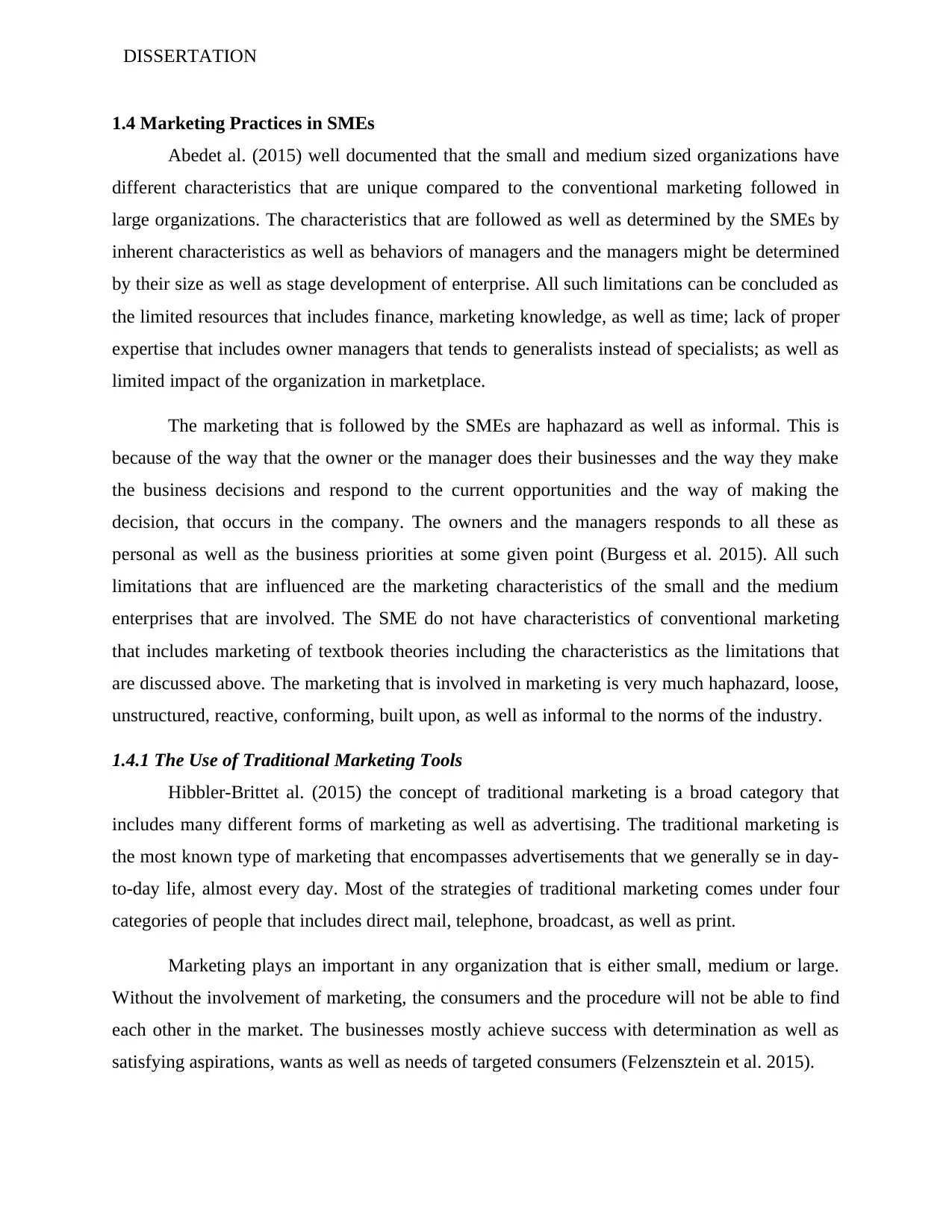
DISSERTATION
1.4 Marketing Practices in SMEs
Abedet al. (2015) well documented that the small and medium sized organizations have
different characteristics that are unique compared to the conventional marketing followed in
large organizations. The characteristics that are followed as well as determined by the SMEs by
inherent characteristics as well as behaviors of managers and the managers might be determined
by their size as well as stage development of enterprise. All such limitations can be concluded as
the limited resources that includes finance, marketing knowledge, as well as time; lack of proper
expertise that includes owner managers that tends to generalists instead of specialists; as well as
limited impact of the organization in marketplace.
The marketing that is followed by the SMEs are haphazard as well as informal. This is
because of the way that the owner or the manager does their businesses and the way they make
the business decisions and respond to the current opportunities and the way of making the
decision, that occurs in the company. The owners and the managers responds to all these as
personal as well as the business priorities at some given point (Burgess et al. 2015). All such
limitations that are influenced are the marketing characteristics of the small and the medium
enterprises that are involved. The SME do not have characteristics of conventional marketing
that includes marketing of textbook theories including the characteristics as the limitations that
are discussed above. The marketing that is involved in marketing is very much haphazard, loose,
unstructured, reactive, conforming, built upon, as well as informal to the norms of the industry.
1.4.1 The Use of Traditional Marketing Tools
Hibbler-Brittet al. (2015) the concept of traditional marketing is a broad category that
includes many different forms of marketing as well as advertising. The traditional marketing is
the most known type of marketing that encompasses advertisements that we generally se in day-
to-day life, almost every day. Most of the strategies of traditional marketing comes under four
categories of people that includes direct mail, telephone, broadcast, as well as print.
Marketing plays an important in any organization that is either small, medium or large.
Without the involvement of marketing, the consumers and the procedure will not be able to find
each other in the market. The businesses mostly achieve success with determination as well as
satisfying aspirations, wants as well as needs of targeted consumers (Felzensztein et al. 2015).
1.4 Marketing Practices in SMEs
Abedet al. (2015) well documented that the small and medium sized organizations have
different characteristics that are unique compared to the conventional marketing followed in
large organizations. The characteristics that are followed as well as determined by the SMEs by
inherent characteristics as well as behaviors of managers and the managers might be determined
by their size as well as stage development of enterprise. All such limitations can be concluded as
the limited resources that includes finance, marketing knowledge, as well as time; lack of proper
expertise that includes owner managers that tends to generalists instead of specialists; as well as
limited impact of the organization in marketplace.
The marketing that is followed by the SMEs are haphazard as well as informal. This is
because of the way that the owner or the manager does their businesses and the way they make
the business decisions and respond to the current opportunities and the way of making the
decision, that occurs in the company. The owners and the managers responds to all these as
personal as well as the business priorities at some given point (Burgess et al. 2015). All such
limitations that are influenced are the marketing characteristics of the small and the medium
enterprises that are involved. The SME do not have characteristics of conventional marketing
that includes marketing of textbook theories including the characteristics as the limitations that
are discussed above. The marketing that is involved in marketing is very much haphazard, loose,
unstructured, reactive, conforming, built upon, as well as informal to the norms of the industry.
1.4.1 The Use of Traditional Marketing Tools
Hibbler-Brittet al. (2015) the concept of traditional marketing is a broad category that
includes many different forms of marketing as well as advertising. The traditional marketing is
the most known type of marketing that encompasses advertisements that we generally se in day-
to-day life, almost every day. Most of the strategies of traditional marketing comes under four
categories of people that includes direct mail, telephone, broadcast, as well as print.
Marketing plays an important in any organization that is either small, medium or large.
Without the involvement of marketing, the consumers and the procedure will not be able to find
each other in the market. The businesses mostly achieve success with determination as well as
satisfying aspirations, wants as well as needs of targeted consumers (Felzensztein et al. 2015).
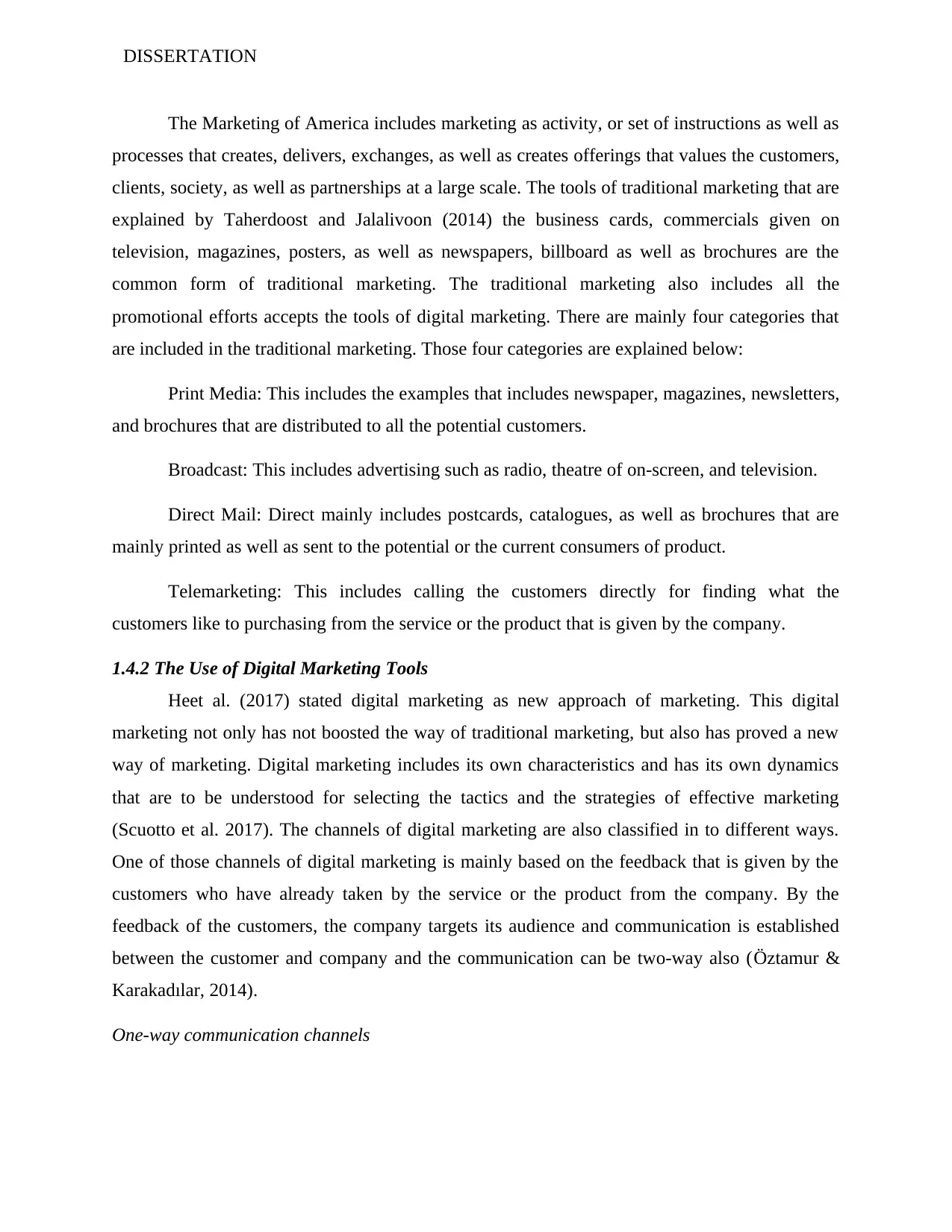
DISSERTATION
The Marketing of America includes marketing as activity, or set of instructions as well as
processes that creates, delivers, exchanges, as well as creates offerings that values the customers,
clients, society, as well as partnerships at a large scale. The tools of traditional marketing that are
explained by Taherdoost and Jalalivoon (2014) the business cards, commercials given on
television, magazines, posters, as well as newspapers, billboard as well as brochures are the
common form of traditional marketing. The traditional marketing also includes all the
promotional efforts accepts the tools of digital marketing. There are mainly four categories that
are included in the traditional marketing. Those four categories are explained below:
Print Media: This includes the examples that includes newspaper, magazines, newsletters,
and brochures that are distributed to all the potential customers.
Broadcast: This includes advertising such as radio, theatre of on-screen, and television.
Direct Mail: Direct mainly includes postcards, catalogues, as well as brochures that are
mainly printed as well as sent to the potential or the current consumers of product.
Telemarketing: This includes calling the customers directly for finding what the
customers like to purchasing from the service or the product that is given by the company.
1.4.2 The Use of Digital Marketing Tools
Heet al. (2017) stated digital marketing as new approach of marketing. This digital
marketing not only has not boosted the way of traditional marketing, but also has proved a new
way of marketing. Digital marketing includes its own characteristics and has its own dynamics
that are to be understood for selecting the tactics and the strategies of effective marketing
(Scuotto et al. 2017). The channels of digital marketing are also classified in to different ways.
One of those channels of digital marketing is mainly based on the feedback that is given by the
customers who have already taken by the service or the product from the company. By the
feedback of the customers, the company targets its audience and communication is established
between the customer and company and the communication can be two-way also (Öztamur &
Karakadılar, 2014).
One-way communication channels
The Marketing of America includes marketing as activity, or set of instructions as well as
processes that creates, delivers, exchanges, as well as creates offerings that values the customers,
clients, society, as well as partnerships at a large scale. The tools of traditional marketing that are
explained by Taherdoost and Jalalivoon (2014) the business cards, commercials given on
television, magazines, posters, as well as newspapers, billboard as well as brochures are the
common form of traditional marketing. The traditional marketing also includes all the
promotional efforts accepts the tools of digital marketing. There are mainly four categories that
are included in the traditional marketing. Those four categories are explained below:
Print Media: This includes the examples that includes newspaper, magazines, newsletters,
and brochures that are distributed to all the potential customers.
Broadcast: This includes advertising such as radio, theatre of on-screen, and television.
Direct Mail: Direct mainly includes postcards, catalogues, as well as brochures that are
mainly printed as well as sent to the potential or the current consumers of product.
Telemarketing: This includes calling the customers directly for finding what the
customers like to purchasing from the service or the product that is given by the company.
1.4.2 The Use of Digital Marketing Tools
Heet al. (2017) stated digital marketing as new approach of marketing. This digital
marketing not only has not boosted the way of traditional marketing, but also has proved a new
way of marketing. Digital marketing includes its own characteristics and has its own dynamics
that are to be understood for selecting the tactics and the strategies of effective marketing
(Scuotto et al. 2017). The channels of digital marketing are also classified in to different ways.
One of those channels of digital marketing is mainly based on the feedback that is given by the
customers who have already taken by the service or the product from the company. By the
feedback of the customers, the company targets its audience and communication is established
between the customer and company and the communication can be two-way also (Öztamur &
Karakadılar, 2014).
One-way communication channels
Paraphrase This Document
Need a fresh take? Get an instant paraphrase of this document with our AI Paraphraser
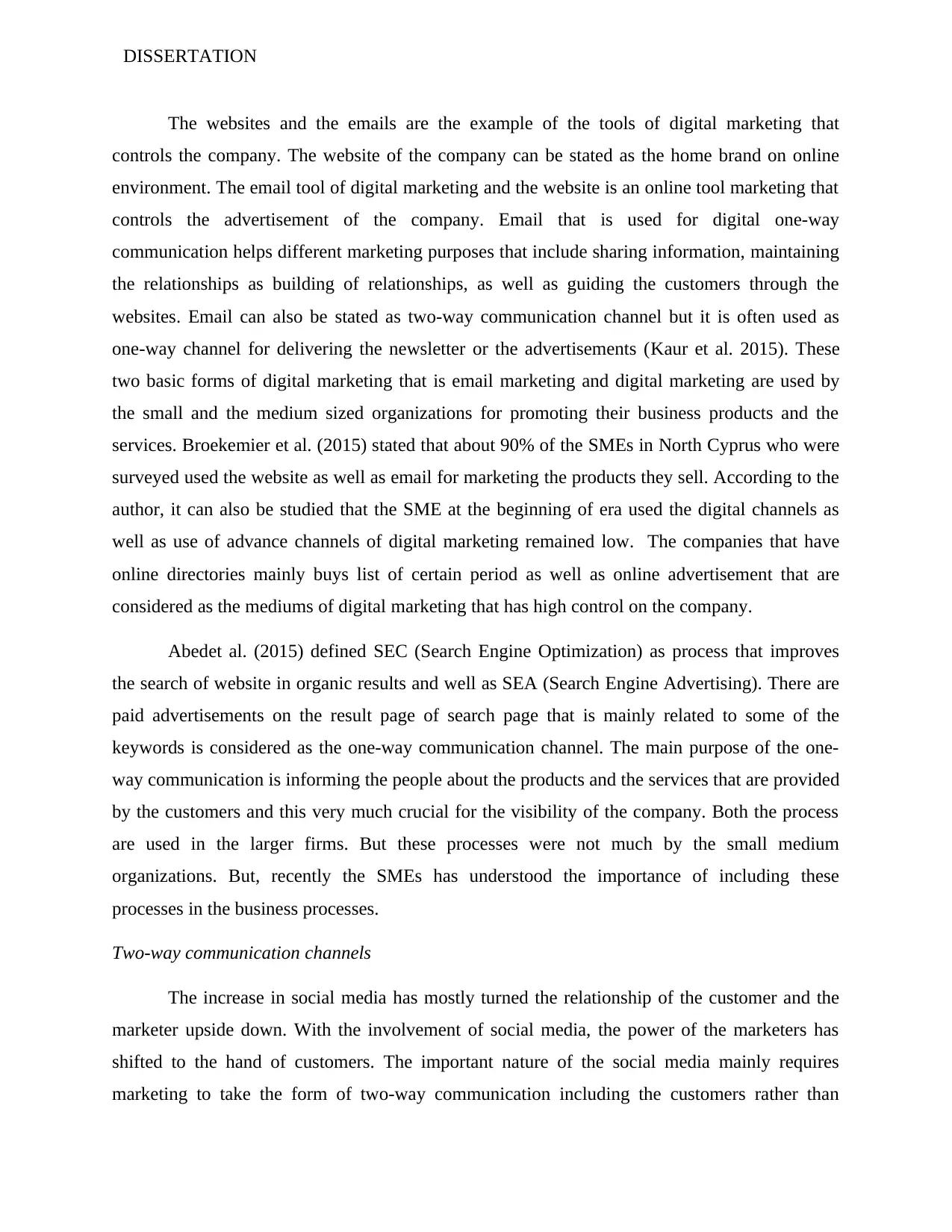
DISSERTATION
The websites and the emails are the example of the tools of digital marketing that
controls the company. The website of the company can be stated as the home brand on online
environment. The email tool of digital marketing and the website is an online tool marketing that
controls the advertisement of the company. Email that is used for digital one-way
communication helps different marketing purposes that include sharing information, maintaining
the relationships as building of relationships, as well as guiding the customers through the
websites. Email can also be stated as two-way communication channel but it is often used as
one-way channel for delivering the newsletter or the advertisements (Kaur et al. 2015). These
two basic forms of digital marketing that is email marketing and digital marketing are used by
the small and the medium sized organizations for promoting their business products and the
services. Broekemier et al. (2015) stated that about 90% of the SMEs in North Cyprus who were
surveyed used the website as well as email for marketing the products they sell. According to the
author, it can also be studied that the SME at the beginning of era used the digital channels as
well as use of advance channels of digital marketing remained low. The companies that have
online directories mainly buys list of certain period as well as online advertisement that are
considered as the mediums of digital marketing that has high control on the company.
Abedet al. (2015) defined SEC (Search Engine Optimization) as process that improves
the search of website in organic results and well as SEA (Search Engine Advertising). There are
paid advertisements on the result page of search page that is mainly related to some of the
keywords is considered as the one-way communication channel. The main purpose of the one-
way communication is informing the people about the products and the services that are provided
by the customers and this very much crucial for the visibility of the company. Both the process
are used in the larger firms. But these processes were not much by the small medium
organizations. But, recently the SMEs has understood the importance of including these
processes in the business processes.
Two-way communication channels
The increase in social media has mostly turned the relationship of the customer and the
marketer upside down. With the involvement of social media, the power of the marketers has
shifted to the hand of customers. The important nature of the social media mainly requires
marketing to take the form of two-way communication including the customers rather than
The websites and the emails are the example of the tools of digital marketing that
controls the company. The website of the company can be stated as the home brand on online
environment. The email tool of digital marketing and the website is an online tool marketing that
controls the advertisement of the company. Email that is used for digital one-way
communication helps different marketing purposes that include sharing information, maintaining
the relationships as building of relationships, as well as guiding the customers through the
websites. Email can also be stated as two-way communication channel but it is often used as
one-way channel for delivering the newsletter or the advertisements (Kaur et al. 2015). These
two basic forms of digital marketing that is email marketing and digital marketing are used by
the small and the medium sized organizations for promoting their business products and the
services. Broekemier et al. (2015) stated that about 90% of the SMEs in North Cyprus who were
surveyed used the website as well as email for marketing the products they sell. According to the
author, it can also be studied that the SME at the beginning of era used the digital channels as
well as use of advance channels of digital marketing remained low. The companies that have
online directories mainly buys list of certain period as well as online advertisement that are
considered as the mediums of digital marketing that has high control on the company.
Abedet al. (2015) defined SEC (Search Engine Optimization) as process that improves
the search of website in organic results and well as SEA (Search Engine Advertising). There are
paid advertisements on the result page of search page that is mainly related to some of the
keywords is considered as the one-way communication channel. The main purpose of the one-
way communication is informing the people about the products and the services that are provided
by the customers and this very much crucial for the visibility of the company. Both the process
are used in the larger firms. But these processes were not much by the small medium
organizations. But, recently the SMEs has understood the importance of including these
processes in the business processes.
Two-way communication channels
The increase in social media has mostly turned the relationship of the customer and the
marketer upside down. With the involvement of social media, the power of the marketers has
shifted to the hand of customers. The important nature of the social media mainly requires
marketing to take the form of two-way communication including the customers rather than
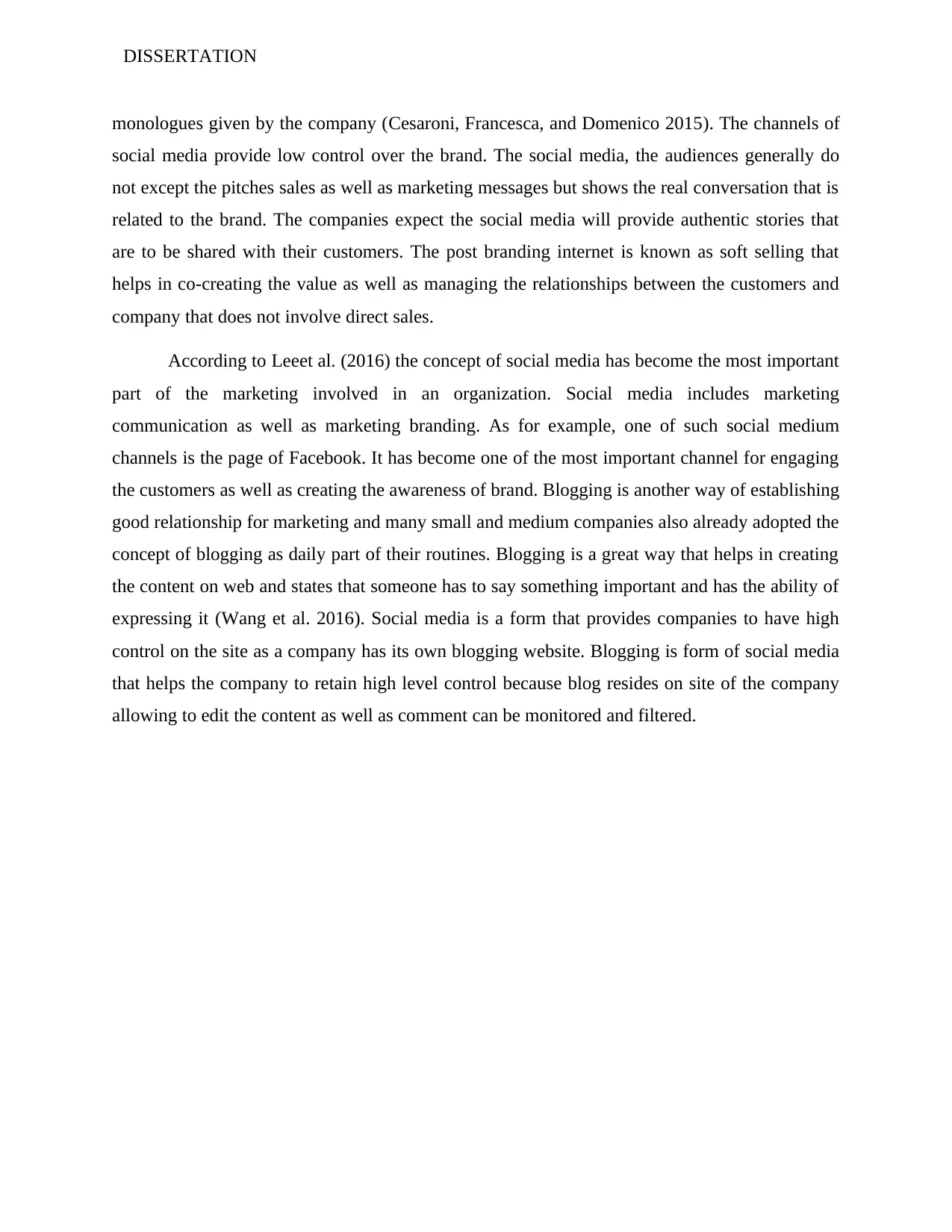
DISSERTATION
monologues given by the company (Cesaroni, Francesca, and Domenico 2015). The channels of
social media provide low control over the brand. The social media, the audiences generally do
not except the pitches sales as well as marketing messages but shows the real conversation that is
related to the brand. The companies expect the social media will provide authentic stories that
are to be shared with their customers. The post branding internet is known as soft selling that
helps in co-creating the value as well as managing the relationships between the customers and
company that does not involve direct sales.
According to Leeet al. (2016) the concept of social media has become the most important
part of the marketing involved in an organization. Social media includes marketing
communication as well as marketing branding. As for example, one of such social medium
channels is the page of Facebook. It has become one of the most important channel for engaging
the customers as well as creating the awareness of brand. Blogging is another way of establishing
good relationship for marketing and many small and medium companies also already adopted the
concept of blogging as daily part of their routines. Blogging is a great way that helps in creating
the content on web and states that someone has to say something important and has the ability of
expressing it (Wang et al. 2016). Social media is a form that provides companies to have high
control on the site as a company has its own blogging website. Blogging is form of social media
that helps the company to retain high level control because blog resides on site of the company
allowing to edit the content as well as comment can be monitored and filtered.
monologues given by the company (Cesaroni, Francesca, and Domenico 2015). The channels of
social media provide low control over the brand. The social media, the audiences generally do
not except the pitches sales as well as marketing messages but shows the real conversation that is
related to the brand. The companies expect the social media will provide authentic stories that
are to be shared with their customers. The post branding internet is known as soft selling that
helps in co-creating the value as well as managing the relationships between the customers and
company that does not involve direct sales.
According to Leeet al. (2016) the concept of social media has become the most important
part of the marketing involved in an organization. Social media includes marketing
communication as well as marketing branding. As for example, one of such social medium
channels is the page of Facebook. It has become one of the most important channel for engaging
the customers as well as creating the awareness of brand. Blogging is another way of establishing
good relationship for marketing and many small and medium companies also already adopted the
concept of blogging as daily part of their routines. Blogging is a great way that helps in creating
the content on web and states that someone has to say something important and has the ability of
expressing it (Wang et al. 2016). Social media is a form that provides companies to have high
control on the site as a company has its own blogging website. Blogging is form of social media
that helps the company to retain high level control because blog resides on site of the company
allowing to edit the content as well as comment can be monitored and filtered.
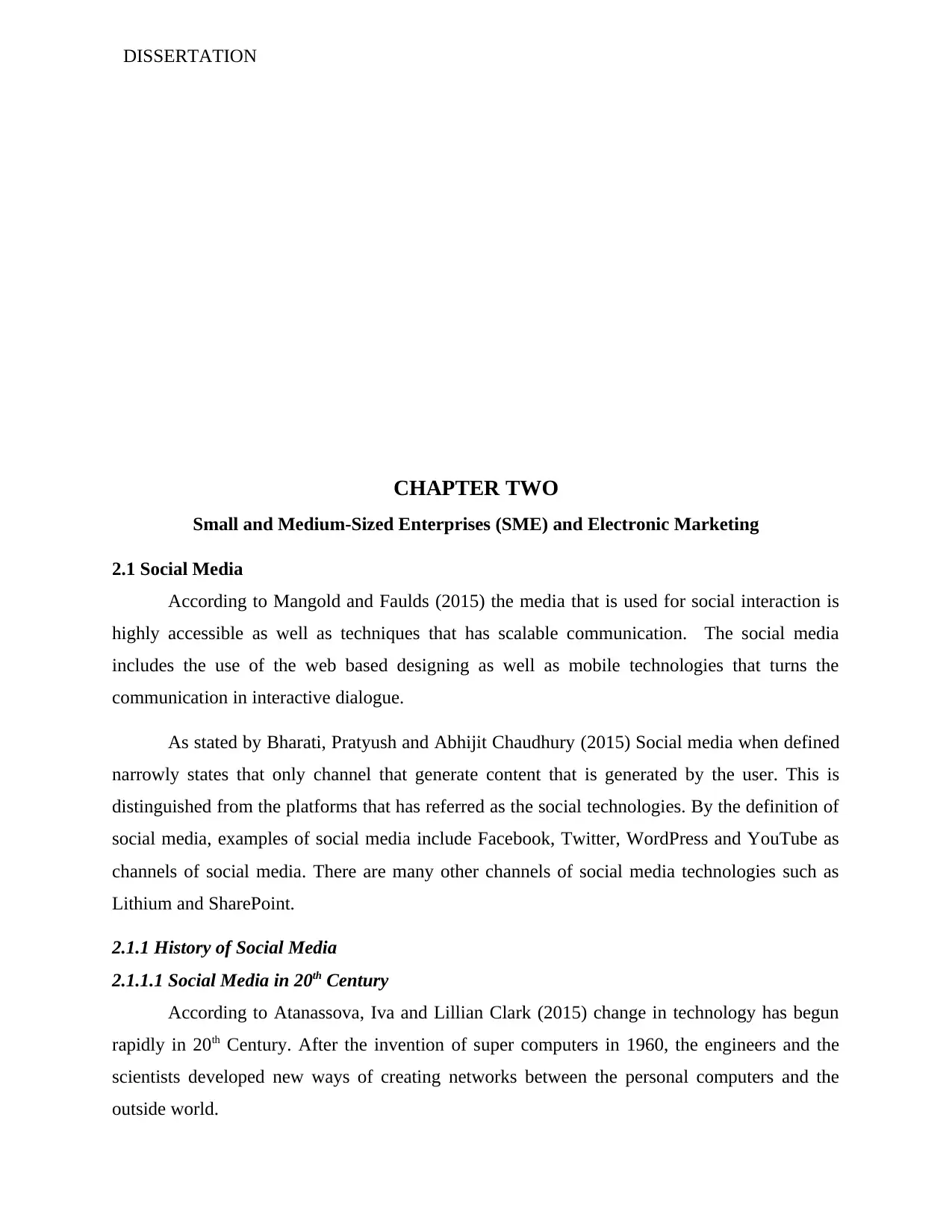
DISSERTATION
CHAPTER TWO
Small and Medium-Sized Enterprises (SME) and Electronic Marketing
2.1 Social Media
According to Mangold and Faulds (2015) the media that is used for social interaction is
highly accessible as well as techniques that has scalable communication. The social media
includes the use of the web based designing as well as mobile technologies that turns the
communication in interactive dialogue.
As stated by Bharati, Pratyush and Abhijit Chaudhury (2015) Social media when defined
narrowly states that only channel that generate content that is generated by the user. This is
distinguished from the platforms that has referred as the social technologies. By the definition of
social media, examples of social media include Facebook, Twitter, WordPress and YouTube as
channels of social media. There are many other channels of social media technologies such as
Lithium and SharePoint.
2.1.1 History of Social Media
2.1.1.1 Social Media in 20th Century
According to Atanassova, Iva and Lillian Clark (2015) change in technology has begun
rapidly in 20th Century. After the invention of super computers in 1960, the engineers and the
scientists developed new ways of creating networks between the personal computers and the
outside world.
CHAPTER TWO
Small and Medium-Sized Enterprises (SME) and Electronic Marketing
2.1 Social Media
According to Mangold and Faulds (2015) the media that is used for social interaction is
highly accessible as well as techniques that has scalable communication. The social media
includes the use of the web based designing as well as mobile technologies that turns the
communication in interactive dialogue.
As stated by Bharati, Pratyush and Abhijit Chaudhury (2015) Social media when defined
narrowly states that only channel that generate content that is generated by the user. This is
distinguished from the platforms that has referred as the social technologies. By the definition of
social media, examples of social media include Facebook, Twitter, WordPress and YouTube as
channels of social media. There are many other channels of social media technologies such as
Lithium and SharePoint.
2.1.1 History of Social Media
2.1.1.1 Social Media in 20th Century
According to Atanassova, Iva and Lillian Clark (2015) change in technology has begun
rapidly in 20th Century. After the invention of super computers in 1960, the engineers and the
scientists developed new ways of creating networks between the personal computers and the
outside world.
Secure Best Marks with AI Grader
Need help grading? Try our AI Grader for instant feedback on your assignments.
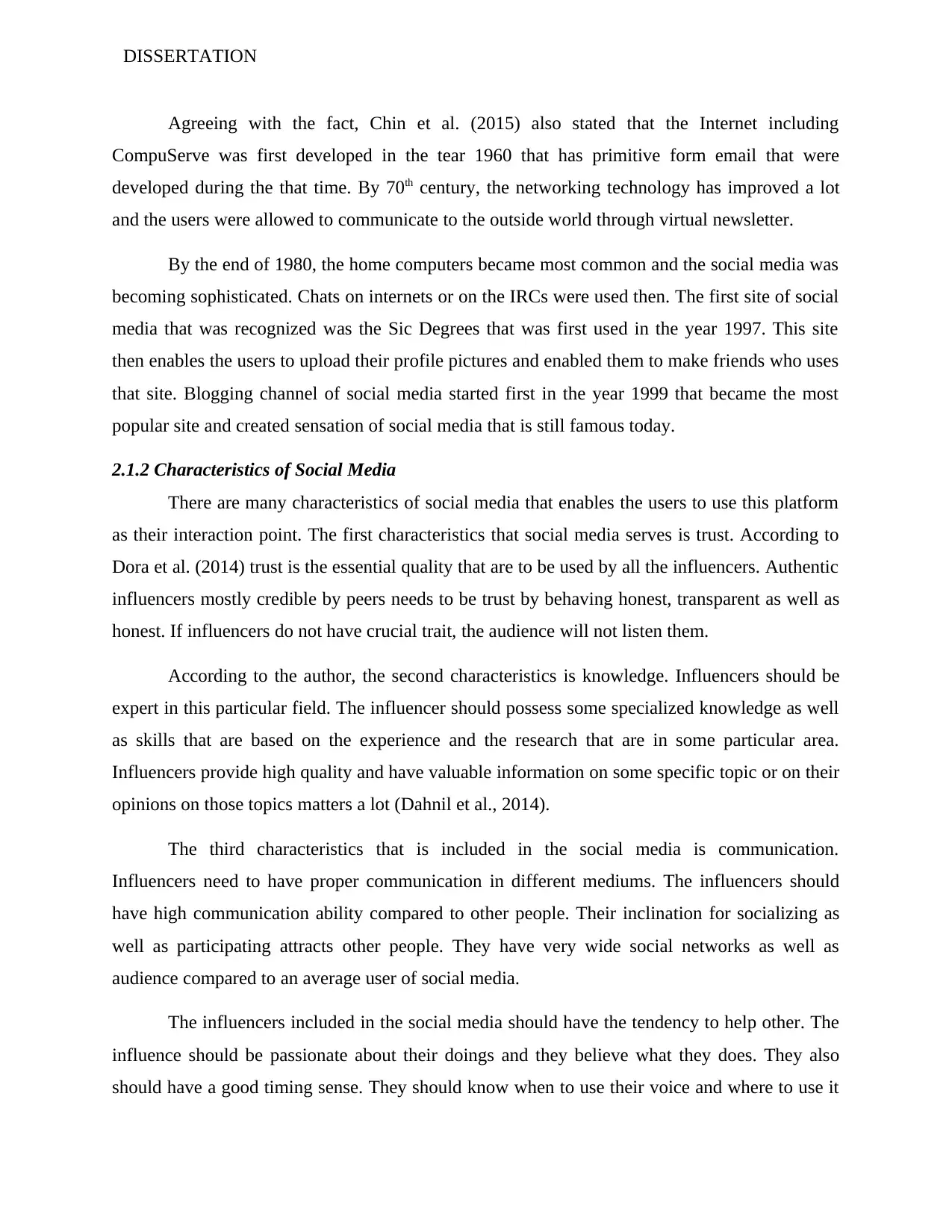
DISSERTATION
Agreeing with the fact, Chin et al. (2015) also stated that the Internet including
CompuServe was first developed in the tear 1960 that has primitive form email that were
developed during the that time. By 70th century, the networking technology has improved a lot
and the users were allowed to communicate to the outside world through virtual newsletter.
By the end of 1980, the home computers became most common and the social media was
becoming sophisticated. Chats on internets or on the IRCs were used then. The first site of social
media that was recognized was the Sic Degrees that was first used in the year 1997. This site
then enables the users to upload their profile pictures and enabled them to make friends who uses
that site. Blogging channel of social media started first in the year 1999 that became the most
popular site and created sensation of social media that is still famous today.
2.1.2 Characteristics of Social Media
There are many characteristics of social media that enables the users to use this platform
as their interaction point. The first characteristics that social media serves is trust. According to
Dora et al. (2014) trust is the essential quality that are to be used by all the influencers. Authentic
influencers mostly credible by peers needs to be trust by behaving honest, transparent as well as
honest. If influencers do not have crucial trait, the audience will not listen them.
According to the author, the second characteristics is knowledge. Influencers should be
expert in this particular field. The influencer should possess some specialized knowledge as well
as skills that are based on the experience and the research that are in some particular area.
Influencers provide high quality and have valuable information on some specific topic or on their
opinions on those topics matters a lot (Dahnil et al., 2014).
The third characteristics that is included in the social media is communication.
Influencers need to have proper communication in different mediums. The influencers should
have high communication ability compared to other people. Their inclination for socializing as
well as participating attracts other people. They have very wide social networks as well as
audience compared to an average user of social media.
The influencers included in the social media should have the tendency to help other. The
influence should be passionate about their doings and they believe what they does. They also
should have a good timing sense. They should know when to use their voice and where to use it
Agreeing with the fact, Chin et al. (2015) also stated that the Internet including
CompuServe was first developed in the tear 1960 that has primitive form email that were
developed during the that time. By 70th century, the networking technology has improved a lot
and the users were allowed to communicate to the outside world through virtual newsletter.
By the end of 1980, the home computers became most common and the social media was
becoming sophisticated. Chats on internets or on the IRCs were used then. The first site of social
media that was recognized was the Sic Degrees that was first used in the year 1997. This site
then enables the users to upload their profile pictures and enabled them to make friends who uses
that site. Blogging channel of social media started first in the year 1999 that became the most
popular site and created sensation of social media that is still famous today.
2.1.2 Characteristics of Social Media
There are many characteristics of social media that enables the users to use this platform
as their interaction point. The first characteristics that social media serves is trust. According to
Dora et al. (2014) trust is the essential quality that are to be used by all the influencers. Authentic
influencers mostly credible by peers needs to be trust by behaving honest, transparent as well as
honest. If influencers do not have crucial trait, the audience will not listen them.
According to the author, the second characteristics is knowledge. Influencers should be
expert in this particular field. The influencer should possess some specialized knowledge as well
as skills that are based on the experience and the research that are in some particular area.
Influencers provide high quality and have valuable information on some specific topic or on their
opinions on those topics matters a lot (Dahnil et al., 2014).
The third characteristics that is included in the social media is communication.
Influencers need to have proper communication in different mediums. The influencers should
have high communication ability compared to other people. Their inclination for socializing as
well as participating attracts other people. They have very wide social networks as well as
audience compared to an average user of social media.
The influencers included in the social media should have the tendency to help other. The
influence should be passionate about their doings and they believe what they does. They also
should have a good timing sense. They should know when to use their voice and where to use it
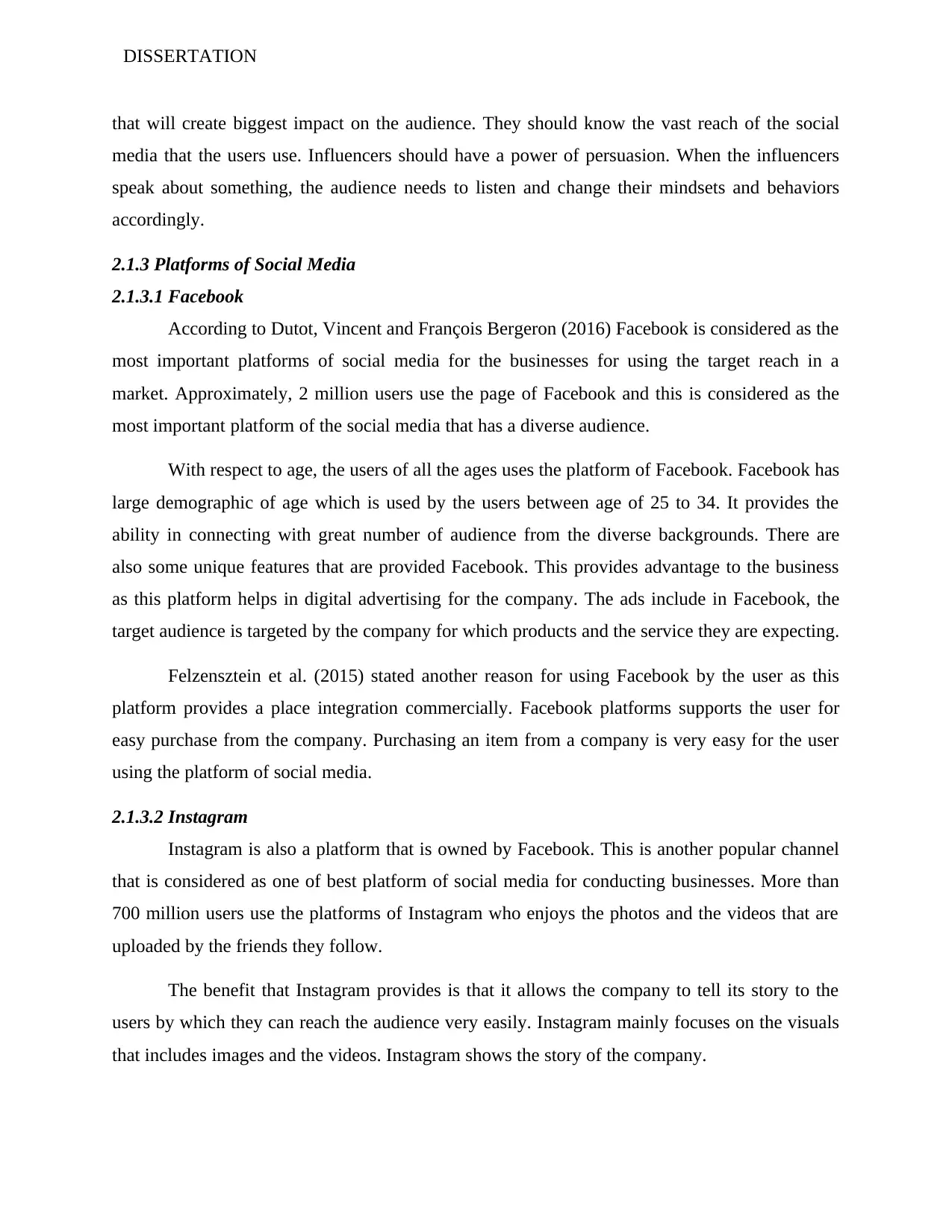
DISSERTATION
that will create biggest impact on the audience. They should know the vast reach of the social
media that the users use. Influencers should have a power of persuasion. When the influencers
speak about something, the audience needs to listen and change their mindsets and behaviors
accordingly.
2.1.3 Platforms of Social Media
2.1.3.1 Facebook
According to Dutot, Vincent and François Bergeron (2016) Facebook is considered as the
most important platforms of social media for the businesses for using the target reach in a
market. Approximately, 2 million users use the page of Facebook and this is considered as the
most important platform of the social media that has a diverse audience.
With respect to age, the users of all the ages uses the platform of Facebook. Facebook has
large demographic of age which is used by the users between age of 25 to 34. It provides the
ability in connecting with great number of audience from the diverse backgrounds. There are
also some unique features that are provided Facebook. This provides advantage to the business
as this platform helps in digital advertising for the company. The ads include in Facebook, the
target audience is targeted by the company for which products and the service they are expecting.
Felzensztein et al. (2015) stated another reason for using Facebook by the user as this
platform provides a place integration commercially. Facebook platforms supports the user for
easy purchase from the company. Purchasing an item from a company is very easy for the user
using the platform of social media.
2.1.3.2 Instagram
Instagram is also a platform that is owned by Facebook. This is another popular channel
that is considered as one of best platform of social media for conducting businesses. More than
700 million users use the platforms of Instagram who enjoys the photos and the videos that are
uploaded by the friends they follow.
The benefit that Instagram provides is that it allows the company to tell its story to the
users by which they can reach the audience very easily. Instagram mainly focuses on the visuals
that includes images and the videos. Instagram shows the story of the company.
that will create biggest impact on the audience. They should know the vast reach of the social
media that the users use. Influencers should have a power of persuasion. When the influencers
speak about something, the audience needs to listen and change their mindsets and behaviors
accordingly.
2.1.3 Platforms of Social Media
2.1.3.1 Facebook
According to Dutot, Vincent and François Bergeron (2016) Facebook is considered as the
most important platforms of social media for the businesses for using the target reach in a
market. Approximately, 2 million users use the page of Facebook and this is considered as the
most important platform of the social media that has a diverse audience.
With respect to age, the users of all the ages uses the platform of Facebook. Facebook has
large demographic of age which is used by the users between age of 25 to 34. It provides the
ability in connecting with great number of audience from the diverse backgrounds. There are
also some unique features that are provided Facebook. This provides advantage to the business
as this platform helps in digital advertising for the company. The ads include in Facebook, the
target audience is targeted by the company for which products and the service they are expecting.
Felzensztein et al. (2015) stated another reason for using Facebook by the user as this
platform provides a place integration commercially. Facebook platforms supports the user for
easy purchase from the company. Purchasing an item from a company is very easy for the user
using the platform of social media.
2.1.3.2 Instagram
Instagram is also a platform that is owned by Facebook. This is another popular channel
that is considered as one of best platform of social media for conducting businesses. More than
700 million users use the platforms of Instagram who enjoys the photos and the videos that are
uploaded by the friends they follow.
The benefit that Instagram provides is that it allows the company to tell its story to the
users by which they can reach the audience very easily. Instagram mainly focuses on the visuals
that includes images and the videos. Instagram shows the story of the company.
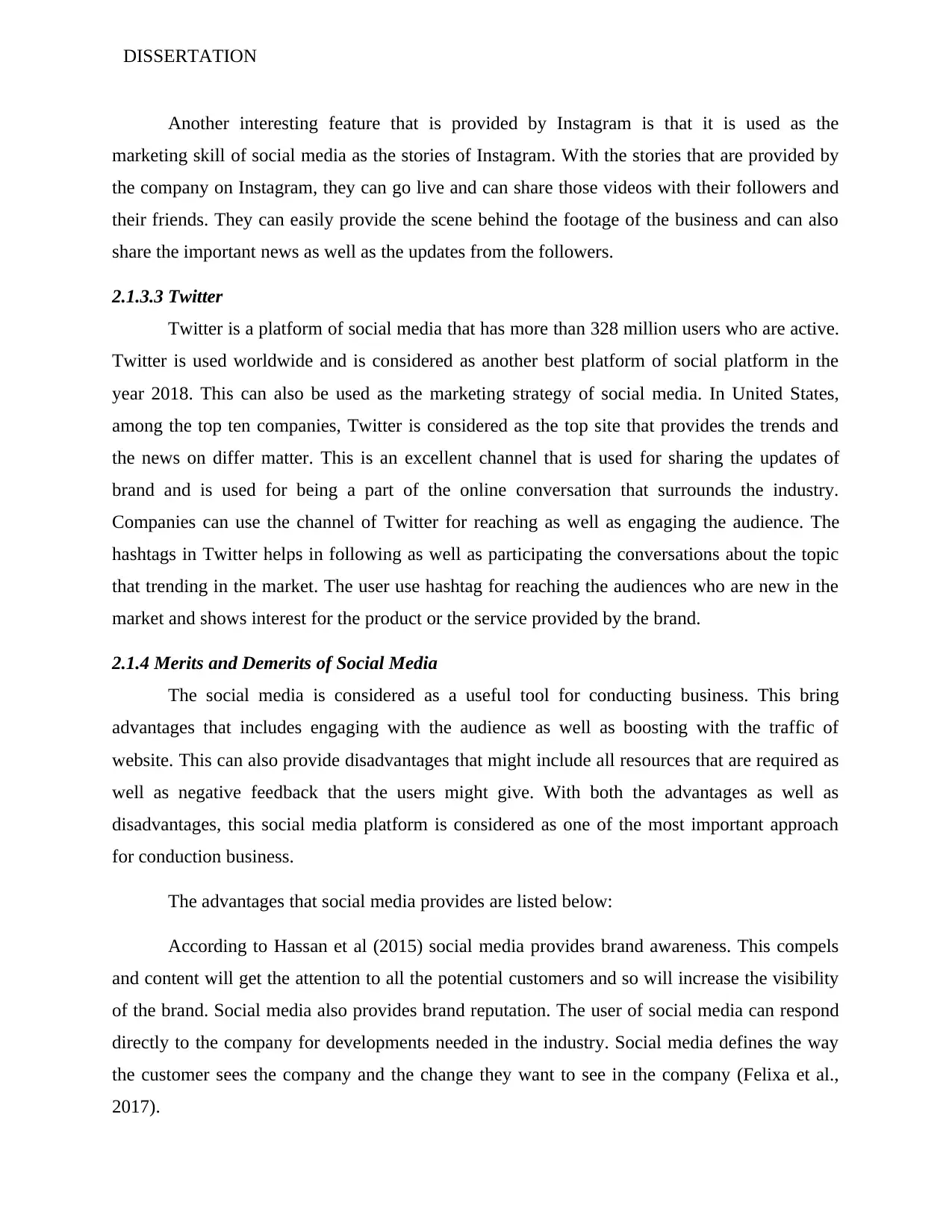
DISSERTATION
Another interesting feature that is provided by Instagram is that it is used as the
marketing skill of social media as the stories of Instagram. With the stories that are provided by
the company on Instagram, they can go live and can share those videos with their followers and
their friends. They can easily provide the scene behind the footage of the business and can also
share the important news as well as the updates from the followers.
2.1.3.3 Twitter
Twitter is a platform of social media that has more than 328 million users who are active.
Twitter is used worldwide and is considered as another best platform of social platform in the
year 2018. This can also be used as the marketing strategy of social media. In United States,
among the top ten companies, Twitter is considered as the top site that provides the trends and
the news on differ matter. This is an excellent channel that is used for sharing the updates of
brand and is used for being a part of the online conversation that surrounds the industry.
Companies can use the channel of Twitter for reaching as well as engaging the audience. The
hashtags in Twitter helps in following as well as participating the conversations about the topic
that trending in the market. The user use hashtag for reaching the audiences who are new in the
market and shows interest for the product or the service provided by the brand.
2.1.4 Merits and Demerits of Social Media
The social media is considered as a useful tool for conducting business. This bring
advantages that includes engaging with the audience as well as boosting with the traffic of
website. This can also provide disadvantages that might include all resources that are required as
well as negative feedback that the users might give. With both the advantages as well as
disadvantages, this social media platform is considered as one of the most important approach
for conduction business.
The advantages that social media provides are listed below:
According to Hassan et al (2015) social media provides brand awareness. This compels
and content will get the attention to all the potential customers and so will increase the visibility
of the brand. Social media also provides brand reputation. The user of social media can respond
directly to the company for developments needed in the industry. Social media defines the way
the customer sees the company and the change they want to see in the company (Felixa et al.,
2017).
Another interesting feature that is provided by Instagram is that it is used as the
marketing skill of social media as the stories of Instagram. With the stories that are provided by
the company on Instagram, they can go live and can share those videos with their followers and
their friends. They can easily provide the scene behind the footage of the business and can also
share the important news as well as the updates from the followers.
2.1.3.3 Twitter
Twitter is a platform of social media that has more than 328 million users who are active.
Twitter is used worldwide and is considered as another best platform of social platform in the
year 2018. This can also be used as the marketing strategy of social media. In United States,
among the top ten companies, Twitter is considered as the top site that provides the trends and
the news on differ matter. This is an excellent channel that is used for sharing the updates of
brand and is used for being a part of the online conversation that surrounds the industry.
Companies can use the channel of Twitter for reaching as well as engaging the audience. The
hashtags in Twitter helps in following as well as participating the conversations about the topic
that trending in the market. The user use hashtag for reaching the audiences who are new in the
market and shows interest for the product or the service provided by the brand.
2.1.4 Merits and Demerits of Social Media
The social media is considered as a useful tool for conducting business. This bring
advantages that includes engaging with the audience as well as boosting with the traffic of
website. This can also provide disadvantages that might include all resources that are required as
well as negative feedback that the users might give. With both the advantages as well as
disadvantages, this social media platform is considered as one of the most important approach
for conduction business.
The advantages that social media provides are listed below:
According to Hassan et al (2015) social media provides brand awareness. This compels
and content will get the attention to all the potential customers and so will increase the visibility
of the brand. Social media also provides brand reputation. The user of social media can respond
directly to the company for developments needed in the industry. Social media defines the way
the customer sees the company and the change they want to see in the company (Felixa et al.,
2017).
Paraphrase This Document
Need a fresh take? Get an instant paraphrase of this document with our AI Paraphraser

DISSERTATION
Hibbler-Britt, Lillie and Fiona Sussan (2015) stated more advantages of social media.
The author said the social media is also cost effective that is it can be used by the brand at much
cheap rate compared to other traditional way of advertising as well as other promotional
activities. The main cost of maintaining the presence of social media is minimum. This social
media cost little, almost no cost at all. The author also said that social media helps in boosting
the traffic to the website. This helps in increased conversions done online that are related to sales
as well as leads. It also provides easy evaluation about the amount of traffic that is received from
the social media. The user can track up to determine the number of sales that are generated from
social advertising. Social media also offers customer interaction. The company can interact with
the customer and get their feedback about the product or the service that is provided by the
company. The feedback that are positive helps the brand to attract more customer and the
negative feedback reflects to change their way of service or bring some improvement in the
product they deliver.
Another author Hossain (2015) explained through his analysis that social media helps in
targeting the audience. The products that are needed by the customers can be tracked from the
pages of social media only. Social media also provides brand loyalty that can build relationship
with customer via social media. This increases advocacy and loyalty for the customer.
The disadvantages that social media provides are listed below:
According to Hibbler-Britt, Lillie and Fiona Sussan (2015) with the advantages of social
media, the social media also provides some disadvantages. Using social media needs resource by
the company as well as by the users. Managing social media, responding to the feedback as well
as producing the content that are new needs resource from where the user can handle. This might
also sometimes hire new staffs and hire training officials for doing so.
He also stated that with social media, it is very difficult to measure as well as place the
monetary value of brand awareness and the reputation that is provided by the social media. It is
very difficult to evaluate the effect of social media sales in the store. According to him, the use
of social media is also very ineffective. This means pushing sales of a products or services over a
network without engaging the customers might hamper the reputation of the company.
Hibbler-Britt, Lillie and Fiona Sussan (2015) stated more advantages of social media.
The author said the social media is also cost effective that is it can be used by the brand at much
cheap rate compared to other traditional way of advertising as well as other promotional
activities. The main cost of maintaining the presence of social media is minimum. This social
media cost little, almost no cost at all. The author also said that social media helps in boosting
the traffic to the website. This helps in increased conversions done online that are related to sales
as well as leads. It also provides easy evaluation about the amount of traffic that is received from
the social media. The user can track up to determine the number of sales that are generated from
social advertising. Social media also offers customer interaction. The company can interact with
the customer and get their feedback about the product or the service that is provided by the
company. The feedback that are positive helps the brand to attract more customer and the
negative feedback reflects to change their way of service or bring some improvement in the
product they deliver.
Another author Hossain (2015) explained through his analysis that social media helps in
targeting the audience. The products that are needed by the customers can be tracked from the
pages of social media only. Social media also provides brand loyalty that can build relationship
with customer via social media. This increases advocacy and loyalty for the customer.
The disadvantages that social media provides are listed below:
According to Hibbler-Britt, Lillie and Fiona Sussan (2015) with the advantages of social
media, the social media also provides some disadvantages. Using social media needs resource by
the company as well as by the users. Managing social media, responding to the feedback as well
as producing the content that are new needs resource from where the user can handle. This might
also sometimes hire new staffs and hire training officials for doing so.
He also stated that with social media, it is very difficult to measure as well as place the
monetary value of brand awareness and the reputation that is provided by the social media. It is
very difficult to evaluate the effect of social media sales in the store. According to him, the use
of social media is also very ineffective. This means pushing sales of a products or services over a
network without engaging the customers might hamper the reputation of the company.
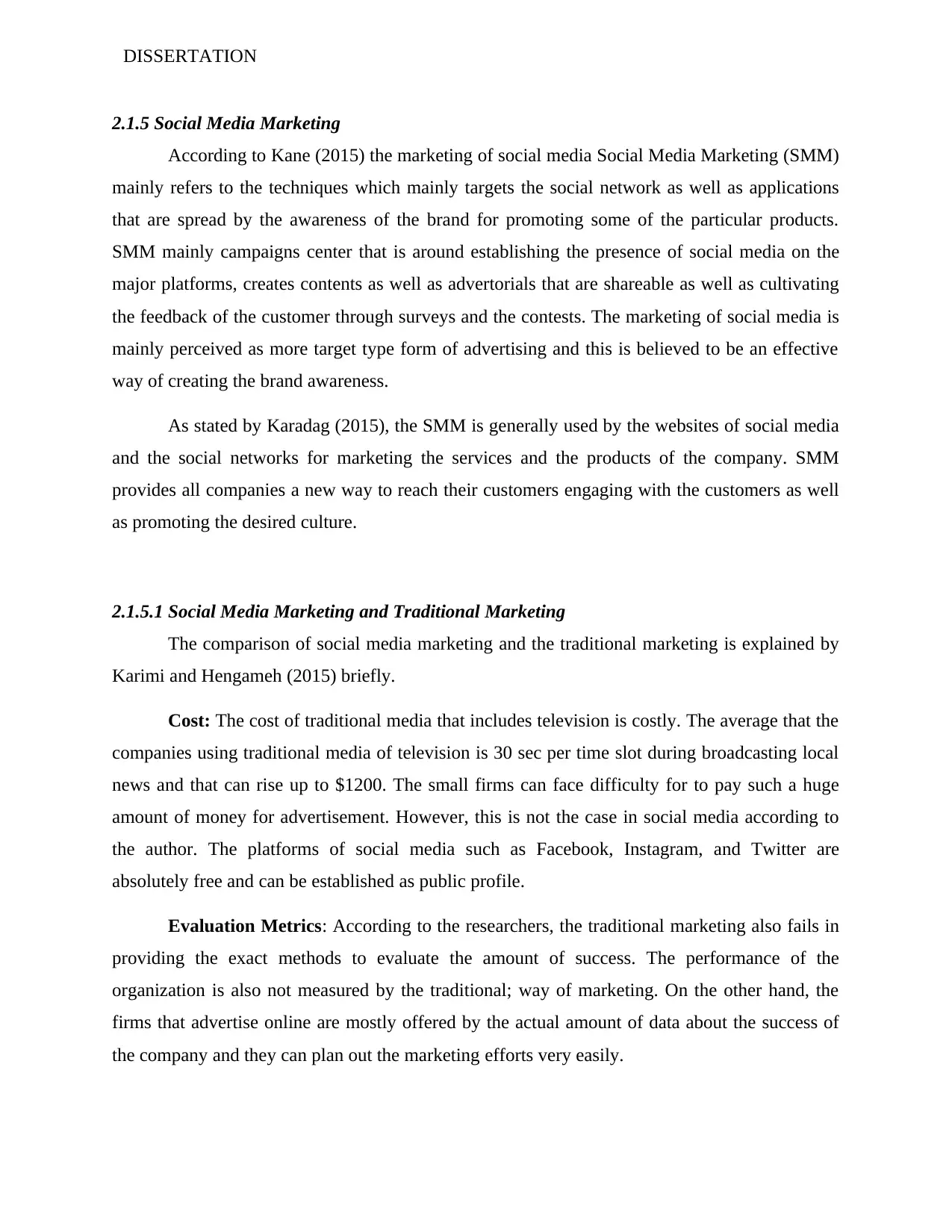
DISSERTATION
2.1.5 Social Media Marketing
According to Kane (2015) the marketing of social media Social Media Marketing (SMM)
mainly refers to the techniques which mainly targets the social network as well as applications
that are spread by the awareness of the brand for promoting some of the particular products.
SMM mainly campaigns center that is around establishing the presence of social media on the
major platforms, creates contents as well as advertorials that are shareable as well as cultivating
the feedback of the customer through surveys and the contests. The marketing of social media is
mainly perceived as more target type form of advertising and this is believed to be an effective
way of creating the brand awareness.
As stated by Karadag (2015), the SMM is generally used by the websites of social media
and the social networks for marketing the services and the products of the company. SMM
provides all companies a new way to reach their customers engaging with the customers as well
as promoting the desired culture.
2.1.5.1 Social Media Marketing and Traditional Marketing
The comparison of social media marketing and the traditional marketing is explained by
Karimi and Hengameh (2015) briefly.
Cost: The cost of traditional media that includes television is costly. The average that the
companies using traditional media of television is 30 sec per time slot during broadcasting local
news and that can rise up to $1200. The small firms can face difficulty for to pay such a huge
amount of money for advertisement. However, this is not the case in social media according to
the author. The platforms of social media such as Facebook, Instagram, and Twitter are
absolutely free and can be established as public profile.
Evaluation Metrics: According to the researchers, the traditional marketing also fails in
providing the exact methods to evaluate the amount of success. The performance of the
organization is also not measured by the traditional; way of marketing. On the other hand, the
firms that advertise online are mostly offered by the actual amount of data about the success of
the company and they can plan out the marketing efforts very easily.
2.1.5 Social Media Marketing
According to Kane (2015) the marketing of social media Social Media Marketing (SMM)
mainly refers to the techniques which mainly targets the social network as well as applications
that are spread by the awareness of the brand for promoting some of the particular products.
SMM mainly campaigns center that is around establishing the presence of social media on the
major platforms, creates contents as well as advertorials that are shareable as well as cultivating
the feedback of the customer through surveys and the contests. The marketing of social media is
mainly perceived as more target type form of advertising and this is believed to be an effective
way of creating the brand awareness.
As stated by Karadag (2015), the SMM is generally used by the websites of social media
and the social networks for marketing the services and the products of the company. SMM
provides all companies a new way to reach their customers engaging with the customers as well
as promoting the desired culture.
2.1.5.1 Social Media Marketing and Traditional Marketing
The comparison of social media marketing and the traditional marketing is explained by
Karimi and Hengameh (2015) briefly.
Cost: The cost of traditional media that includes television is costly. The average that the
companies using traditional media of television is 30 sec per time slot during broadcasting local
news and that can rise up to $1200. The small firms can face difficulty for to pay such a huge
amount of money for advertisement. However, this is not the case in social media according to
the author. The platforms of social media such as Facebook, Instagram, and Twitter are
absolutely free and can be established as public profile.
Evaluation Metrics: According to the researchers, the traditional marketing also fails in
providing the exact methods to evaluate the amount of success. The performance of the
organization is also not measured by the traditional; way of marketing. On the other hand, the
firms that advertise online are mostly offered by the actual amount of data about the success of
the company and they can plan out the marketing efforts very easily.
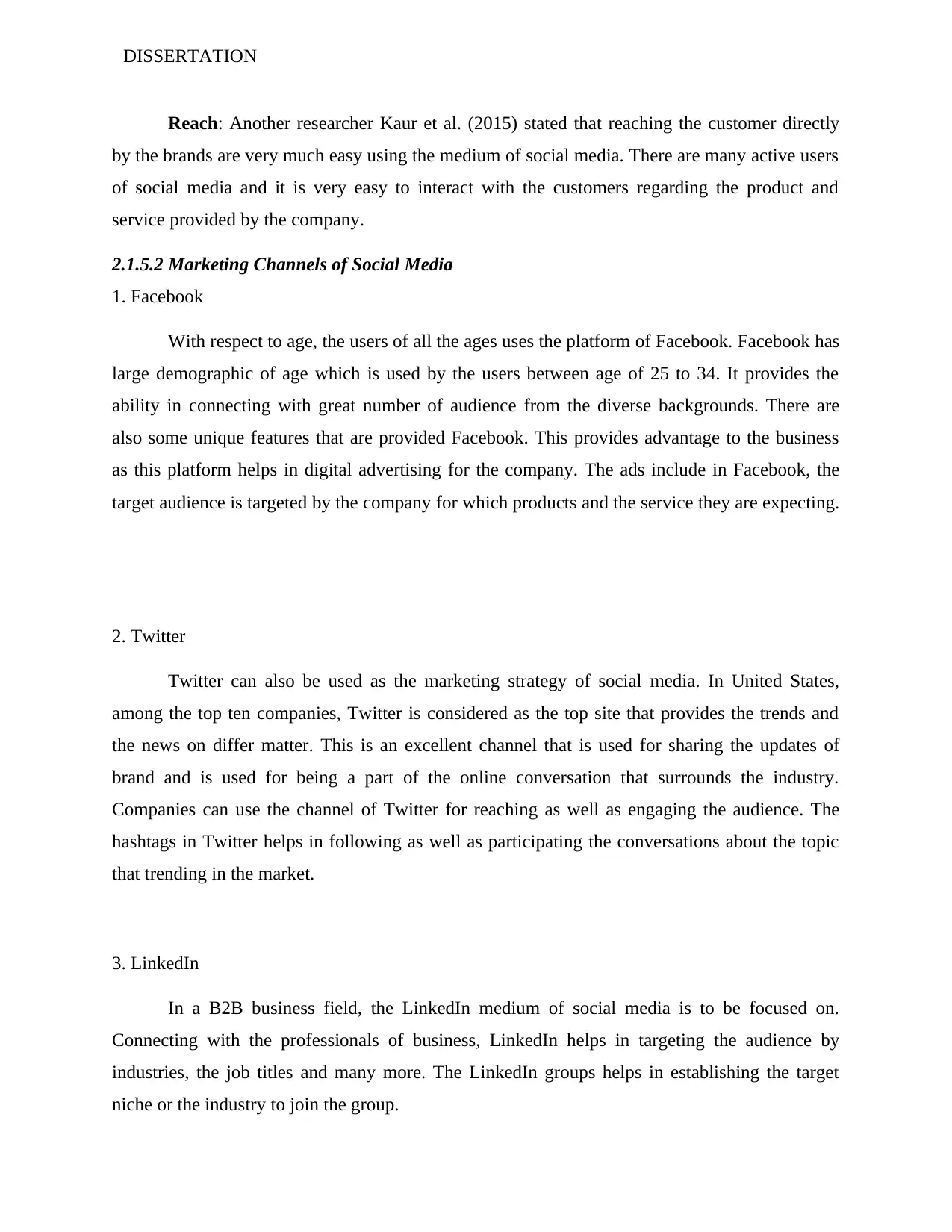
DISSERTATION
Reach: Another researcher Kaur et al. (2015) stated that reaching the customer directly
by the brands are very much easy using the medium of social media. There are many active users
of social media and it is very easy to interact with the customers regarding the product and
service provided by the company.
2.1.5.2 Marketing Channels of Social Media
1. Facebook
With respect to age, the users of all the ages uses the platform of Facebook. Facebook has
large demographic of age which is used by the users between age of 25 to 34. It provides the
ability in connecting with great number of audience from the diverse backgrounds. There are
also some unique features that are provided Facebook. This provides advantage to the business
as this platform helps in digital advertising for the company. The ads include in Facebook, the
target audience is targeted by the company for which products and the service they are expecting.
2. Twitter
Twitter can also be used as the marketing strategy of social media. In United States,
among the top ten companies, Twitter is considered as the top site that provides the trends and
the news on differ matter. This is an excellent channel that is used for sharing the updates of
brand and is used for being a part of the online conversation that surrounds the industry.
Companies can use the channel of Twitter for reaching as well as engaging the audience. The
hashtags in Twitter helps in following as well as participating the conversations about the topic
that trending in the market.
3. LinkedIn
In a B2B business field, the LinkedIn medium of social media is to be focused on.
Connecting with the professionals of business, LinkedIn helps in targeting the audience by
industries, the job titles and many more. The LinkedIn groups helps in establishing the target
niche or the industry to join the group.
Reach: Another researcher Kaur et al. (2015) stated that reaching the customer directly
by the brands are very much easy using the medium of social media. There are many active users
of social media and it is very easy to interact with the customers regarding the product and
service provided by the company.
2.1.5.2 Marketing Channels of Social Media
1. Facebook
With respect to age, the users of all the ages uses the platform of Facebook. Facebook has
large demographic of age which is used by the users between age of 25 to 34. It provides the
ability in connecting with great number of audience from the diverse backgrounds. There are
also some unique features that are provided Facebook. This provides advantage to the business
as this platform helps in digital advertising for the company. The ads include in Facebook, the
target audience is targeted by the company for which products and the service they are expecting.
2. Twitter
Twitter can also be used as the marketing strategy of social media. In United States,
among the top ten companies, Twitter is considered as the top site that provides the trends and
the news on differ matter. This is an excellent channel that is used for sharing the updates of
brand and is used for being a part of the online conversation that surrounds the industry.
Companies can use the channel of Twitter for reaching as well as engaging the audience. The
hashtags in Twitter helps in following as well as participating the conversations about the topic
that trending in the market.
3. LinkedIn
In a B2B business field, the LinkedIn medium of social media is to be focused on.
Connecting with the professionals of business, LinkedIn helps in targeting the audience by
industries, the job titles and many more. The LinkedIn groups helps in establishing the target
niche or the industry to join the group.
Secure Best Marks with AI Grader
Need help grading? Try our AI Grader for instant feedback on your assignments.
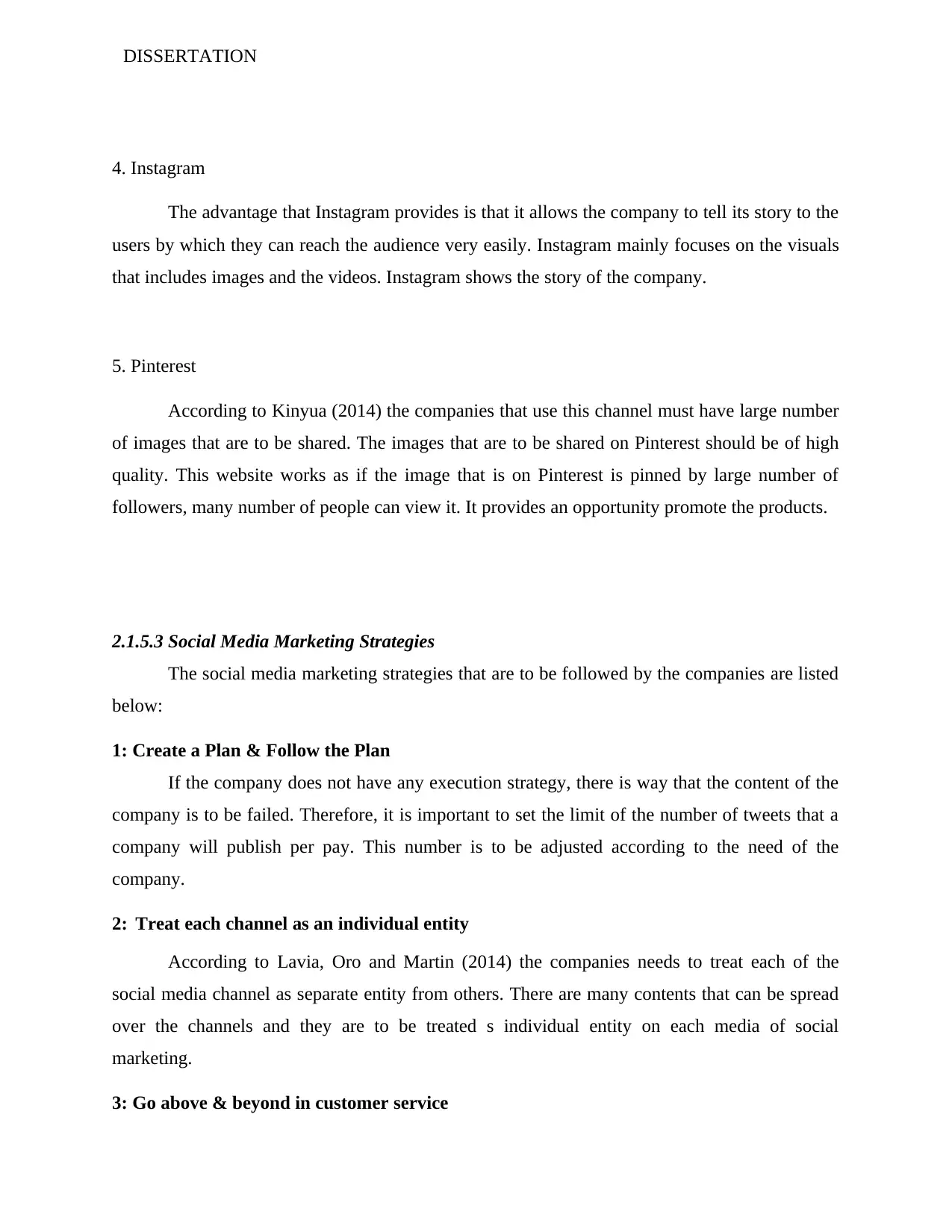
DISSERTATION
4. Instagram
The advantage that Instagram provides is that it allows the company to tell its story to the
users by which they can reach the audience very easily. Instagram mainly focuses on the visuals
that includes images and the videos. Instagram shows the story of the company.
5. Pinterest
According to Kinyua (2014) the companies that use this channel must have large number
of images that are to be shared. The images that are to be shared on Pinterest should be of high
quality. This website works as if the image that is on Pinterest is pinned by large number of
followers, many number of people can view it. It provides an opportunity promote the products.
2.1.5.3 Social Media Marketing Strategies
The social media marketing strategies that are to be followed by the companies are listed
below:
1: Create a Plan & Follow the Plan
If the company does not have any execution strategy, there is way that the content of the
company is to be failed. Therefore, it is important to set the limit of the number of tweets that a
company will publish per pay. This number is to be adjusted according to the need of the
company.
2: Treat each channel as an individual entity
According to Lavia, Oro and Martin (2014) the companies needs to treat each of the
social media channel as separate entity from others. There are many contents that can be spread
over the channels and they are to be treated s individual entity on each media of social
marketing.
3: Go above & beyond in customer service
4. Instagram
The advantage that Instagram provides is that it allows the company to tell its story to the
users by which they can reach the audience very easily. Instagram mainly focuses on the visuals
that includes images and the videos. Instagram shows the story of the company.
5. Pinterest
According to Kinyua (2014) the companies that use this channel must have large number
of images that are to be shared. The images that are to be shared on Pinterest should be of high
quality. This website works as if the image that is on Pinterest is pinned by large number of
followers, many number of people can view it. It provides an opportunity promote the products.
2.1.5.3 Social Media Marketing Strategies
The social media marketing strategies that are to be followed by the companies are listed
below:
1: Create a Plan & Follow the Plan
If the company does not have any execution strategy, there is way that the content of the
company is to be failed. Therefore, it is important to set the limit of the number of tweets that a
company will publish per pay. This number is to be adjusted according to the need of the
company.
2: Treat each channel as an individual entity
According to Lavia, Oro and Martin (2014) the companies needs to treat each of the
social media channel as separate entity from others. There are many contents that can be spread
over the channels and they are to be treated s individual entity on each media of social
marketing.
3: Go above & beyond in customer service
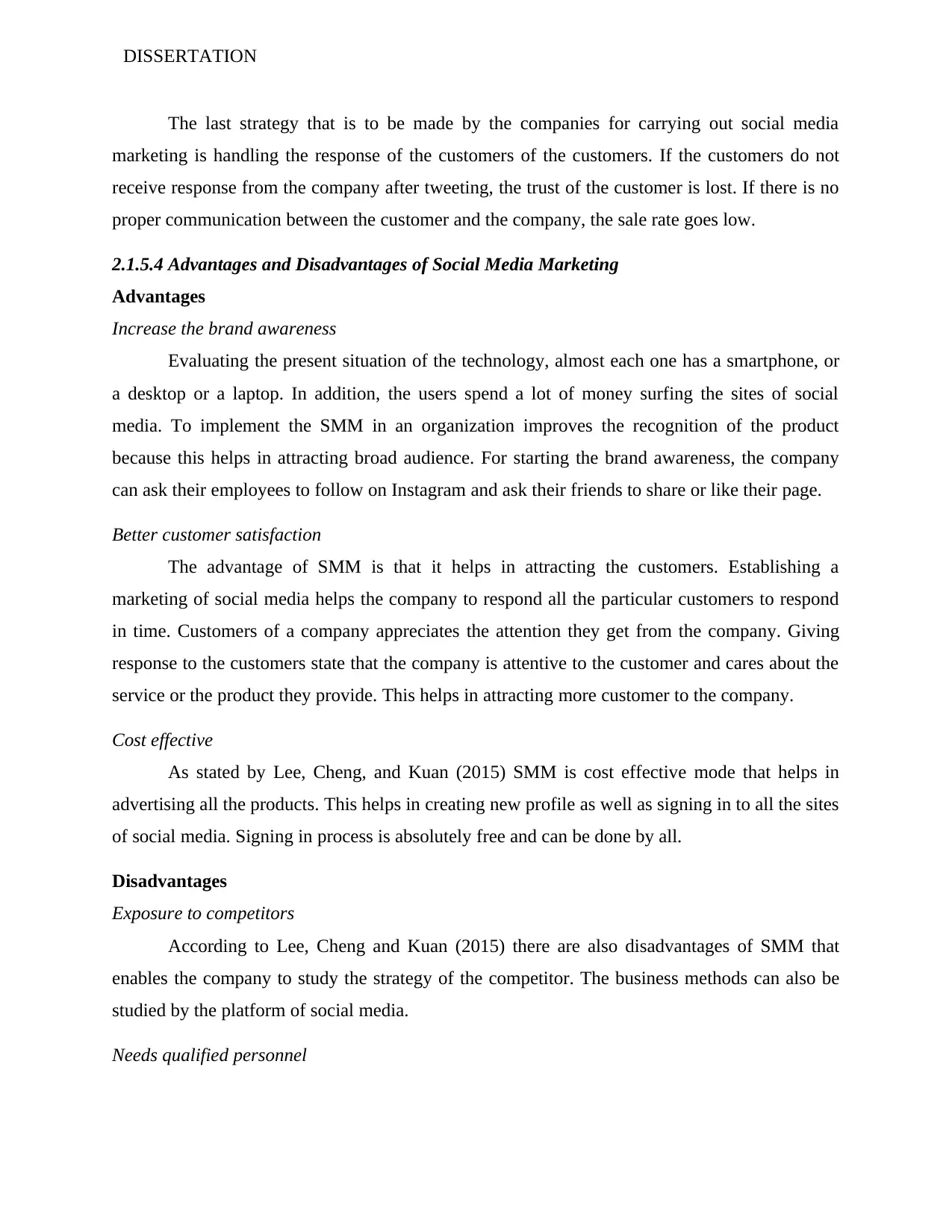
DISSERTATION
The last strategy that is to be made by the companies for carrying out social media
marketing is handling the response of the customers of the customers. If the customers do not
receive response from the company after tweeting, the trust of the customer is lost. If there is no
proper communication between the customer and the company, the sale rate goes low.
2.1.5.4 Advantages and Disadvantages of Social Media Marketing
Advantages
Increase the brand awareness
Evaluating the present situation of the technology, almost each one has a smartphone, or
a desktop or a laptop. In addition, the users spend a lot of money surfing the sites of social
media. To implement the SMM in an organization improves the recognition of the product
because this helps in attracting broad audience. For starting the brand awareness, the company
can ask their employees to follow on Instagram and ask their friends to share or like their page.
Better customer satisfaction
The advantage of SMM is that it helps in attracting the customers. Establishing a
marketing of social media helps the company to respond all the particular customers to respond
in time. Customers of a company appreciates the attention they get from the company. Giving
response to the customers state that the company is attentive to the customer and cares about the
service or the product they provide. This helps in attracting more customer to the company.
Cost effective
As stated by Lee, Cheng, and Kuan (2015) SMM is cost effective mode that helps in
advertising all the products. This helps in creating new profile as well as signing in to all the sites
of social media. Signing in process is absolutely free and can be done by all.
Disadvantages
Exposure to competitors
According to Lee, Cheng and Kuan (2015) there are also disadvantages of SMM that
enables the company to study the strategy of the competitor. The business methods can also be
studied by the platform of social media.
Needs qualified personnel
The last strategy that is to be made by the companies for carrying out social media
marketing is handling the response of the customers of the customers. If the customers do not
receive response from the company after tweeting, the trust of the customer is lost. If there is no
proper communication between the customer and the company, the sale rate goes low.
2.1.5.4 Advantages and Disadvantages of Social Media Marketing
Advantages
Increase the brand awareness
Evaluating the present situation of the technology, almost each one has a smartphone, or
a desktop or a laptop. In addition, the users spend a lot of money surfing the sites of social
media. To implement the SMM in an organization improves the recognition of the product
because this helps in attracting broad audience. For starting the brand awareness, the company
can ask their employees to follow on Instagram and ask their friends to share or like their page.
Better customer satisfaction
The advantage of SMM is that it helps in attracting the customers. Establishing a
marketing of social media helps the company to respond all the particular customers to respond
in time. Customers of a company appreciates the attention they get from the company. Giving
response to the customers state that the company is attentive to the customer and cares about the
service or the product they provide. This helps in attracting more customer to the company.
Cost effective
As stated by Lee, Cheng, and Kuan (2015) SMM is cost effective mode that helps in
advertising all the products. This helps in creating new profile as well as signing in to all the sites
of social media. Signing in process is absolutely free and can be done by all.
Disadvantages
Exposure to competitors
According to Lee, Cheng and Kuan (2015) there are also disadvantages of SMM that
enables the company to study the strategy of the competitor. The business methods can also be
studied by the platform of social media.
Needs qualified personnel
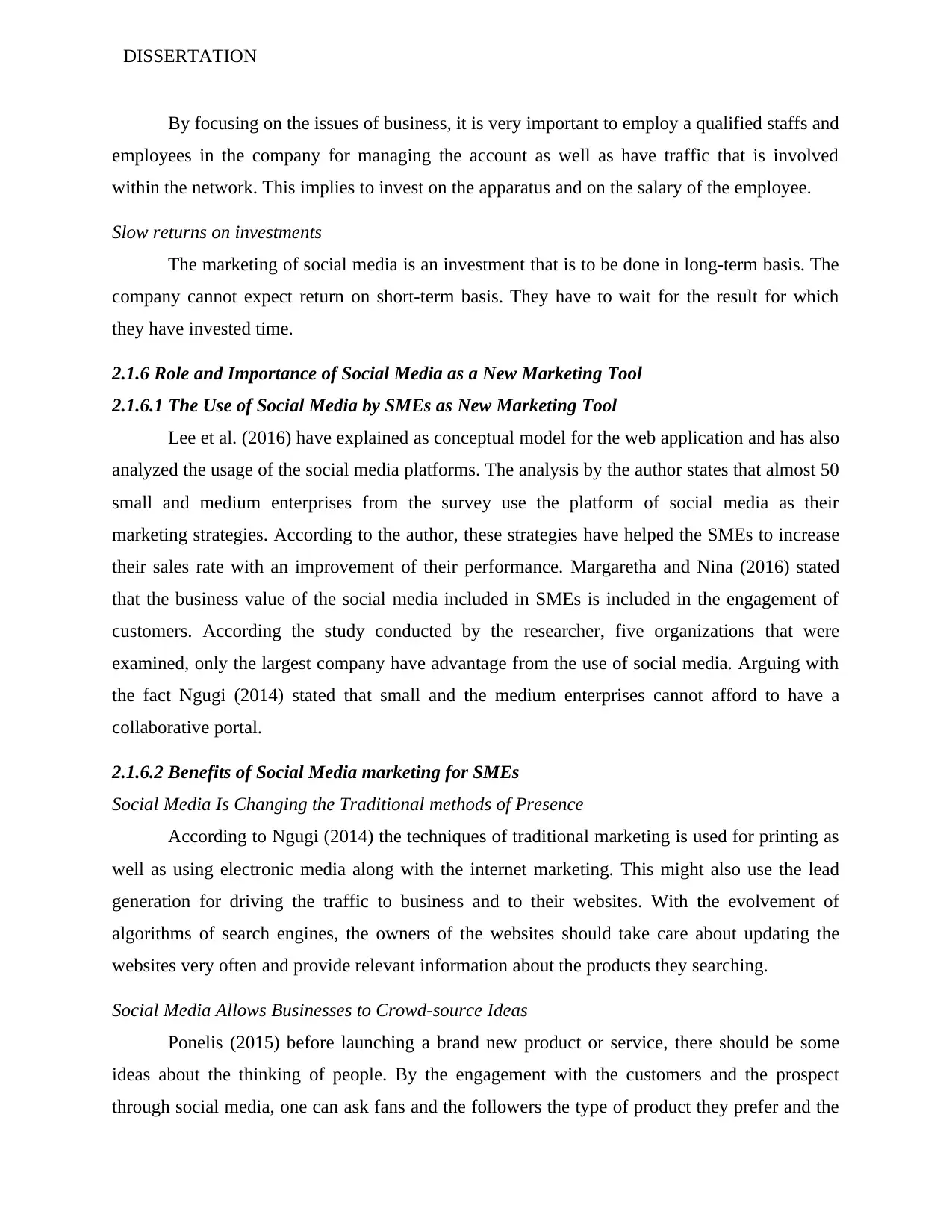
DISSERTATION
By focusing on the issues of business, it is very important to employ a qualified staffs and
employees in the company for managing the account as well as have traffic that is involved
within the network. This implies to invest on the apparatus and on the salary of the employee.
Slow returns on investments
The marketing of social media is an investment that is to be done in long-term basis. The
company cannot expect return on short-term basis. They have to wait for the result for which
they have invested time.
2.1.6 Role and Importance of Social Media as a New Marketing Tool
2.1.6.1 The Use of Social Media by SMEs as New Marketing Tool
Lee et al. (2016) have explained as conceptual model for the web application and has also
analyzed the usage of the social media platforms. The analysis by the author states that almost 50
small and medium enterprises from the survey use the platform of social media as their
marketing strategies. According to the author, these strategies have helped the SMEs to increase
their sales rate with an improvement of their performance. Margaretha and Nina (2016) stated
that the business value of the social media included in SMEs is included in the engagement of
customers. According the study conducted by the researcher, five organizations that were
examined, only the largest company have advantage from the use of social media. Arguing with
the fact Ngugi (2014) stated that small and the medium enterprises cannot afford to have a
collaborative portal.
2.1.6.2 Benefits of Social Media marketing for SMEs
Social Media Is Changing the Traditional methods of Presence
According to Ngugi (2014) the techniques of traditional marketing is used for printing as
well as using electronic media along with the internet marketing. This might also use the lead
generation for driving the traffic to business and to their websites. With the evolvement of
algorithms of search engines, the owners of the websites should take care about updating the
websites very often and provide relevant information about the products they searching.
Social Media Allows Businesses to Crowd-source Ideas
Ponelis (2015) before launching a brand new product or service, there should be some
ideas about the thinking of people. By the engagement with the customers and the prospect
through social media, one can ask fans and the followers the type of product they prefer and the
By focusing on the issues of business, it is very important to employ a qualified staffs and
employees in the company for managing the account as well as have traffic that is involved
within the network. This implies to invest on the apparatus and on the salary of the employee.
Slow returns on investments
The marketing of social media is an investment that is to be done in long-term basis. The
company cannot expect return on short-term basis. They have to wait for the result for which
they have invested time.
2.1.6 Role and Importance of Social Media as a New Marketing Tool
2.1.6.1 The Use of Social Media by SMEs as New Marketing Tool
Lee et al. (2016) have explained as conceptual model for the web application and has also
analyzed the usage of the social media platforms. The analysis by the author states that almost 50
small and medium enterprises from the survey use the platform of social media as their
marketing strategies. According to the author, these strategies have helped the SMEs to increase
their sales rate with an improvement of their performance. Margaretha and Nina (2016) stated
that the business value of the social media included in SMEs is included in the engagement of
customers. According the study conducted by the researcher, five organizations that were
examined, only the largest company have advantage from the use of social media. Arguing with
the fact Ngugi (2014) stated that small and the medium enterprises cannot afford to have a
collaborative portal.
2.1.6.2 Benefits of Social Media marketing for SMEs
Social Media Is Changing the Traditional methods of Presence
According to Ngugi (2014) the techniques of traditional marketing is used for printing as
well as using electronic media along with the internet marketing. This might also use the lead
generation for driving the traffic to business and to their websites. With the evolvement of
algorithms of search engines, the owners of the websites should take care about updating the
websites very often and provide relevant information about the products they searching.
Social Media Allows Businesses to Crowd-source Ideas
Ponelis (2015) before launching a brand new product or service, there should be some
ideas about the thinking of people. By the engagement with the customers and the prospect
through social media, one can ask fans and the followers the type of product they prefer and the
Paraphrase This Document
Need a fresh take? Get an instant paraphrase of this document with our AI Paraphraser
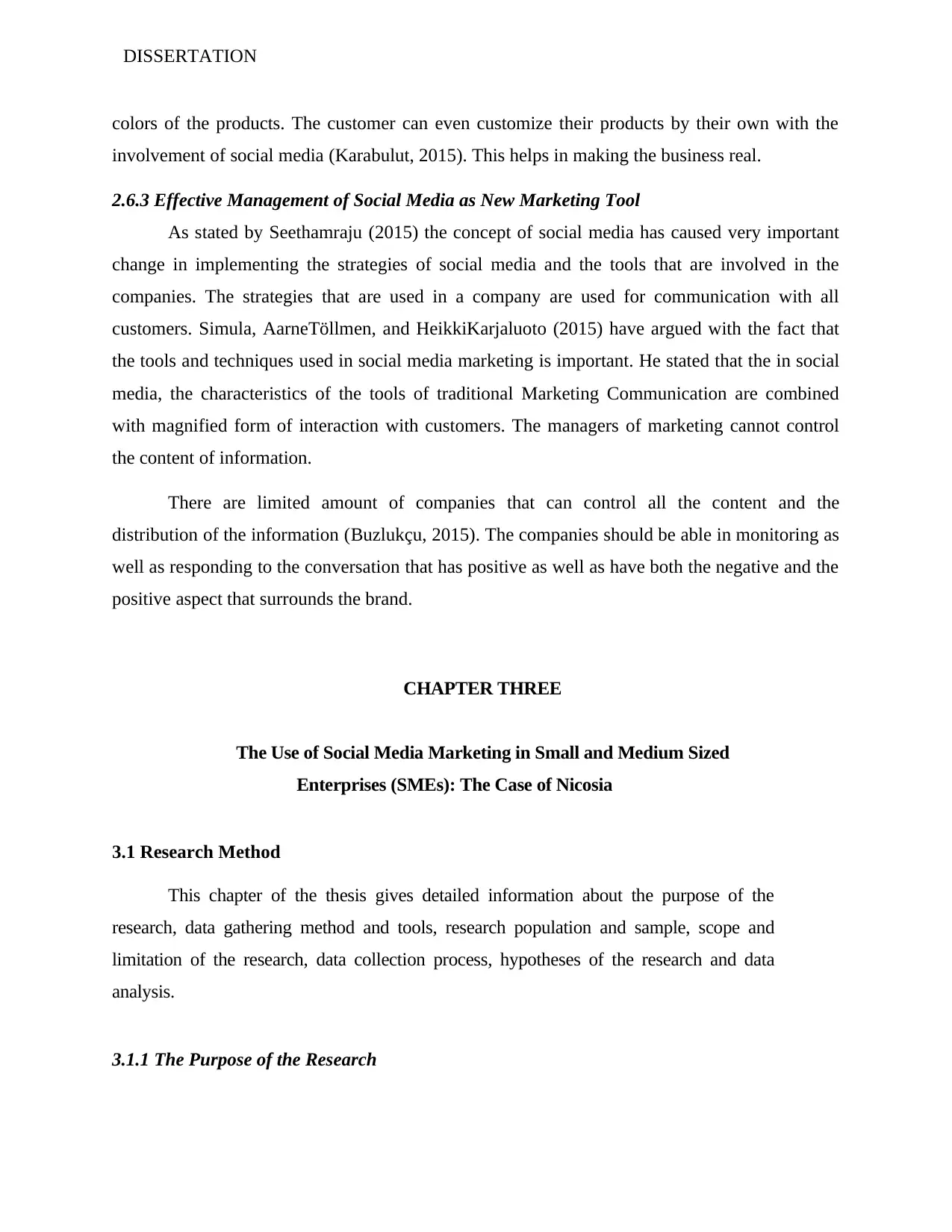
DISSERTATION
colors of the products. The customer can even customize their products by their own with the
involvement of social media (Karabulut, 2015). This helps in making the business real.
2.6.3 Effective Management of Social Media as New Marketing Tool
As stated by Seethamraju (2015) the concept of social media has caused very important
change in implementing the strategies of social media and the tools that are involved in the
companies. The strategies that are used in a company are used for communication with all
customers. Simula, AarneTöllmen, and HeikkiKarjaluoto (2015) have argued with the fact that
the tools and techniques used in social media marketing is important. He stated that the in social
media, the characteristics of the tools of traditional Marketing Communication are combined
with magnified form of interaction with customers. The managers of marketing cannot control
the content of information.
There are limited amount of companies that can control all the content and the
distribution of the information (Buzlukçu, 2015). The companies should be able in monitoring as
well as responding to the conversation that has positive as well as have both the negative and the
positive aspect that surrounds the brand.
CHAPTER THREE
The Use of Social Media Marketing in Small and Medium Sized
Enterprises (SMEs): The Case of Nicosia
3.1 Research Method
This chapter of the thesis gives detailed information about the purpose of the
research, data gathering method and tools, research population and sample, scope and
limitation of the research, data collection process, hypotheses of the research and data
analysis.
3.1.1 The Purpose of the Research
colors of the products. The customer can even customize their products by their own with the
involvement of social media (Karabulut, 2015). This helps in making the business real.
2.6.3 Effective Management of Social Media as New Marketing Tool
As stated by Seethamraju (2015) the concept of social media has caused very important
change in implementing the strategies of social media and the tools that are involved in the
companies. The strategies that are used in a company are used for communication with all
customers. Simula, AarneTöllmen, and HeikkiKarjaluoto (2015) have argued with the fact that
the tools and techniques used in social media marketing is important. He stated that the in social
media, the characteristics of the tools of traditional Marketing Communication are combined
with magnified form of interaction with customers. The managers of marketing cannot control
the content of information.
There are limited amount of companies that can control all the content and the
distribution of the information (Buzlukçu, 2015). The companies should be able in monitoring as
well as responding to the conversation that has positive as well as have both the negative and the
positive aspect that surrounds the brand.
CHAPTER THREE
The Use of Social Media Marketing in Small and Medium Sized
Enterprises (SMEs): The Case of Nicosia
3.1 Research Method
This chapter of the thesis gives detailed information about the purpose of the
research, data gathering method and tools, research population and sample, scope and
limitation of the research, data collection process, hypotheses of the research and data
analysis.
3.1.1 The Purpose of the Research
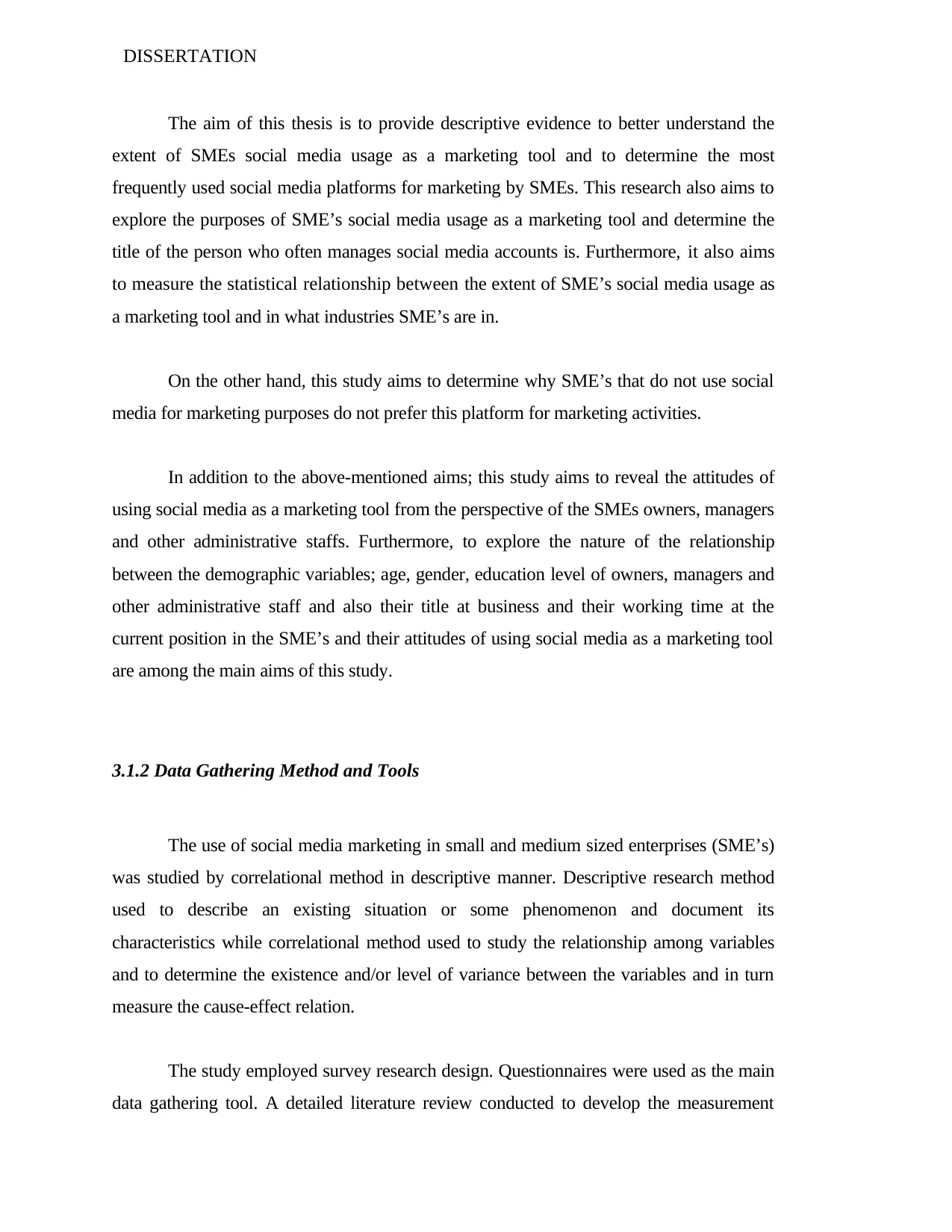
DISSERTATION
The aim of this thesis is to provide descriptive evidence to better understand the
extent of SMEs social media usage as a marketing tool and to determine the most
frequently used social media platforms for marketing by SMEs. This research also aims to
explore the purposes of SME’s social media usage as a marketing tool and determine the
title of the person who often manages social media accounts is. Furthermore, it also aims
to measure the statistical relationship between the extent of SME’s social media usage as
a marketing tool and in what industries SME’s are in.
On the other hand, this study aims to determine why SME’s that do not use social
media for marketing purposes do not prefer this platform for marketing activities.
In addition to the above-mentioned aims; this study aims to reveal the attitudes of
using social media as a marketing tool from the perspective of the SMEs owners, managers
and other administrative staffs. Furthermore, to explore the nature of the relationship
between the demographic variables; age, gender, education level of owners, managers and
other administrative staff and also their title at business and their working time at the
current position in the SME’s and their attitudes of using social media as a marketing tool
are among the main aims of this study.
3.1.2 Data Gathering Method and Tools
The use of social media marketing in small and medium sized enterprises (SME’s)
was studied by correlational method in descriptive manner. Descriptive research method
used to describe an existing situation or some phenomenon and document its
characteristics while correlational method used to study the relationship among variables
and to determine the existence and/or level of variance between the variables and in turn
measure the cause-effect relation.
The study employed survey research design. Questionnaires were used as the main
data gathering tool. A detailed literature review conducted to develop the measurement
The aim of this thesis is to provide descriptive evidence to better understand the
extent of SMEs social media usage as a marketing tool and to determine the most
frequently used social media platforms for marketing by SMEs. This research also aims to
explore the purposes of SME’s social media usage as a marketing tool and determine the
title of the person who often manages social media accounts is. Furthermore, it also aims
to measure the statistical relationship between the extent of SME’s social media usage as
a marketing tool and in what industries SME’s are in.
On the other hand, this study aims to determine why SME’s that do not use social
media for marketing purposes do not prefer this platform for marketing activities.
In addition to the above-mentioned aims; this study aims to reveal the attitudes of
using social media as a marketing tool from the perspective of the SMEs owners, managers
and other administrative staffs. Furthermore, to explore the nature of the relationship
between the demographic variables; age, gender, education level of owners, managers and
other administrative staff and also their title at business and their working time at the
current position in the SME’s and their attitudes of using social media as a marketing tool
are among the main aims of this study.
3.1.2 Data Gathering Method and Tools
The use of social media marketing in small and medium sized enterprises (SME’s)
was studied by correlational method in descriptive manner. Descriptive research method
used to describe an existing situation or some phenomenon and document its
characteristics while correlational method used to study the relationship among variables
and to determine the existence and/or level of variance between the variables and in turn
measure the cause-effect relation.
The study employed survey research design. Questionnaires were used as the main
data gathering tool. A detailed literature review conducted to develop the measurement
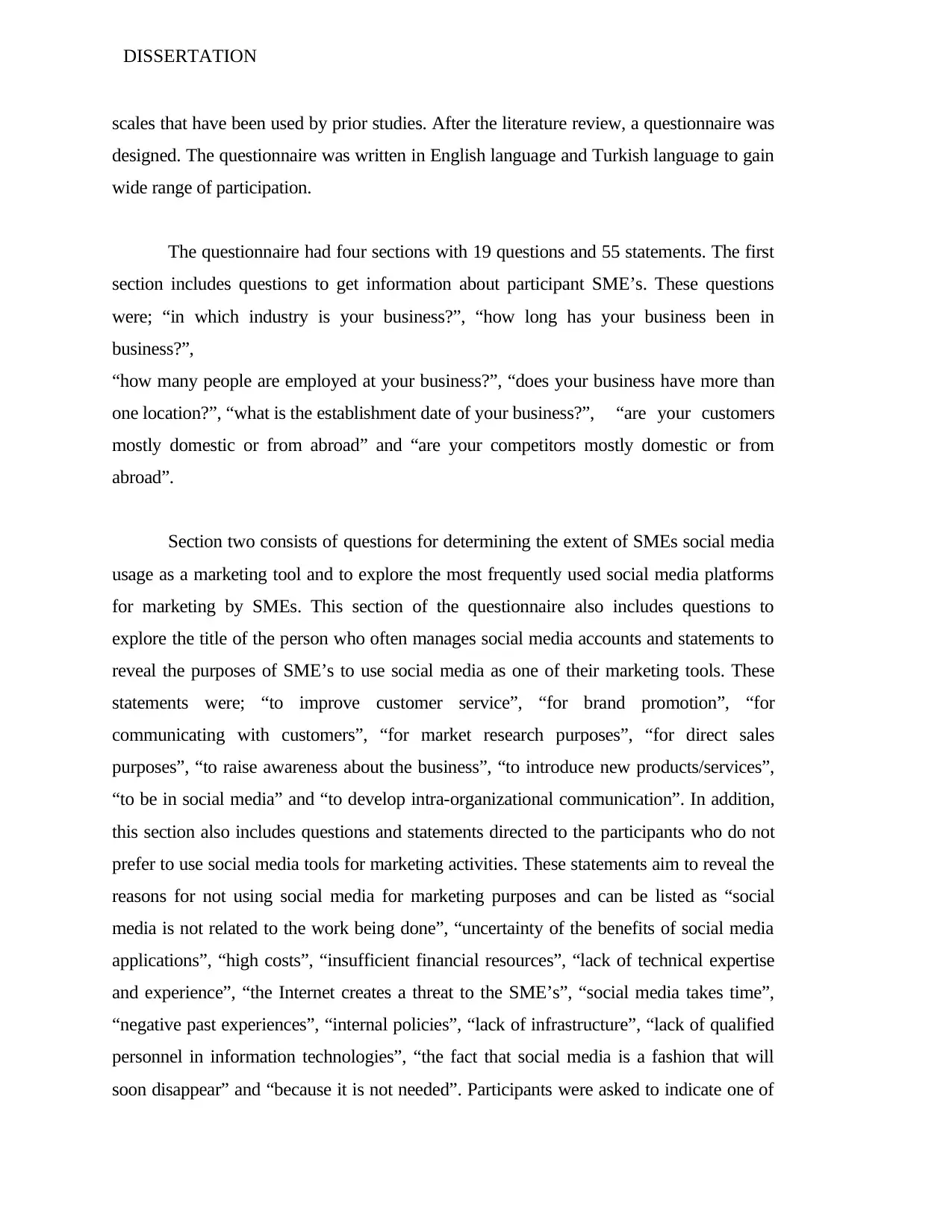
DISSERTATION
scales that have been used by prior studies. After the literature review, a questionnaire was
designed. The questionnaire was written in English language and Turkish language to gain
wide range of participation.
The questionnaire had four sections with 19 questions and 55 statements. The first
section includes questions to get information about participant SME’s. These questions
were; “in which industry is your business?”, “how long has your business been in
business?”,
“how many people are employed at your business?”, “does your business have more than
one location?”, “what is the establishment date of your business?”, “are your customers
mostly domestic or from abroad” and “are your competitors mostly domestic or from
abroad”.
Section two consists of questions for determining the extent of SMEs social media
usage as a marketing tool and to explore the most frequently used social media platforms
for marketing by SMEs. This section of the questionnaire also includes questions to
explore the title of the person who often manages social media accounts and statements to
reveal the purposes of SME’s to use social media as one of their marketing tools. These
statements were; “to improve customer service”, “for brand promotion”, “for
communicating with customers”, “for market research purposes”, “for direct sales
purposes”, “to raise awareness about the business”, “to introduce new products/services”,
“to be in social media” and “to develop intra-organizational communication”. In addition,
this section also includes questions and statements directed to the participants who do not
prefer to use social media tools for marketing activities. These statements aim to reveal the
reasons for not using social media for marketing purposes and can be listed as “social
media is not related to the work being done”, “uncertainty of the benefits of social media
applications”, “high costs”, “insufficient financial resources”, “lack of technical expertise
and experience”, “the Internet creates a threat to the SME’s”, “social media takes time”,
“negative past experiences”, “internal policies”, “lack of infrastructure”, “lack of qualified
personnel in information technologies”, “the fact that social media is a fashion that will
soon disappear” and “because it is not needed”. Participants were asked to indicate one of
scales that have been used by prior studies. After the literature review, a questionnaire was
designed. The questionnaire was written in English language and Turkish language to gain
wide range of participation.
The questionnaire had four sections with 19 questions and 55 statements. The first
section includes questions to get information about participant SME’s. These questions
were; “in which industry is your business?”, “how long has your business been in
business?”,
“how many people are employed at your business?”, “does your business have more than
one location?”, “what is the establishment date of your business?”, “are your customers
mostly domestic or from abroad” and “are your competitors mostly domestic or from
abroad”.
Section two consists of questions for determining the extent of SMEs social media
usage as a marketing tool and to explore the most frequently used social media platforms
for marketing by SMEs. This section of the questionnaire also includes questions to
explore the title of the person who often manages social media accounts and statements to
reveal the purposes of SME’s to use social media as one of their marketing tools. These
statements were; “to improve customer service”, “for brand promotion”, “for
communicating with customers”, “for market research purposes”, “for direct sales
purposes”, “to raise awareness about the business”, “to introduce new products/services”,
“to be in social media” and “to develop intra-organizational communication”. In addition,
this section also includes questions and statements directed to the participants who do not
prefer to use social media tools for marketing activities. These statements aim to reveal the
reasons for not using social media for marketing purposes and can be listed as “social
media is not related to the work being done”, “uncertainty of the benefits of social media
applications”, “high costs”, “insufficient financial resources”, “lack of technical expertise
and experience”, “the Internet creates a threat to the SME’s”, “social media takes time”,
“negative past experiences”, “internal policies”, “lack of infrastructure”, “lack of qualified
personnel in information technologies”, “the fact that social media is a fashion that will
soon disappear” and “because it is not needed”. Participants were asked to indicate one of
Secure Best Marks with AI Grader
Need help grading? Try our AI Grader for instant feedback on your assignments.
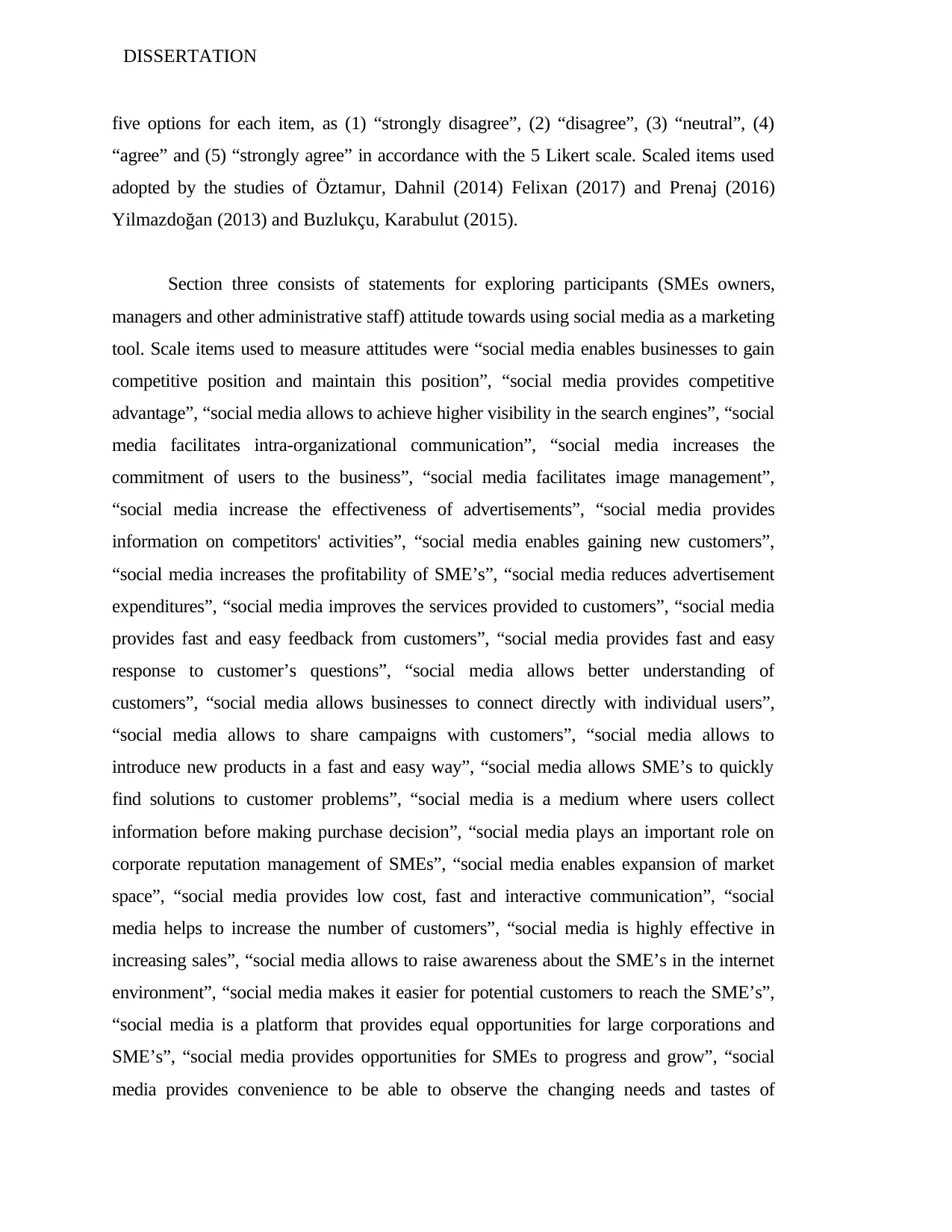
DISSERTATION
five options for each item, as (1) “strongly disagree”, (2) “disagree”, (3) “neutral”, (4)
“agree” and (5) “strongly agree” in accordance with the 5 Likert scale. Scaled items used
adopted by the studies of Öztamur, Dahnil (2014) Felixan (2017) and Prenaj (2016)
Yilmazdoğan (2013) and Buzlukçu, Karabulut (2015).
Section three consists of statements for exploring participants (SMEs owners,
managers and other administrative staff) attitude towards using social media as a marketing
tool. Scale items used to measure attitudes were “social media enables businesses to gain
competitive position and maintain this position”, “social media provides competitive
advantage”, “social media allows to achieve higher visibility in the search engines”, “social
media facilitates intra-organizational communication”, “social media increases the
commitment of users to the business”, “social media facilitates image management”,
“social media increase the effectiveness of advertisements”, “social media provides
information on competitors' activities”, “social media enables gaining new customers”,
“social media increases the profitability of SME’s”, “social media reduces advertisement
expenditures”, “social media improves the services provided to customers”, “social media
provides fast and easy feedback from customers”, “social media provides fast and easy
response to customer’s questions”, “social media allows better understanding of
customers”, “social media allows businesses to connect directly with individual users”,
“social media allows to share campaigns with customers”, “social media allows to
introduce new products in a fast and easy way”, “social media allows SME’s to quickly
find solutions to customer problems”, “social media is a medium where users collect
information before making purchase decision”, “social media plays an important role on
corporate reputation management of SMEs”, “social media enables expansion of market
space”, “social media provides low cost, fast and interactive communication”, “social
media helps to increase the number of customers”, “social media is highly effective in
increasing sales”, “social media allows to raise awareness about the SME’s in the internet
environment”, “social media makes it easier for potential customers to reach the SME’s”,
“social media is a platform that provides equal opportunities for large corporations and
SME’s”, “social media provides opportunities for SMEs to progress and grow”, “social
media provides convenience to be able to observe the changing needs and tastes of
five options for each item, as (1) “strongly disagree”, (2) “disagree”, (3) “neutral”, (4)
“agree” and (5) “strongly agree” in accordance with the 5 Likert scale. Scaled items used
adopted by the studies of Öztamur, Dahnil (2014) Felixan (2017) and Prenaj (2016)
Yilmazdoğan (2013) and Buzlukçu, Karabulut (2015).
Section three consists of statements for exploring participants (SMEs owners,
managers and other administrative staff) attitude towards using social media as a marketing
tool. Scale items used to measure attitudes were “social media enables businesses to gain
competitive position and maintain this position”, “social media provides competitive
advantage”, “social media allows to achieve higher visibility in the search engines”, “social
media facilitates intra-organizational communication”, “social media increases the
commitment of users to the business”, “social media facilitates image management”,
“social media increase the effectiveness of advertisements”, “social media provides
information on competitors' activities”, “social media enables gaining new customers”,
“social media increases the profitability of SME’s”, “social media reduces advertisement
expenditures”, “social media improves the services provided to customers”, “social media
provides fast and easy feedback from customers”, “social media provides fast and easy
response to customer’s questions”, “social media allows better understanding of
customers”, “social media allows businesses to connect directly with individual users”,
“social media allows to share campaigns with customers”, “social media allows to
introduce new products in a fast and easy way”, “social media allows SME’s to quickly
find solutions to customer problems”, “social media is a medium where users collect
information before making purchase decision”, “social media plays an important role on
corporate reputation management of SMEs”, “social media enables expansion of market
space”, “social media provides low cost, fast and interactive communication”, “social
media helps to increase the number of customers”, “social media is highly effective in
increasing sales”, “social media allows to raise awareness about the SME’s in the internet
environment”, “social media makes it easier for potential customers to reach the SME’s”,
“social media is a platform that provides equal opportunities for large corporations and
SME’s”, “social media provides opportunities for SMEs to progress and grow”, “social
media provides convenience to be able to observe the changing needs and tastes of
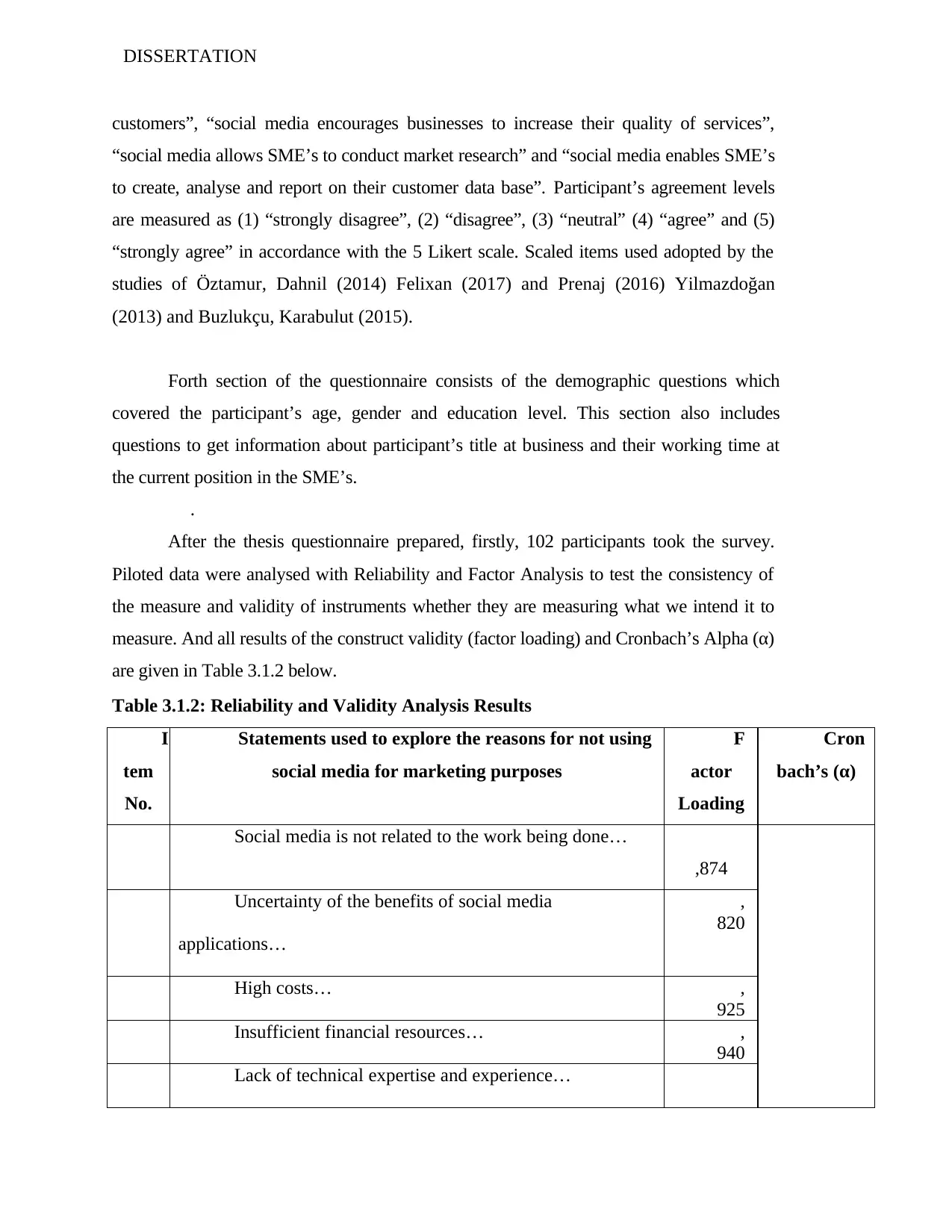
DISSERTATION
customers”, “social media encourages businesses to increase their quality of services”,
“social media allows SME’s to conduct market research” and “social media enables SME’s
to create, analyse and report on their customer data base”. Participant’s agreement levels
are measured as (1) “strongly disagree”, (2) “disagree”, (3) “neutral” (4) “agree” and (5)
“strongly agree” in accordance with the 5 Likert scale. Scaled items used adopted by the
studies of Öztamur, Dahnil (2014) Felixan (2017) and Prenaj (2016) Yilmazdoğan
(2013) and Buzlukçu, Karabulut (2015).
Forth section of the questionnaire consists of the demographic questions which
covered the participant’s age, gender and education level. This section also includes
questions to get information about participant’s title at business and their working time at
the current position in the SME’s.
.
After the thesis questionnaire prepared, firstly, 102 participants took the survey.
Piloted data were analysed with Reliability and Factor Analysis to test the consistency of
the measure and validity of instruments whether they are measuring what we intend it to
measure. And all results of the construct validity (factor loading) and Cronbach’s Alpha (α)
are given in Table 3.1.2 below.
Table 3.1.2: Reliability and Validity Analysis Results
I
tem
No.
Statements used to explore the reasons for not using
social media for marketing purposes
F
actor
Loading
Cron
bach’s (α)
Social media is not related to the work being done…
,874
Uncertainty of the benefits of social media
applications…
,
820
High costs… ,
925
Insufficient financial resources… ,
940
Lack of technical expertise and experience…
customers”, “social media encourages businesses to increase their quality of services”,
“social media allows SME’s to conduct market research” and “social media enables SME’s
to create, analyse and report on their customer data base”. Participant’s agreement levels
are measured as (1) “strongly disagree”, (2) “disagree”, (3) “neutral” (4) “agree” and (5)
“strongly agree” in accordance with the 5 Likert scale. Scaled items used adopted by the
studies of Öztamur, Dahnil (2014) Felixan (2017) and Prenaj (2016) Yilmazdoğan
(2013) and Buzlukçu, Karabulut (2015).
Forth section of the questionnaire consists of the demographic questions which
covered the participant’s age, gender and education level. This section also includes
questions to get information about participant’s title at business and their working time at
the current position in the SME’s.
.
After the thesis questionnaire prepared, firstly, 102 participants took the survey.
Piloted data were analysed with Reliability and Factor Analysis to test the consistency of
the measure and validity of instruments whether they are measuring what we intend it to
measure. And all results of the construct validity (factor loading) and Cronbach’s Alpha (α)
are given in Table 3.1.2 below.
Table 3.1.2: Reliability and Validity Analysis Results
I
tem
No.
Statements used to explore the reasons for not using
social media for marketing purposes
F
actor
Loading
Cron
bach’s (α)
Social media is not related to the work being done…
,874
Uncertainty of the benefits of social media
applications…
,
820
High costs… ,
925
Insufficient financial resources… ,
940
Lack of technical expertise and experience…
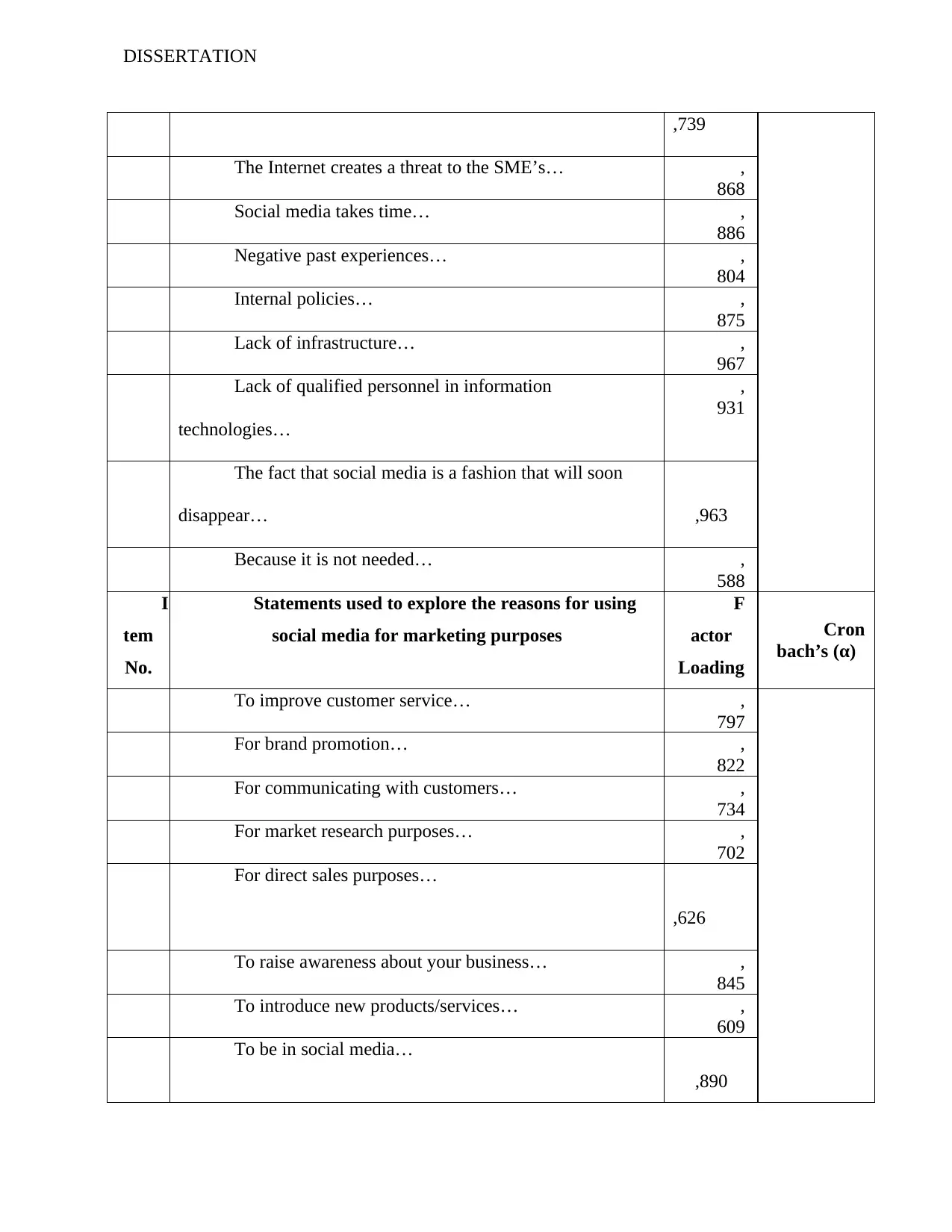
DISSERTATION
,739
The Internet creates a threat to the SME’s… ,
868
Social media takes time… ,
886
Negative past experiences… ,
804
Internal policies… ,
875
Lack of infrastructure… ,
967
Lack of qualified personnel in information
technologies…
,
931
The fact that social media is a fashion that will soon
disappear… ,963
Because it is not needed… ,
588
I
tem
No.
Statements used to explore the reasons for using
social media for marketing purposes
F
actor
Loading
Cron
bach’s (α)
To improve customer service… ,
797
For brand promotion… ,
822
For communicating with customers… ,
734
For market research purposes… ,
702
For direct sales purposes…
,626
To raise awareness about your business… ,
845
To introduce new products/services… ,
609
To be in social media…
,890
,739
The Internet creates a threat to the SME’s… ,
868
Social media takes time… ,
886
Negative past experiences… ,
804
Internal policies… ,
875
Lack of infrastructure… ,
967
Lack of qualified personnel in information
technologies…
,
931
The fact that social media is a fashion that will soon
disappear… ,963
Because it is not needed… ,
588
I
tem
No.
Statements used to explore the reasons for using
social media for marketing purposes
F
actor
Loading
Cron
bach’s (α)
To improve customer service… ,
797
For brand promotion… ,
822
For communicating with customers… ,
734
For market research purposes… ,
702
For direct sales purposes…
,626
To raise awareness about your business… ,
845
To introduce new products/services… ,
609
To be in social media…
,890
Paraphrase This Document
Need a fresh take? Get an instant paraphrase of this document with our AI Paraphraser
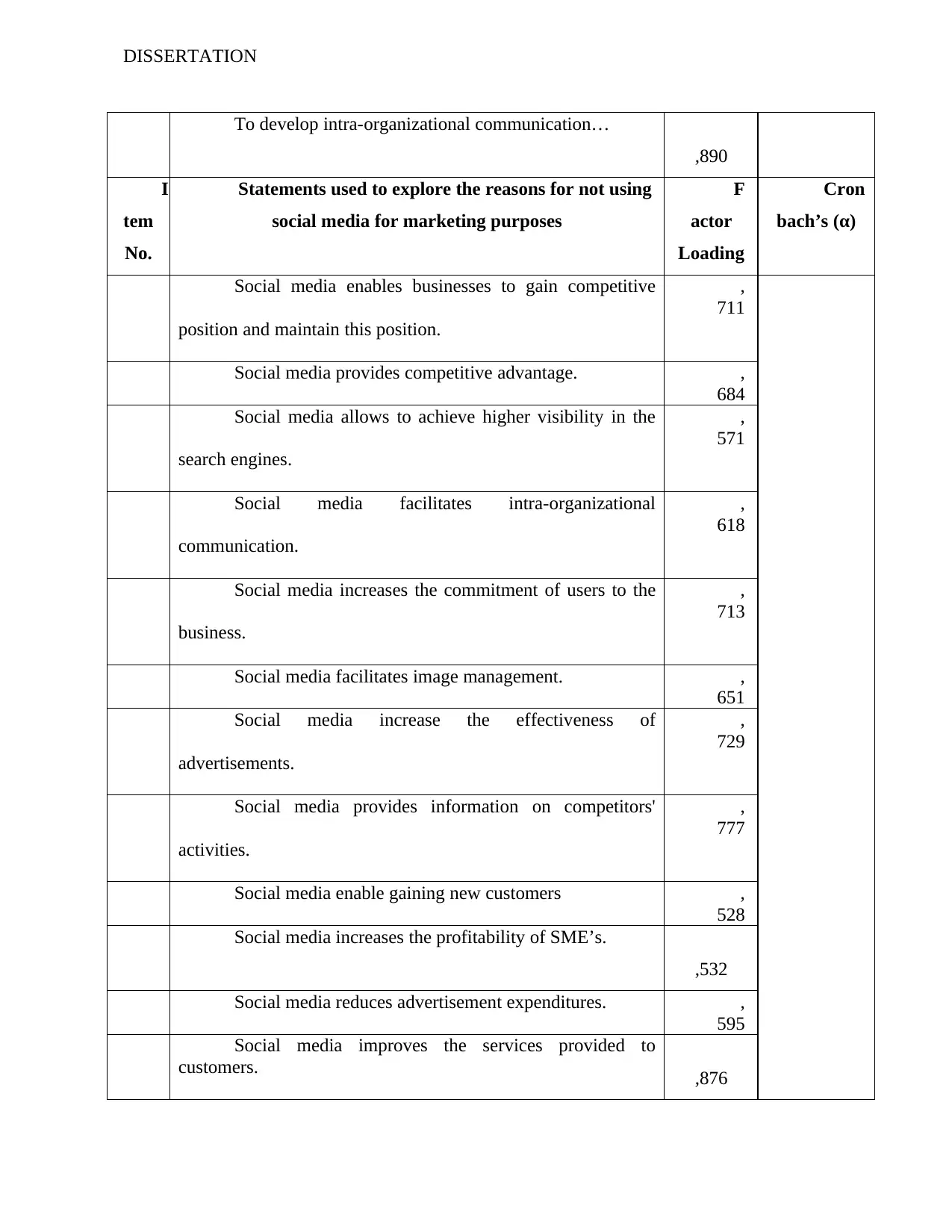
DISSERTATION
To develop intra-organizational communication…
,890
I
tem
No.
Statements used to explore the reasons for not using
social media for marketing purposes
F
actor
Loading
Cron
bach’s (α)
Social media enables businesses to gain competitive
position and maintain this position.
,
711
Social media provides competitive advantage. ,
684
Social media allows to achieve higher visibility in the
search engines.
,
571
Social media facilitates intra-organizational
communication.
,
618
Social media increases the commitment of users to the
business.
,
713
Social media facilitates image management. ,
651
Social media increase the effectiveness of
advertisements.
,
729
Social media provides information on competitors'
activities.
,
777
Social media enable gaining new customers ,
528
Social media increases the profitability of SME’s.
,532
Social media reduces advertisement expenditures. ,
595
Social media improves the services provided to
customers. ,876
To develop intra-organizational communication…
,890
I
tem
No.
Statements used to explore the reasons for not using
social media for marketing purposes
F
actor
Loading
Cron
bach’s (α)
Social media enables businesses to gain competitive
position and maintain this position.
,
711
Social media provides competitive advantage. ,
684
Social media allows to achieve higher visibility in the
search engines.
,
571
Social media facilitates intra-organizational
communication.
,
618
Social media increases the commitment of users to the
business.
,
713
Social media facilitates image management. ,
651
Social media increase the effectiveness of
advertisements.
,
729
Social media provides information on competitors'
activities.
,
777
Social media enable gaining new customers ,
528
Social media increases the profitability of SME’s.
,532
Social media reduces advertisement expenditures. ,
595
Social media improves the services provided to
customers. ,876
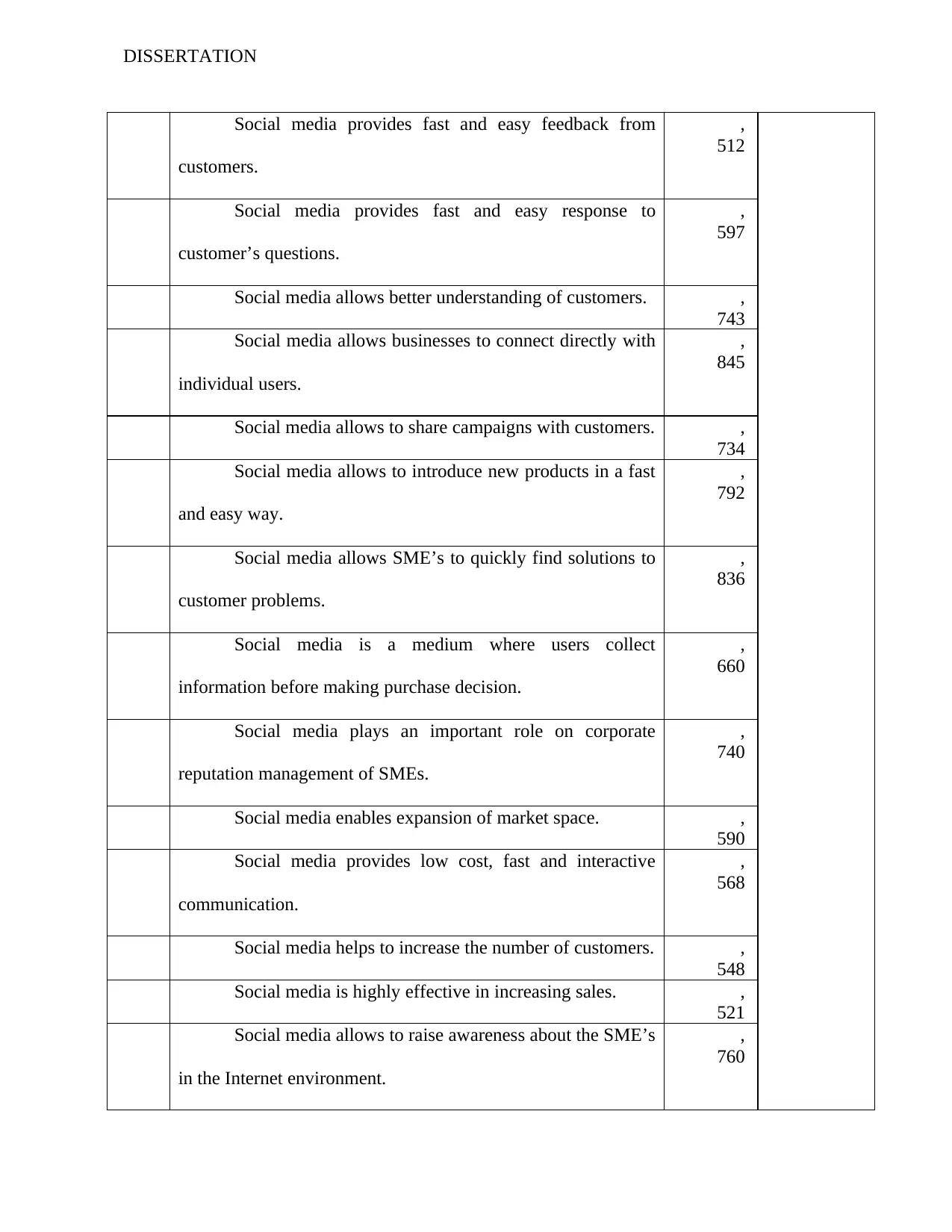
DISSERTATION
Social media provides fast and easy feedback from
customers.
,
512
Social media provides fast and easy response to
customer’s questions.
,
597
Social media allows better understanding of customers. ,
743
Social media allows businesses to connect directly with
individual users.
,
845
Social media allows to share campaigns with customers. ,
734
Social media allows to introduce new products in a fast
and easy way.
,
792
Social media allows SME’s to quickly find solutions to
customer problems.
,
836
Social media is a medium where users collect
information before making purchase decision.
,
660
Social media plays an important role on corporate
reputation management of SMEs.
,
740
Social media enables expansion of market space. ,
590
Social media provides low cost, fast and interactive
communication.
,
568
Social media helps to increase the number of customers. ,
548
Social media is highly effective in increasing sales. ,
521
Social media allows to raise awareness about the SME’s
in the Internet environment.
,
760
Social media provides fast and easy feedback from
customers.
,
512
Social media provides fast and easy response to
customer’s questions.
,
597
Social media allows better understanding of customers. ,
743
Social media allows businesses to connect directly with
individual users.
,
845
Social media allows to share campaigns with customers. ,
734
Social media allows to introduce new products in a fast
and easy way.
,
792
Social media allows SME’s to quickly find solutions to
customer problems.
,
836
Social media is a medium where users collect
information before making purchase decision.
,
660
Social media plays an important role on corporate
reputation management of SMEs.
,
740
Social media enables expansion of market space. ,
590
Social media provides low cost, fast and interactive
communication.
,
568
Social media helps to increase the number of customers. ,
548
Social media is highly effective in increasing sales. ,
521
Social media allows to raise awareness about the SME’s
in the Internet environment.
,
760
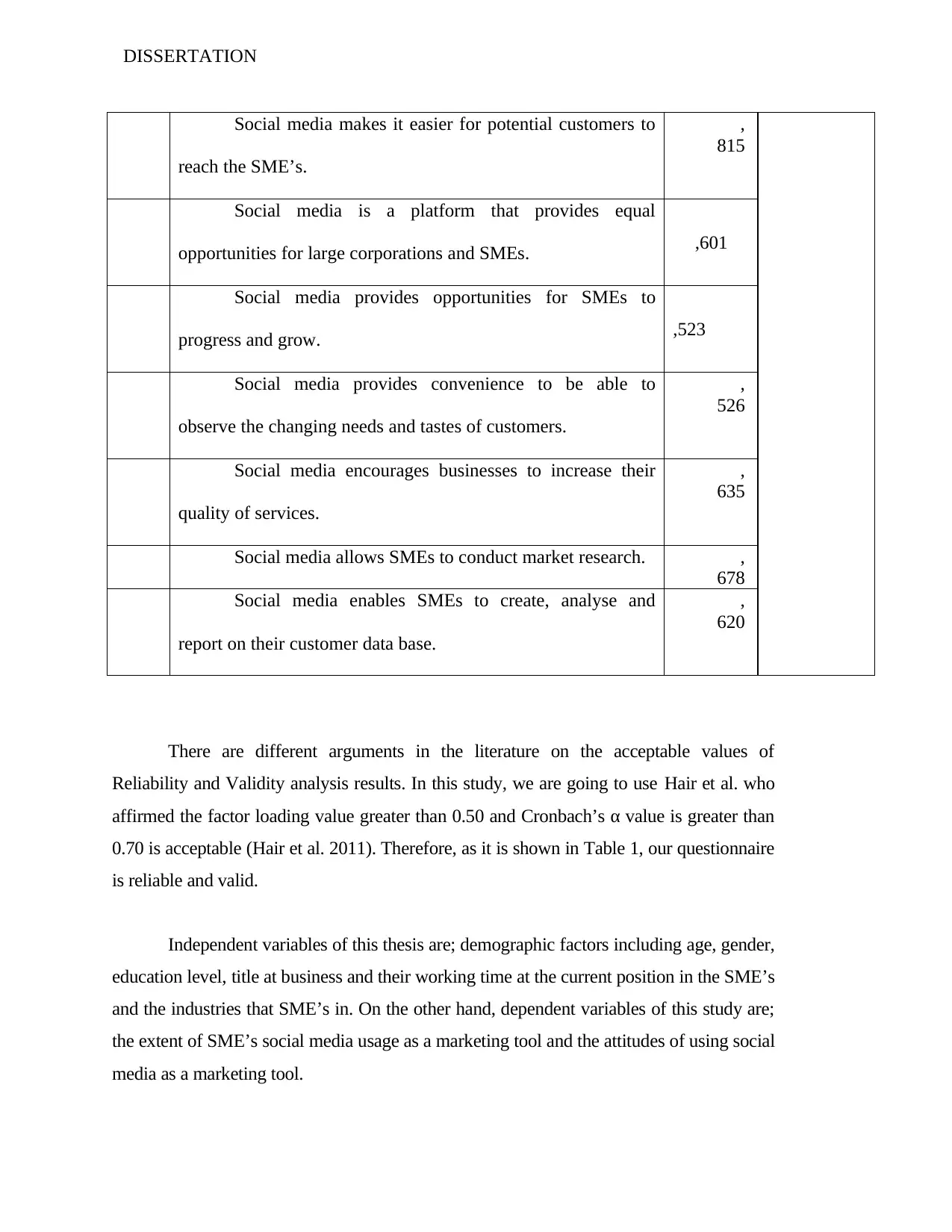
DISSERTATION
Social media makes it easier for potential customers to
reach the SME’s.
,
815
Social media is a platform that provides equal
opportunities for large corporations and SMEs. ,601
Social media provides opportunities for SMEs to
progress and grow. ,523
Social media provides convenience to be able to
observe the changing needs and tastes of customers.
,
526
Social media encourages businesses to increase their
quality of services.
,
635
Social media allows SMEs to conduct market research. ,
678
Social media enables SMEs to create, analyse and
report on their customer data base.
,
620
There are different arguments in the literature on the acceptable values of
Reliability and Validity analysis results. In this study, we are going to use Hair et al. who
affirmed the factor loading value greater than 0.50 and Cronbach’s α value is greater than
0.70 is acceptable (Hair et al. 2011). Therefore, as it is shown in Table 1, our questionnaire
is reliable and valid.
Independent variables of this thesis are; demographic factors including age, gender,
education level, title at business and their working time at the current position in the SME’s
and the industries that SME’s in. On the other hand, dependent variables of this study are;
the extent of SME’s social media usage as a marketing tool and the attitudes of using social
media as a marketing tool.
Social media makes it easier for potential customers to
reach the SME’s.
,
815
Social media is a platform that provides equal
opportunities for large corporations and SMEs. ,601
Social media provides opportunities for SMEs to
progress and grow. ,523
Social media provides convenience to be able to
observe the changing needs and tastes of customers.
,
526
Social media encourages businesses to increase their
quality of services.
,
635
Social media allows SMEs to conduct market research. ,
678
Social media enables SMEs to create, analyse and
report on their customer data base.
,
620
There are different arguments in the literature on the acceptable values of
Reliability and Validity analysis results. In this study, we are going to use Hair et al. who
affirmed the factor loading value greater than 0.50 and Cronbach’s α value is greater than
0.70 is acceptable (Hair et al. 2011). Therefore, as it is shown in Table 1, our questionnaire
is reliable and valid.
Independent variables of this thesis are; demographic factors including age, gender,
education level, title at business and their working time at the current position in the SME’s
and the industries that SME’s in. On the other hand, dependent variables of this study are;
the extent of SME’s social media usage as a marketing tool and the attitudes of using social
media as a marketing tool.
Secure Best Marks with AI Grader
Need help grading? Try our AI Grader for instant feedback on your assignments.

DISSERTATION
In this study, correlational method used to determine the relationship between
independent and dependent variables and also level of variance and cause-effect relation.
3.1.3. Research Population and Sample
The population of this research comprises the SME’s in Nicosia. Official
information about the SME’s in Nicosia gotten from the Cyprus Turkish Chamber of
Industry and Turkish Cypriot Chamber of Commerce. Based on this information, the
sample size of the survey was determined as 102 (n=102).
The research focused on the SMEs owners, managers and other administrative
staff. Random sampling technique is applied as sampling method to get the representatives
of the SMEs owners, managers and other administrative staff. The sample covers owners,
managers and other administrative staff of SME’s in different industries.
3.1.4 Scope and Limitations of the Research
The scope areas of this study are the extent of SMEs social media usage as a
marketing tool, the purposes of SME’s social media usage as a marketing tool, the attitudes
of using social media as a marketing tool from the perspective of the SMEs owners,
managers and other administrative staff and the nature of the relationship between the
demographic variables and their attitudes of using social media as a marketing tool.
One of the limitations of this study is the difficulty to access SME’s, owners and
managers because of their busy schedule. In addition, SME’s owners, managers and other
administrative staff ‘s negative bias against the questionnaires and not being volunteer to
share information about the SME’s and personal point of view and furthermore the
language barrier can be also listed as limitations of this study. This limitation has caused
the survey not to be applied to the specified number of people.
3.1.5 Data Collection Process
In this thesis study, primary data collected through questionnaires. Data collection
process started after obtaining necessary ethical permissions from the Cyprus International
In this study, correlational method used to determine the relationship between
independent and dependent variables and also level of variance and cause-effect relation.
3.1.3. Research Population and Sample
The population of this research comprises the SME’s in Nicosia. Official
information about the SME’s in Nicosia gotten from the Cyprus Turkish Chamber of
Industry and Turkish Cypriot Chamber of Commerce. Based on this information, the
sample size of the survey was determined as 102 (n=102).
The research focused on the SMEs owners, managers and other administrative
staff. Random sampling technique is applied as sampling method to get the representatives
of the SMEs owners, managers and other administrative staff. The sample covers owners,
managers and other administrative staff of SME’s in different industries.
3.1.4 Scope and Limitations of the Research
The scope areas of this study are the extent of SMEs social media usage as a
marketing tool, the purposes of SME’s social media usage as a marketing tool, the attitudes
of using social media as a marketing tool from the perspective of the SMEs owners,
managers and other administrative staff and the nature of the relationship between the
demographic variables and their attitudes of using social media as a marketing tool.
One of the limitations of this study is the difficulty to access SME’s, owners and
managers because of their busy schedule. In addition, SME’s owners, managers and other
administrative staff ‘s negative bias against the questionnaires and not being volunteer to
share information about the SME’s and personal point of view and furthermore the
language barrier can be also listed as limitations of this study. This limitation has caused
the survey not to be applied to the specified number of people.
3.1.5 Data Collection Process
In this thesis study, primary data collected through questionnaires. Data collection
process started after obtaining necessary ethical permissions from the Cyprus International
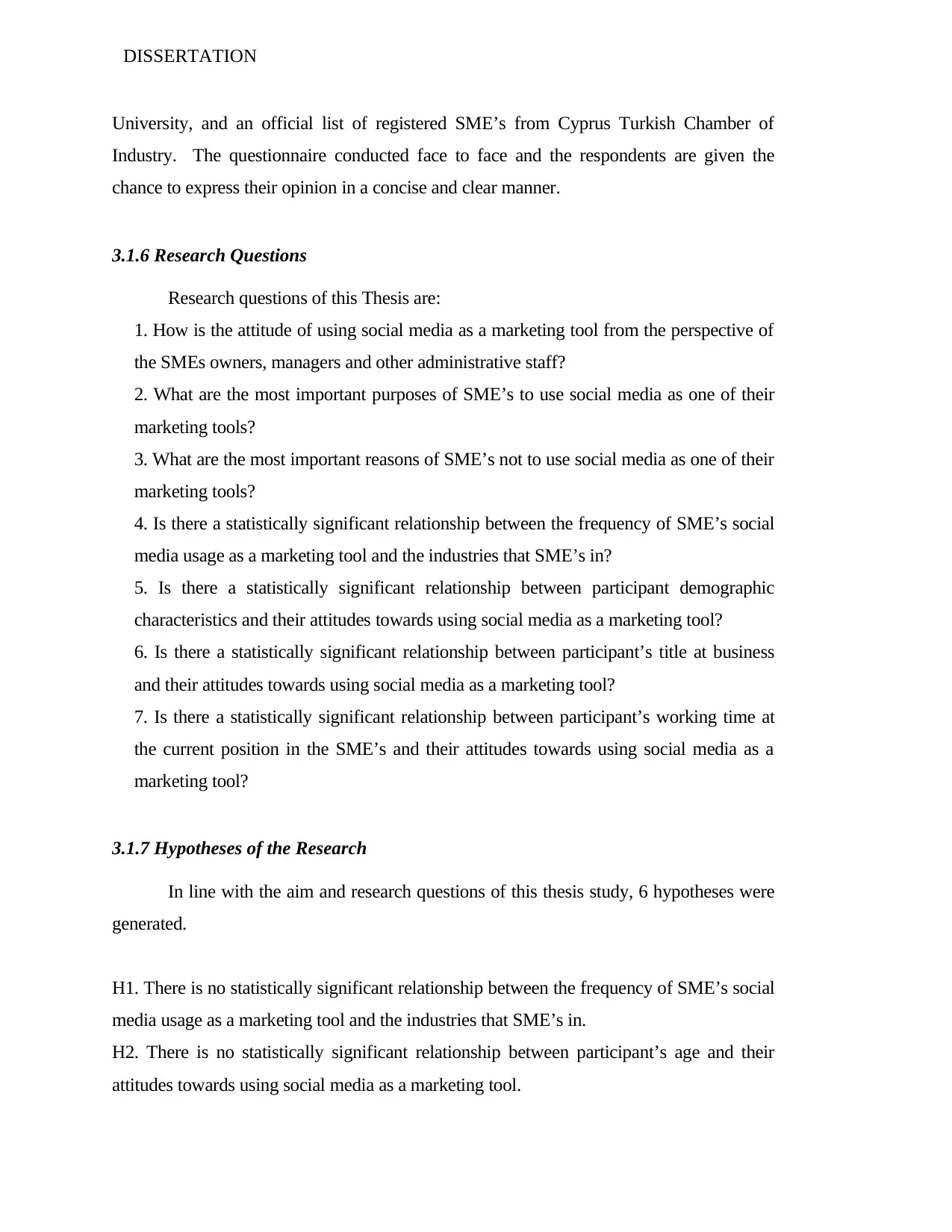
DISSERTATION
University, and an official list of registered SME’s from Cyprus Turkish Chamber of
Industry. The questionnaire conducted face to face and the respondents are given the
chance to express their opinion in a concise and clear manner.
3.1.6 Research Questions
Research questions of this Thesis are:
1. How is the attitude of using social media as a marketing tool from the perspective of
the SMEs owners, managers and other administrative staff?
2. What are the most important purposes of SME’s to use social media as one of their
marketing tools?
3. What are the most important reasons of SME’s not to use social media as one of their
marketing tools?
4. Is there a statistically significant relationship between the frequency of SME’s social
media usage as a marketing tool and the industries that SME’s in?
5. Is there a statistically significant relationship between participant demographic
characteristics and their attitudes towards using social media as a marketing tool?
6. Is there a statistically significant relationship between participant’s title at business
and their attitudes towards using social media as a marketing tool?
7. Is there a statistically significant relationship between participant’s working time at
the current position in the SME’s and their attitudes towards using social media as a
marketing tool?
3.1.7 Hypotheses of the Research
In line with the aim and research questions of this thesis study, 6 hypotheses were
generated.
H1. There is no statistically significant relationship between the frequency of SME’s social
media usage as a marketing tool and the industries that SME’s in.
H2. There is no statistically significant relationship between participant’s age and their
attitudes towards using social media as a marketing tool.
University, and an official list of registered SME’s from Cyprus Turkish Chamber of
Industry. The questionnaire conducted face to face and the respondents are given the
chance to express their opinion in a concise and clear manner.
3.1.6 Research Questions
Research questions of this Thesis are:
1. How is the attitude of using social media as a marketing tool from the perspective of
the SMEs owners, managers and other administrative staff?
2. What are the most important purposes of SME’s to use social media as one of their
marketing tools?
3. What are the most important reasons of SME’s not to use social media as one of their
marketing tools?
4. Is there a statistically significant relationship between the frequency of SME’s social
media usage as a marketing tool and the industries that SME’s in?
5. Is there a statistically significant relationship between participant demographic
characteristics and their attitudes towards using social media as a marketing tool?
6. Is there a statistically significant relationship between participant’s title at business
and their attitudes towards using social media as a marketing tool?
7. Is there a statistically significant relationship between participant’s working time at
the current position in the SME’s and their attitudes towards using social media as a
marketing tool?
3.1.7 Hypotheses of the Research
In line with the aim and research questions of this thesis study, 6 hypotheses were
generated.
H1. There is no statistically significant relationship between the frequency of SME’s social
media usage as a marketing tool and the industries that SME’s in.
H2. There is no statistically significant relationship between participant’s age and their
attitudes towards using social media as a marketing tool.

DISSERTATION
H3. There is no statistically significant relationship between participant gender and their
attitudes towards using social media as a marketing tool.
H4. There is no statistically significant relationship between participant’s education level
and their attitudes towards using social media as a marketing tool.
H5. There is no statistically significant relationship between participant’s title at business
and their attitudes towards using social media as a marketing tool.
H6. There is no statistically significant relationship between participant’s working time at
the current position in the SME’s and their attitudes towards using social media as a
marketing tool.
3.1.8 Data Analysis
In this research paper, the frequency, the regression analysis and the correlation are to be
used for analysing the data that is gathered. The quantitative data that were collected were
mainly analysed by the Statistical Package of Social Science (SPSS) analysis. The results of
frequency analysis mainly determine the number of survey participants that are included in the
category. The correlation analysis is mainly carried out to analyse nature and the strength of the
relationships between the variables and the helps in showing strength of cause effect relationship.
Regression analysis on the other hand is the analysis of results that predicts value of a
particular variable that is based on value of some different variable. It is accepted that the
significance value (p) is same as or is less than 0.05. The statistical variance or the significance is
known as the mean of the data. In regression correlation coefficient known as r mainly indicates
nature and the strength of relationship between the dependent and the independent variables. The
value of R mainly ranges -1 to +1 where 0 basically means that there is no relationship and -1
states a negative value and +1 states positive relationship between the variables. R² represents the
coefficient determination and basically varies from 0 to 1.
H3. There is no statistically significant relationship between participant gender and their
attitudes towards using social media as a marketing tool.
H4. There is no statistically significant relationship between participant’s education level
and their attitudes towards using social media as a marketing tool.
H5. There is no statistically significant relationship between participant’s title at business
and their attitudes towards using social media as a marketing tool.
H6. There is no statistically significant relationship between participant’s working time at
the current position in the SME’s and their attitudes towards using social media as a
marketing tool.
3.1.8 Data Analysis
In this research paper, the frequency, the regression analysis and the correlation are to be
used for analysing the data that is gathered. The quantitative data that were collected were
mainly analysed by the Statistical Package of Social Science (SPSS) analysis. The results of
frequency analysis mainly determine the number of survey participants that are included in the
category. The correlation analysis is mainly carried out to analyse nature and the strength of the
relationships between the variables and the helps in showing strength of cause effect relationship.
Regression analysis on the other hand is the analysis of results that predicts value of a
particular variable that is based on value of some different variable. It is accepted that the
significance value (p) is same as or is less than 0.05. The statistical variance or the significance is
known as the mean of the data. In regression correlation coefficient known as r mainly indicates
nature and the strength of relationship between the dependent and the independent variables. The
value of R mainly ranges -1 to +1 where 0 basically means that there is no relationship and -1
states a negative value and +1 states positive relationship between the variables. R² represents the
coefficient determination and basically varies from 0 to 1.
Paraphrase This Document
Need a fresh take? Get an instant paraphrase of this document with our AI Paraphraser
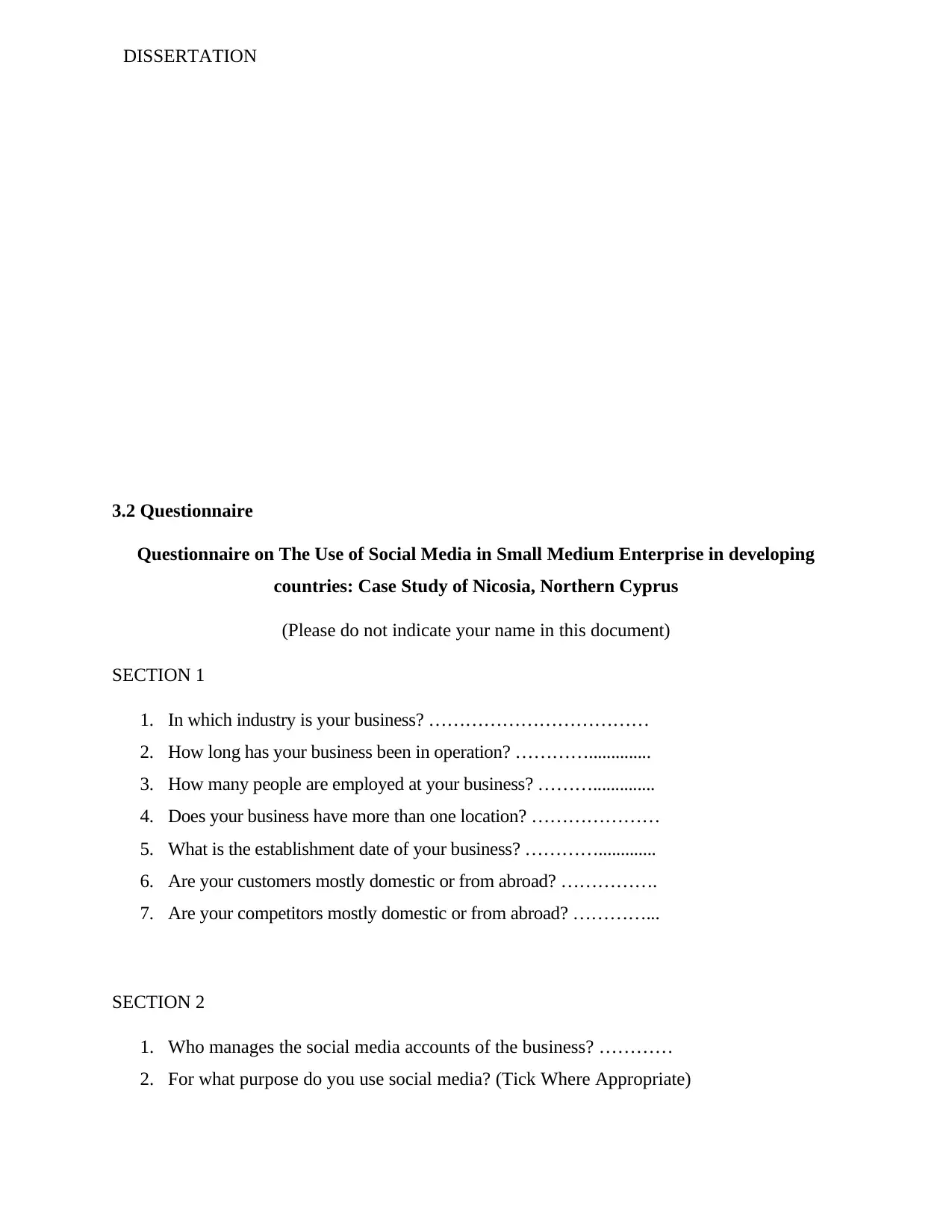
DISSERTATION
3.2 Questionnaire
Questionnaire on The Use of Social Media in Small Medium Enterprise in developing
countries: Case Study of Nicosia, Northern Cyprus
(Please do not indicate your name in this document)
SECTION 1
1. In which industry is your business? ………………………………
2. How long has your business been in operation? …………..............
3. How many people are employed at your business? ………..............
4. Does your business have more than one location? …………………
5. What is the establishment date of your business? ………….............
6. Are your customers mostly domestic or from abroad? …………….
7. Are your competitors mostly domestic or from abroad? …………...
SECTION 2
1. Who manages the social media accounts of the business? …………
2. For what purpose do you use social media? (Tick Where Appropriate)
3.2 Questionnaire
Questionnaire on The Use of Social Media in Small Medium Enterprise in developing
countries: Case Study of Nicosia, Northern Cyprus
(Please do not indicate your name in this document)
SECTION 1
1. In which industry is your business? ………………………………
2. How long has your business been in operation? …………..............
3. How many people are employed at your business? ………..............
4. Does your business have more than one location? …………………
5. What is the establishment date of your business? ………….............
6. Are your customers mostly domestic or from abroad? …………….
7. Are your competitors mostly domestic or from abroad? …………...
SECTION 2
1. Who manages the social media accounts of the business? …………
2. For what purpose do you use social media? (Tick Where Appropriate)
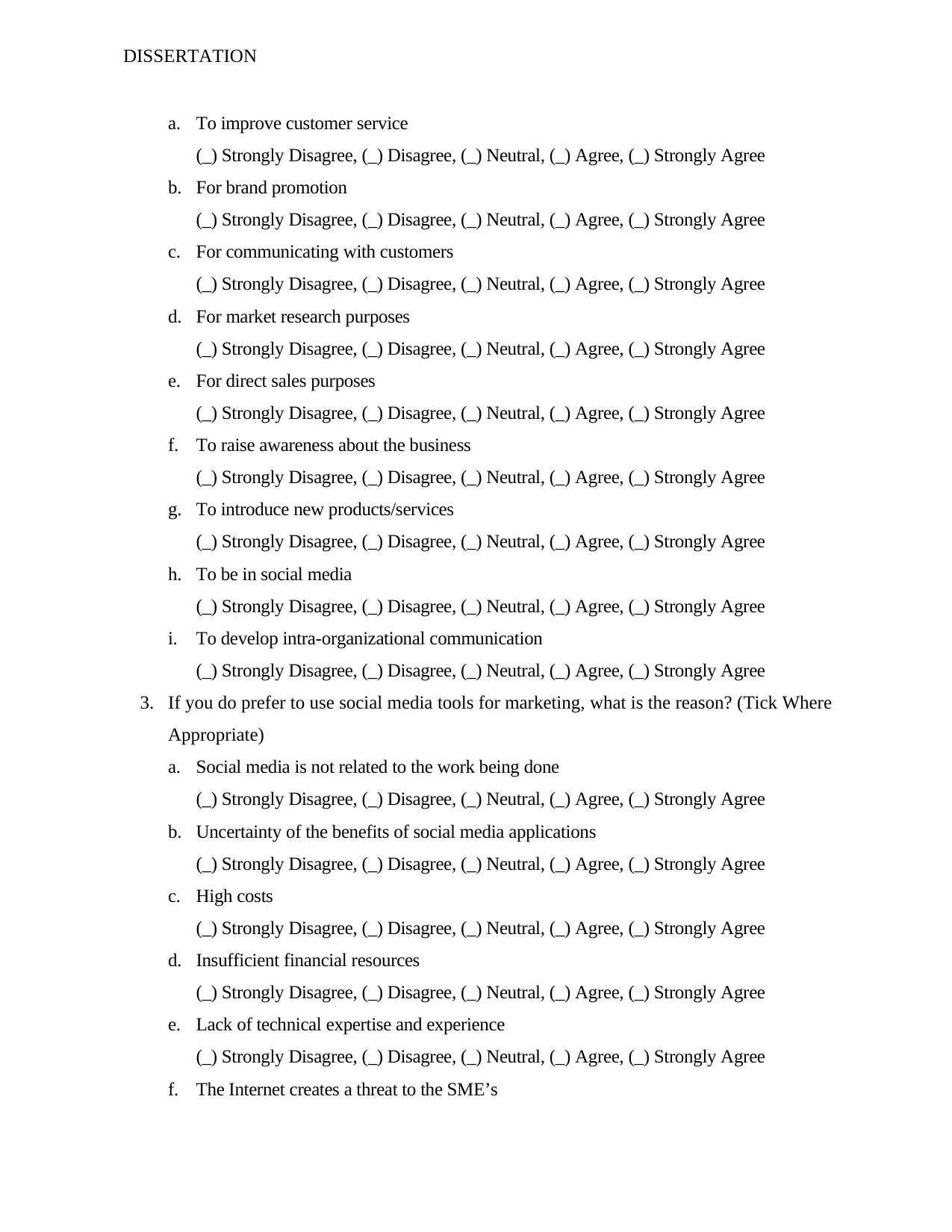
DISSERTATION
a. To improve customer service
(_) Strongly Disagree, (_) Disagree, (_) Neutral, (_) Agree, (_) Strongly Agree
b. For brand promotion
(_) Strongly Disagree, (_) Disagree, (_) Neutral, (_) Agree, (_) Strongly Agree
c. For communicating with customers
(_) Strongly Disagree, (_) Disagree, (_) Neutral, (_) Agree, (_) Strongly Agree
d. For market research purposes
(_) Strongly Disagree, (_) Disagree, (_) Neutral, (_) Agree, (_) Strongly Agree
e. For direct sales purposes
(_) Strongly Disagree, (_) Disagree, (_) Neutral, (_) Agree, (_) Strongly Agree
f. To raise awareness about the business
(_) Strongly Disagree, (_) Disagree, (_) Neutral, (_) Agree, (_) Strongly Agree
g. To introduce new products/services
(_) Strongly Disagree, (_) Disagree, (_) Neutral, (_) Agree, (_) Strongly Agree
h. To be in social media
(_) Strongly Disagree, (_) Disagree, (_) Neutral, (_) Agree, (_) Strongly Agree
i. To develop intra-organizational communication
(_) Strongly Disagree, (_) Disagree, (_) Neutral, (_) Agree, (_) Strongly Agree
3. If you do prefer to use social media tools for marketing, what is the reason? (Tick Where
Appropriate)
a. Social media is not related to the work being done
(_) Strongly Disagree, (_) Disagree, (_) Neutral, (_) Agree, (_) Strongly Agree
b. Uncertainty of the benefits of social media applications
(_) Strongly Disagree, (_) Disagree, (_) Neutral, (_) Agree, (_) Strongly Agree
c. High costs
(_) Strongly Disagree, (_) Disagree, (_) Neutral, (_) Agree, (_) Strongly Agree
d. Insufficient financial resources
(_) Strongly Disagree, (_) Disagree, (_) Neutral, (_) Agree, (_) Strongly Agree
e. Lack of technical expertise and experience
(_) Strongly Disagree, (_) Disagree, (_) Neutral, (_) Agree, (_) Strongly Agree
f. The Internet creates a threat to the SME’s
a. To improve customer service
(_) Strongly Disagree, (_) Disagree, (_) Neutral, (_) Agree, (_) Strongly Agree
b. For brand promotion
(_) Strongly Disagree, (_) Disagree, (_) Neutral, (_) Agree, (_) Strongly Agree
c. For communicating with customers
(_) Strongly Disagree, (_) Disagree, (_) Neutral, (_) Agree, (_) Strongly Agree
d. For market research purposes
(_) Strongly Disagree, (_) Disagree, (_) Neutral, (_) Agree, (_) Strongly Agree
e. For direct sales purposes
(_) Strongly Disagree, (_) Disagree, (_) Neutral, (_) Agree, (_) Strongly Agree
f. To raise awareness about the business
(_) Strongly Disagree, (_) Disagree, (_) Neutral, (_) Agree, (_) Strongly Agree
g. To introduce new products/services
(_) Strongly Disagree, (_) Disagree, (_) Neutral, (_) Agree, (_) Strongly Agree
h. To be in social media
(_) Strongly Disagree, (_) Disagree, (_) Neutral, (_) Agree, (_) Strongly Agree
i. To develop intra-organizational communication
(_) Strongly Disagree, (_) Disagree, (_) Neutral, (_) Agree, (_) Strongly Agree
3. If you do prefer to use social media tools for marketing, what is the reason? (Tick Where
Appropriate)
a. Social media is not related to the work being done
(_) Strongly Disagree, (_) Disagree, (_) Neutral, (_) Agree, (_) Strongly Agree
b. Uncertainty of the benefits of social media applications
(_) Strongly Disagree, (_) Disagree, (_) Neutral, (_) Agree, (_) Strongly Agree
c. High costs
(_) Strongly Disagree, (_) Disagree, (_) Neutral, (_) Agree, (_) Strongly Agree
d. Insufficient financial resources
(_) Strongly Disagree, (_) Disagree, (_) Neutral, (_) Agree, (_) Strongly Agree
e. Lack of technical expertise and experience
(_) Strongly Disagree, (_) Disagree, (_) Neutral, (_) Agree, (_) Strongly Agree
f. The Internet creates a threat to the SME’s

DISSERTATION
(_) Strongly Disagree, (_) Disagree, (_) Neutral, (_) Agree, (_) Strongly Agree
g. Social media takes time
(_) Strongly Disagree, (_) Disagree, (_) Neutral, (_) Agree, (_) Strongly Agree
h. Negative past experiences
(_) Strongly Disagree, (_) Disagree, (_) Neutral, (_) Agree, (_) Strongly Agree
i. Internal policies
(_) Strongly Disagree, (_) Disagree, (_) Neutral, (_) Agree, (_) Strongly Agree
j. Lack of infrastructure
(_) Strongly Disagree, (_) Disagree, (_) Neutral, (_) Agree, (_) Strongly Agree
k. Lack of qualified personnel in information technologies
(_) Strongly Disagree, (_) Disagree, (_) Neutral, (_) Agree, (_) Strongly Agree
l. The fact that social media is a fashion that will soon disappear
(_) Strongly Disagree, (_) Disagree, (_) Neutral, (_) Agree, (_) Strongly Agree
m. Because it is not needed
(_) Strongly Disagree, (_) Disagree, (_) Neutral, (_) Agree, (_) Strongly Agree
SECTION 3
1. What is your position at the SME? (Tick Where Appropriate)
(_) SMEs Owners, (_) Managers, (_) Other Administrative Staff
2. Please Tick Where Appropriate
a. Social media enables businesses to gain competitive position and maintain this position
(_) Strongly Disagree, (_) Disagree, (_) Neutral, (_) Agree, (_) Strongly Agree
b. Social media provides competitive advantage
(_) Strongly Disagree, (_) Disagree, (_) Neutral, (_) Agree, (_) Strongly Agree
c. Social media allows to achieve higher visibility in the search engines
(_) Strongly Disagree, (_) Disagree, (_) Neutral, (_) Agree, (_) Strongly Agree
d. Social media facilitates intra-organizational communication
(_) Strongly Disagree, (_) Disagree, (_) Neutral, (_) Agree, (_) Strongly Agree
e. Social media increases the commitment of users to the business
(_) Strongly Disagree, (_) Disagree, (_) Neutral, (_) Agree, (_) Strongly Agree
g. Social media takes time
(_) Strongly Disagree, (_) Disagree, (_) Neutral, (_) Agree, (_) Strongly Agree
h. Negative past experiences
(_) Strongly Disagree, (_) Disagree, (_) Neutral, (_) Agree, (_) Strongly Agree
i. Internal policies
(_) Strongly Disagree, (_) Disagree, (_) Neutral, (_) Agree, (_) Strongly Agree
j. Lack of infrastructure
(_) Strongly Disagree, (_) Disagree, (_) Neutral, (_) Agree, (_) Strongly Agree
k. Lack of qualified personnel in information technologies
(_) Strongly Disagree, (_) Disagree, (_) Neutral, (_) Agree, (_) Strongly Agree
l. The fact that social media is a fashion that will soon disappear
(_) Strongly Disagree, (_) Disagree, (_) Neutral, (_) Agree, (_) Strongly Agree
m. Because it is not needed
(_) Strongly Disagree, (_) Disagree, (_) Neutral, (_) Agree, (_) Strongly Agree
SECTION 3
1. What is your position at the SME? (Tick Where Appropriate)
(_) SMEs Owners, (_) Managers, (_) Other Administrative Staff
2. Please Tick Where Appropriate
a. Social media enables businesses to gain competitive position and maintain this position
(_) Strongly Disagree, (_) Disagree, (_) Neutral, (_) Agree, (_) Strongly Agree
b. Social media provides competitive advantage
(_) Strongly Disagree, (_) Disagree, (_) Neutral, (_) Agree, (_) Strongly Agree
c. Social media allows to achieve higher visibility in the search engines
(_) Strongly Disagree, (_) Disagree, (_) Neutral, (_) Agree, (_) Strongly Agree
d. Social media facilitates intra-organizational communication
(_) Strongly Disagree, (_) Disagree, (_) Neutral, (_) Agree, (_) Strongly Agree
e. Social media increases the commitment of users to the business
Secure Best Marks with AI Grader
Need help grading? Try our AI Grader for instant feedback on your assignments.
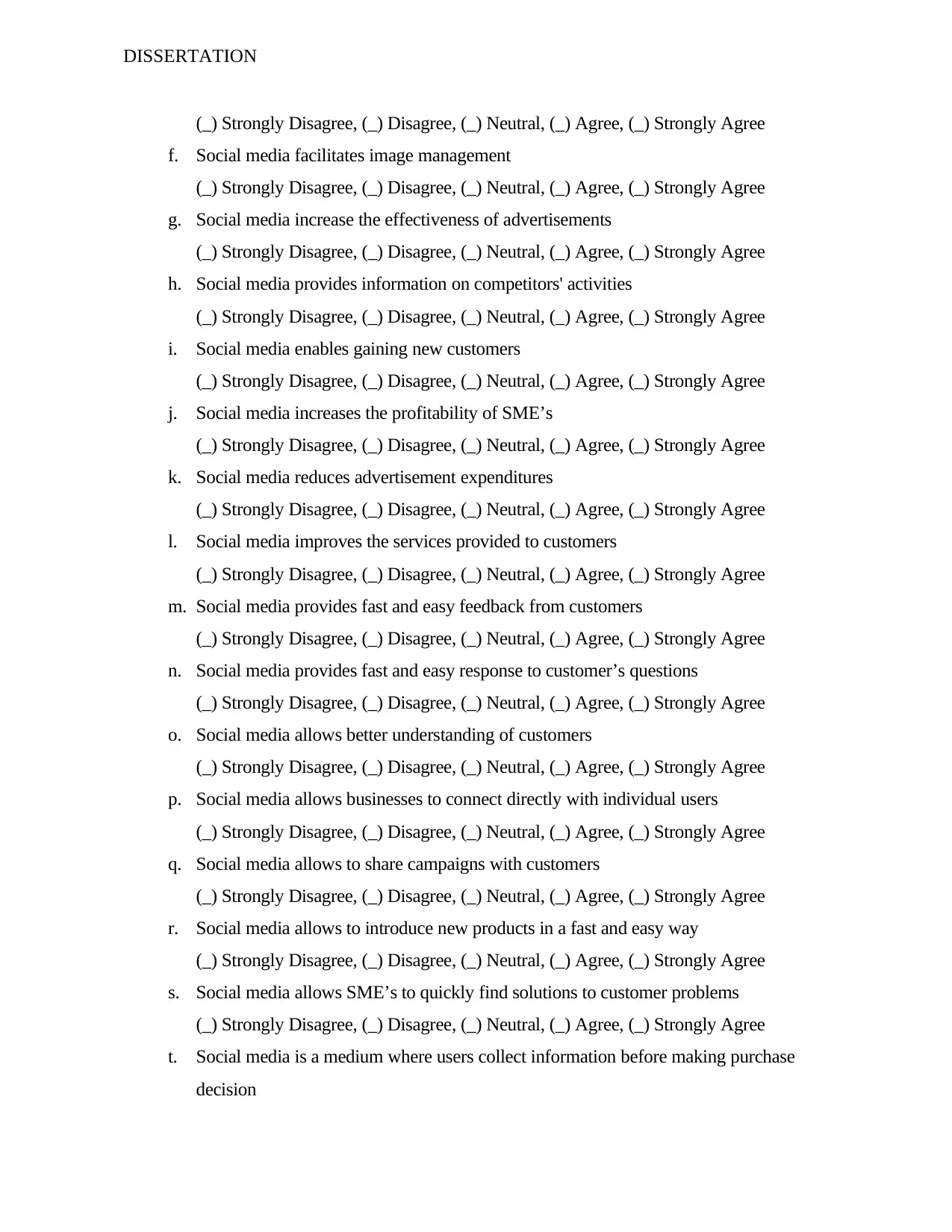
DISSERTATION
(_) Strongly Disagree, (_) Disagree, (_) Neutral, (_) Agree, (_) Strongly Agree
f. Social media facilitates image management
(_) Strongly Disagree, (_) Disagree, (_) Neutral, (_) Agree, (_) Strongly Agree
g. Social media increase the effectiveness of advertisements
(_) Strongly Disagree, (_) Disagree, (_) Neutral, (_) Agree, (_) Strongly Agree
h. Social media provides information on competitors' activities
(_) Strongly Disagree, (_) Disagree, (_) Neutral, (_) Agree, (_) Strongly Agree
i. Social media enables gaining new customers
(_) Strongly Disagree, (_) Disagree, (_) Neutral, (_) Agree, (_) Strongly Agree
j. Social media increases the profitability of SME’s
(_) Strongly Disagree, (_) Disagree, (_) Neutral, (_) Agree, (_) Strongly Agree
k. Social media reduces advertisement expenditures
(_) Strongly Disagree, (_) Disagree, (_) Neutral, (_) Agree, (_) Strongly Agree
l. Social media improves the services provided to customers
(_) Strongly Disagree, (_) Disagree, (_) Neutral, (_) Agree, (_) Strongly Agree
m. Social media provides fast and easy feedback from customers
(_) Strongly Disagree, (_) Disagree, (_) Neutral, (_) Agree, (_) Strongly Agree
n. Social media provides fast and easy response to customer’s questions
(_) Strongly Disagree, (_) Disagree, (_) Neutral, (_) Agree, (_) Strongly Agree
o. Social media allows better understanding of customers
(_) Strongly Disagree, (_) Disagree, (_) Neutral, (_) Agree, (_) Strongly Agree
p. Social media allows businesses to connect directly with individual users
(_) Strongly Disagree, (_) Disagree, (_) Neutral, (_) Agree, (_) Strongly Agree
q. Social media allows to share campaigns with customers
(_) Strongly Disagree, (_) Disagree, (_) Neutral, (_) Agree, (_) Strongly Agree
r. Social media allows to introduce new products in a fast and easy way
(_) Strongly Disagree, (_) Disagree, (_) Neutral, (_) Agree, (_) Strongly Agree
s. Social media allows SME’s to quickly find solutions to customer problems
(_) Strongly Disagree, (_) Disagree, (_) Neutral, (_) Agree, (_) Strongly Agree
t. Social media is a medium where users collect information before making purchase
decision
(_) Strongly Disagree, (_) Disagree, (_) Neutral, (_) Agree, (_) Strongly Agree
f. Social media facilitates image management
(_) Strongly Disagree, (_) Disagree, (_) Neutral, (_) Agree, (_) Strongly Agree
g. Social media increase the effectiveness of advertisements
(_) Strongly Disagree, (_) Disagree, (_) Neutral, (_) Agree, (_) Strongly Agree
h. Social media provides information on competitors' activities
(_) Strongly Disagree, (_) Disagree, (_) Neutral, (_) Agree, (_) Strongly Agree
i. Social media enables gaining new customers
(_) Strongly Disagree, (_) Disagree, (_) Neutral, (_) Agree, (_) Strongly Agree
j. Social media increases the profitability of SME’s
(_) Strongly Disagree, (_) Disagree, (_) Neutral, (_) Agree, (_) Strongly Agree
k. Social media reduces advertisement expenditures
(_) Strongly Disagree, (_) Disagree, (_) Neutral, (_) Agree, (_) Strongly Agree
l. Social media improves the services provided to customers
(_) Strongly Disagree, (_) Disagree, (_) Neutral, (_) Agree, (_) Strongly Agree
m. Social media provides fast and easy feedback from customers
(_) Strongly Disagree, (_) Disagree, (_) Neutral, (_) Agree, (_) Strongly Agree
n. Social media provides fast and easy response to customer’s questions
(_) Strongly Disagree, (_) Disagree, (_) Neutral, (_) Agree, (_) Strongly Agree
o. Social media allows better understanding of customers
(_) Strongly Disagree, (_) Disagree, (_) Neutral, (_) Agree, (_) Strongly Agree
p. Social media allows businesses to connect directly with individual users
(_) Strongly Disagree, (_) Disagree, (_) Neutral, (_) Agree, (_) Strongly Agree
q. Social media allows to share campaigns with customers
(_) Strongly Disagree, (_) Disagree, (_) Neutral, (_) Agree, (_) Strongly Agree
r. Social media allows to introduce new products in a fast and easy way
(_) Strongly Disagree, (_) Disagree, (_) Neutral, (_) Agree, (_) Strongly Agree
s. Social media allows SME’s to quickly find solutions to customer problems
(_) Strongly Disagree, (_) Disagree, (_) Neutral, (_) Agree, (_) Strongly Agree
t. Social media is a medium where users collect information before making purchase
decision
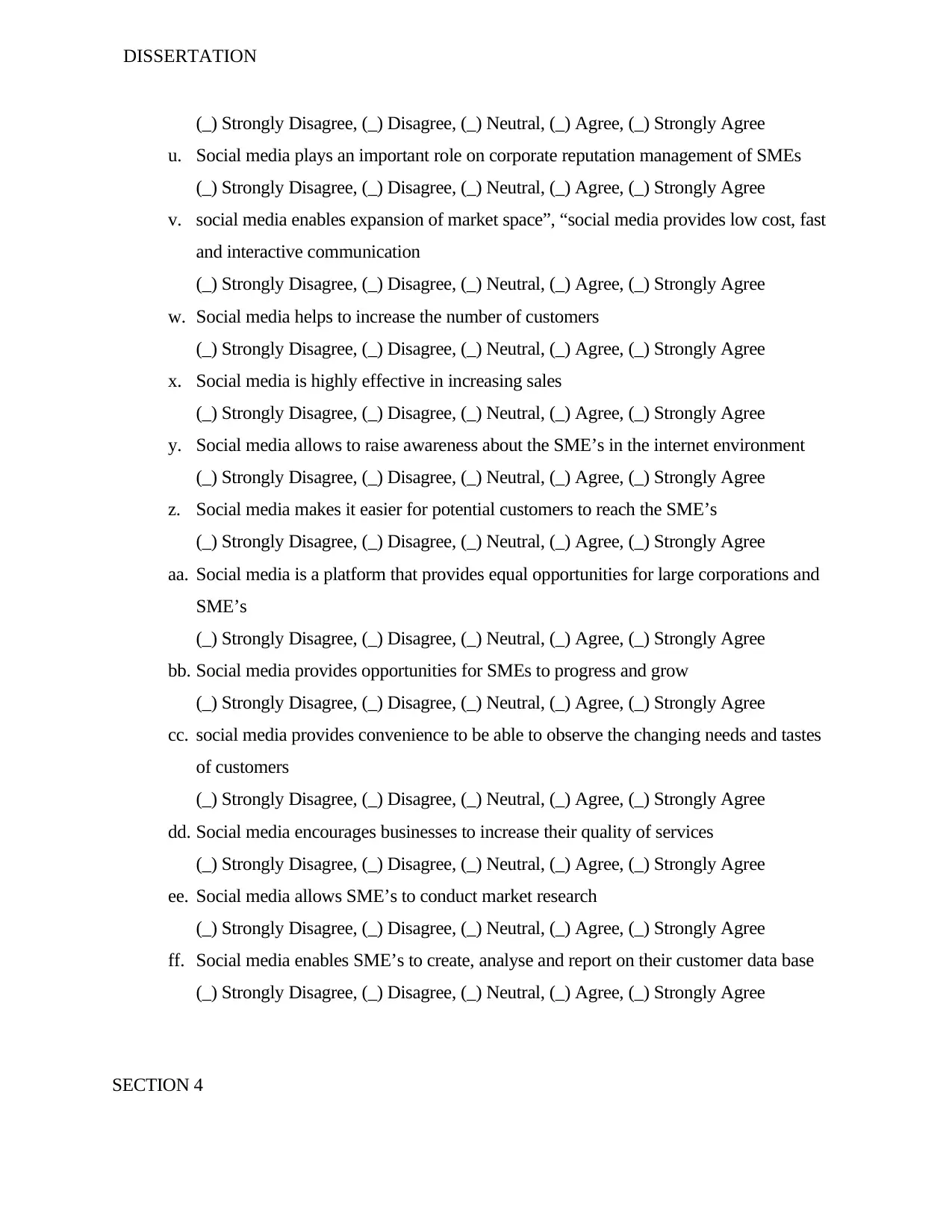
DISSERTATION
(_) Strongly Disagree, (_) Disagree, (_) Neutral, (_) Agree, (_) Strongly Agree
u. Social media plays an important role on corporate reputation management of SMEs
(_) Strongly Disagree, (_) Disagree, (_) Neutral, (_) Agree, (_) Strongly Agree
v. social media enables expansion of market space”, “social media provides low cost, fast
and interactive communication
(_) Strongly Disagree, (_) Disagree, (_) Neutral, (_) Agree, (_) Strongly Agree
w. Social media helps to increase the number of customers
(_) Strongly Disagree, (_) Disagree, (_) Neutral, (_) Agree, (_) Strongly Agree
x. Social media is highly effective in increasing sales
(_) Strongly Disagree, (_) Disagree, (_) Neutral, (_) Agree, (_) Strongly Agree
y. Social media allows to raise awareness about the SME’s in the internet environment
(_) Strongly Disagree, (_) Disagree, (_) Neutral, (_) Agree, (_) Strongly Agree
z. Social media makes it easier for potential customers to reach the SME’s
(_) Strongly Disagree, (_) Disagree, (_) Neutral, (_) Agree, (_) Strongly Agree
aa. Social media is a platform that provides equal opportunities for large corporations and
SME’s
(_) Strongly Disagree, (_) Disagree, (_) Neutral, (_) Agree, (_) Strongly Agree
bb. Social media provides opportunities for SMEs to progress and grow
(_) Strongly Disagree, (_) Disagree, (_) Neutral, (_) Agree, (_) Strongly Agree
cc. social media provides convenience to be able to observe the changing needs and tastes
of customers
(_) Strongly Disagree, (_) Disagree, (_) Neutral, (_) Agree, (_) Strongly Agree
dd. Social media encourages businesses to increase their quality of services
(_) Strongly Disagree, (_) Disagree, (_) Neutral, (_) Agree, (_) Strongly Agree
ee. Social media allows SME’s to conduct market research
(_) Strongly Disagree, (_) Disagree, (_) Neutral, (_) Agree, (_) Strongly Agree
ff. Social media enables SME’s to create, analyse and report on their customer data base
(_) Strongly Disagree, (_) Disagree, (_) Neutral, (_) Agree, (_) Strongly Agree
SECTION 4
(_) Strongly Disagree, (_) Disagree, (_) Neutral, (_) Agree, (_) Strongly Agree
u. Social media plays an important role on corporate reputation management of SMEs
(_) Strongly Disagree, (_) Disagree, (_) Neutral, (_) Agree, (_) Strongly Agree
v. social media enables expansion of market space”, “social media provides low cost, fast
and interactive communication
(_) Strongly Disagree, (_) Disagree, (_) Neutral, (_) Agree, (_) Strongly Agree
w. Social media helps to increase the number of customers
(_) Strongly Disagree, (_) Disagree, (_) Neutral, (_) Agree, (_) Strongly Agree
x. Social media is highly effective in increasing sales
(_) Strongly Disagree, (_) Disagree, (_) Neutral, (_) Agree, (_) Strongly Agree
y. Social media allows to raise awareness about the SME’s in the internet environment
(_) Strongly Disagree, (_) Disagree, (_) Neutral, (_) Agree, (_) Strongly Agree
z. Social media makes it easier for potential customers to reach the SME’s
(_) Strongly Disagree, (_) Disagree, (_) Neutral, (_) Agree, (_) Strongly Agree
aa. Social media is a platform that provides equal opportunities for large corporations and
SME’s
(_) Strongly Disagree, (_) Disagree, (_) Neutral, (_) Agree, (_) Strongly Agree
bb. Social media provides opportunities for SMEs to progress and grow
(_) Strongly Disagree, (_) Disagree, (_) Neutral, (_) Agree, (_) Strongly Agree
cc. social media provides convenience to be able to observe the changing needs and tastes
of customers
(_) Strongly Disagree, (_) Disagree, (_) Neutral, (_) Agree, (_) Strongly Agree
dd. Social media encourages businesses to increase their quality of services
(_) Strongly Disagree, (_) Disagree, (_) Neutral, (_) Agree, (_) Strongly Agree
ee. Social media allows SME’s to conduct market research
(_) Strongly Disagree, (_) Disagree, (_) Neutral, (_) Agree, (_) Strongly Agree
ff. Social media enables SME’s to create, analyse and report on their customer data base
(_) Strongly Disagree, (_) Disagree, (_) Neutral, (_) Agree, (_) Strongly Agree
SECTION 4

DISSERTATION
1. Age (Tick Where Appropriate)
(_) 18 – 24
(_) 25 – 34
(_) 35 – 44
(_) 45 – 54
(_) 55 – 64
(_) 65 and over
2. Gender (Tick Where Appropriate)
(_) Male
(_) Female
3. Education Level (Tick Where Appropriate)
(_) High School Degree
(_) Associate Degree
(_) Undergraduate Degree
(_) Graduate Degree
4. What is your job title? ………………………………………………….
5. How long have you worked in your current position? ………………….
1. Age (Tick Where Appropriate)
(_) 18 – 24
(_) 25 – 34
(_) 35 – 44
(_) 45 – 54
(_) 55 – 64
(_) 65 and over
2. Gender (Tick Where Appropriate)
(_) Male
(_) Female
3. Education Level (Tick Where Appropriate)
(_) High School Degree
(_) Associate Degree
(_) Undergraduate Degree
(_) Graduate Degree
4. What is your job title? ………………………………………………….
5. How long have you worked in your current position? ………………….
Paraphrase This Document
Need a fresh take? Get an instant paraphrase of this document with our AI Paraphraser
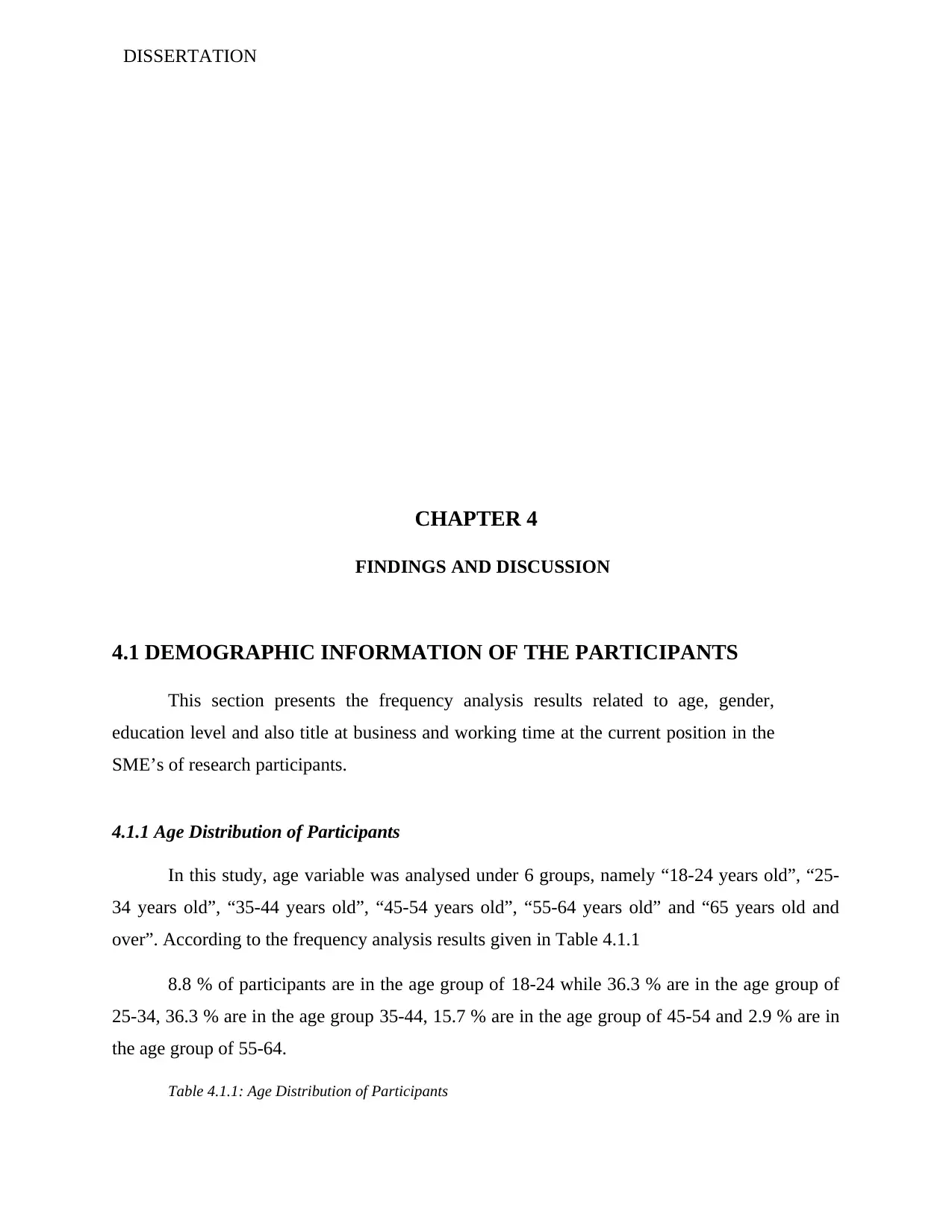
DISSERTATION
CHAPTER 4
FINDINGS AND DISCUSSION
4.1 DEMOGRAPHIC INFORMATION OF THE PARTICIPANTS
This section presents the frequency analysis results related to age, gender,
education level and also title at business and working time at the current position in the
SME’s of research participants.
4.1.1 Age Distribution of Participants
In this study, age variable was analysed under 6 groups, namely “18-24 years old”, “25-
34 years old”, “35-44 years old”, “45-54 years old”, “55-64 years old” and “65 years old and
over”. According to the frequency analysis results given in Table 4.1.1
8.8 % of participants are in the age group of 18-24 while 36.3 % are in the age group of
25-34, 36.3 % are in the age group 35-44, 15.7 % are in the age group of 45-54 and 2.9 % are in
the age group of 55-64.
Table 4.1.1: Age Distribution of Participants
CHAPTER 4
FINDINGS AND DISCUSSION
4.1 DEMOGRAPHIC INFORMATION OF THE PARTICIPANTS
This section presents the frequency analysis results related to age, gender,
education level and also title at business and working time at the current position in the
SME’s of research participants.
4.1.1 Age Distribution of Participants
In this study, age variable was analysed under 6 groups, namely “18-24 years old”, “25-
34 years old”, “35-44 years old”, “45-54 years old”, “55-64 years old” and “65 years old and
over”. According to the frequency analysis results given in Table 4.1.1
8.8 % of participants are in the age group of 18-24 while 36.3 % are in the age group of
25-34, 36.3 % are in the age group 35-44, 15.7 % are in the age group of 45-54 and 2.9 % are in
the age group of 55-64.
Table 4.1.1: Age Distribution of Participants
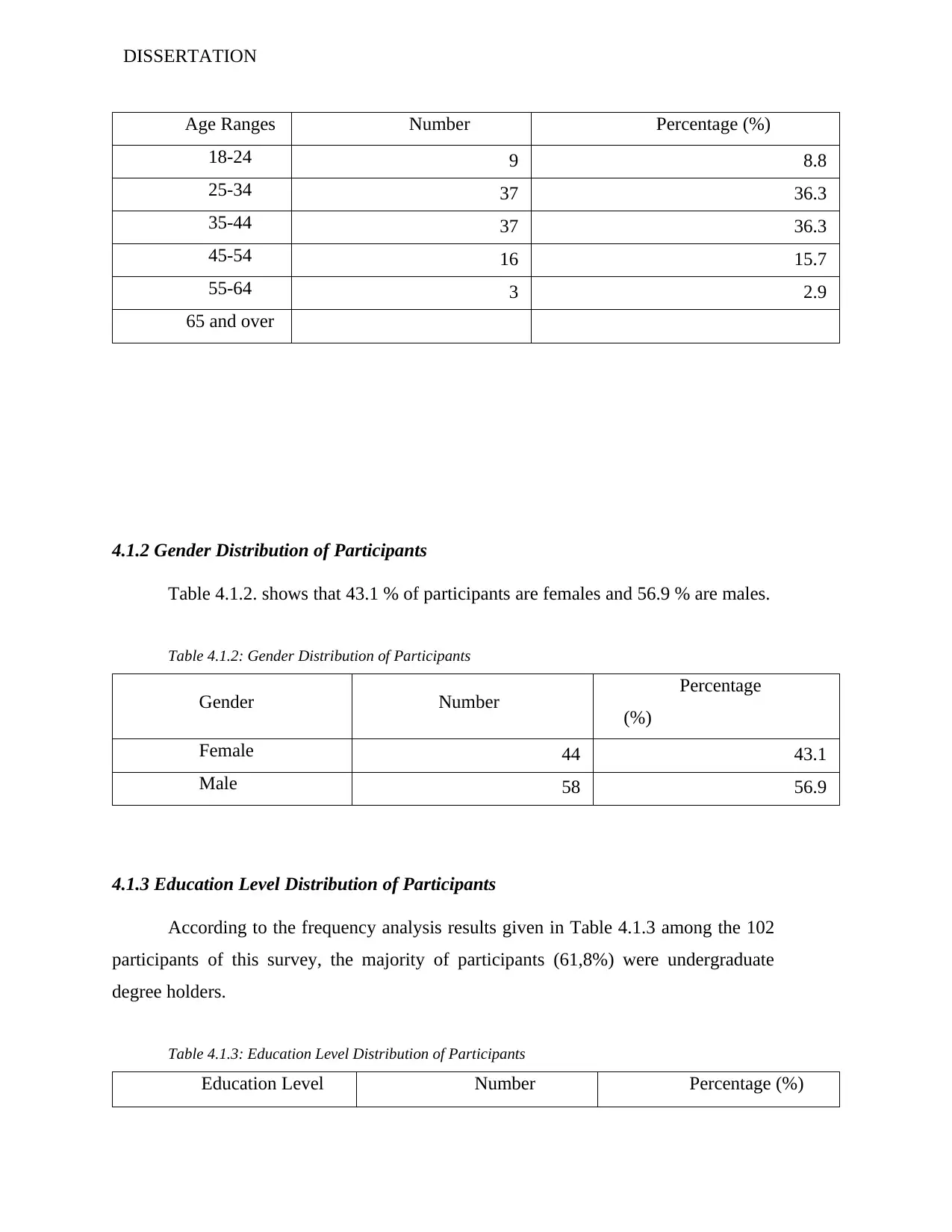
DISSERTATION
Age Ranges Number Percentage (%)
18-24 9 8.8
25-34 37 36.3
35-44 37 36.3
45-54 16 15.7
55-64 3 2.9
65 and over
4.1.2 Gender Distribution of Participants
Table 4.1.2. shows that 43.1 % of participants are females and 56.9 % are males.
Table 4.1.2: Gender Distribution of Participants
Gender Number Percentage
(%)
Female 44 43.1
Male 58 56.9
4.1.3 Education Level Distribution of Participants
According to the frequency analysis results given in Table 4.1.3 among the 102
participants of this survey, the majority of participants (61,8%) were undergraduate
degree holders.
Table 4.1.3: Education Level Distribution of Participants
Education Level Number Percentage (%)
Age Ranges Number Percentage (%)
18-24 9 8.8
25-34 37 36.3
35-44 37 36.3
45-54 16 15.7
55-64 3 2.9
65 and over
4.1.2 Gender Distribution of Participants
Table 4.1.2. shows that 43.1 % of participants are females and 56.9 % are males.
Table 4.1.2: Gender Distribution of Participants
Gender Number Percentage
(%)
Female 44 43.1
Male 58 56.9
4.1.3 Education Level Distribution of Participants
According to the frequency analysis results given in Table 4.1.3 among the 102
participants of this survey, the majority of participants (61,8%) were undergraduate
degree holders.
Table 4.1.3: Education Level Distribution of Participants
Education Level Number Percentage (%)
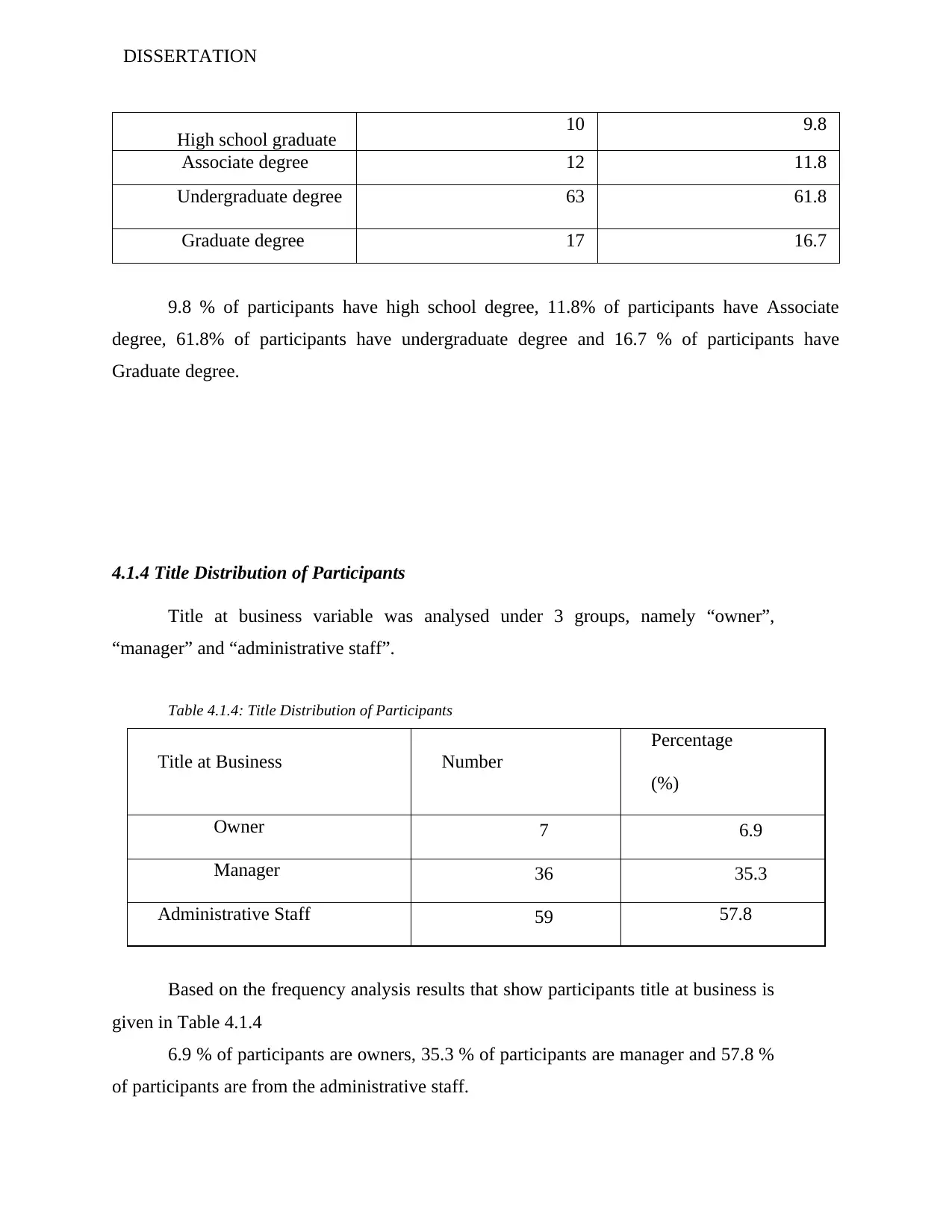
DISSERTATION
High school graduate 10 9.8
Associate degree 12 11.8
Undergraduate degree 63 61.8
Graduate degree 17 16.7
9.8 % of participants have high school degree, 11.8% of participants have Associate
degree, 61.8% of participants have undergraduate degree and 16.7 % of participants have
Graduate degree.
4.1.4 Title Distribution of Participants
Title at business variable was analysed under 3 groups, namely “owner”,
“manager” and “administrative staff”.
Table 4.1.4: Title Distribution of Participants
Title at Business Number
Percentage
(%)
Owner 7 6.9
Manager 36 35.3
Administrative Staff 59 57.8
Based on the frequency analysis results that show participants title at business is
given in Table 4.1.4
6.9 % of participants are owners, 35.3 % of participants are manager and 57.8 %
of participants are from the administrative staff.
High school graduate 10 9.8
Associate degree 12 11.8
Undergraduate degree 63 61.8
Graduate degree 17 16.7
9.8 % of participants have high school degree, 11.8% of participants have Associate
degree, 61.8% of participants have undergraduate degree and 16.7 % of participants have
Graduate degree.
4.1.4 Title Distribution of Participants
Title at business variable was analysed under 3 groups, namely “owner”,
“manager” and “administrative staff”.
Table 4.1.4: Title Distribution of Participants
Title at Business Number
Percentage
(%)
Owner 7 6.9
Manager 36 35.3
Administrative Staff 59 57.8
Based on the frequency analysis results that show participants title at business is
given in Table 4.1.4
6.9 % of participants are owners, 35.3 % of participants are manager and 57.8 %
of participants are from the administrative staff.
Secure Best Marks with AI Grader
Need help grading? Try our AI Grader for instant feedback on your assignments.
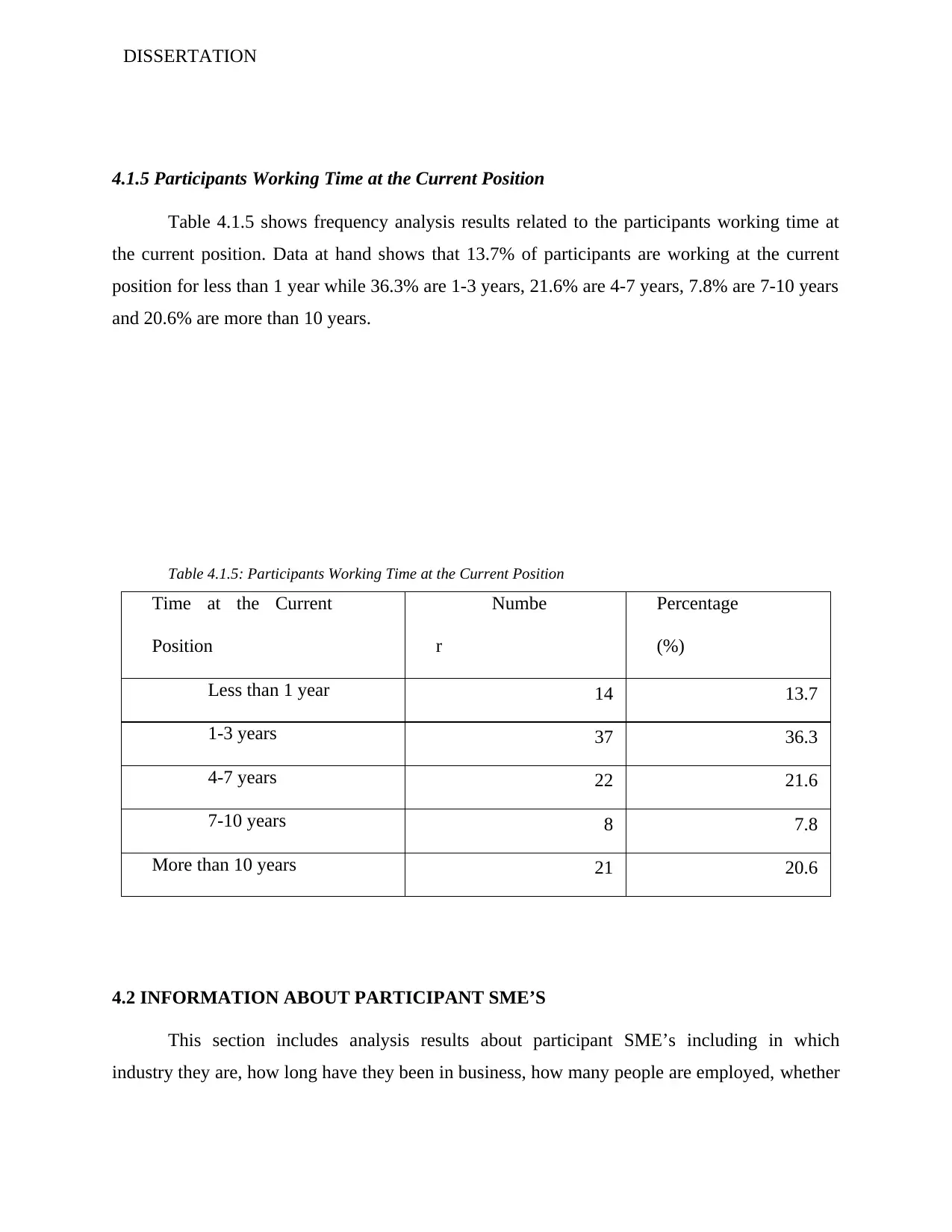
DISSERTATION
4.1.5 Participants Working Time at the Current Position
Table 4.1.5 shows frequency analysis results related to the participants working time at
the current position. Data at hand shows that 13.7% of participants are working at the current
position for less than 1 year while 36.3% are 1-3 years, 21.6% are 4-7 years, 7.8% are 7-10 years
and 20.6% are more than 10 years.
Table 4.1.5: Participants Working Time at the Current Position
Time at the Current
Position
Numbe
r
Percentage
(%)
Less than 1 year 14 13.7
1-3 years 37 36.3
4-7 years 22 21.6
7-10 years 8 7.8
More than 10 years 21 20.6
4.2 INFORMATION ABOUT PARTICIPANT SME’S
This section includes analysis results about participant SME’s including in which
industry they are, how long have they been in business, how many people are employed, whether
4.1.5 Participants Working Time at the Current Position
Table 4.1.5 shows frequency analysis results related to the participants working time at
the current position. Data at hand shows that 13.7% of participants are working at the current
position for less than 1 year while 36.3% are 1-3 years, 21.6% are 4-7 years, 7.8% are 7-10 years
and 20.6% are more than 10 years.
Table 4.1.5: Participants Working Time at the Current Position
Time at the Current
Position
Numbe
r
Percentage
(%)
Less than 1 year 14 13.7
1-3 years 37 36.3
4-7 years 22 21.6
7-10 years 8 7.8
More than 10 years 21 20.6
4.2 INFORMATION ABOUT PARTICIPANT SME’S
This section includes analysis results about participant SME’s including in which
industry they are, how long have they been in business, how many people are employed, whether
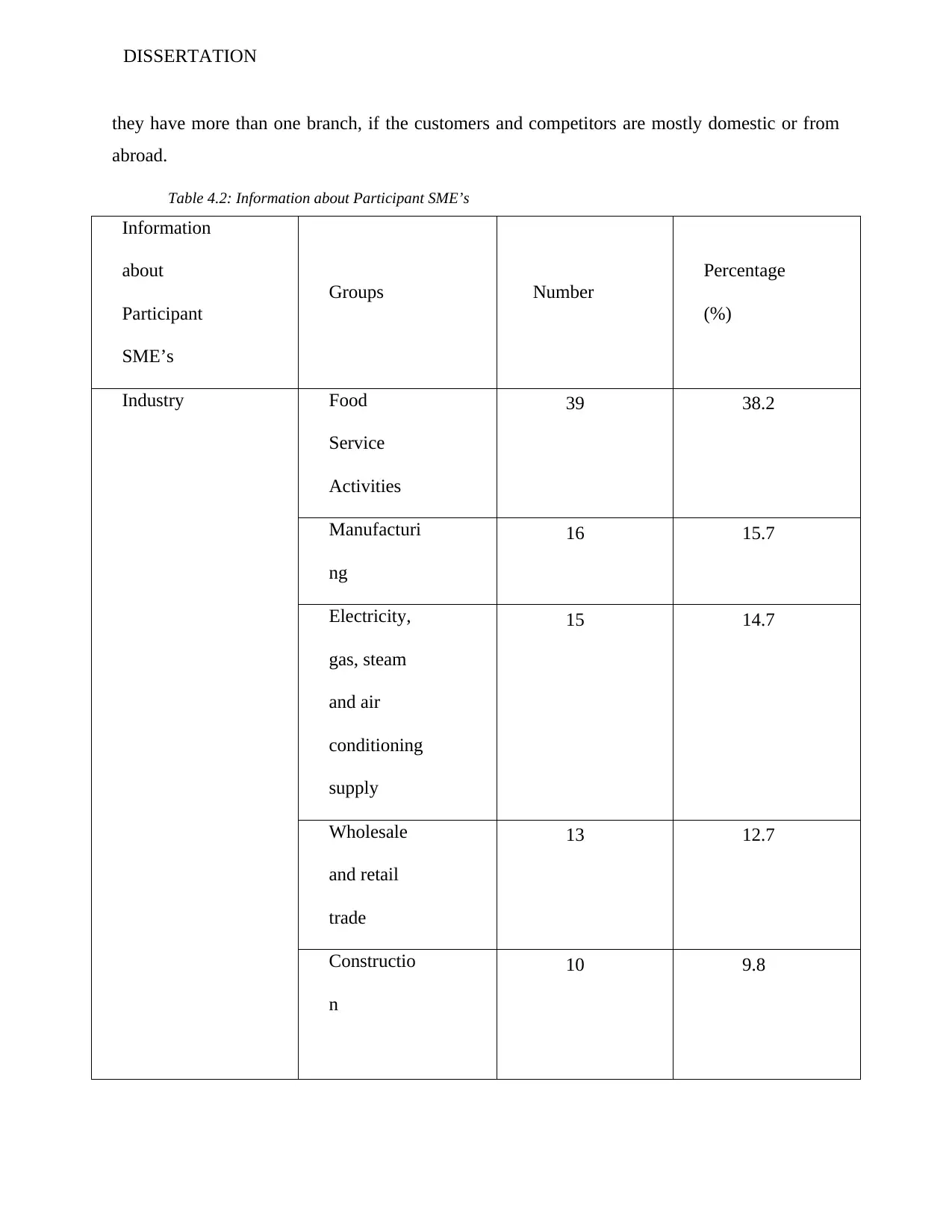
DISSERTATION
they have more than one branch, if the customers and competitors are mostly domestic or from
abroad.
Table 4.2: Information about Participant SME’s
Information
about
Participant
SME’s
Groups Number
Percentage
(%)
Industry Food
Service
Activities
39 38.2
Manufacturi
ng
16 15.7
Electricity,
gas, steam
and air
conditioning
supply
15 14.7
Wholesale
and retail
trade
13 12.7
Constructio
n
10 9.8
they have more than one branch, if the customers and competitors are mostly domestic or from
abroad.
Table 4.2: Information about Participant SME’s
Information
about
Participant
SME’s
Groups Number
Percentage
(%)
Industry Food
Service
Activities
39 38.2
Manufacturi
ng
16 15.7
Electricity,
gas, steam
and air
conditioning
supply
15 14.7
Wholesale
and retail
trade
13 12.7
Constructio
n
10 9.8
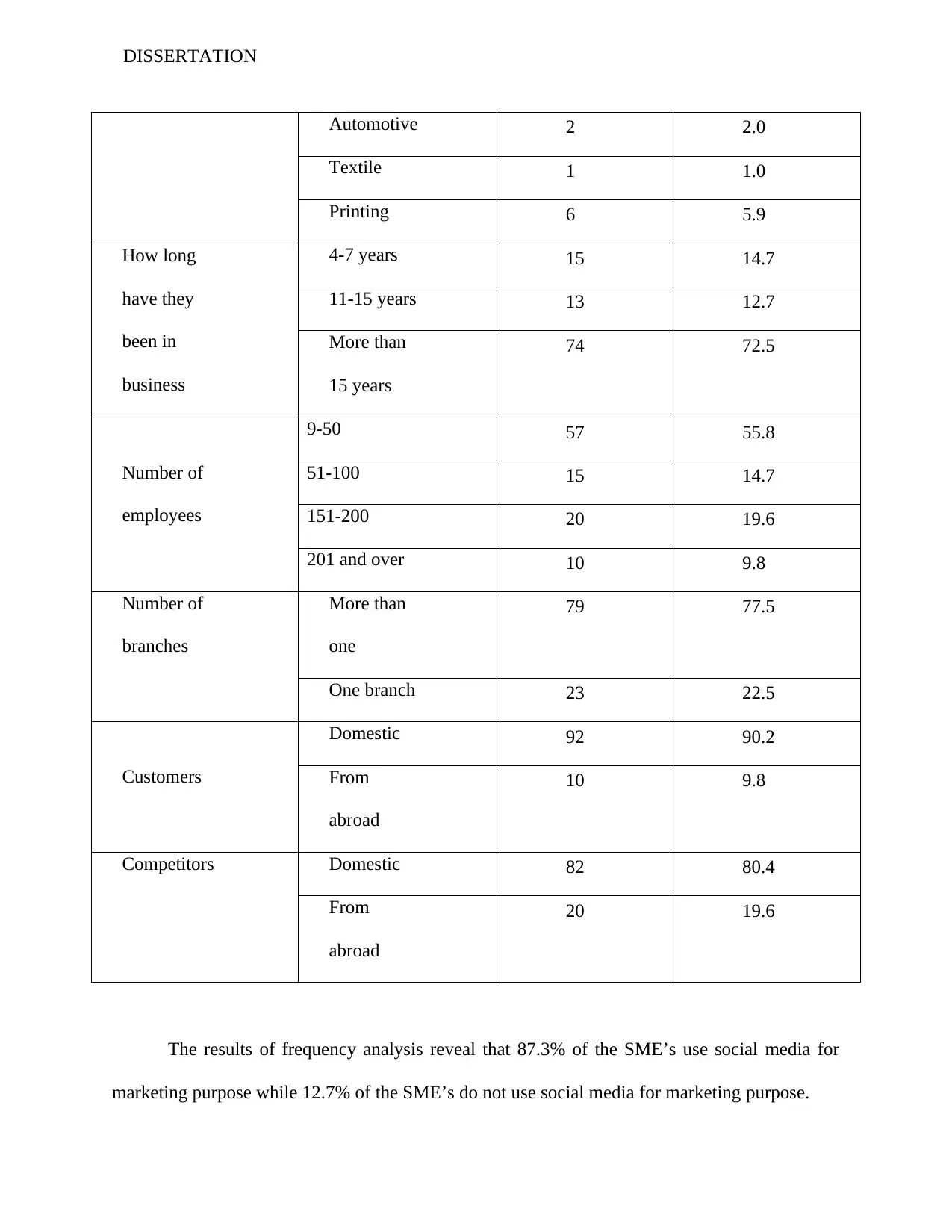
DISSERTATION
Automotive 2 2.0
Textile 1 1.0
Printing 6 5.9
How long
have they
been in
business
4-7 years 15 14.7
11-15 years 13 12.7
More than
15 years
74 72.5
Number of
employees
9-50 57 55.8
51-100 15 14.7
151-200 20 19.6
201 and over 10 9.8
Number of
branches
More than
one
79 77.5
One branch 23 22.5
Customers
Domestic 92 90.2
From
abroad
10 9.8
Competitors Domestic 82 80.4
From
abroad
20 19.6
The results of frequency analysis reveal that 87.3% of the SME’s use social media for
marketing purpose while 12.7% of the SME’s do not use social media for marketing purpose.
Automotive 2 2.0
Textile 1 1.0
Printing 6 5.9
How long
have they
been in
business
4-7 years 15 14.7
11-15 years 13 12.7
More than
15 years
74 72.5
Number of
employees
9-50 57 55.8
51-100 15 14.7
151-200 20 19.6
201 and over 10 9.8
Number of
branches
More than
one
79 77.5
One branch 23 22.5
Customers
Domestic 92 90.2
From
abroad
10 9.8
Competitors Domestic 82 80.4
From
abroad
20 19.6
The results of frequency analysis reveal that 87.3% of the SME’s use social media for
marketing purpose while 12.7% of the SME’s do not use social media for marketing purpose.
Paraphrase This Document
Need a fresh take? Get an instant paraphrase of this document with our AI Paraphraser
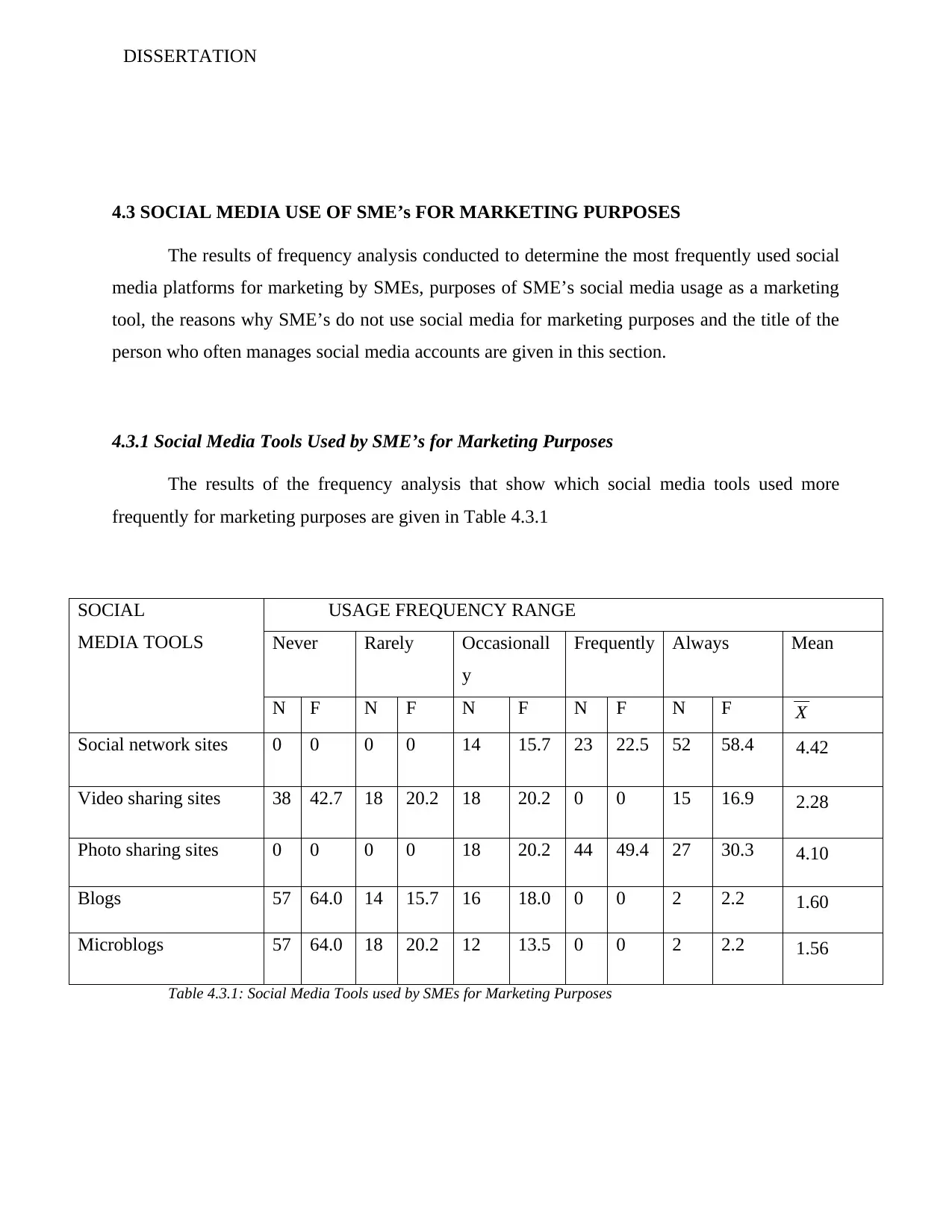
DISSERTATION
4.3 SOCIAL MEDIA USE OF SME’s FOR MARKETING PURPOSES
The results of frequency analysis conducted to determine the most frequently used social
media platforms for marketing by SMEs, purposes of SME’s social media usage as a marketing
tool, the reasons why SME’s do not use social media for marketing purposes and the title of the
person who often manages social media accounts are given in this section.
4.3.1 Social Media Tools Used by SME’s for Marketing Purposes
The results of the frequency analysis that show which social media tools used more
frequently for marketing purposes are given in Table 4.3.1
SOCIAL
MEDIA TOOLS
USAGE FREQUENCY RANGE
Never Rarely Occasionall
y
Frequently Always Mean
N F N F N F N F N F X
Social network sites 0 0 0 0 14 15.7 23 22.5 52 58.4 4.42
Video sharing sites 38 42.7 18 20.2 18 20.2 0 0 15 16.9 2.28
Photo sharing sites 0 0 0 0 18 20.2 44 49.4 27 30.3 4.10
Blogs 57 64.0 14 15.7 16 18.0 0 0 2 2.2 1.60
Microblogs 57 64.0 18 20.2 12 13.5 0 0 2 2.2 1.56
Table 4.3.1: Social Media Tools used by SMEs for Marketing Purposes
4.3 SOCIAL MEDIA USE OF SME’s FOR MARKETING PURPOSES
The results of frequency analysis conducted to determine the most frequently used social
media platforms for marketing by SMEs, purposes of SME’s social media usage as a marketing
tool, the reasons why SME’s do not use social media for marketing purposes and the title of the
person who often manages social media accounts are given in this section.
4.3.1 Social Media Tools Used by SME’s for Marketing Purposes
The results of the frequency analysis that show which social media tools used more
frequently for marketing purposes are given in Table 4.3.1
SOCIAL
MEDIA TOOLS
USAGE FREQUENCY RANGE
Never Rarely Occasionall
y
Frequently Always Mean
N F N F N F N F N F X
Social network sites 0 0 0 0 14 15.7 23 22.5 52 58.4 4.42
Video sharing sites 38 42.7 18 20.2 18 20.2 0 0 15 16.9 2.28
Photo sharing sites 0 0 0 0 18 20.2 44 49.4 27 30.3 4.10
Blogs 57 64.0 14 15.7 16 18.0 0 0 2 2.2 1.60
Microblogs 57 64.0 18 20.2 12 13.5 0 0 2 2.2 1.56
Table 4.3.1: Social Media Tools used by SMEs for Marketing Purposes
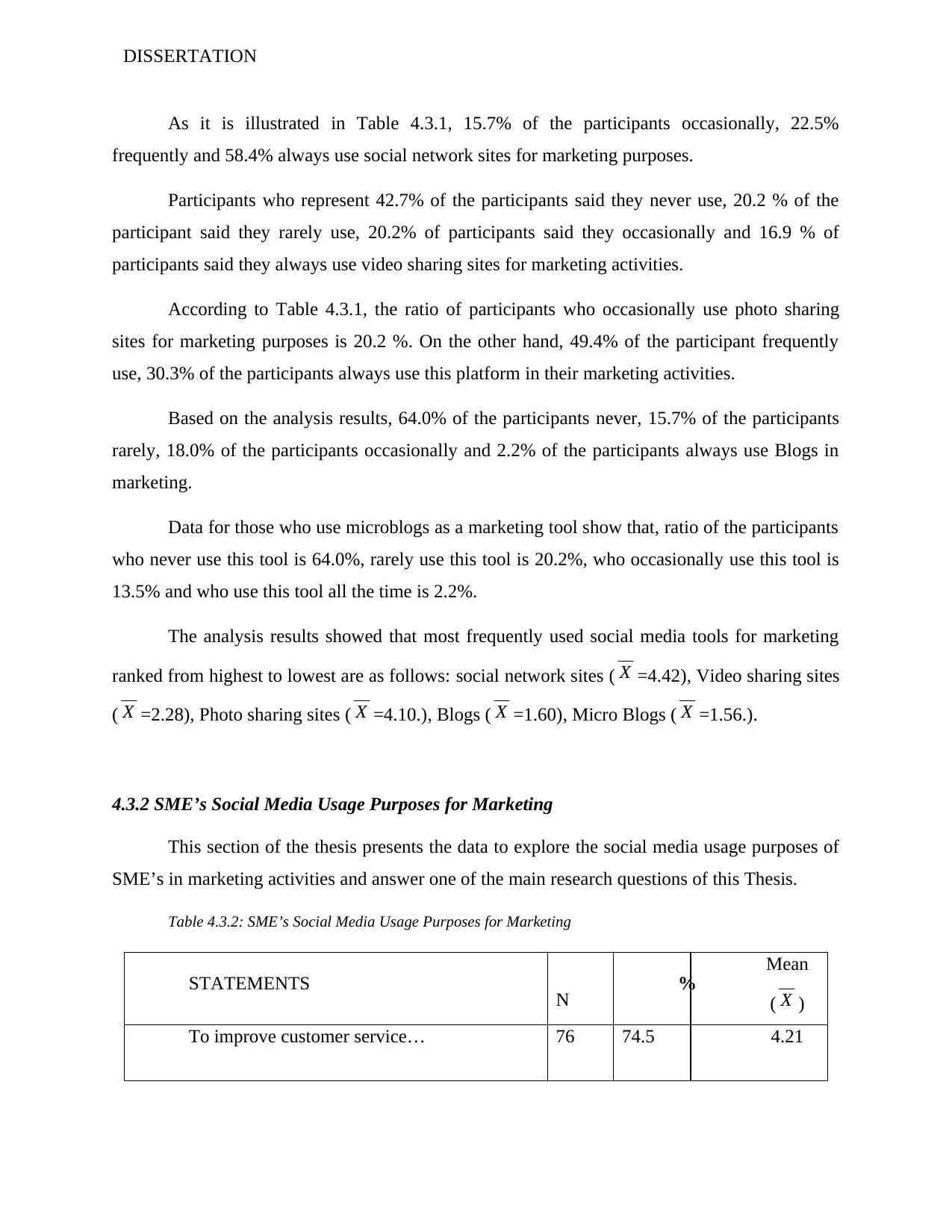
DISSERTATION
As it is illustrated in Table 4.3.1, 15.7% of the participants occasionally, 22.5%
frequently and 58.4% always use social network sites for marketing purposes.
Participants who represent 42.7% of the participants said they never use, 20.2 % of the
participant said they rarely use, 20.2% of participants said they occasionally and 16.9 % of
participants said they always use video sharing sites for marketing activities.
According to Table 4.3.1, the ratio of participants who occasionally use photo sharing
sites for marketing purposes is 20.2 %. On the other hand, 49.4% of the participant frequently
use, 30.3% of the participants always use this platform in their marketing activities.
Based on the analysis results, 64.0% of the participants never, 15.7% of the participants
rarely, 18.0% of the participants occasionally and 2.2% of the participants always use Blogs in
marketing.
Data for those who use microblogs as a marketing tool show that, ratio of the participants
who never use this tool is 64.0%, rarely use this tool is 20.2%, who occasionally use this tool is
13.5% and who use this tool all the time is 2.2%.
The analysis results showed that most frequently used social media tools for marketing
ranked from highest to lowest are as follows: social network sites ( X =4.42), Video sharing sites
( X =2.28), Photo sharing sites ( X =4.10.), Blogs ( X =1.60), Micro Blogs ( X =1.56.).
4.3.2 SME’s Social Media Usage Purposes for Marketing
This section of the thesis presents the data to explore the social media usage purposes of
SME’s in marketing activities and answer one of the main research questions of this Thesis.
Table 4.3.2: SME’s Social Media Usage Purposes for Marketing
STATEMENTS N %
Mean
( X )
To improve customer service… 76 74.5 4.21
As it is illustrated in Table 4.3.1, 15.7% of the participants occasionally, 22.5%
frequently and 58.4% always use social network sites for marketing purposes.
Participants who represent 42.7% of the participants said they never use, 20.2 % of the
participant said they rarely use, 20.2% of participants said they occasionally and 16.9 % of
participants said they always use video sharing sites for marketing activities.
According to Table 4.3.1, the ratio of participants who occasionally use photo sharing
sites for marketing purposes is 20.2 %. On the other hand, 49.4% of the participant frequently
use, 30.3% of the participants always use this platform in their marketing activities.
Based on the analysis results, 64.0% of the participants never, 15.7% of the participants
rarely, 18.0% of the participants occasionally and 2.2% of the participants always use Blogs in
marketing.
Data for those who use microblogs as a marketing tool show that, ratio of the participants
who never use this tool is 64.0%, rarely use this tool is 20.2%, who occasionally use this tool is
13.5% and who use this tool all the time is 2.2%.
The analysis results showed that most frequently used social media tools for marketing
ranked from highest to lowest are as follows: social network sites ( X =4.42), Video sharing sites
( X =2.28), Photo sharing sites ( X =4.10.), Blogs ( X =1.60), Micro Blogs ( X =1.56.).
4.3.2 SME’s Social Media Usage Purposes for Marketing
This section of the thesis presents the data to explore the social media usage purposes of
SME’s in marketing activities and answer one of the main research questions of this Thesis.
Table 4.3.2: SME’s Social Media Usage Purposes for Marketing
STATEMENTS N %
Mean
( X )
To improve customer service… 76 74.5 4.21
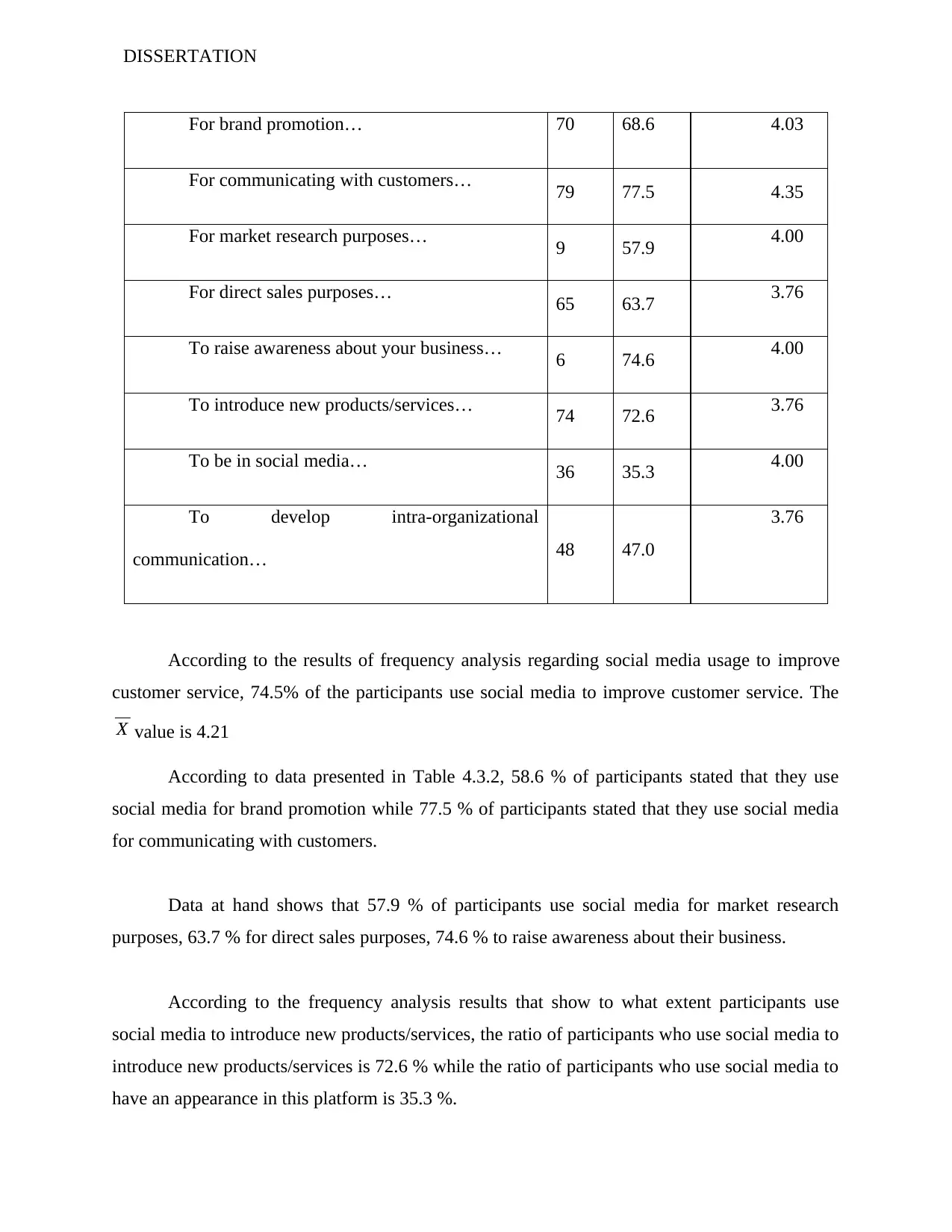
DISSERTATION
For brand promotion… 70 68.6 4.03
For communicating with customers… 79 77.5 4.35
For market research purposes… 9 57.9 4.00
For direct sales purposes… 65 63.7 3.76
To raise awareness about your business… 6 74.6 4.00
To introduce new products/services… 74 72.6 3.76
To be in social media… 36 35.3 4.00
To develop intra-organizational
communication… 48 47.0
3.76
According to the results of frequency analysis regarding social media usage to improve
customer service, 74.5% of the participants use social media to improve customer service. The
X value is 4.21
According to data presented in Table 4.3.2, 58.6 % of participants stated that they use
social media for brand promotion while 77.5 % of participants stated that they use social media
for communicating with customers.
Data at hand shows that 57.9 % of participants use social media for market research
purposes, 63.7 % for direct sales purposes, 74.6 % to raise awareness about their business.
According to the frequency analysis results that show to what extent participants use
social media to introduce new products/services, the ratio of participants who use social media to
introduce new products/services is 72.6 % while the ratio of participants who use social media to
have an appearance in this platform is 35.3 %.
For brand promotion… 70 68.6 4.03
For communicating with customers… 79 77.5 4.35
For market research purposes… 9 57.9 4.00
For direct sales purposes… 65 63.7 3.76
To raise awareness about your business… 6 74.6 4.00
To introduce new products/services… 74 72.6 3.76
To be in social media… 36 35.3 4.00
To develop intra-organizational
communication… 48 47.0
3.76
According to the results of frequency analysis regarding social media usage to improve
customer service, 74.5% of the participants use social media to improve customer service. The
X value is 4.21
According to data presented in Table 4.3.2, 58.6 % of participants stated that they use
social media for brand promotion while 77.5 % of participants stated that they use social media
for communicating with customers.
Data at hand shows that 57.9 % of participants use social media for market research
purposes, 63.7 % for direct sales purposes, 74.6 % to raise awareness about their business.
According to the frequency analysis results that show to what extent participants use
social media to introduce new products/services, the ratio of participants who use social media to
introduce new products/services is 72.6 % while the ratio of participants who use social media to
have an appearance in this platform is 35.3 %.
Secure Best Marks with AI Grader
Need help grading? Try our AI Grader for instant feedback on your assignments.
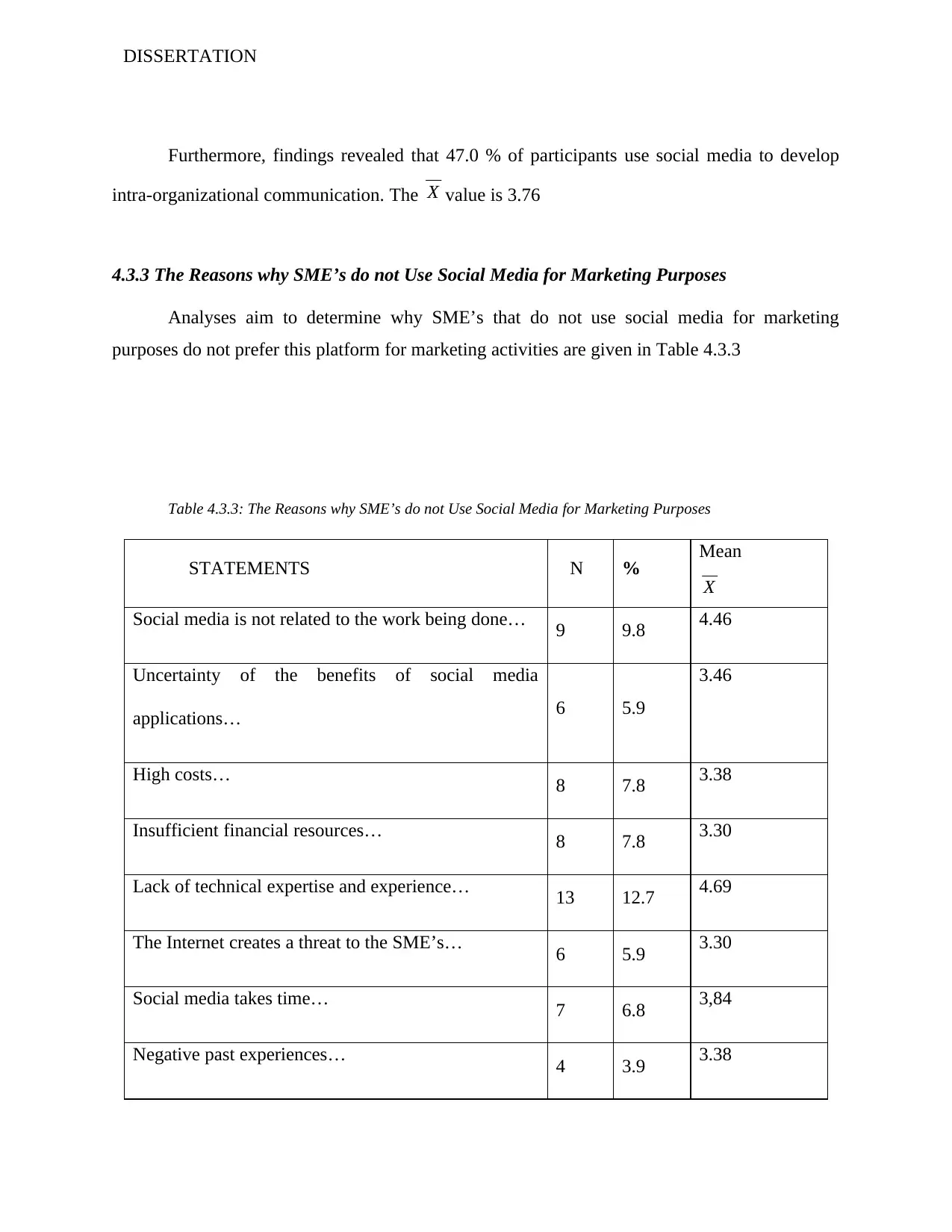
DISSERTATION
Furthermore, findings revealed that 47.0 % of participants use social media to develop
intra-organizational communication. The X value is 3.76
4.3.3 The Reasons why SME’s do not Use Social Media for Marketing Purposes
Analyses aim to determine why SME’s that do not use social media for marketing
purposes do not prefer this platform for marketing activities are given in Table 4.3.3
Table 4.3.3: The Reasons why SME’s do not Use Social Media for Marketing Purposes
STATEMENTS N % Mean
X
Social media is not related to the work being done… 9 9.8 4.46
Uncertainty of the benefits of social media
applications… 6 5.9
3.46
High costs… 8 7.8 3.38
Insufficient financial resources… 8 7.8 3.30
Lack of technical expertise and experience… 13 12.7 4.69
The Internet creates a threat to the SME’s… 6 5.9 3.30
Social media takes time… 7 6.8 3,84
Negative past experiences… 4 3.9 3.38
Furthermore, findings revealed that 47.0 % of participants use social media to develop
intra-organizational communication. The X value is 3.76
4.3.3 The Reasons why SME’s do not Use Social Media for Marketing Purposes
Analyses aim to determine why SME’s that do not use social media for marketing
purposes do not prefer this platform for marketing activities are given in Table 4.3.3
Table 4.3.3: The Reasons why SME’s do not Use Social Media for Marketing Purposes
STATEMENTS N % Mean
X
Social media is not related to the work being done… 9 9.8 4.46
Uncertainty of the benefits of social media
applications… 6 5.9
3.46
High costs… 8 7.8 3.38
Insufficient financial resources… 8 7.8 3.30
Lack of technical expertise and experience… 13 12.7 4.69
The Internet creates a threat to the SME’s… 6 5.9 3.30
Social media takes time… 7 6.8 3,84
Negative past experiences… 4 3.9 3.38
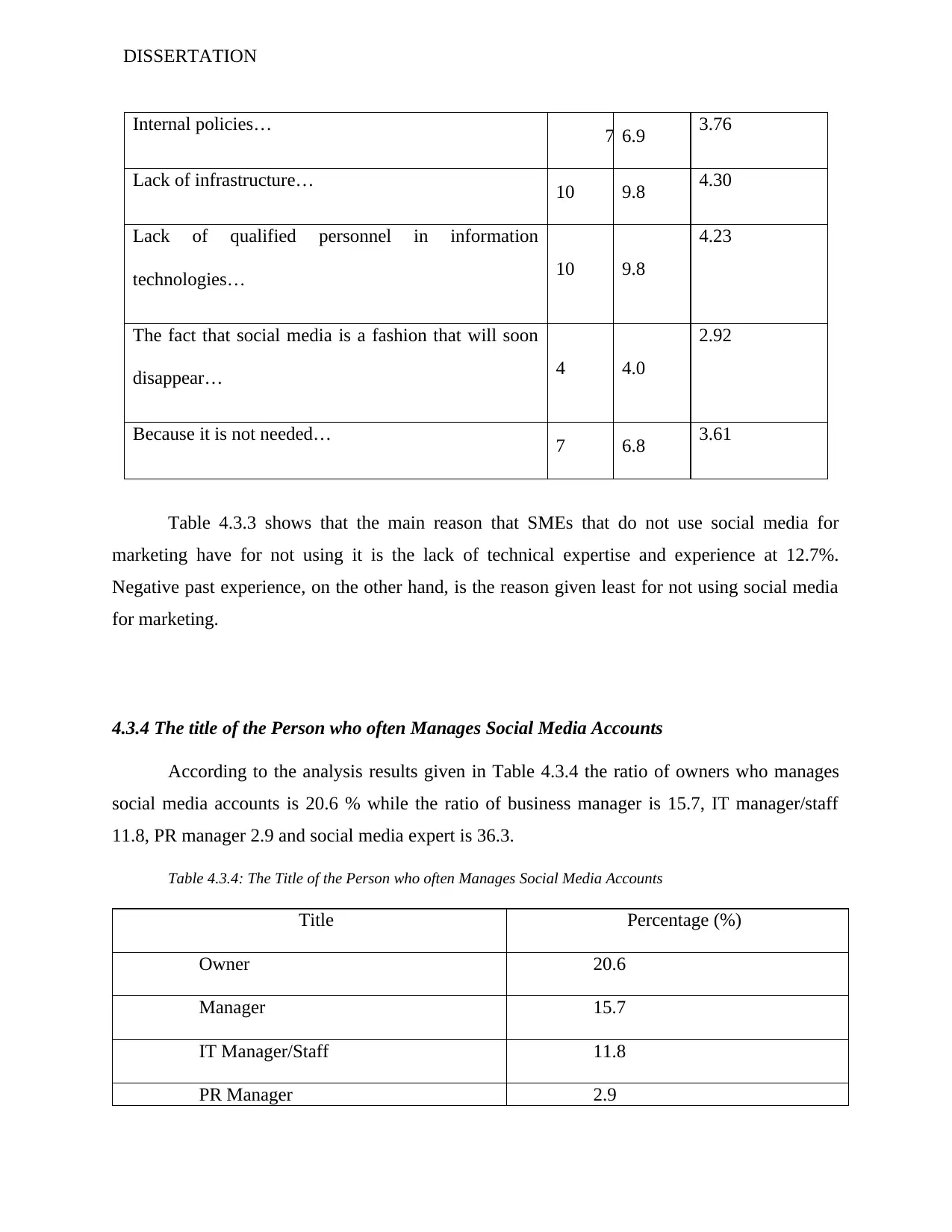
DISSERTATION
Internal policies… 7 6.9 3.76
Lack of infrastructure… 10 9.8 4.30
Lack of qualified personnel in information
technologies… 10 9.8
4.23
The fact that social media is a fashion that will soon
disappear… 4 4.0
2.92
Because it is not needed… 7 6.8 3.61
Table 4.3.3 shows that the main reason that SMEs that do not use social media for
marketing have for not using it is the lack of technical expertise and experience at 12.7%.
Negative past experience, on the other hand, is the reason given least for not using social media
for marketing.
4.3.4 The title of the Person who often Manages Social Media Accounts
According to the analysis results given in Table 4.3.4 the ratio of owners who manages
social media accounts is 20.6 % while the ratio of business manager is 15.7, IT manager/staff
11.8, PR manager 2.9 and social media expert is 36.3.
Table 4.3.4: The Title of the Person who often Manages Social Media Accounts
Title Percentage (%)
Owner 20.6
Manager 15.7
IT Manager/Staff 11.8
PR Manager 2.9
Internal policies… 7 6.9 3.76
Lack of infrastructure… 10 9.8 4.30
Lack of qualified personnel in information
technologies… 10 9.8
4.23
The fact that social media is a fashion that will soon
disappear… 4 4.0
2.92
Because it is not needed… 7 6.8 3.61
Table 4.3.3 shows that the main reason that SMEs that do not use social media for
marketing have for not using it is the lack of technical expertise and experience at 12.7%.
Negative past experience, on the other hand, is the reason given least for not using social media
for marketing.
4.3.4 The title of the Person who often Manages Social Media Accounts
According to the analysis results given in Table 4.3.4 the ratio of owners who manages
social media accounts is 20.6 % while the ratio of business manager is 15.7, IT manager/staff
11.8, PR manager 2.9 and social media expert is 36.3.
Table 4.3.4: The Title of the Person who often Manages Social Media Accounts
Title Percentage (%)
Owner 20.6
Manager 15.7
IT Manager/Staff 11.8
PR Manager 2.9
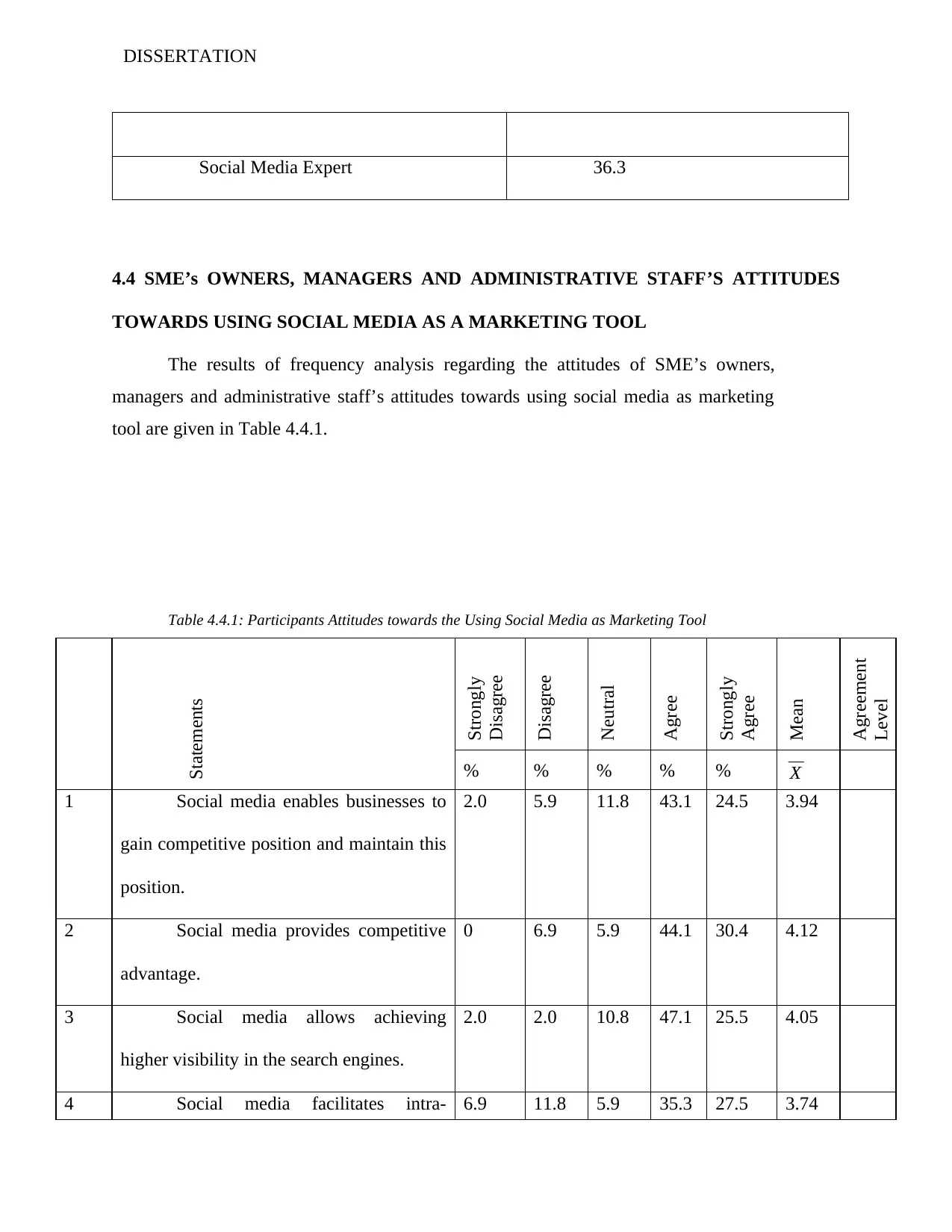
DISSERTATION
Social Media Expert 36.3
4.4 SME’s OWNERS, MANAGERS AND ADMINISTRATIVE STAFF’S ATTITUDES
TOWARDS USING SOCIAL MEDIA AS A MARKETING TOOL
The results of frequency analysis regarding the attitudes of SME’s owners,
managers and administrative staff’s attitudes towards using social media as marketing
tool are given in Table 4.4.1.
Table 4.4.1: Participants Attitudes towards the Using Social Media as Marketing Tool
Statements
Strongly
Disagree
Disagree
Neutral
Agree
Strongly
Agree
Mean
Agreement
Level
% % % % % X
1 Social media enables businesses to
gain competitive position and maintain this
position.
2.0 5.9 11.8 43.1 24.5 3.94
2 Social media provides competitive
advantage.
0 6.9 5.9 44.1 30.4 4.12
3 Social media allows achieving
higher visibility in the search engines.
2.0 2.0 10.8 47.1 25.5 4.05
4 Social media facilitates intra- 6.9 11.8 5.9 35.3 27.5 3.74
Social Media Expert 36.3
4.4 SME’s OWNERS, MANAGERS AND ADMINISTRATIVE STAFF’S ATTITUDES
TOWARDS USING SOCIAL MEDIA AS A MARKETING TOOL
The results of frequency analysis regarding the attitudes of SME’s owners,
managers and administrative staff’s attitudes towards using social media as marketing
tool are given in Table 4.4.1.
Table 4.4.1: Participants Attitudes towards the Using Social Media as Marketing Tool
Statements
Strongly
Disagree
Disagree
Neutral
Agree
Strongly
Agree
Mean
Agreement
Level
% % % % % X
1 Social media enables businesses to
gain competitive position and maintain this
position.
2.0 5.9 11.8 43.1 24.5 3.94
2 Social media provides competitive
advantage.
0 6.9 5.9 44.1 30.4 4.12
3 Social media allows achieving
higher visibility in the search engines.
2.0 2.0 10.8 47.1 25.5 4.05
4 Social media facilitates intra- 6.9 11.8 5.9 35.3 27.5 3.74
Paraphrase This Document
Need a fresh take? Get an instant paraphrase of this document with our AI Paraphraser
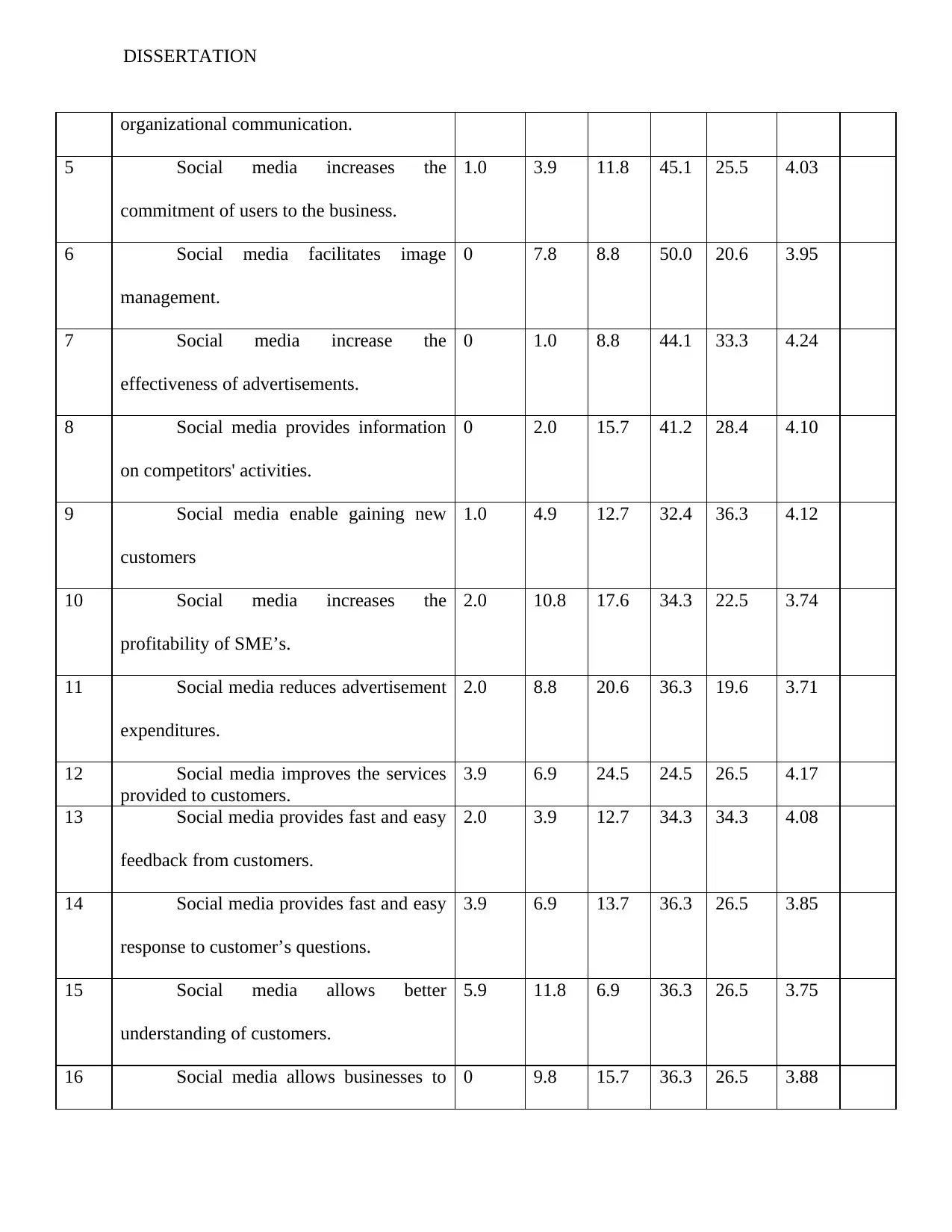
DISSERTATION
organizational communication.
5 Social media increases the
commitment of users to the business.
1.0 3.9 11.8 45.1 25.5 4.03
6 Social media facilitates image
management.
0 7.8 8.8 50.0 20.6 3.95
7 Social media increase the
effectiveness of advertisements.
0 1.0 8.8 44.1 33.3 4.24
8 Social media provides information
on competitors' activities.
0 2.0 15.7 41.2 28.4 4.10
9 Social media enable gaining new
customers
1.0 4.9 12.7 32.4 36.3 4.12
10 Social media increases the
profitability of SME’s.
2.0 10.8 17.6 34.3 22.5 3.74
11 Social media reduces advertisement
expenditures.
2.0 8.8 20.6 36.3 19.6 3.71
12 Social media improves the services
provided to customers.
3.9 6.9 24.5 24.5 26.5 4.17
13 Social media provides fast and easy
feedback from customers.
2.0 3.9 12.7 34.3 34.3 4.08
14 Social media provides fast and easy
response to customer’s questions.
3.9 6.9 13.7 36.3 26.5 3.85
15 Social media allows better
understanding of customers.
5.9 11.8 6.9 36.3 26.5 3.75
16 Social media allows businesses to 0 9.8 15.7 36.3 26.5 3.88
organizational communication.
5 Social media increases the
commitment of users to the business.
1.0 3.9 11.8 45.1 25.5 4.03
6 Social media facilitates image
management.
0 7.8 8.8 50.0 20.6 3.95
7 Social media increase the
effectiveness of advertisements.
0 1.0 8.8 44.1 33.3 4.24
8 Social media provides information
on competitors' activities.
0 2.0 15.7 41.2 28.4 4.10
9 Social media enable gaining new
customers
1.0 4.9 12.7 32.4 36.3 4.12
10 Social media increases the
profitability of SME’s.
2.0 10.8 17.6 34.3 22.5 3.74
11 Social media reduces advertisement
expenditures.
2.0 8.8 20.6 36.3 19.6 3.71
12 Social media improves the services
provided to customers.
3.9 6.9 24.5 24.5 26.5 4.17
13 Social media provides fast and easy
feedback from customers.
2.0 3.9 12.7 34.3 34.3 4.08
14 Social media provides fast and easy
response to customer’s questions.
3.9 6.9 13.7 36.3 26.5 3.85
15 Social media allows better
understanding of customers.
5.9 11.8 6.9 36.3 26.5 3.75
16 Social media allows businesses to 0 9.8 15.7 36.3 26.5 3.88
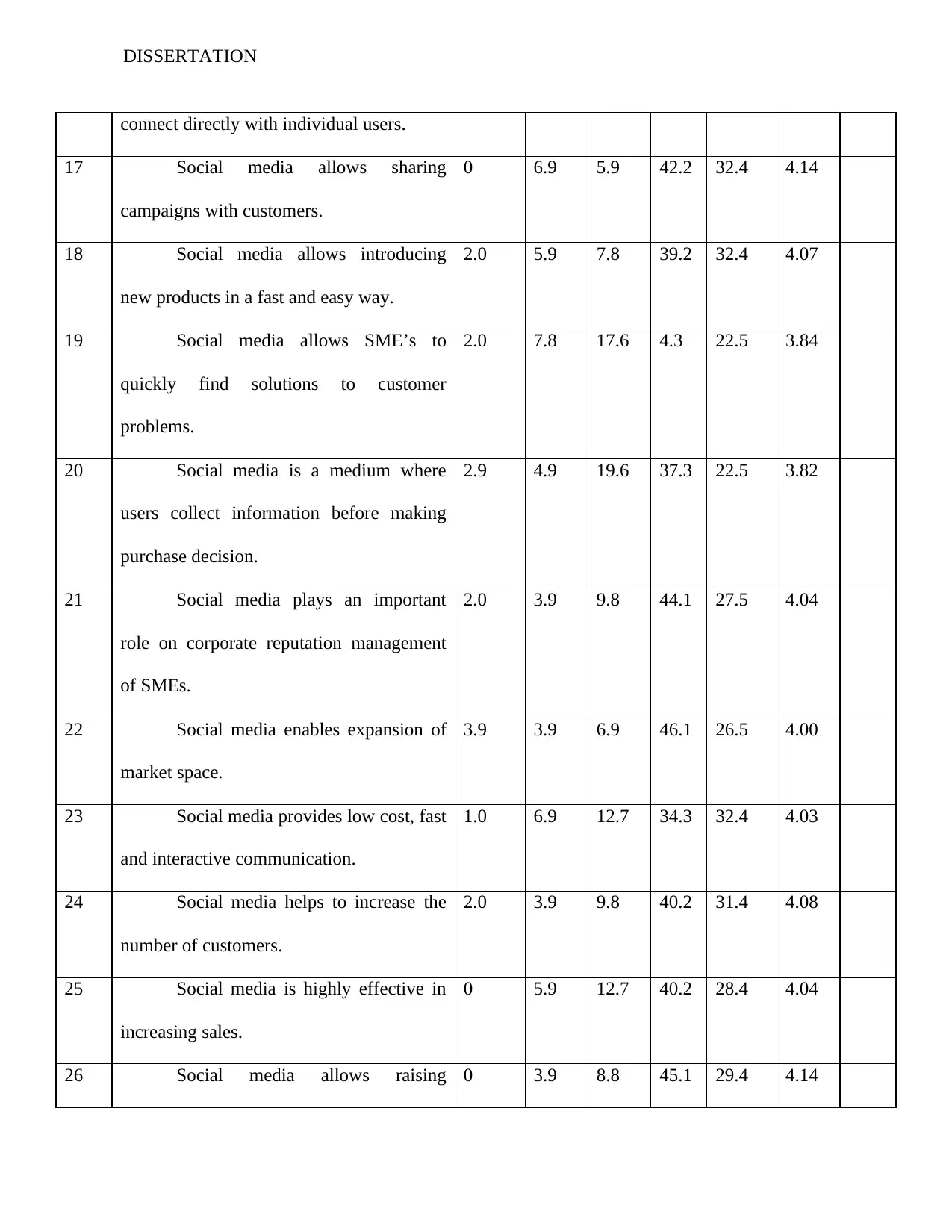
DISSERTATION
connect directly with individual users.
17 Social media allows sharing
campaigns with customers.
0 6.9 5.9 42.2 32.4 4.14
18 Social media allows introducing
new products in a fast and easy way.
2.0 5.9 7.8 39.2 32.4 4.07
19 Social media allows SME’s to
quickly find solutions to customer
problems.
2.0 7.8 17.6 4.3 22.5 3.84
20 Social media is a medium where
users collect information before making
purchase decision.
2.9 4.9 19.6 37.3 22.5 3.82
21 Social media plays an important
role on corporate reputation management
of SMEs.
2.0 3.9 9.8 44.1 27.5 4.04
22 Social media enables expansion of
market space.
3.9 3.9 6.9 46.1 26.5 4.00
23 Social media provides low cost, fast
and interactive communication.
1.0 6.9 12.7 34.3 32.4 4.03
24 Social media helps to increase the
number of customers.
2.0 3.9 9.8 40.2 31.4 4.08
25 Social media is highly effective in
increasing sales.
0 5.9 12.7 40.2 28.4 4.04
26 Social media allows raising 0 3.9 8.8 45.1 29.4 4.14
connect directly with individual users.
17 Social media allows sharing
campaigns with customers.
0 6.9 5.9 42.2 32.4 4.14
18 Social media allows introducing
new products in a fast and easy way.
2.0 5.9 7.8 39.2 32.4 4.07
19 Social media allows SME’s to
quickly find solutions to customer
problems.
2.0 7.8 17.6 4.3 22.5 3.84
20 Social media is a medium where
users collect information before making
purchase decision.
2.9 4.9 19.6 37.3 22.5 3.82
21 Social media plays an important
role on corporate reputation management
of SMEs.
2.0 3.9 9.8 44.1 27.5 4.04
22 Social media enables expansion of
market space.
3.9 3.9 6.9 46.1 26.5 4.00
23 Social media provides low cost, fast
and interactive communication.
1.0 6.9 12.7 34.3 32.4 4.03
24 Social media helps to increase the
number of customers.
2.0 3.9 9.8 40.2 31.4 4.08
25 Social media is highly effective in
increasing sales.
0 5.9 12.7 40.2 28.4 4.04
26 Social media allows raising 0 3.9 8.8 45.1 29.4 4.14
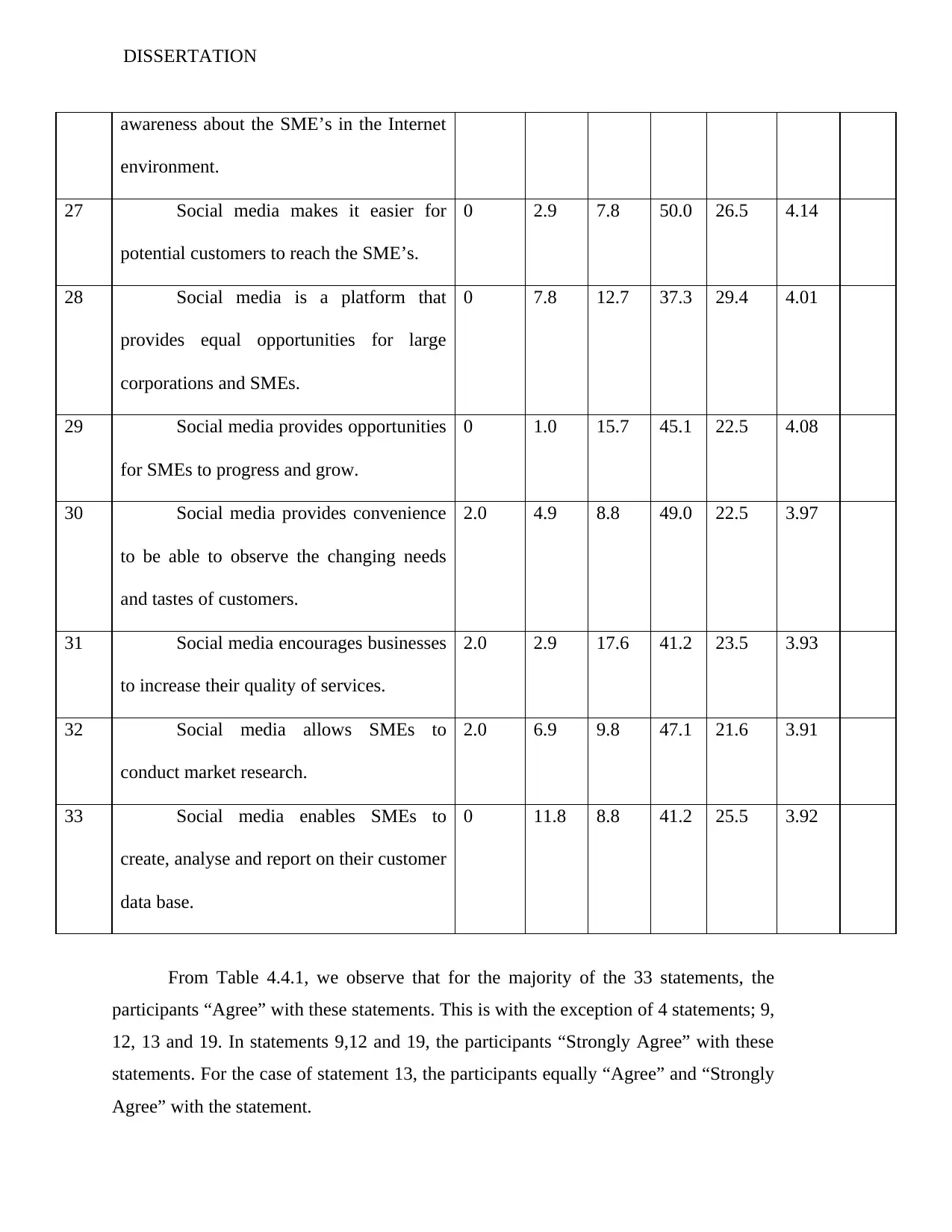
DISSERTATION
awareness about the SME’s in the Internet
environment.
27 Social media makes it easier for
potential customers to reach the SME’s.
0 2.9 7.8 50.0 26.5 4.14
28 Social media is a platform that
provides equal opportunities for large
corporations and SMEs.
0 7.8 12.7 37.3 29.4 4.01
29 Social media provides opportunities
for SMEs to progress and grow.
0 1.0 15.7 45.1 22.5 4.08
30 Social media provides convenience
to be able to observe the changing needs
and tastes of customers.
2.0 4.9 8.8 49.0 22.5 3.97
31 Social media encourages businesses
to increase their quality of services.
2.0 2.9 17.6 41.2 23.5 3.93
32 Social media allows SMEs to
conduct market research.
2.0 6.9 9.8 47.1 21.6 3.91
33 Social media enables SMEs to
create, analyse and report on their customer
data base.
0 11.8 8.8 41.2 25.5 3.92
From Table 4.4.1, we observe that for the majority of the 33 statements, the
participants “Agree” with these statements. This is with the exception of 4 statements; 9,
12, 13 and 19. In statements 9,12 and 19, the participants “Strongly Agree” with these
statements. For the case of statement 13, the participants equally “Agree” and “Strongly
Agree” with the statement.
awareness about the SME’s in the Internet
environment.
27 Social media makes it easier for
potential customers to reach the SME’s.
0 2.9 7.8 50.0 26.5 4.14
28 Social media is a platform that
provides equal opportunities for large
corporations and SMEs.
0 7.8 12.7 37.3 29.4 4.01
29 Social media provides opportunities
for SMEs to progress and grow.
0 1.0 15.7 45.1 22.5 4.08
30 Social media provides convenience
to be able to observe the changing needs
and tastes of customers.
2.0 4.9 8.8 49.0 22.5 3.97
31 Social media encourages businesses
to increase their quality of services.
2.0 2.9 17.6 41.2 23.5 3.93
32 Social media allows SMEs to
conduct market research.
2.0 6.9 9.8 47.1 21.6 3.91
33 Social media enables SMEs to
create, analyse and report on their customer
data base.
0 11.8 8.8 41.2 25.5 3.92
From Table 4.4.1, we observe that for the majority of the 33 statements, the
participants “Agree” with these statements. This is with the exception of 4 statements; 9,
12, 13 and 19. In statements 9,12 and 19, the participants “Strongly Agree” with these
statements. For the case of statement 13, the participants equally “Agree” and “Strongly
Agree” with the statement.
Secure Best Marks with AI Grader
Need help grading? Try our AI Grader for instant feedback on your assignments.
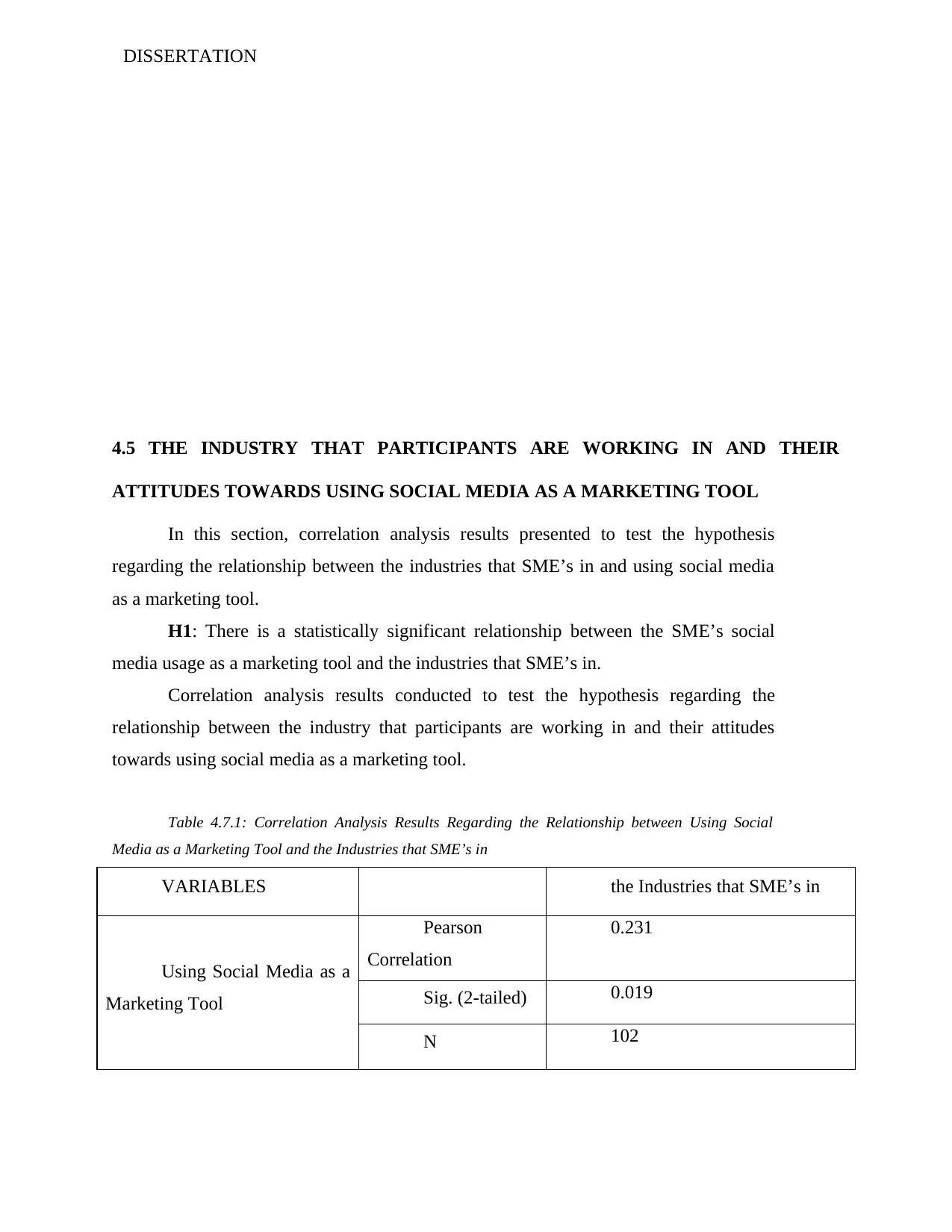
DISSERTATION
4.5 THE INDUSTRY THAT PARTICIPANTS ARE WORKING IN AND THEIR
ATTITUDES TOWARDS USING SOCIAL MEDIA AS A MARKETING TOOL
In this section, correlation analysis results presented to test the hypothesis
regarding the relationship between the industries that SME’s in and using social media
as a marketing tool.
H1: There is a statistically significant relationship between the SME’s social
media usage as a marketing tool and the industries that SME’s in.
Correlation analysis results conducted to test the hypothesis regarding the
relationship between the industry that participants are working in and their attitudes
towards using social media as a marketing tool.
Table 4.7.1: Correlation Analysis Results Regarding the Relationship between Using Social
Media as a Marketing Tool and the Industries that SME’s in
VARIABLES the Industries that SME’s in
Using Social Media as a
Marketing Tool
Pearson
Correlation
0.231
Sig. (2-tailed) 0.019
N 102
4.5 THE INDUSTRY THAT PARTICIPANTS ARE WORKING IN AND THEIR
ATTITUDES TOWARDS USING SOCIAL MEDIA AS A MARKETING TOOL
In this section, correlation analysis results presented to test the hypothesis
regarding the relationship between the industries that SME’s in and using social media
as a marketing tool.
H1: There is a statistically significant relationship between the SME’s social
media usage as a marketing tool and the industries that SME’s in.
Correlation analysis results conducted to test the hypothesis regarding the
relationship between the industry that participants are working in and their attitudes
towards using social media as a marketing tool.
Table 4.7.1: Correlation Analysis Results Regarding the Relationship between Using Social
Media as a Marketing Tool and the Industries that SME’s in
VARIABLES the Industries that SME’s in
Using Social Media as a
Marketing Tool
Pearson
Correlation
0.231
Sig. (2-tailed) 0.019
N 102

DISSERTATION
There is a statistically significant relationship between the SME’s social media usage as a
marketing tool and the industries that SME’s in. From Table 4.7.1 above, we observe that p =
0.019 < 0.05, hence H1 has been proven as true and we conclude that there is a statistically
significant relationship between the Industries that SME’s in and Using Social Media as a
Marketing tool.
Table 4.7.2: Regression Analysis Results Regarding the Relationship between the Using Social Media as a
Marketing Tool and the Industries that SME’s in
VARIABLES
the Industries that SME’s
in
Product Packaging Effect on
Purchasing Decision
Pearson
Correlation
0.231
Sig. (2-tailed) 0.019
N 102
r² 0.054
F 5.657
S.E. 0.581
T 2.378
There is a statistically significant relationship between the SME’s social media usage as a
marketing tool and the industries that SME’s in. From Table 4.7.1 above, we observe that p =
0.019 < 0.05, hence H1 has been proven as true and we conclude that there is a statistically
significant relationship between the Industries that SME’s in and Using Social Media as a
Marketing tool.
Table 4.7.2: Regression Analysis Results Regarding the Relationship between the Using Social Media as a
Marketing Tool and the Industries that SME’s in
VARIABLES
the Industries that SME’s
in
Product Packaging Effect on
Purchasing Decision
Pearson
Correlation
0.231
Sig. (2-tailed) 0.019
N 102
r² 0.054
F 5.657
S.E. 0.581
T 2.378

DISSERTATION
Regression analysis results given in Table 4.7.2 revealed that, the Industries that SME’s
in were able to account 5.4% (r²=0.054, F=5.657, t=2.378) of this variance in the level of effect
of using social media as a marketing tool.
Based on the mean results in Table 4.7.2 it can be concluded that although there
exists a statistically significant relationship between the Industries that SME’s in and
Using Social Media as a Marketing tool; the impact of 5.4% (of Industries SME’s in) in
the variance in the level of effect of using social media as a marketing tool is too small
to be reasonably relevant.
4.6 DEMOGRAPHICS OF PARTICIPANTS AND THEIR ATTITUDES TOWARDS
USING SOCIAL MEDIA AS A MARKETING TOOL
This section of the Thesis consists of analysis results conducted to test the
hypothesis regarding the relationship between the demographics of participants and their
attitudes towards using social media as a marketing tool. These hypotheses are as
follows;
H2: There is no statistically significant relationship between participant’s age and
their attitudes towards using social media as a marketing tool.
H3: There is no statistically significant relationship between participant gender and
their attitudes towards using social media as a marketing tool.
H4: There is no statistically significant relationship between participant’s education
level and their attitudes towards using social media as a marketing tool.
H5: There is no statistically significant relationship between participant’s title at
business and their attitudes towards using social media as a marketing tool.
H6: There is no statistically significant relationship between participant’s working
time at the current position in the SME’s and their attitudes towards using social media as a
marketing tool.
Regression analysis results given in Table 4.7.2 revealed that, the Industries that SME’s
in were able to account 5.4% (r²=0.054, F=5.657, t=2.378) of this variance in the level of effect
of using social media as a marketing tool.
Based on the mean results in Table 4.7.2 it can be concluded that although there
exists a statistically significant relationship between the Industries that SME’s in and
Using Social Media as a Marketing tool; the impact of 5.4% (of Industries SME’s in) in
the variance in the level of effect of using social media as a marketing tool is too small
to be reasonably relevant.
4.6 DEMOGRAPHICS OF PARTICIPANTS AND THEIR ATTITUDES TOWARDS
USING SOCIAL MEDIA AS A MARKETING TOOL
This section of the Thesis consists of analysis results conducted to test the
hypothesis regarding the relationship between the demographics of participants and their
attitudes towards using social media as a marketing tool. These hypotheses are as
follows;
H2: There is no statistically significant relationship between participant’s age and
their attitudes towards using social media as a marketing tool.
H3: There is no statistically significant relationship between participant gender and
their attitudes towards using social media as a marketing tool.
H4: There is no statistically significant relationship between participant’s education
level and their attitudes towards using social media as a marketing tool.
H5: There is no statistically significant relationship between participant’s title at
business and their attitudes towards using social media as a marketing tool.
H6: There is no statistically significant relationship between participant’s working
time at the current position in the SME’s and their attitudes towards using social media as a
marketing tool.
Paraphrase This Document
Need a fresh take? Get an instant paraphrase of this document with our AI Paraphraser
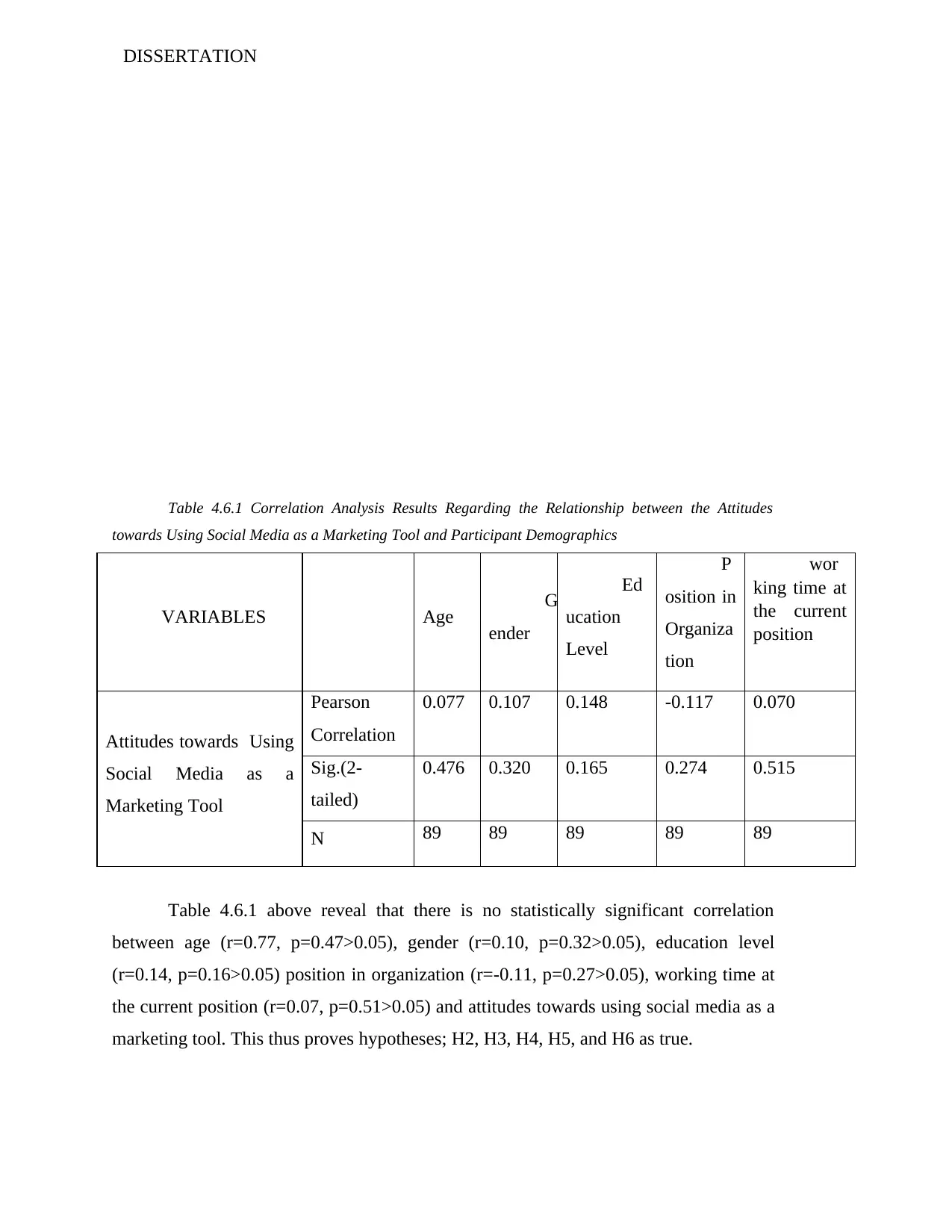
DISSERTATION
Table 4.6.1 Correlation Analysis Results Regarding the Relationship between the Attitudes
towards Using Social Media as a Marketing Tool and Participant Demographics
VARIABLES Age G
ender
Ed
ucation
Level
P
osition in
Organiza
tion
wor
king time at
the current
position
Attitudes towards Using
Social Media as a
Marketing Tool
Pearson
Correlation
0.077 0.107 0.148 -0.117 0.070
Sig.(2-
tailed)
0.476 0.320 0.165 0.274 0.515
N 89 89 89 89 89
Table 4.6.1 above reveal that there is no statistically significant correlation
between age (r=0.77, p=0.47>0.05), gender (r=0.10, p=0.32>0.05), education level
(r=0.14, p=0.16>0.05) position in organization (r=-0.11, p=0.27>0.05), working time at
the current position (r=0.07, p=0.51>0.05) and attitudes towards using social media as a
marketing tool. This thus proves hypotheses; H2, H3, H4, H5, and H6 as true.
Table 4.6.1 Correlation Analysis Results Regarding the Relationship between the Attitudes
towards Using Social Media as a Marketing Tool and Participant Demographics
VARIABLES Age G
ender
Ed
ucation
Level
P
osition in
Organiza
tion
wor
king time at
the current
position
Attitudes towards Using
Social Media as a
Marketing Tool
Pearson
Correlation
0.077 0.107 0.148 -0.117 0.070
Sig.(2-
tailed)
0.476 0.320 0.165 0.274 0.515
N 89 89 89 89 89
Table 4.6.1 above reveal that there is no statistically significant correlation
between age (r=0.77, p=0.47>0.05), gender (r=0.10, p=0.32>0.05), education level
(r=0.14, p=0.16>0.05) position in organization (r=-0.11, p=0.27>0.05), working time at
the current position (r=0.07, p=0.51>0.05) and attitudes towards using social media as a
marketing tool. This thus proves hypotheses; H2, H3, H4, H5, and H6 as true.
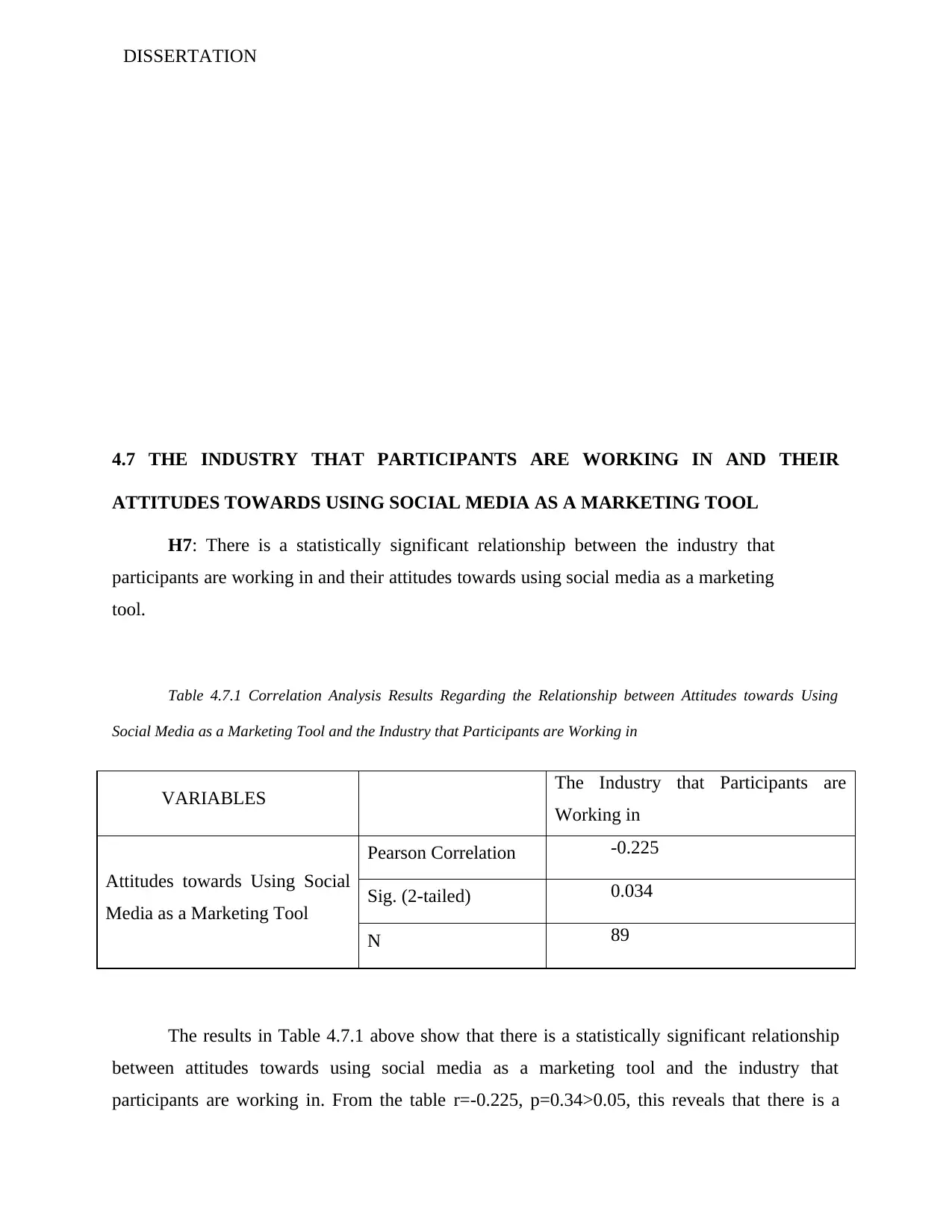
DISSERTATION
4.7 THE INDUSTRY THAT PARTICIPANTS ARE WORKING IN AND THEIR
ATTITUDES TOWARDS USING SOCIAL MEDIA AS A MARKETING TOOL
H7: There is a statistically significant relationship between the industry that
participants are working in and their attitudes towards using social media as a marketing
tool.
Table 4.7.1 Correlation Analysis Results Regarding the Relationship between Attitudes towards Using
Social Media as a Marketing Tool and the Industry that Participants are Working in
VARIABLES The Industry that Participants are
Working in
Attitudes towards Using Social
Media as a Marketing Tool
Pearson Correlation -0.225
Sig. (2-tailed) 0.034
N 89
The results in Table 4.7.1 above show that there is a statistically significant relationship
between attitudes towards using social media as a marketing tool and the industry that
participants are working in. From the table r=-0.225, p=0.34>0.05, this reveals that there is a
4.7 THE INDUSTRY THAT PARTICIPANTS ARE WORKING IN AND THEIR
ATTITUDES TOWARDS USING SOCIAL MEDIA AS A MARKETING TOOL
H7: There is a statistically significant relationship between the industry that
participants are working in and their attitudes towards using social media as a marketing
tool.
Table 4.7.1 Correlation Analysis Results Regarding the Relationship between Attitudes towards Using
Social Media as a Marketing Tool and the Industry that Participants are Working in
VARIABLES The Industry that Participants are
Working in
Attitudes towards Using Social
Media as a Marketing Tool
Pearson Correlation -0.225
Sig. (2-tailed) 0.034
N 89
The results in Table 4.7.1 above show that there is a statistically significant relationship
between attitudes towards using social media as a marketing tool and the industry that
participants are working in. From the table r=-0.225, p=0.34>0.05, this reveals that there is a
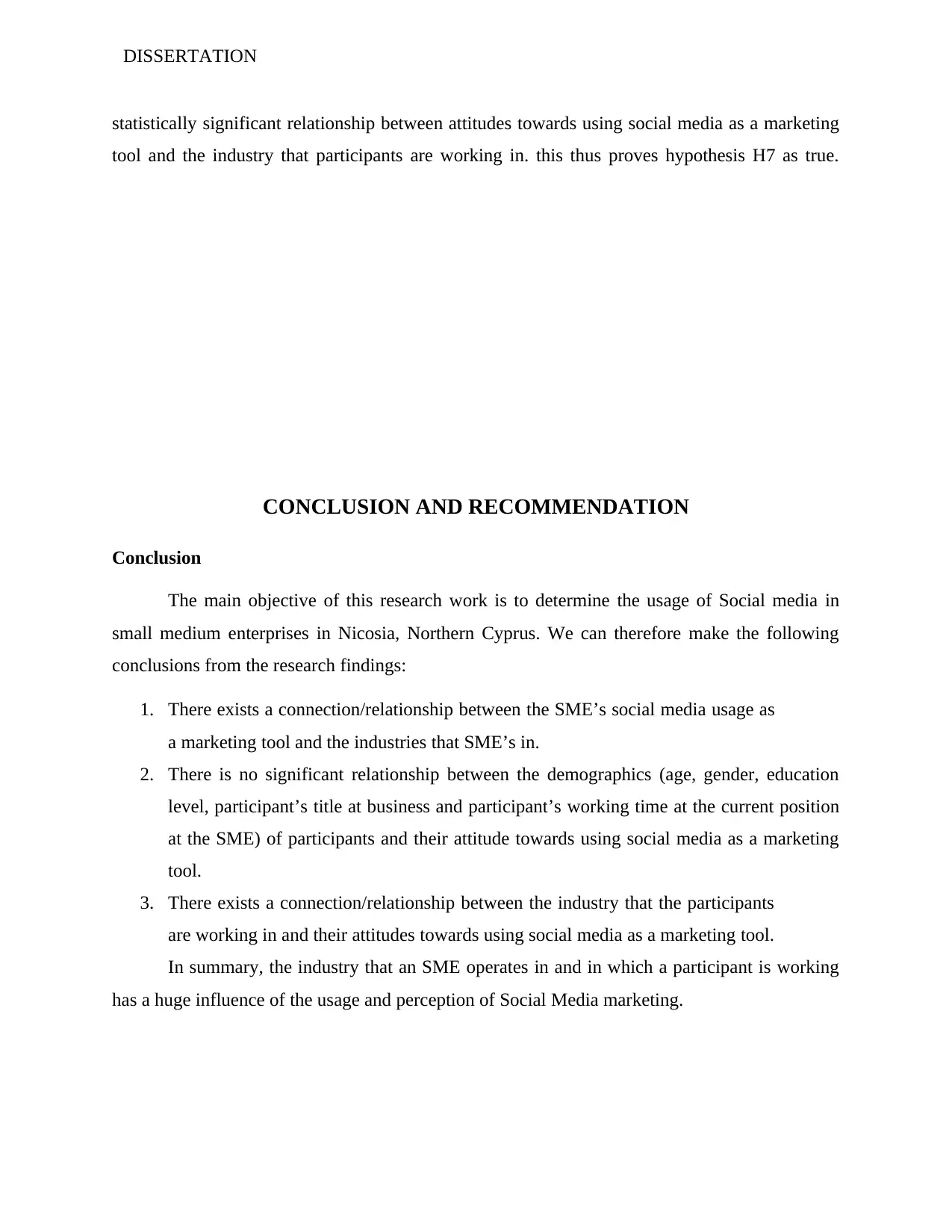
DISSERTATION
statistically significant relationship between attitudes towards using social media as a marketing
tool and the industry that participants are working in. this thus proves hypothesis H7 as true.
CONCLUSION AND RECOMMENDATION
Conclusion
The main objective of this research work is to determine the usage of Social media in
small medium enterprises in Nicosia, Northern Cyprus. We can therefore make the following
conclusions from the research findings:
1. There exists a connection/relationship between the SME’s social media usage as
a marketing tool and the industries that SME’s in.
2. There is no significant relationship between the demographics (age, gender, education
level, participant’s title at business and participant’s working time at the current position
at the SME) of participants and their attitude towards using social media as a marketing
tool.
3. There exists a connection/relationship between the industry that the participants
are working in and their attitudes towards using social media as a marketing tool.
In summary, the industry that an SME operates in and in which a participant is working
has a huge influence of the usage and perception of Social Media marketing.
statistically significant relationship between attitudes towards using social media as a marketing
tool and the industry that participants are working in. this thus proves hypothesis H7 as true.
CONCLUSION AND RECOMMENDATION
Conclusion
The main objective of this research work is to determine the usage of Social media in
small medium enterprises in Nicosia, Northern Cyprus. We can therefore make the following
conclusions from the research findings:
1. There exists a connection/relationship between the SME’s social media usage as
a marketing tool and the industries that SME’s in.
2. There is no significant relationship between the demographics (age, gender, education
level, participant’s title at business and participant’s working time at the current position
at the SME) of participants and their attitude towards using social media as a marketing
tool.
3. There exists a connection/relationship between the industry that the participants
are working in and their attitudes towards using social media as a marketing tool.
In summary, the industry that an SME operates in and in which a participant is working
has a huge influence of the usage and perception of Social Media marketing.
Secure Best Marks with AI Grader
Need help grading? Try our AI Grader for instant feedback on your assignments.
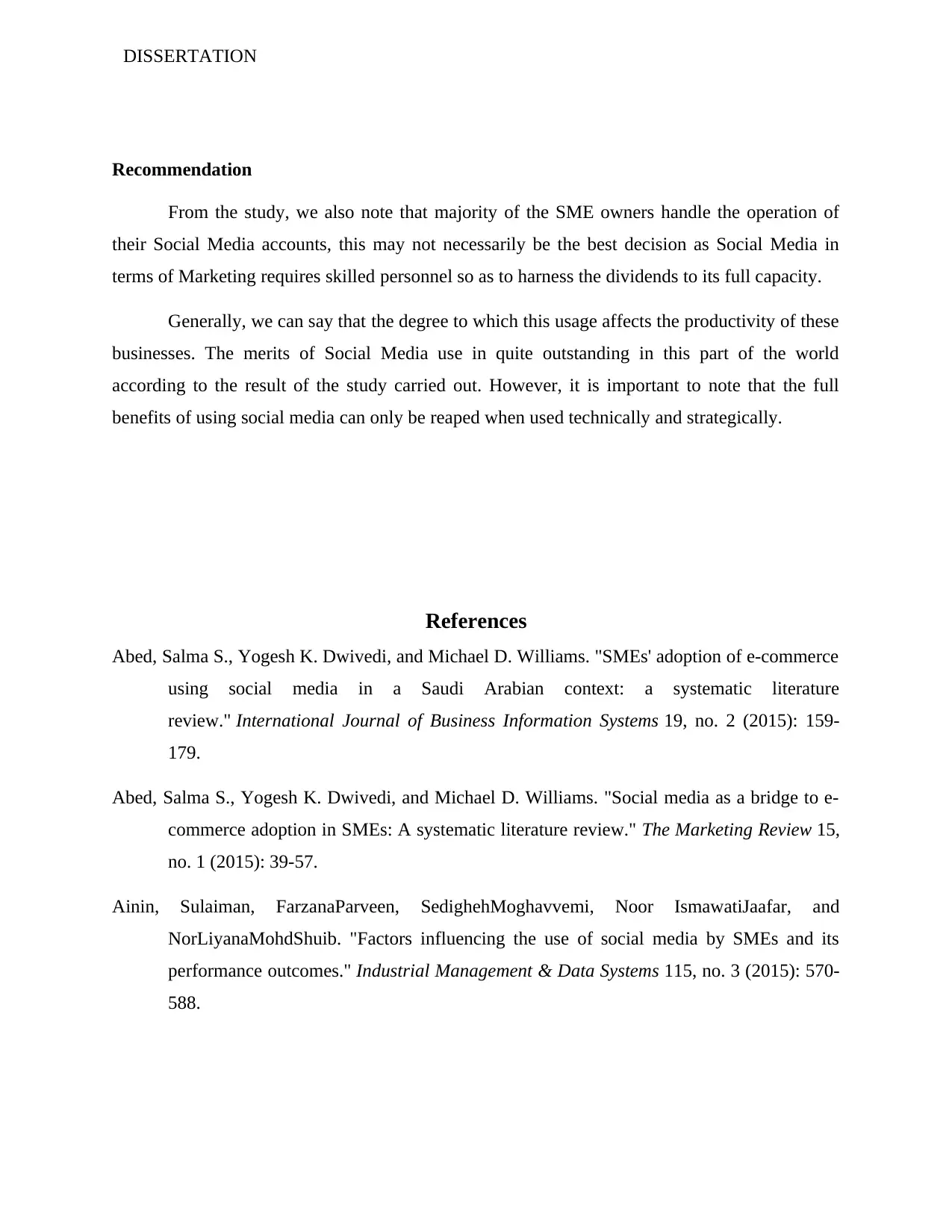
DISSERTATION
Recommendation
From the study, we also note that majority of the SME owners handle the operation of
their Social Media accounts, this may not necessarily be the best decision as Social Media in
terms of Marketing requires skilled personnel so as to harness the dividends to its full capacity.
Generally, we can say that the degree to which this usage affects the productivity of these
businesses. The merits of Social Media use in quite outstanding in this part of the world
according to the result of the study carried out. However, it is important to note that the full
benefits of using social media can only be reaped when used technically and strategically.
References
Abed, Salma S., Yogesh K. Dwivedi, and Michael D. Williams. "SMEs' adoption of e-commerce
using social media in a Saudi Arabian context: a systematic literature
review." International Journal of Business Information Systems 19, no. 2 (2015): 159-
179.
Abed, Salma S., Yogesh K. Dwivedi, and Michael D. Williams. "Social media as a bridge to e-
commerce adoption in SMEs: A systematic literature review." The Marketing Review 15,
no. 1 (2015): 39-57.
Ainin, Sulaiman, FarzanaParveen, SedighehMoghavvemi, Noor IsmawatiJaafar, and
NorLiyanaMohdShuib. "Factors influencing the use of social media by SMEs and its
performance outcomes." Industrial Management & Data Systems 115, no. 3 (2015): 570-
588.
Recommendation
From the study, we also note that majority of the SME owners handle the operation of
their Social Media accounts, this may not necessarily be the best decision as Social Media in
terms of Marketing requires skilled personnel so as to harness the dividends to its full capacity.
Generally, we can say that the degree to which this usage affects the productivity of these
businesses. The merits of Social Media use in quite outstanding in this part of the world
according to the result of the study carried out. However, it is important to note that the full
benefits of using social media can only be reaped when used technically and strategically.
References
Abed, Salma S., Yogesh K. Dwivedi, and Michael D. Williams. "SMEs' adoption of e-commerce
using social media in a Saudi Arabian context: a systematic literature
review." International Journal of Business Information Systems 19, no. 2 (2015): 159-
179.
Abed, Salma S., Yogesh K. Dwivedi, and Michael D. Williams. "Social media as a bridge to e-
commerce adoption in SMEs: A systematic literature review." The Marketing Review 15,
no. 1 (2015): 39-57.
Ainin, Sulaiman, FarzanaParveen, SedighehMoghavvemi, Noor IsmawatiJaafar, and
NorLiyanaMohdShuib. "Factors influencing the use of social media by SMEs and its
performance outcomes." Industrial Management & Data Systems 115, no. 3 (2015): 570-
588.

DISSERTATION
Atanassova, Iva, and Lillian Clark. "Social media practices in SME marketing activities: A
theoretical framework and research agenda." Journal of customer behaviour 14, no. 2
(2015): 163-183.
Bharati, Pratyush, and Abhijit Chaudhury. "Current status of technology adoption: Micro, small
and medium manufacturing firms in Boston." Bharati, P. and Chaudhury, A.
(2006),“Current Status of Technology Adoption: Micro, Small and Medium
Manufacturing Firms in Boston”, Communications of the ACM49, no. 10 (2015): 88-93.
Braojos-Gomez, Jessica, Jose Benitez-Amado, and F. Javier Llorens-Montes. "How do small
firms learn to develop a social media competence?." International Journal of Information
Management 35, no. 4 (2015): 443-458.
Broekemier, Greg, Ngan N. Chau, and SrivatsaSeshadri. "Social media practices among small
business-to-business enterprises." Small Business Institute Journal 11, no. 1 (2015).
Burgess, Stephen, Carmine Sellitto, Carmen Cox, and Jeremy Buultjens. "Strategies for
Adopting Consumer‐generated Media in Small‐sized to Medium‐sized Tourism
Enterprises." International Journal of Tourism Research 17, no. 5 (2015): 432-441.
Buzlukçu, C. “The boutique and small hotel managers’ perceptions related to social media
marketing”, T.C. Muğla Sıtkı Koçman Üniversitesi Sosyal Bilimler Enstitüsü Turizm
İşletmeciği Anabilim Dalı, Unpublished Master's Thesis, Muğla, 2015.
Cesaroni, Francesca Maria, and DomenicoConsoli. "Are small businesses really able to take
advantage of social media?." Electronic Journal of Knowledge Management 13, no. 4
(2015): 257.
Chin, Christie Pei-Yee, Nina Evans, and Kim-Kwang Raymond Choo. "Exploring factors
influencing the use of enterprise social networks in multinational professional service
firms." Journal of Organizational Computing and Electronic Commerce 25, no. 3 (2015):
289-315.
Atanassova, Iva, and Lillian Clark. "Social media practices in SME marketing activities: A
theoretical framework and research agenda." Journal of customer behaviour 14, no. 2
(2015): 163-183.
Bharati, Pratyush, and Abhijit Chaudhury. "Current status of technology adoption: Micro, small
and medium manufacturing firms in Boston." Bharati, P. and Chaudhury, A.
(2006),“Current Status of Technology Adoption: Micro, Small and Medium
Manufacturing Firms in Boston”, Communications of the ACM49, no. 10 (2015): 88-93.
Braojos-Gomez, Jessica, Jose Benitez-Amado, and F. Javier Llorens-Montes. "How do small
firms learn to develop a social media competence?." International Journal of Information
Management 35, no. 4 (2015): 443-458.
Broekemier, Greg, Ngan N. Chau, and SrivatsaSeshadri. "Social media practices among small
business-to-business enterprises." Small Business Institute Journal 11, no. 1 (2015).
Burgess, Stephen, Carmine Sellitto, Carmen Cox, and Jeremy Buultjens. "Strategies for
Adopting Consumer‐generated Media in Small‐sized to Medium‐sized Tourism
Enterprises." International Journal of Tourism Research 17, no. 5 (2015): 432-441.
Buzlukçu, C. “The boutique and small hotel managers’ perceptions related to social media
marketing”, T.C. Muğla Sıtkı Koçman Üniversitesi Sosyal Bilimler Enstitüsü Turizm
İşletmeciği Anabilim Dalı, Unpublished Master's Thesis, Muğla, 2015.
Cesaroni, Francesca Maria, and DomenicoConsoli. "Are small businesses really able to take
advantage of social media?." Electronic Journal of Knowledge Management 13, no. 4
(2015): 257.
Chin, Christie Pei-Yee, Nina Evans, and Kim-Kwang Raymond Choo. "Exploring factors
influencing the use of enterprise social networks in multinational professional service
firms." Journal of Organizational Computing and Electronic Commerce 25, no. 3 (2015):
289-315.
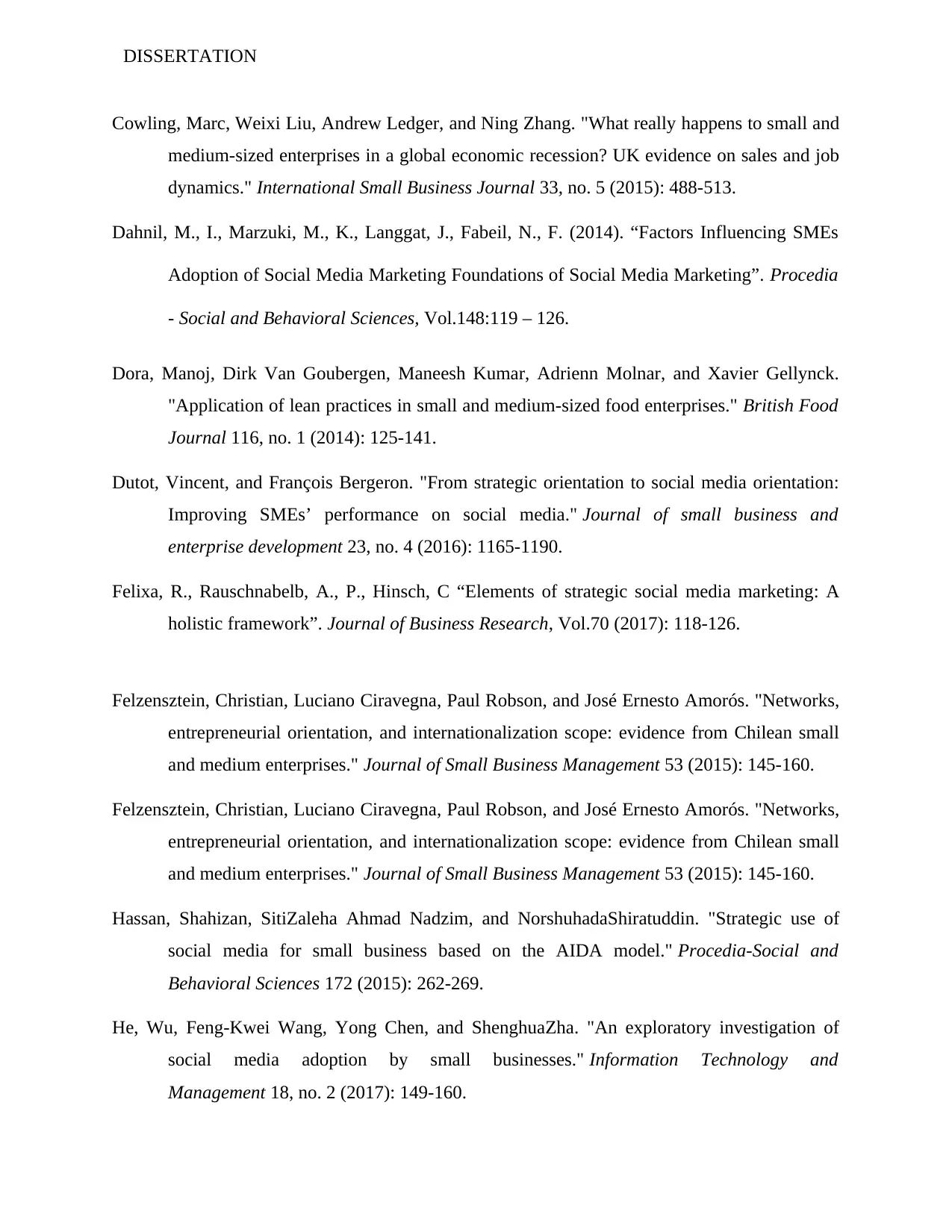
DISSERTATION
Cowling, Marc, Weixi Liu, Andrew Ledger, and Ning Zhang. "What really happens to small and
medium-sized enterprises in a global economic recession? UK evidence on sales and job
dynamics." International Small Business Journal 33, no. 5 (2015): 488-513.
Dahnil, M., I., Marzuki, M., K., Langgat, J., Fabeil, N., F. (2014). “Factors Influencing SMEs
Adoption of Social Media Marketing Foundations of Social Media Marketing”. Procedia
- Social and Behavioral Sciences, Vol.148:119 – 126.
Dora, Manoj, Dirk Van Goubergen, Maneesh Kumar, Adrienn Molnar, and Xavier Gellynck.
"Application of lean practices in small and medium-sized food enterprises." British Food
Journal 116, no. 1 (2014): 125-141.
Dutot, Vincent, and François Bergeron. "From strategic orientation to social media orientation:
Improving SMEs’ performance on social media." Journal of small business and
enterprise development 23, no. 4 (2016): 1165-1190.
Felixa, R., Rauschnabelb, A., P., Hinsch, C “Elements of strategic social media marketing: A
holistic framework”. Journal of Business Research, Vol.70 (2017): 118-126.
Felzensztein, Christian, Luciano Ciravegna, Paul Robson, and José Ernesto Amorós. "Networks,
entrepreneurial orientation, and internationalization scope: evidence from Chilean small
and medium enterprises." Journal of Small Business Management 53 (2015): 145-160.
Felzensztein, Christian, Luciano Ciravegna, Paul Robson, and José Ernesto Amorós. "Networks,
entrepreneurial orientation, and internationalization scope: evidence from Chilean small
and medium enterprises." Journal of Small Business Management 53 (2015): 145-160.
Hassan, Shahizan, SitiZaleha Ahmad Nadzim, and NorshuhadaShiratuddin. "Strategic use of
social media for small business based on the AIDA model." Procedia-Social and
Behavioral Sciences 172 (2015): 262-269.
He, Wu, Feng-Kwei Wang, Yong Chen, and ShenghuaZha. "An exploratory investigation of
social media adoption by small businesses." Information Technology and
Management 18, no. 2 (2017): 149-160.
Cowling, Marc, Weixi Liu, Andrew Ledger, and Ning Zhang. "What really happens to small and
medium-sized enterprises in a global economic recession? UK evidence on sales and job
dynamics." International Small Business Journal 33, no. 5 (2015): 488-513.
Dahnil, M., I., Marzuki, M., K., Langgat, J., Fabeil, N., F. (2014). “Factors Influencing SMEs
Adoption of Social Media Marketing Foundations of Social Media Marketing”. Procedia
- Social and Behavioral Sciences, Vol.148:119 – 126.
Dora, Manoj, Dirk Van Goubergen, Maneesh Kumar, Adrienn Molnar, and Xavier Gellynck.
"Application of lean practices in small and medium-sized food enterprises." British Food
Journal 116, no. 1 (2014): 125-141.
Dutot, Vincent, and François Bergeron. "From strategic orientation to social media orientation:
Improving SMEs’ performance on social media." Journal of small business and
enterprise development 23, no. 4 (2016): 1165-1190.
Felixa, R., Rauschnabelb, A., P., Hinsch, C “Elements of strategic social media marketing: A
holistic framework”. Journal of Business Research, Vol.70 (2017): 118-126.
Felzensztein, Christian, Luciano Ciravegna, Paul Robson, and José Ernesto Amorós. "Networks,
entrepreneurial orientation, and internationalization scope: evidence from Chilean small
and medium enterprises." Journal of Small Business Management 53 (2015): 145-160.
Felzensztein, Christian, Luciano Ciravegna, Paul Robson, and José Ernesto Amorós. "Networks,
entrepreneurial orientation, and internationalization scope: evidence from Chilean small
and medium enterprises." Journal of Small Business Management 53 (2015): 145-160.
Hassan, Shahizan, SitiZaleha Ahmad Nadzim, and NorshuhadaShiratuddin. "Strategic use of
social media for small business based on the AIDA model." Procedia-Social and
Behavioral Sciences 172 (2015): 262-269.
He, Wu, Feng-Kwei Wang, Yong Chen, and ShenghuaZha. "An exploratory investigation of
social media adoption by small businesses." Information Technology and
Management 18, no. 2 (2017): 149-160.
Paraphrase This Document
Need a fresh take? Get an instant paraphrase of this document with our AI Paraphraser
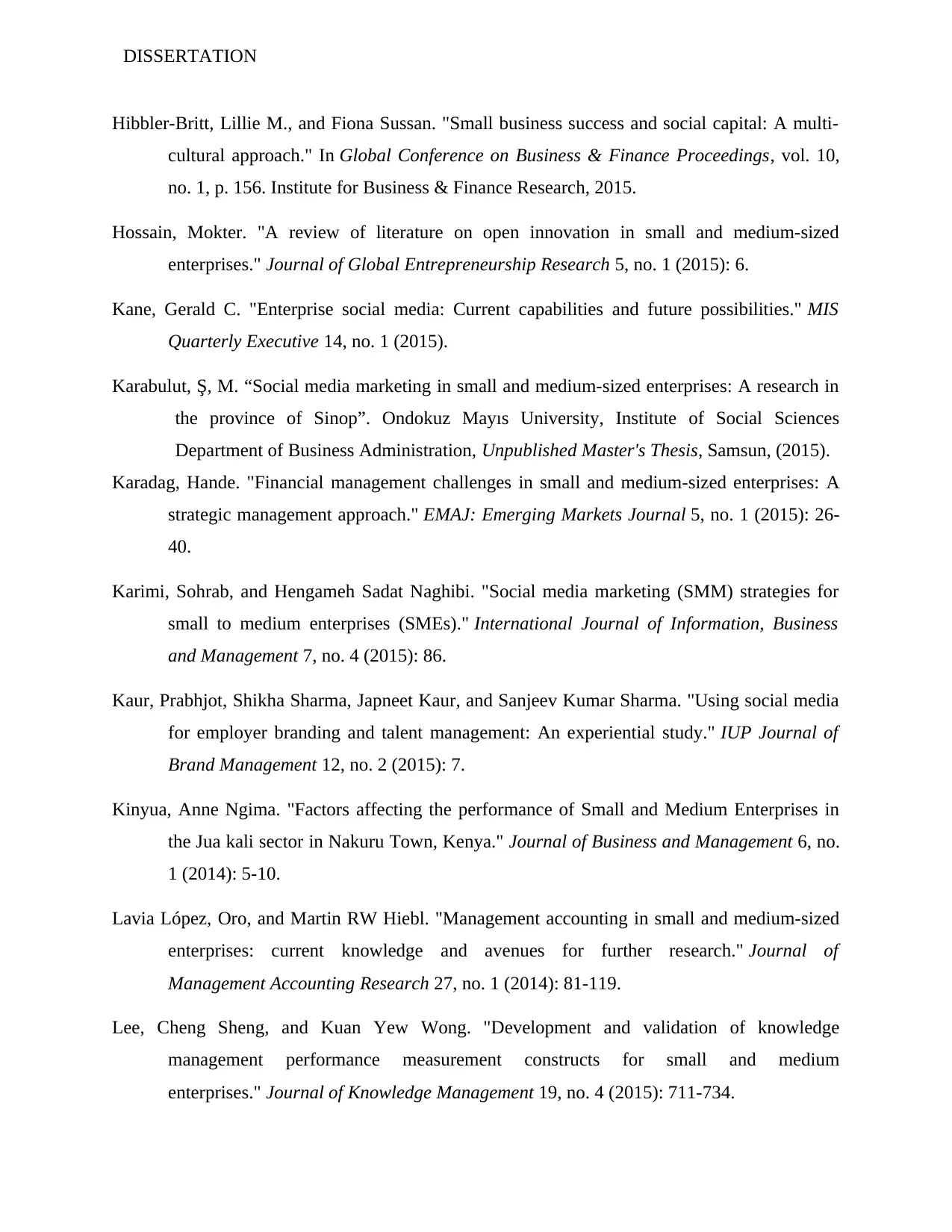
DISSERTATION
Hibbler-Britt, Lillie M., and Fiona Sussan. "Small business success and social capital: A multi-
cultural approach." In Global Conference on Business & Finance Proceedings, vol. 10,
no. 1, p. 156. Institute for Business & Finance Research, 2015.
Hossain, Mokter. "A review of literature on open innovation in small and medium-sized
enterprises." Journal of Global Entrepreneurship Research 5, no. 1 (2015): 6.
Kane, Gerald C. "Enterprise social media: Current capabilities and future possibilities." MIS
Quarterly Executive 14, no. 1 (2015).
Karabulut, Ş, M. “Social media marketing in small and medium-sized enterprises: A research in
the province of Sinop”. Ondokuz Mayıs University, Institute of Social Sciences
Department of Business Administration, Unpublished Master's Thesis, Samsun, (2015).
Karadag, Hande. "Financial management challenges in small and medium-sized enterprises: A
strategic management approach." EMAJ: Emerging Markets Journal 5, no. 1 (2015): 26-
40.
Karimi, Sohrab, and Hengameh Sadat Naghibi. "Social media marketing (SMM) strategies for
small to medium enterprises (SMEs)." International Journal of Information, Business
and Management 7, no. 4 (2015): 86.
Kaur, Prabhjot, Shikha Sharma, Japneet Kaur, and Sanjeev Kumar Sharma. "Using social media
for employer branding and talent management: An experiential study." IUP Journal of
Brand Management 12, no. 2 (2015): 7.
Kinyua, Anne Ngima. "Factors affecting the performance of Small and Medium Enterprises in
the Jua kali sector in Nakuru Town, Kenya." Journal of Business and Management 6, no.
1 (2014): 5-10.
Lavia López, Oro, and Martin RW Hiebl. "Management accounting in small and medium-sized
enterprises: current knowledge and avenues for further research." Journal of
Management Accounting Research 27, no. 1 (2014): 81-119.
Lee, Cheng Sheng, and Kuan Yew Wong. "Development and validation of knowledge
management performance measurement constructs for small and medium
enterprises." Journal of Knowledge Management 19, no. 4 (2015): 711-734.
Hibbler-Britt, Lillie M., and Fiona Sussan. "Small business success and social capital: A multi-
cultural approach." In Global Conference on Business & Finance Proceedings, vol. 10,
no. 1, p. 156. Institute for Business & Finance Research, 2015.
Hossain, Mokter. "A review of literature on open innovation in small and medium-sized
enterprises." Journal of Global Entrepreneurship Research 5, no. 1 (2015): 6.
Kane, Gerald C. "Enterprise social media: Current capabilities and future possibilities." MIS
Quarterly Executive 14, no. 1 (2015).
Karabulut, Ş, M. “Social media marketing in small and medium-sized enterprises: A research in
the province of Sinop”. Ondokuz Mayıs University, Institute of Social Sciences
Department of Business Administration, Unpublished Master's Thesis, Samsun, (2015).
Karadag, Hande. "Financial management challenges in small and medium-sized enterprises: A
strategic management approach." EMAJ: Emerging Markets Journal 5, no. 1 (2015): 26-
40.
Karimi, Sohrab, and Hengameh Sadat Naghibi. "Social media marketing (SMM) strategies for
small to medium enterprises (SMEs)." International Journal of Information, Business
and Management 7, no. 4 (2015): 86.
Kaur, Prabhjot, Shikha Sharma, Japneet Kaur, and Sanjeev Kumar Sharma. "Using social media
for employer branding and talent management: An experiential study." IUP Journal of
Brand Management 12, no. 2 (2015): 7.
Kinyua, Anne Ngima. "Factors affecting the performance of Small and Medium Enterprises in
the Jua kali sector in Nakuru Town, Kenya." Journal of Business and Management 6, no.
1 (2014): 5-10.
Lavia López, Oro, and Martin RW Hiebl. "Management accounting in small and medium-sized
enterprises: current knowledge and avenues for further research." Journal of
Management Accounting Research 27, no. 1 (2014): 81-119.
Lee, Cheng Sheng, and Kuan Yew Wong. "Development and validation of knowledge
management performance measurement constructs for small and medium
enterprises." Journal of Knowledge Management 19, no. 4 (2015): 711-734.
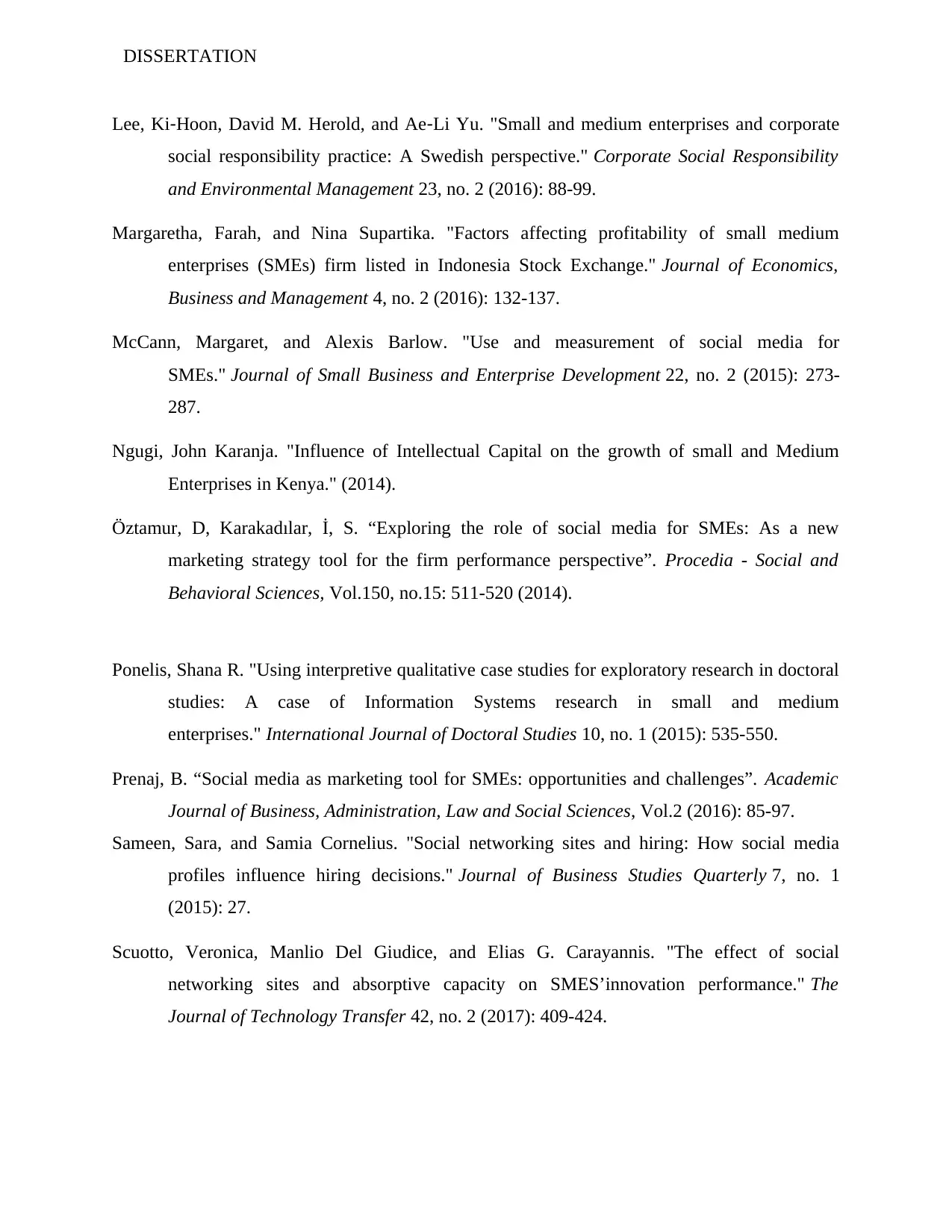
DISSERTATION
Lee, Ki‐Hoon, David M. Herold, and Ae‐Li Yu. "Small and medium enterprises and corporate
social responsibility practice: A Swedish perspective." Corporate Social Responsibility
and Environmental Management 23, no. 2 (2016): 88-99.
Margaretha, Farah, and Nina Supartika. "Factors affecting profitability of small medium
enterprises (SMEs) firm listed in Indonesia Stock Exchange." Journal of Economics,
Business and Management 4, no. 2 (2016): 132-137.
McCann, Margaret, and Alexis Barlow. "Use and measurement of social media for
SMEs." Journal of Small Business and Enterprise Development 22, no. 2 (2015): 273-
287.
Ngugi, John Karanja. "Influence of Intellectual Capital on the growth of small and Medium
Enterprises in Kenya." (2014).
Öztamur, D, Karakadılar, İ, S. “Exploring the role of social media for SMEs: As a new
marketing strategy tool for the firm performance perspective”. Procedia - Social and
Behavioral Sciences, Vol.150, no.15: 511-520 (2014).
Ponelis, Shana R. "Using interpretive qualitative case studies for exploratory research in doctoral
studies: A case of Information Systems research in small and medium
enterprises." International Journal of Doctoral Studies 10, no. 1 (2015): 535-550.
Prenaj, B. “Social media as marketing tool for SMEs: opportunities and challenges”. Academic
Journal of Business, Administration, Law and Social Sciences, Vol.2 (2016): 85-97.
Sameen, Sara, and Samia Cornelius. "Social networking sites and hiring: How social media
profiles influence hiring decisions." Journal of Business Studies Quarterly 7, no. 1
(2015): 27.
Scuotto, Veronica, Manlio Del Giudice, and Elias G. Carayannis. "The effect of social
networking sites and absorptive capacity on SMES’innovation performance." The
Journal of Technology Transfer 42, no. 2 (2017): 409-424.
Lee, Ki‐Hoon, David M. Herold, and Ae‐Li Yu. "Small and medium enterprises and corporate
social responsibility practice: A Swedish perspective." Corporate Social Responsibility
and Environmental Management 23, no. 2 (2016): 88-99.
Margaretha, Farah, and Nina Supartika. "Factors affecting profitability of small medium
enterprises (SMEs) firm listed in Indonesia Stock Exchange." Journal of Economics,
Business and Management 4, no. 2 (2016): 132-137.
McCann, Margaret, and Alexis Barlow. "Use and measurement of social media for
SMEs." Journal of Small Business and Enterprise Development 22, no. 2 (2015): 273-
287.
Ngugi, John Karanja. "Influence of Intellectual Capital on the growth of small and Medium
Enterprises in Kenya." (2014).
Öztamur, D, Karakadılar, İ, S. “Exploring the role of social media for SMEs: As a new
marketing strategy tool for the firm performance perspective”. Procedia - Social and
Behavioral Sciences, Vol.150, no.15: 511-520 (2014).
Ponelis, Shana R. "Using interpretive qualitative case studies for exploratory research in doctoral
studies: A case of Information Systems research in small and medium
enterprises." International Journal of Doctoral Studies 10, no. 1 (2015): 535-550.
Prenaj, B. “Social media as marketing tool for SMEs: opportunities and challenges”. Academic
Journal of Business, Administration, Law and Social Sciences, Vol.2 (2016): 85-97.
Sameen, Sara, and Samia Cornelius. "Social networking sites and hiring: How social media
profiles influence hiring decisions." Journal of Business Studies Quarterly 7, no. 1
(2015): 27.
Scuotto, Veronica, Manlio Del Giudice, and Elias G. Carayannis. "The effect of social
networking sites and absorptive capacity on SMES’innovation performance." The
Journal of Technology Transfer 42, no. 2 (2017): 409-424.
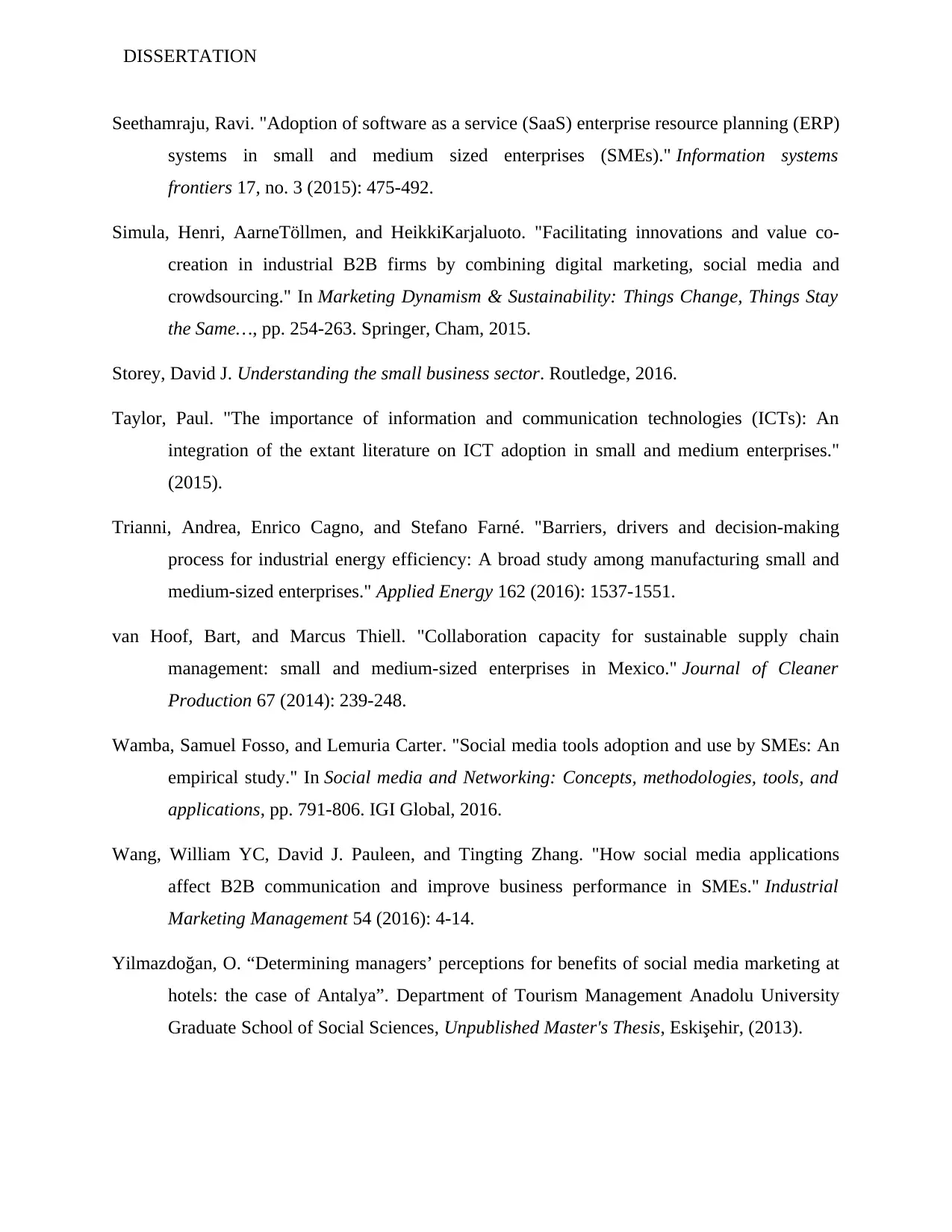
DISSERTATION
Seethamraju, Ravi. "Adoption of software as a service (SaaS) enterprise resource planning (ERP)
systems in small and medium sized enterprises (SMEs)." Information systems
frontiers 17, no. 3 (2015): 475-492.
Simula, Henri, AarneTöllmen, and HeikkiKarjaluoto. "Facilitating innovations and value co-
creation in industrial B2B firms by combining digital marketing, social media and
crowdsourcing." In Marketing Dynamism & Sustainability: Things Change, Things Stay
the Same…, pp. 254-263. Springer, Cham, 2015.
Storey, David J. Understanding the small business sector. Routledge, 2016.
Taylor, Paul. "The importance of information and communication technologies (ICTs): An
integration of the extant literature on ICT adoption in small and medium enterprises."
(2015).
Trianni, Andrea, Enrico Cagno, and Stefano Farné. "Barriers, drivers and decision-making
process for industrial energy efficiency: A broad study among manufacturing small and
medium-sized enterprises." Applied Energy 162 (2016): 1537-1551.
van Hoof, Bart, and Marcus Thiell. "Collaboration capacity for sustainable supply chain
management: small and medium-sized enterprises in Mexico." Journal of Cleaner
Production 67 (2014): 239-248.
Wamba, Samuel Fosso, and Lemuria Carter. "Social media tools adoption and use by SMEs: An
empirical study." In Social media and Networking: Concepts, methodologies, tools, and
applications, pp. 791-806. IGI Global, 2016.
Wang, William YC, David J. Pauleen, and Tingting Zhang. "How social media applications
affect B2B communication and improve business performance in SMEs." Industrial
Marketing Management 54 (2016): 4-14.
Yilmazdoğan, O. “Determining managers’ perceptions for benefits of social media marketing at
hotels: the case of Antalya”. Department of Tourism Management Anadolu University
Graduate School of Social Sciences, Unpublished Master's Thesis, Eskişehir, (2013).
Seethamraju, Ravi. "Adoption of software as a service (SaaS) enterprise resource planning (ERP)
systems in small and medium sized enterprises (SMEs)." Information systems
frontiers 17, no. 3 (2015): 475-492.
Simula, Henri, AarneTöllmen, and HeikkiKarjaluoto. "Facilitating innovations and value co-
creation in industrial B2B firms by combining digital marketing, social media and
crowdsourcing." In Marketing Dynamism & Sustainability: Things Change, Things Stay
the Same…, pp. 254-263. Springer, Cham, 2015.
Storey, David J. Understanding the small business sector. Routledge, 2016.
Taylor, Paul. "The importance of information and communication technologies (ICTs): An
integration of the extant literature on ICT adoption in small and medium enterprises."
(2015).
Trianni, Andrea, Enrico Cagno, and Stefano Farné. "Barriers, drivers and decision-making
process for industrial energy efficiency: A broad study among manufacturing small and
medium-sized enterprises." Applied Energy 162 (2016): 1537-1551.
van Hoof, Bart, and Marcus Thiell. "Collaboration capacity for sustainable supply chain
management: small and medium-sized enterprises in Mexico." Journal of Cleaner
Production 67 (2014): 239-248.
Wamba, Samuel Fosso, and Lemuria Carter. "Social media tools adoption and use by SMEs: An
empirical study." In Social media and Networking: Concepts, methodologies, tools, and
applications, pp. 791-806. IGI Global, 2016.
Wang, William YC, David J. Pauleen, and Tingting Zhang. "How social media applications
affect B2B communication and improve business performance in SMEs." Industrial
Marketing Management 54 (2016): 4-14.
Yilmazdoğan, O. “Determining managers’ perceptions for benefits of social media marketing at
hotels: the case of Antalya”. Department of Tourism Management Anadolu University
Graduate School of Social Sciences, Unpublished Master's Thesis, Eskişehir, (2013).
1 out of 82
Related Documents
Your All-in-One AI-Powered Toolkit for Academic Success.
+13062052269
info@desklib.com
Available 24*7 on WhatsApp / Email
![[object Object]](/_next/static/media/star-bottom.7253800d.svg)
Unlock your academic potential
© 2024 | Zucol Services PVT LTD | All rights reserved.





